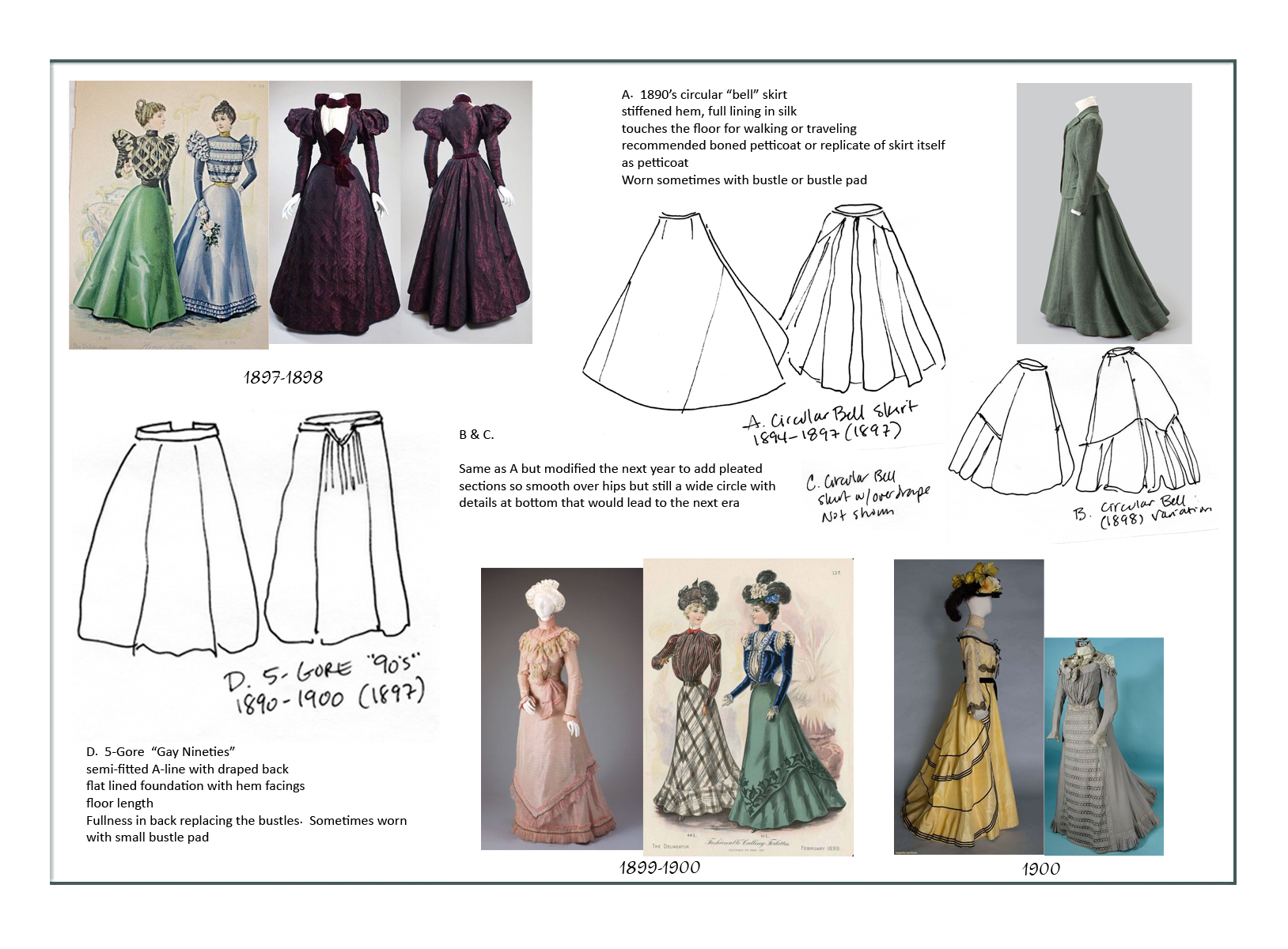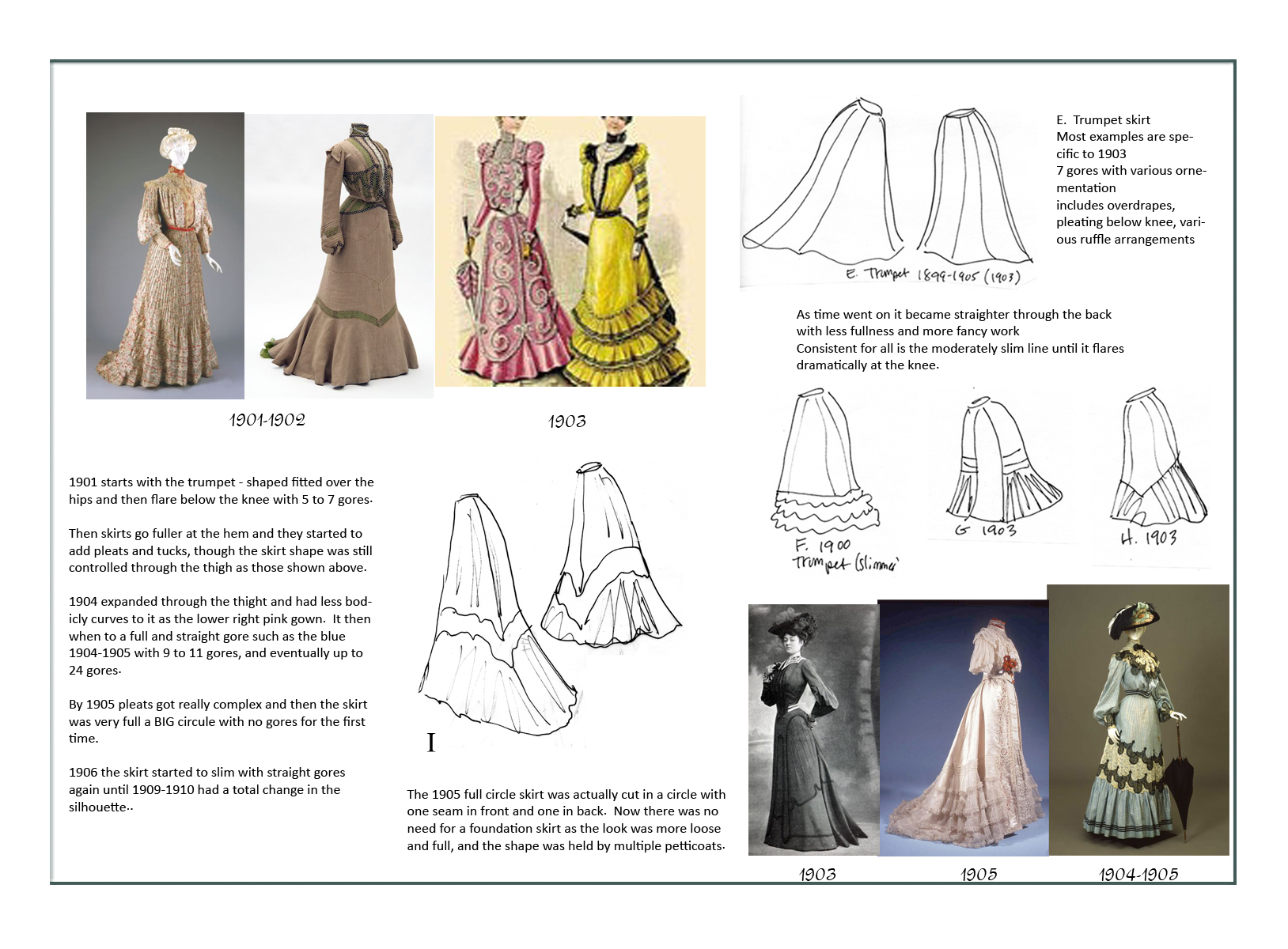
Key people, events, and technology that caused them to be and to change
 See Colonial 1740-1780 and Regency 1780-1837 Era pages (as well as specific projects by date) for more on what preceded the Victorian Fashion Era
See Colonial 1740-1780 and Regency 1780-1837 Era pages (as well as specific projects by date) for more on what preceded the Victorian Fashion Era
You need to know French nobility.. .. to understand fashion from the 1770’s to the 1870’s. FRANCE led American & English fashion despite the eras being named for the ENGLISH: “Georgian” (after 3 English kings named George), “Regency” (referring to the transition of power between 2 of the English Georges), & “Victorian” (almost a century of Queen Victoria’s dictates).
Only “Edwardian” fashion would actually be spearheaded by King Edward of England.
(photo: Napoleon Bonaparte, Emperor of France’s, direct lineage chart)
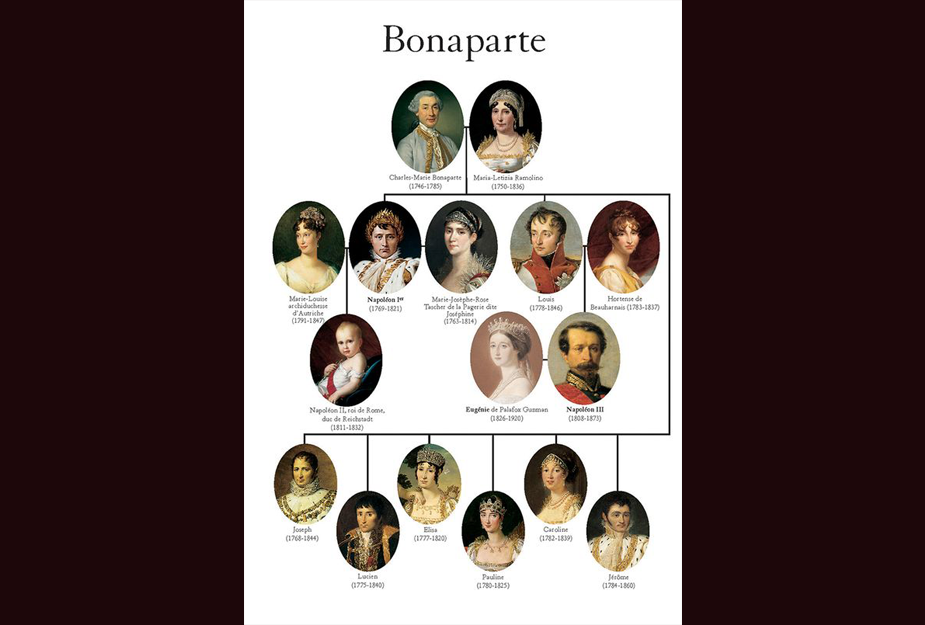
Why do we care about French & American Revolutionaries..? The French Revolution was important to fashion, because what France did; everyone else did (include war, conflict, & Court intrigue).
France ruled American fashion from the early 1700’s & through both Revolutions until France’s reign ended with the flashy “Belle Epoque” era at World War I.
France ruled fashion because:
1) England followed France, & America followed England;
2) Trade & communication with other parts of the world was limited; e.g. Japan was an isolationist country until the end of the Shogun era;
3) France made great fabrics, laces, notions, & designs
4) The French, uninhibited compared to everyone else of Western society, went naked in public
(painting: French painter Delacroix’s Romantic Era depiction of the French Revolution)
The French Royals from 1740 and are up to 1840, when, by the time of Napoleon 1’st’s grandchildren, they had cross-populated into all other countries of the European continent: Russia, Prussia, Spain, Portugal, Sweden, Denmark, Bavaria, Austoria, and others (names and boundaries having changed through history).
With a vague wave of the hand to the fashions they introduced, we continue with the Napoleon line as it crosses most “seriously” into the English and Russians, which takes us to 1914 and WWI (the extent of the fashions we build).
If you have studied the Regency Section, you should have your Maries, Josephines, Eugenies, Alexandras, and Victorias of several generations straightened out.
What has this to do with American fashion 1740-1914 you ask??
Everything, because until about 1900, America women followed most everything the French (English, Russian, Spanish, etc.) Royals and nobility did, as modified by their own situation or environment.
(Photos: 1851 left: American bride following Queen Victoria’s fashion dictates of wearing white for weddings; right: Queen Victoria of England’s 1851 ballgown)
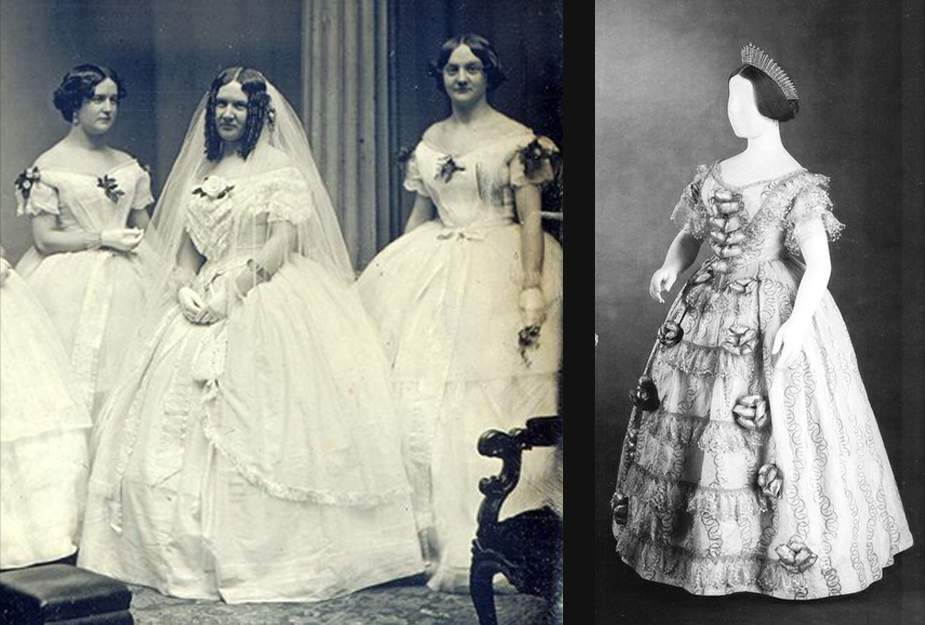
It’s easy to get confused about who the Napoleon family was. There were several Napoleons, and several Eugenies. All were part of the same family. The way to tell the difference is by what they were wearing: e.g. the first Empress Eugenie was rather flamboyant. She wore huge crinolines early, and later the big bustles. She was the height of fashion.
Younger Victoria Eugenie of Spain was the height of fashion, but “La Belle Epoque” extremely sophisticated styles more consistent of what we see royalty wear today.
(Portrait: Eugenie of France in an 1854 crinoline)
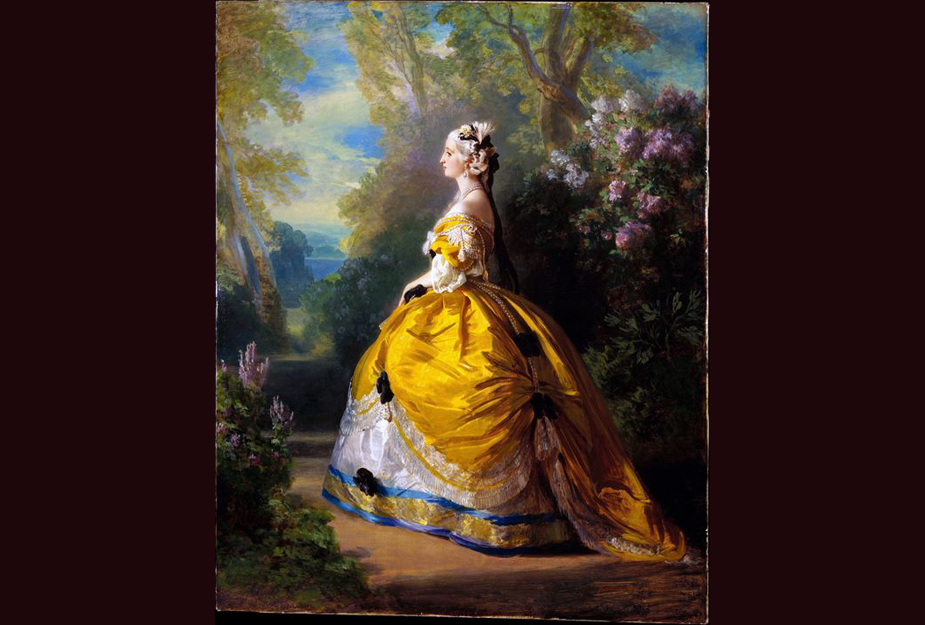
In the early 1800’s, the new United States had been a colony of England. The West Indies were part of England. India, and many African countries were part of England. Prussia, Russia, the Ottoman Empire, and many European countries were at war with each other; changing boundaries and political “ownership”. Asia was, by their own choice, cut off from everyone – denying access, information, and trade to but a few Europeans until the mid to late 1800’s.
Napoleon Bonaparte and France was seeking world domination – wanting to take over England and all their holdings and their world Empire status. This was done politically, militarily, and by populating leadership with the Napoleon family, as we have been studying.
The United States, tied to and limited by England in its ‘infancy’, had won freedom to explore and expand with anyone it chose by 1804. It chose to get into the fray a bit.. grappling for a island countries and those off its own coast to secure its newly won borders.. plus trying to obtain and maintain the vast territories of North America to expand.
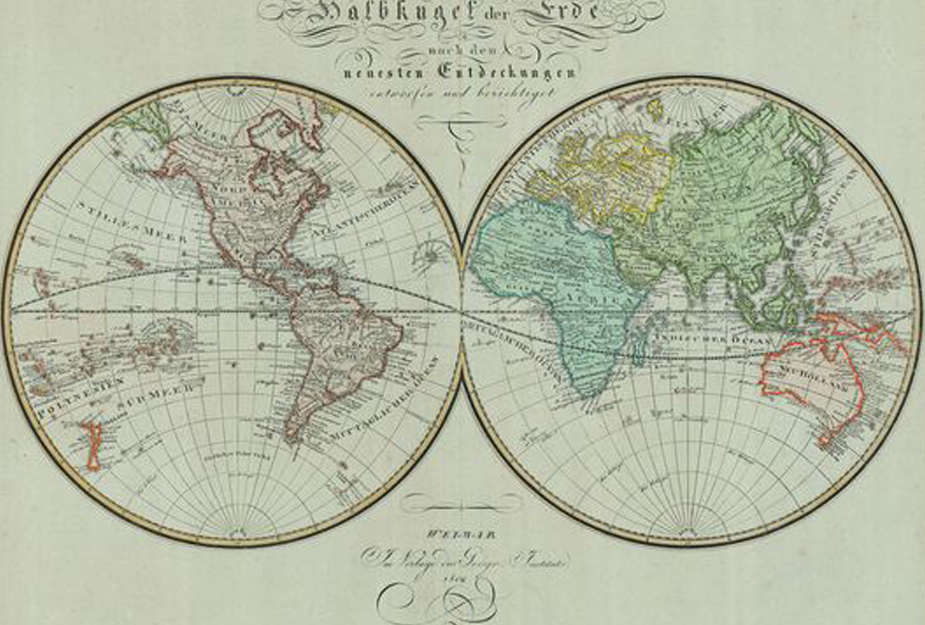
Lewis & Clark in 1804-06, allowed the US to understand its potential. Until then, other than trade with the mother country England and her allies, Americans were dependent on what they could produce themselves – meaning ideas and products.
Since English fashion followed French fashion, that meant American fashion followed French fashion too – with modifications for accessibility and availability.
While the world stage changed constantly through the period, the main fashion influence in America (and we have intentionally left out indigenous peoples) was 1740 to about 1840 the French Bourbon kings, English king Georges.. into the Napoleons and their wars, and then the introduction of associated countries of Spain, Greece, Italy, Russia, Scotland, alongside holdings such as the West Indies and north and south Africa with India.
This is especially noted in Regency styles worldwide, as distinct design elements of these countries were added to the French “little white dress” (discussed in the very beginning of this blog).
In the century to follow, there would be tremendous input from the entire world as England regained dominance, European boundaries were redefined and “settled” to some extent, the Asias were opened to European and American exploration, and most importantly – communication and transportation developed to the point persons around the world could share ideas and goods.
First Key Influence – Eugenie of France
Enter key fashion & historical figure, Eugenie of Spain… … who married Napoleon III (Charles Louis), the nephew and heir to the French throne – or the French Republic depending on the political situation through their married lives.
(Portrait: a young Eugenie in the early 1840’s. Note the wide Bertha collar and fitting waist typical of the early Victorian era.. Victoria we will discuss later…)
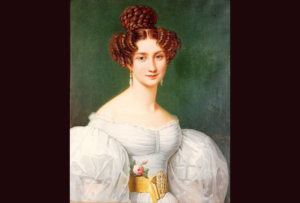
… although he was only Napoleon’s nephew, he became heir to the throne because Napoleon II, Napoleon’s only legal son born within wedlock to his second wife, Marie Louise, had died as a young man.
(Portrait: His Prince Imperial Napoleon III as a young man)
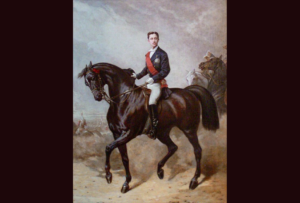
Eugenie Montijo of Spain, was educated in Paris… … and got into a lot of trouble. History alleges that because of a young man who spurned her for another, she tried to commit suicide. She was thrown out of school for various behaviors. Eugenie was always very fashionable, and had money to buy the finest.
(Portrait: Eugenie in her favorite purple, wearing designer gown with crinoline, making the Worth name famous in fashion)
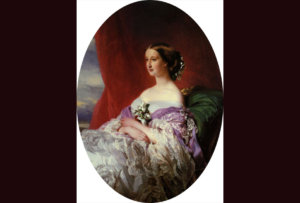
The marriage of Charles and Eugenie was not happy though… Charles had many extra marital affairs, so Eugenie buried herself in her work, playing the role of Empress well, becoming an extreme influence on French arts and fashion, & therefore world fashion.
(The most famous portrait: of Eugenie in 1855 shows a young in a Charles Worth designer gown with hoops and crinoline, surrounded in the French gardens by her Court at the height of her fashion influence)
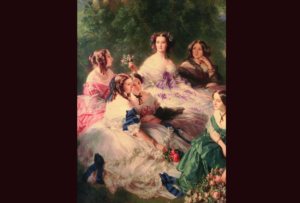
Eugenie’s marriage proposal lives as one of the worlds’ greatest quotes… Spanish born, Eugenie was educated in Paris, & was from the beginning a part of the fashionable aristocratic society. She met Louis Bonaparte (Napoleon I brother) at a party, where he tired to seduce her by asking “What is the way to your heart?”, to which she responded, “through the Chapel, sir”. Their marriage was arranged somewhat as a political alliance.
(Portrait: Eugenie’s coronation ensemble in 1853. Always the height of fashion and willing to spend the money for trim)
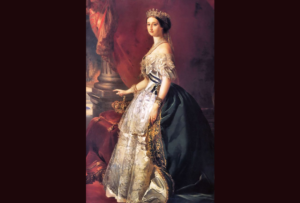
Eugenie would become the First Lady of France through the 1850’s… … and her influence in fashion and the arts went well into the 1880’s.
Married to Napoleon III, Eugenie was first an Empress, then the wife of a President as his role changed with the political landscape of France.
There were a few Borbons of the ancient French bloodline who would return during her reign, but Eugenie is notable because she was a woman following the footsteps of Marie Antoinette & Josephine.
(photos: Eugenie at her height of popularity in 1855 wearing a designer Charles Worth gown)
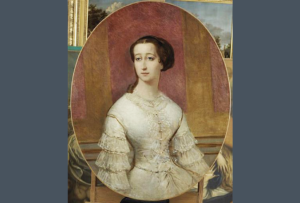
Napoleon III with Eugenie ruled as Emperor from 1852-1870… … as France was again an Empire. During this time Napoleon built an estate for Eugenie, who was very unhappy in marriage and wanting to contribute to the arts and sciences. Her “Barritz” drew the most fashionable society to France once again.
(Photo: Chateau de Pierrefronds.. residence and center for arts and sciences)
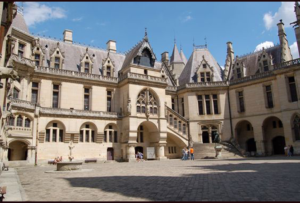
Eugenie and Charles-Louis were married in a political liason… … Charles (Napoleon III) was NOT the emperor when he married, because the defeat of Napoleon I dissolved the empire. Napoleon III was the President of the 2nd French Republic at the time of his marriage. Eugenie and Napoleon III were married in 1853, and they really didn’t like each other. He had been looking for a wife for political reasons, and she had been groomed all her life for a position of nobility. Both saw the chance to achieve their goals, and agreed to some attraction that made it a bit more tolerable.
(Portrait: Eugenie in 1855 watches her husband receive an award)
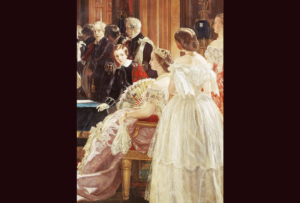
Eugenie & Charles tried to have an heir.. .. but they had problems not only with their relationship, but in conceiving a child. Eugenie had 2 miscarriages early in their marriage; one of which history accuses her of having from an extramarital affair.
(Portrait: 1857, Eugenie and Charles finally have a live birth – a son who would become Napoleon IV)
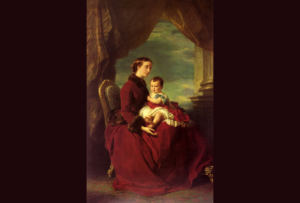
Napoleon IV, son of Eugenie and Napoleon III would not survive.. The finally had a live birth of a son – Napoleon Eugene Louise Jean Joseph Bonaparte, Napoleon IV. Unfortunately, Eugene would die at war at the age 19.
(Portrait: Eugenie, Napoleon III, and their son Napoleon IV as a child attend Court in about 1863)
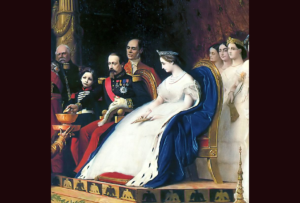
here were Napoleons I, II, III, IV.. but Napoleon III would carry on… On the men’s side, the confusion is in all the men named or whom renamed themselves Louis or Napoleon.
The first Napoleon I had a son with his 2nd wife (Marie Louise) who was his official heir. He was named François Charles Joseph & Napoleon II, but he died as a child.
Napoleon I’s brother’s name was Louis-Napoleon. He called himself Napoleon, as his name, but he did not have title and did not really want it as he was very happily already a political ruler. Louis-Napoleon married Napoleon I’s stepdaughter, Hortense at the request of Napoleon I.
Hortense & Louis Bonaparte (the brother) had a son whom they named Charles-Louis. He called himself Napoleon III & married Eugenie (the ones we are discussing this week). He was the rightful heir, even though he was in political power while Napoleon II was still living, because Napoleon II wanted nothing to do with the throne.
Charles-Louis (Nap III) & Eugenie named their son Louis-Napoleon and called him Napoleon IV. THAT Louis-Napoleon died as a young man.
Got it? Just wait until we get into the Victorias and Eugenies…
(photo: Eugenie with Napoleon III & their son Napoleon IV; below – same photo session Napoleon III with just his son Napoleon IV)
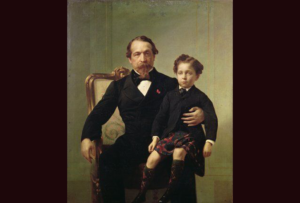
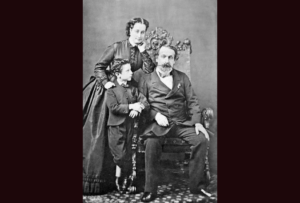
Eugenie of France liked clothing! In 1854 she made the crinoline… Always in a social whirl, or leading a statesman’s event, Eugenie liked to be the focus of attention and dressed to get it. Throughout her life, she hired the finest designers & made them famous.
(portrait: Eugenie making the crinoline very popular in 1854. She introduced the hoops to Queen Victoria & England)
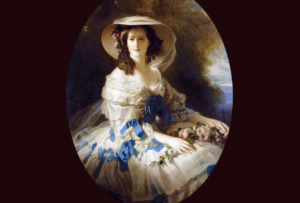
Everyone around Eugenie was fashionable… She surrounded herself with crinoline wearing friends. Often she would hold week long parties at her estate at compeigne.
(Photo: Eugenie – center front – hosts notable women of royal and noble blood at her estate. Most notably are Queen Victoria of England and Victoria’s daughters)
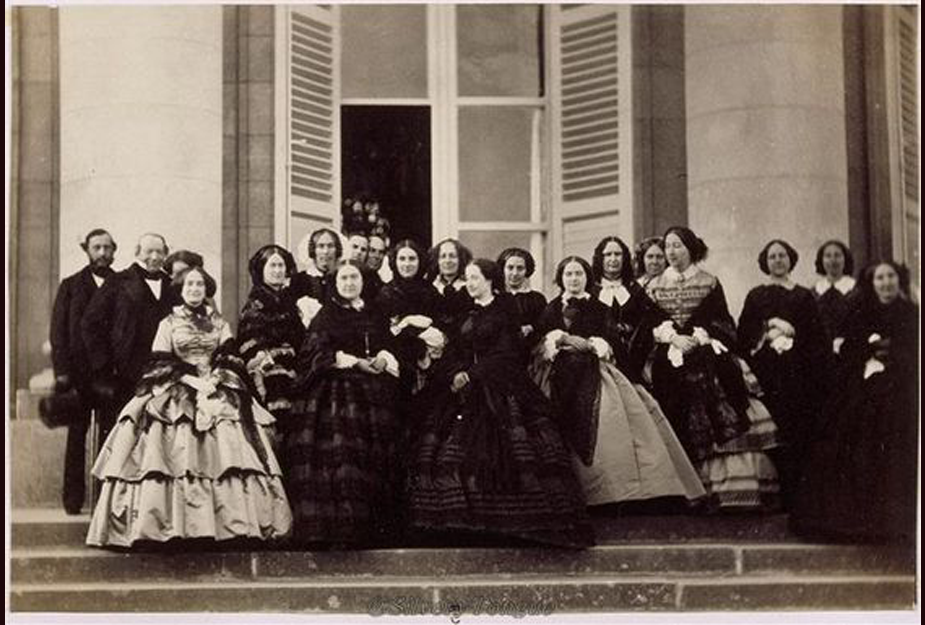
Eugenie ran France while wearing designer gowns… ..In Napoleon IIII’s absence when he was at war (which was quite often), Eugenie ran the country. She supported the garment & textile industries, & hired only the finest fashion designers for herself & her friends.
She was a great customer for the infamous House of Charles Worth in Paris. Worth was an Englishman who introduced fashion shows, salon lighting, designer labels, & most importantly the concept of “costume” – meaning you had to have a different ensemble for each different activity.
(portrait: Eugenie made the crinoline world famous. Following French Royals’ tradition since about 1800, her formal receiving gown included fur.. usually ermine or mink with silk – this designed & made exclusively for her by Worth) Labelled 1852, that would be before her marriage; more likely 1862.
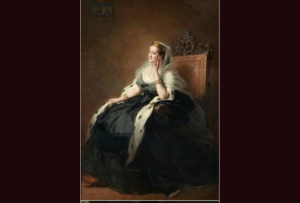
A fashionable portrait of Eugenie with her son in 1862… With the development of the photograph camera by Eastman, the history of Royals and of fashion was now recorded life to death.
While the camera was not yet available to the every day person at the time, portraiture of those who could afford it took on a whole new meaning. While most were posing for stiff and formal portraits only, European nobility had the luxury of documenting every day life through “snapshots” or casual/candid photos such as these of the Napoleon III family in the 1860-80’s.
(Featured photo: In her crinoline sporting black in 1862. Below with her son in 1860 (check out that carpet!)

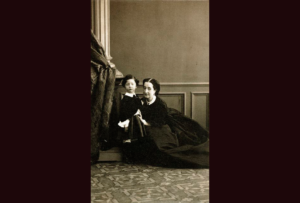
Eugenie influenced 3 fashion periods within the Victorian era.. .. We discuss Eugenie’s role when we get to the “Crinoline Era” of the 1860’s, the “1st Bustle Era” of the 1870’s, and the “2nd Bustle Era” of the 1880’s.
Leading fashion of the world, and being in a position to meet and get to know them. Eugenie directed the Royals of other European influenced countries such as Russia, Sweden, & the Netherlands – even Victoria – during the Victorian Fashion era named for the Queen of England.
(Photo: A colorful and relaxed Eugenie of France. Because photos of the time were in black and white, we tend to think she’s wearing black or gray, whereas in reality she loved intense, saturated colors including ranges of purple and deep red)
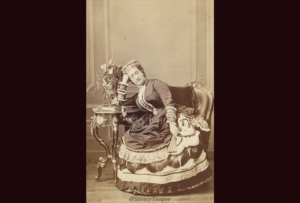
Eugenie influenced 3 fashion periods within the Victorian era.. .. We discuss Eugenie’s role when we get to the “Crinoline Era” of the 1860’s, the “1st Bustle Era” of the 1870’s, and the “2nd Bustle Era” of the 1880’s.
Leading fashion of the world, and being in a position to meet and get to know them. Eugenie directed the Royals of other European influenced countries such as Russia, Sweden, & the Netherlands – even Victoria – during the Victorian Fashion era named for the Queen of England.
(Photo: A colorful and relaxed Eugenie of France. Because photos of the time were in black and white, we tend to think she’s wearing black or gray, whereas in reality she loved intense, saturated colors including ranges of purple and deep red)
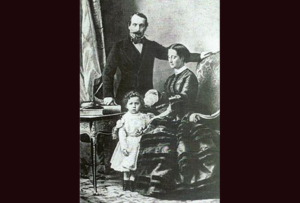
This is a Eugenie’s actual gown in a museum today.. .. Designed by Worth who claims to have “invented” the crinoline, it is typical of just one of many Eugenie of France wore to affairs of state.
One might think this was white silk that had aged to yellow, but we know at this time in the Victorian Fashion Era, that white was specifically designated by Victoria to be for only wedding attire. This most likely was indeed a pale shade of yellow for a ball or Court function.
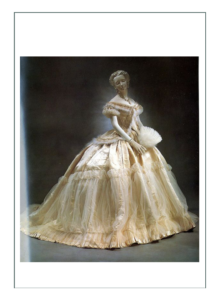
Eugenie in the 1870’s & 1880’s wore bustles… .. and every fashion ensemble was designed just for her by a world renowned designer.
It was Eugenie who made the designer world renowned.
(Photo: An aging Eugenie wears designer Louis Vitton)
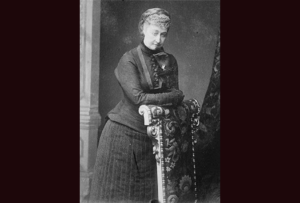
Queen Victoria of England met Empress Eugenie of France… … at Eugenie’s Biarritz, and they became close friends. It was here Eugenie introduced the crinoline to Victoria, which the Queen would take back to England to become an integral part of Victorian fashion.
(Photos: Featured: Eugenie’s Biarritz, on the Cote d’Azure in France, is still a vacation spot; below Palais Hotel in Biarritz, France)

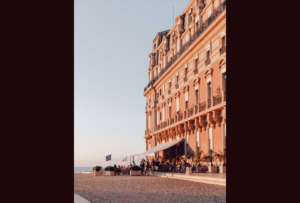
Queen Victoria visited France, and Eugenie visited England.. .. quite often and became very close. One can imagine being a Queen or Empress made it difficult to talk openly and honestly with anyone other than another royal.
We know they traded fashion secrets, because history and the museums document that after a Eugenie visit to England, Victoria would sport the latest Parisian Worth design that Eugenie had just worn on her visit.
(Painting: The Formal introduction of Queen Victoria of England in 1855 to Empress Eugenie of France. They were actually good friends already, having met informally at Eugenie’s estate)
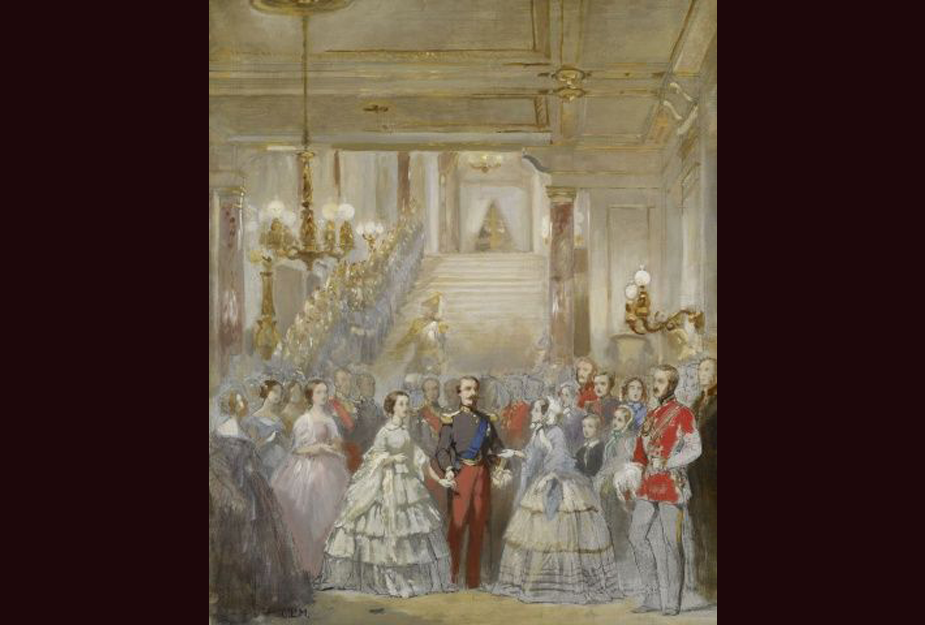
The Napoleon III’s and Queen Victoria were buddies.. .. visits back and forth between countries, and the marriages of their extended families into the other Royal families across Europe had them quite publicly connected. The eventual use of trains for travel increased the interaction.
(Sketch: Napoleon III of France escorts Queen Victoria of England in an early 1860’s visit to France)
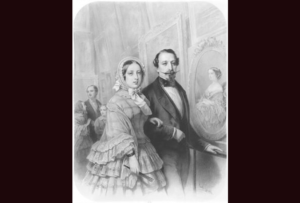
Queen Victoria of England preferred to travel by carriage.. … and as in this portrait in 1897, was still going back and forth between countries to see her grandchildren, whom by that time, were also grandchildren of Eugenie of France. They became one, big family of Royals who spanned all of Europe.
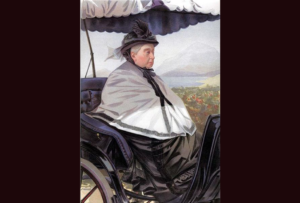
Not limited to clothing, Eugenie was a patron of all the arts.. Eugenie, last empress of France’s introduction of artists & craftsmen of all walks of life improved France’s status in the world of fine arts. She was known for her sponsorship of potters & artists of all types.
(Photo: some of Eugenie’s formal wear jewelry, made especially for her by artists she commissioned, sponsored, or help raise to fame by just wearing their art)
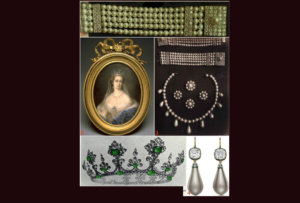
Eugenie’s influence on French fashion went beyond clothing… Eugenie was extremely active in the arts, & attended & sponsored theatre, dance, & visual arts. She traveled extensively including countries like Constantinople, which brought influences of fashion & textiles previously unattainable to prior nobility.
(Photo: a somewhat aging, but forever fashionable Eugenie sports the 2nd bustle which looked like the rear end of a horse; shown here with her husband, Napoleon III)
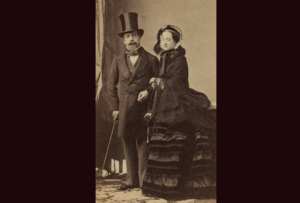
When Eugenie died, it ended the days of French fashion dominance… there would be many more Eugenies including her namesake, but no one who followed would be able to create, sponsor, wear, and market new innovations like the original Eugenie did.
Some think it was her strong personality and will, some think it was a world with increased exposure to ideas, and some think it was the connections she had to people in positions of power, but there was no one like her again.
The time of French fashion was over.
(Photo: Eugenie in full Court apparel)
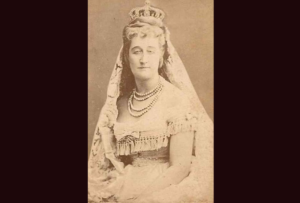
Eugenie of France’s end meant the beginning of a new type of royalty… Eugenie lived past her husband and one son, long enough to see the collapse of the European empires. She was exiled, but allowed to return to visit Queen Victoria.
The influence of the two monarchs was profound on world fashion, as they crossed over 70 years of change in the independence of women and from crinolines, to bustles, to bras.
(Photo: A sedate Eugenie in wool, date unknown)
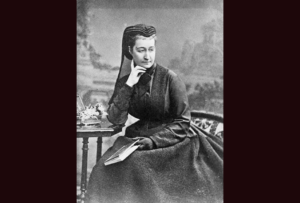
This is how Eugenie of France is best remembered… … and where the “Southern Belle” of the American south got her crinoline fashion should be VERY obvious!
(Portrait: Eugenie introduced Designer Worth’s crinoline innovation to the world in the 1850’s.)
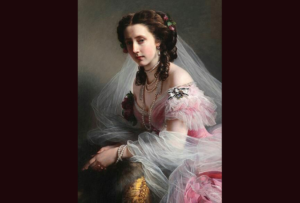
History from this point on, has a lot of Victorias & Eugenies in Europe… .. and the easiest way to tell them apart is their fashion.
History gets the most notorious 2 Victorias and the 2 Eugenies confused a lot, but you can tell by their clothing which one is being discussed. Each went through a specific fashion era, and it helps that they were all very fashionable and up to date with the most current styles.
(Portrait: Dowager Empress Eugenie of Spain, goddaughter of Queen Victoria & Granddaughter of Empress Eugenie of France, with Queen Victoria of England in about 1915)
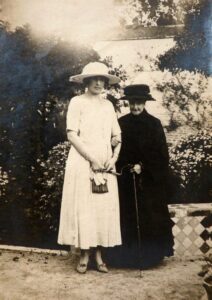
Enter, Victoria
Queen Victoria was THE key fashion influence in the world… … and especially American fashion for decades to come. Starting in 1837 with her coronation, Victoria dictated fashion worldwide. We will discuss Victorian fashion in great detail this winter to come.
(Photo: Queen Victoria of England with her daughter and namesake, Princess Victoria)
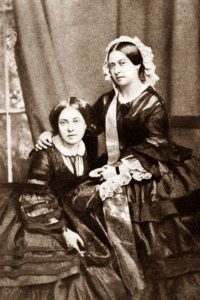
hile Marie Antoinette, Josephine, & others were key influences in the Colonial and Regency Eras worldwide, and so in the new United States of America… .. it was the vast communication network that allowed Queen Victoria to spread her fashion dictates. With the advent of photography in the early 1840’s, people could SEE what she was wearing.
In the days of Josephine, Napoleon sent out fashion dolls – actually tiny dolls – to show what women were to wear. In the days of Marie Antoinette it was words of mouth, sketches, and mostly portraits. Before photography, and in Eugenie’s reign also videography, word of what was in fashion was very limited.
With Victoria and those to follow, every woman knew worldwide what the Queen was wearing today, and she made sure they knew.
(Portrait: Queen Victoria of England as Princess at age 4. Prior to photography, her fashion sense was distributed by paintings and sketches)
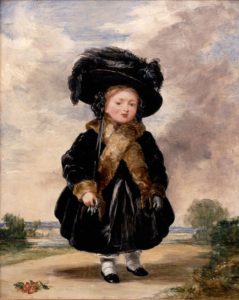
We start the Victoria & Eugenie connections with Beatrice.. … One of Queen Victoria of England’s daughters. Beatrice, the youngest and 5th daughter, was the Queen’s assistant. They were very close. It was natural Beatrice would also become close friends with Victoria’s new French friend, Empress Eugenie.
(Portraits: Queen Victoria and daughter Beatrice in 1863.. always in the height of fashion for child or adult – this being the crinoline era for all. In the US at the same time, America was smack in the middle of the Civil War)
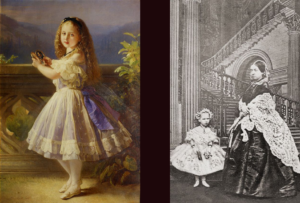
Princess Beatrice of England, Victoria’s daughter… … married a man from a “non-Royal” family, but with the Queen’s blessings. Beatrice had a daughter in this marriage whom she named Her Highness Victoria Eugenie of Battenburg. Queen Victoria granted this granddaughter the title “Highness”.
(Photo: yes photos now! Beatrice in the height of 1885 fashion – just before the BIG bustle, and with her husband Henry of Battenburg in 1886)
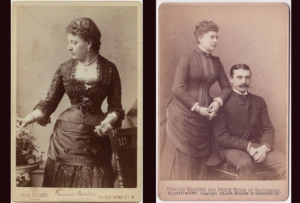
You can tell which Beatrice, Victoria, or Eugenie in history is by the clothing… if you know roughly the years of their adulthood. Always the height of fashion, from Queen Victoria’s 1837 forward, the English Royals were on top of it. Before that it had been the French.
French influence was fading fast with only Eugenie left at the height of fashion in the 1850’s-’60’s. Queen Victoria took command of European and American fashion, but with the Asias becoming accessible, and travel and communication opening up the globe, by the end of Victoria’s reign there was a virtual “explosion” of fashion ideals with influences from every country in the world.
(Portrait: Even in 1928, Her Highness Beatrice of Battenburg (daughter of Queen Victoria of England) wore the height of fashion. Note the pearls that were handed down from mothers to daughters, and the middle eastern influence in the fabrics and patterns by the ’20’s in this picture.)
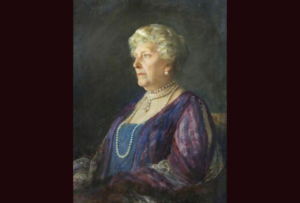
Beatrice, daughter of Queen Victoria would become… .. the last Empress of Prussia when she married Henry of Battenburg. Beatrice, the companion and confident of her mother, had said “I don’t like weddings. I shall never marry.”
She fell in love with Henry after meeting him at her niece’s (another Victoria) wedding. Victoria did not want Beatrice to leave, so made the deal with the newlweds that if they would live in the palace and take care of Victoria until her death, she would permit the marriage.
Beatrice and Henry were married in 1885.
(photo: The Battenburgs on their wedding. Note the distinctive fitted and flat front of the high style of the day, with the bustle, at this time mostly fabric with a pad support, that would become the largest one in history by the next year 1886)
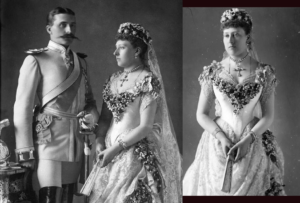
Her Royal Highness Beatrice of Russia took care of her mother… .. Queen Victoria of England. She and husband Prince Henry lived in the palace, and eventually Victoria realized they needed space of their own and gave them an estate nearby.
(Photo: Beatrice and Henry official portraits 1886)
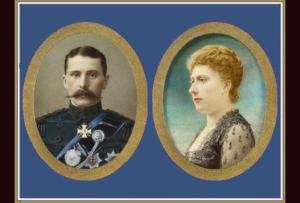
Henry, Queen Victoria’s son in law, wanted to help the English military.. He “escaped” life in the palace often to participate in English campaigns, but Beatrice, Henry’s wife and Victoria wanted to keep him closer to home. Prince Henry on one such excursion in the Anglo-Asante War, never returned. He died of malaria, sending Beatrice into deep mourning.
(Photo: Henry of Battenburg, of the Prussian House of Hesse in the late 1880’s wearing a plaid. Queen Victoria loved the kilts and plaids of the Scots, and brought the styles and patterns into English daily wear, and so, worldwide fashion)
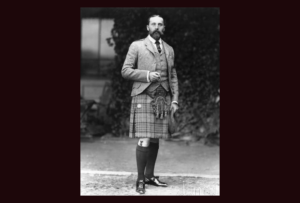
Beatrice and Henry had 4 children… .. and they were the great grandparents of the current ruler of Spain, Felipe VI.
(Photo: Henry, Beatrice Queen Victoria’s daughter, and children around the table with Queen Victoria in Windsor Palace. Note Victoria’s loyal Indian servant, Muhri, in the background of this and other photos)
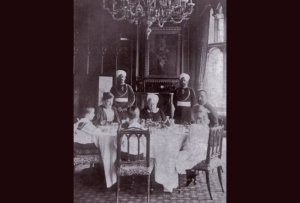
Beatrice’s Brother in Law was King Frederick of Prussia.. … which ties the English Royalty into the French (and obviously Prussian) Royalty.
(photo: The Hesse family of Prussia, including Beatrice, Henry, their children, and loyal servant Muhri, gather around Queen Victoria. Although the photo is not dated, the HATS and slim, no bustle profile of the skirt, indicate this to be around 1883.)
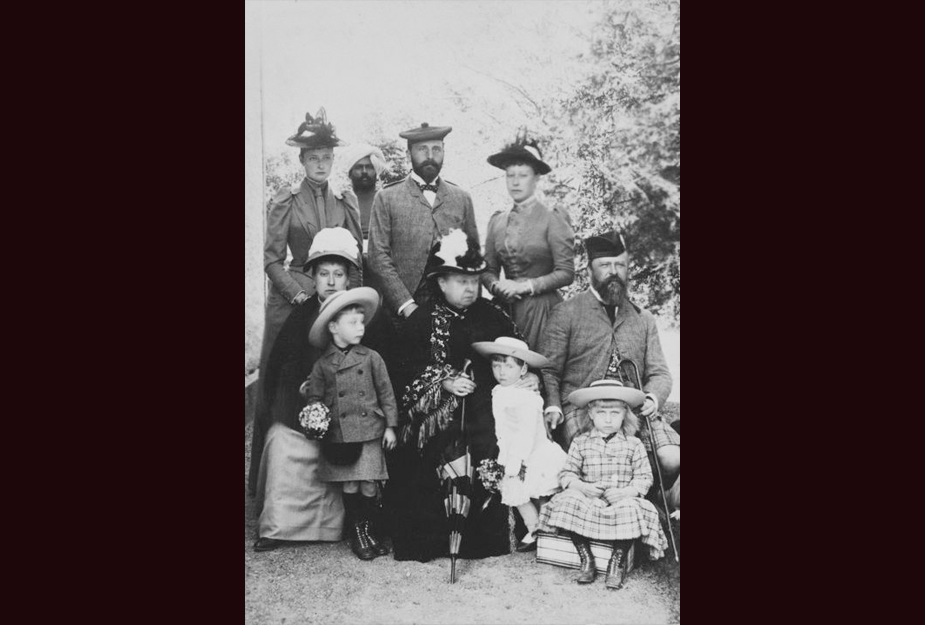
Beatrice and Henry had children.. … the Royal Family of England, now tied to royal families of Prussia through this marriage, had:
Alexander, 1886; Ena (Eugenie, we will discuss in a bit), 1887; Leopold, 1889; Maurice, 1891
(Photo: Beatrice with her mother Queen Victoria and Henry and kids in about 1890. Note Victoria setting the fashion trends – as always through her reign!)
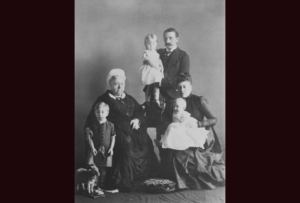
HRH (His Royal Highness) Beatrice’s youngest son Maurice was killed in World War I… … the grandson of Queen Victoria of England, and son of her youngest daughter Beatrice. It was a great loss to the royal family.
(Portrait: Maurice just before his death in full military dress)
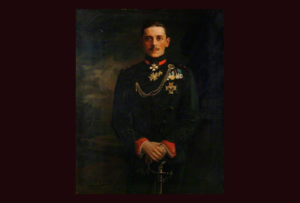
Beatrice comforted her mother Queen Victoria.. … until Victoria’s death. Beatrice, talented in singing, and with a passion for photography, had been given by her mother a photographic dark room. She continued her artistic pursuits throughout her life.
(Portrait: 1908 Her Royal Highness Beatrice)
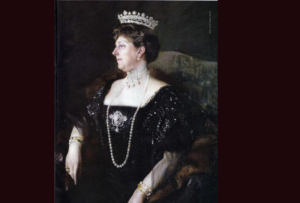
Her Royal Highness Beatrice of Battenburg became… … Her Royal Highness Beatrice of Mountbatten.. when King George IV suceeded her mother to the throne of England in 1917. Her last official public appearance was at his burial in 1944 when she was 87 years old.
(Photo: King George IV and wife Mary on their wedding day in 1893. THIS shows the HEIGHT of world fashion of the day – the corset is of particular note, plus the shape of the dress. Bustles were out; Edwardian skirts were coming in)
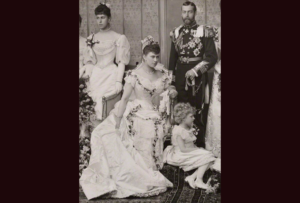
Back to the Eugenies… Queen Victoria’s granddaughter from Beatrice… … Her Highness Victoria Eugenie of Battenburg.. was named after Queen Victoria of England and Empress Eugenie of France. Eugenie of France was Victoria Eugenie’s godmother – uniting the two countries as only women could do – through love of fashion, country, and family.
(Photo: Beatrice with her only daughter, though she had 3 sons, called “Ena”)
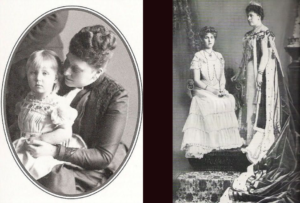
Beatrice, daughter of Queen Victoria, and her daughter, Ena.. … were both hemophiliacs, a rare disease affecting the ability of blood to clot. This was a genetic trait handed down on Victoria’s side, and one of the reasons the Queen was hesitant to permit her daughter to marry.
In the end, it would be Ena who was most doted upon by all, and connected Royal blood between France, England, and Russia.
(Photo: Beatrice with a teenage daughter Ena in the 1890’s)
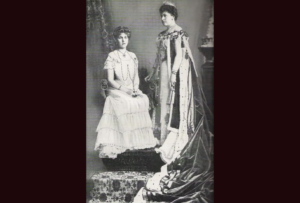
Victoria Eugenie of Battenburg, “Ena”, granddaughter of Queen Victoria, is well illustrated… … and known for her fashion, as photography was at last developed so that a woman’s life could be accurately documented from birth to death.
(Photo: Ena with her husband and an aging mother Beatrice, in the height of fashion in about 1895 – the high sleeves of late Victorian style as it merged with what would become the 2 piece blouse and skirt of the Edwardian fashion era)
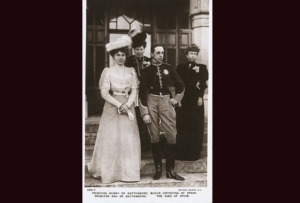
There are MANY photos of Victoria Eugenie, granddaughter of Queen Victoria… .. goddaughter of Eugenie of France. She was, of course, appropriately fashionable in each era.
(Photo: Victoria Eugenie in the mid 1890’s)
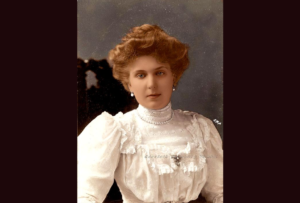
With the ease of new photographic methods… .. the Royal family could now be followed in their daily lives. They still loved the posed portraits when everyone was able to gather though.
(Photo: 4 generations of English royal women: Victoria with daughter Beatrice, granddaughter “Ena” Victoria Eugenie, and Ena’s daughter Alice the baby)
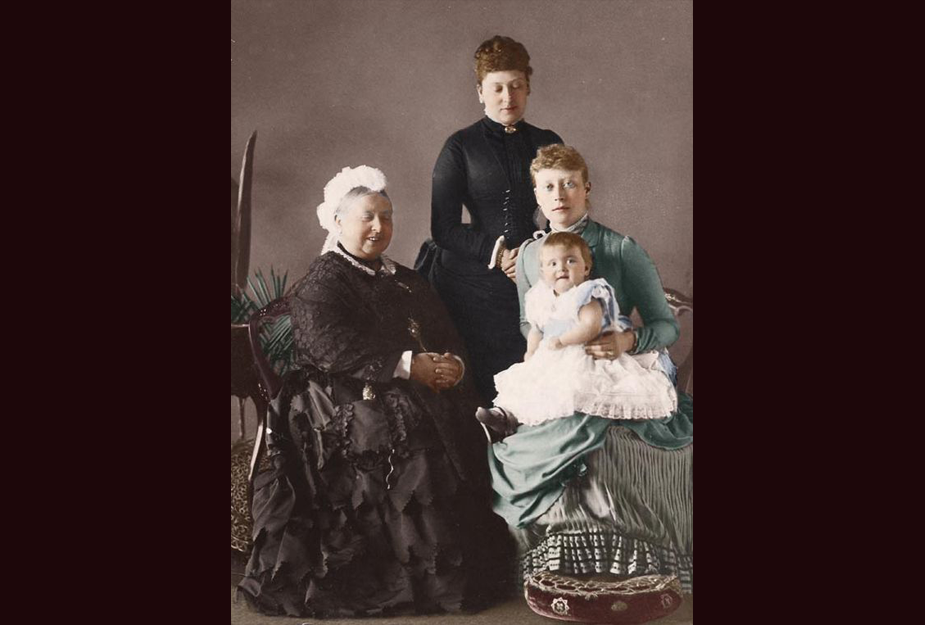
Well photographed Princess Beatrice, who would become Her Royal Highness of Battenburg, console her mother Queen Victoria at the death of her father Albert, and care for her mother the rest of Victoria’s life.
(Featured: in high winter fashion. below; as the companion and secretary to her mother)
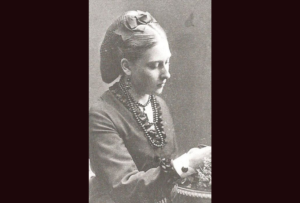
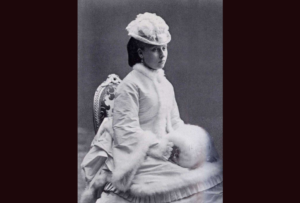
Ena, granddaughter of Victoria, and daughter of Beatrice.. .. was the godchild of Eugenie of France. Ena brought the families and countries together.
She was the last Empress of Spain before Spain became a Republic.
(Photo: Well photographed by her mother, an excellent photographer with her own dark room, Ena is in the height of royal fashion during a casual moment with her sons)
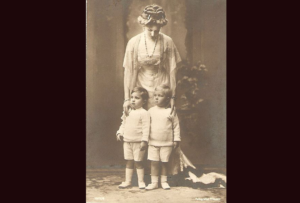
ere are more photos of the fashionable and well documented Ena… … connected by blood to royalty of 4 nations: England, France, Spain, & Prussia.
(Photo: a young Ena (Victoria Eugenie of Battenburg), later to become Ena of Spain)
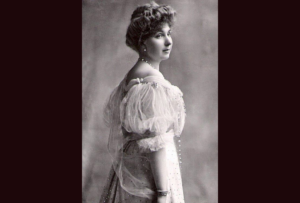
English royals left their jewels to the next generation… …Sometimes that meant tiaras, necklaces, and bracelets left the country forever.
This photo shows Ena, daughter of Beatrice, Queen Victoria’s youngest & goddaughter of Eugenie of France, wearing the English royal pearls – in Spain.
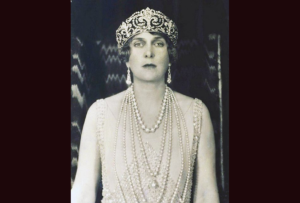
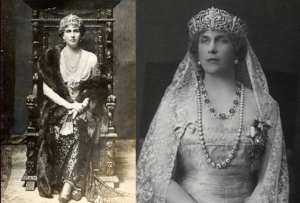
Ena, granddaughter of Queen Victoria & Goddaughter of Empress Eugenie… … inherited much royal jewelry from both, plus a flair for fashion.
(Portrait: Ena, Empress of Spain, wore her grandmother, Queen Victoria’s aquamarine and amethyst prarure)
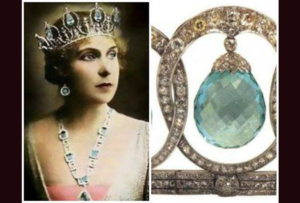
It’s interesting how the Royal women wore antique jewels.. … as with modern day Josephine of Sweden shown here wearing her great grandmother Empress Josephine of France’s favorite cameo tiara (prarure), it’s amazing how well the same jewels will go with any fashionable ensemble of any era.
(Portraits: left, Empress Josephine of France; right, Josephine of Sweden)
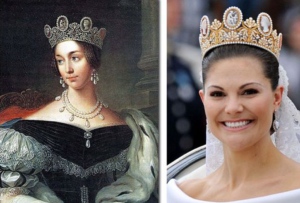
Modern Queens wear modern clothes & ancient jewelry… … here we see Queen Elizabeth, current monarch of England, wearing Queen Victoria’s mother’s approximate era 1830 brooch.
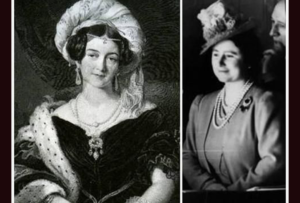
Yet another Royal pulls off a fashion feat… … wearing Queen Victoria’s brooch, Queen Letitzia of Spain has inherited English, French, and Spanish jewelry. An absolutely stunning woman who was a journalist and news anchor before marrying Felipe to become the Spanish Queen, she wears the tiaras, prarures, and brooches of her ancestors proudly and often.
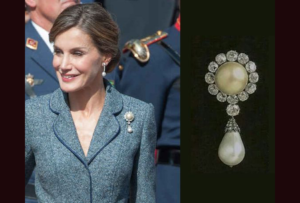
Ena, granddaughter of Queen Victoria of England, lived in a magical time… .. when fashion was changing. Being a trendsetter did not always mean being well coordinated. Here is Ena, in ermine, silk, and the Royal pearls (of course), sporting a 1920’s number at a dedication ceremony, proving pearls do not necessarily always go with everything (as they would say later in the ’50’s).
Note that by this time silk was no longer the crisp and starchy taffeta of her grandmother and greatgrandmother, but a soft, drapy fabric that clung to the body – unless it was worn in the very straight style of the era.
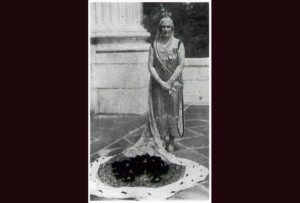
Ena was loved by all, including her father… … Prince Henry of Battenburg. Named after her grandmother Queen Victoria of England, and her godmother Empress Eugenie of France, Victoria Eugenie had a casual relationship with her elders in private. She called Victoria “Gangan”.
Ena first met her future husband when she was 17. King Alfonso XIII of Spain was 19 when they met in 1905, during his tour of Europe in search of a bride, at a dinner gathering at Buckingham Palace.
It was rumored Alfonso had Victoria Eugenie’s cousin, Princess Patricia of Connaught, in mind, but that rumor went straight out the window when Alfonso set his eyes on Victoria Eugenie. This was no loss for Patricia since she made it evidently clear that she was not marrying the lustful Alfonso.
(photo: Ena on her father Henry’s lap)
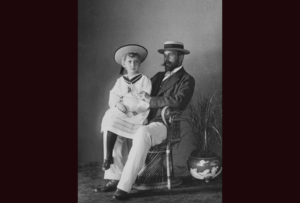
Victoria Eugenie (“Ena”), Queen Victoria’s fashionable granddaughter… .. had a life of ups and downs. When she met her eventual husband Alfonso of Spain, she was only 17. He had a fiery and passionate temperament, while she was shy.
He was worried about the possibility of her carrying her mothers’ dreaded haemophilia blood disease and passing it on to his heirs, thus bringing it to his country. Alfonso’s advisors warned him that it was most likely she had it since it was genetic and because her brother was very ill from it, but Alfonso pushed their concerns aside. He couldn’t understand why the healthy and beautiful Ena could be ill.
(Photo: Ena and Alfonso on their wedding day. White by now was the accepted color for weddings, courtesy of the dictates of her grandmother. Note Alfonso’s cigarette burning, even in his royal portrait, indicating his “rogue” personality that would come into play later in their lives…)
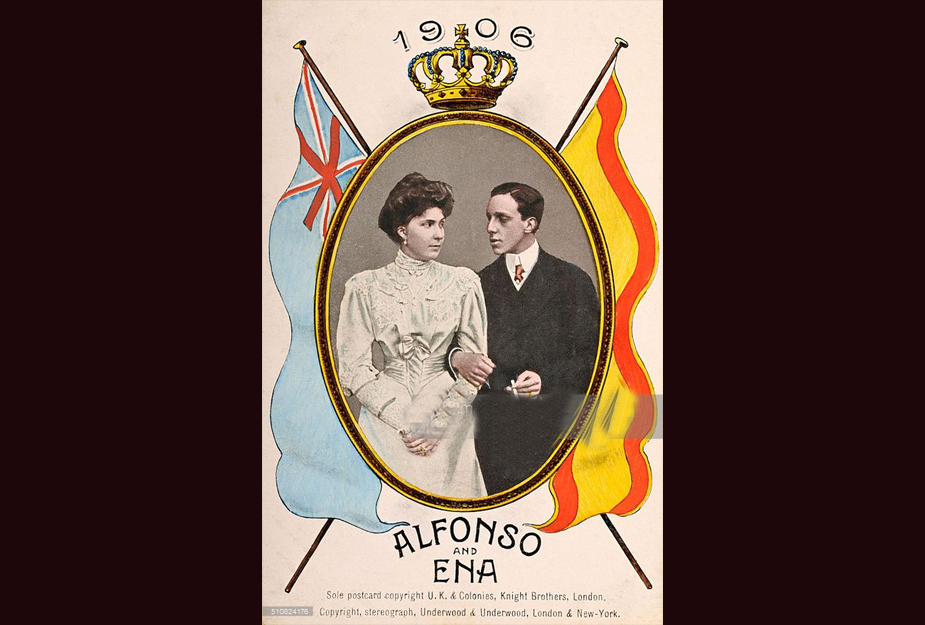
Ena of England and Alfonso of Spain also had problems.. … with religion. Ena had been raised a Protestant, and all Spanish royalty, to which she would belong, was strictly Catholic. Ena’s English supporters did not want to be associated with Rome or Catholics.
People of all social status had heated discussions which made Victoria Eugenie feel very low at the beginning of her relationship with Alfonso, for causing such conflict.
(Photo: this might have been taken by Ena’s mother, Beatrice, who had a dark room and portable camera. Taken on their wedding day, you can see Ena was not the slim corseted profile her front view indicates. Typical of Edwardian fashion, the back of her gown would be trained and full).
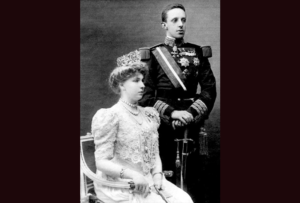
Ena learned Spanish during her brief marriage engagement period… … because she would become the Queen of Spain, giving up all rights to the British throne. Spanish and Spanish culture was difficult for her, and she only had a few months to learn it. She converted to the Catholic faith before marrying.
(Photos: Left Ena in full Spanish court splendor; right her mother Beatrice in full English court splendor, but it’s silk that reigns!)
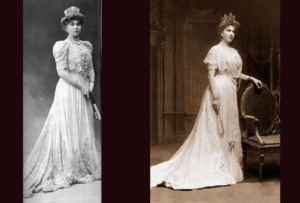
Ena and Alfonso’s marriage had a frightening start… … when a bomb went off near their carriage as they were leaving the Church of San Geronimo in Madrid.
The new queen appeared calm at the time, but when she got to the Royal Palace, she was on the verge of hysteria. One can imagine marrying a known “rake”, speaking a foreign language, leaving all that you knew, converting to a religion you don’t want, and having to face down a bomb AND a wedding night in one afternoon was a bit sressful.
(Photo: Bomb going off May 31, 1906 next to the carriage of the just married Victoria Eugenie, Queen Victoria’s granddaughter, and her new husband King Alfonso of Spain)
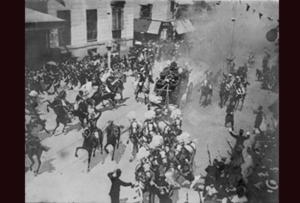
The new King and Queen of Spain, Ena and Alfonso… .. got along well enough, until his worst fears were realized that she proved to have the genetic disease hemophilia.
(Photo: Ena and Alfonso’s different personalities are very clear on this candid shot during their honeymoon in 1906. The advent of cameras had its drawbacks, as now there were photographers documenting every breath of the Royals around the world)
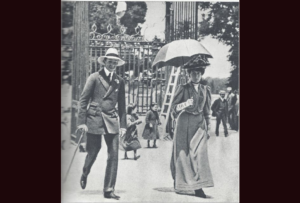
The wedding gift from Alfonso to his young bride has been handed… … down to each generation of women in the Spanish royal household. Called “La Buena” prarure, Letizia of Sweden’s mother (right) wore Ena’s (center) wedding crown, and Letizia (left) has it today.
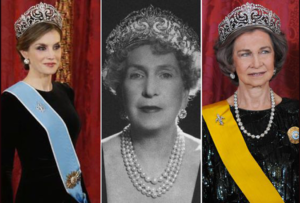
Ena and Alfonso of Spain appeared to be happy at first.. .. unfortunately, when they found out their first son Alfonso was also a hemopheliac (genetic blood disease), their wedded bliss fell apart. Alfonso responded by having liasons and affairs with several women.
He humiliated Victoria Eugenie (Ena) by having many illegitimate children. Some small videos from an Easter celebration in Seville in 1930 show how detached the king and queen were from each other by then.
Ena was very unhappy, but she looked the other way and continued her “queenly duties”.
(Photo: Ena with her young children)
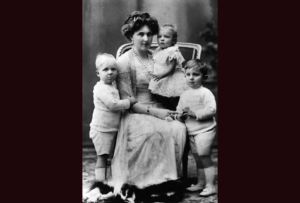
Despite it all, Ena and Alfonso had 7 legitimate royal children…
- Alfonso in 1907
- Jaime in 1908
- Beatriz in 1909
- Fernando in 1910 (who was stillborn)
- Maria Cristina in 1911
- Juan in 1913
- Gonzalo in 1914
(Photo: Victoria Eugenie and Alfonso with their Spanish royal children. Note by this time in the 1920’s, that only 1 of the 7 died, and that not in the first year, but at birth, attesting to improved health conditions at the time. Their ancestors would have lost 2 or 3 AFTER a live birth within the first year from 10 or 11 pregnancies typically).
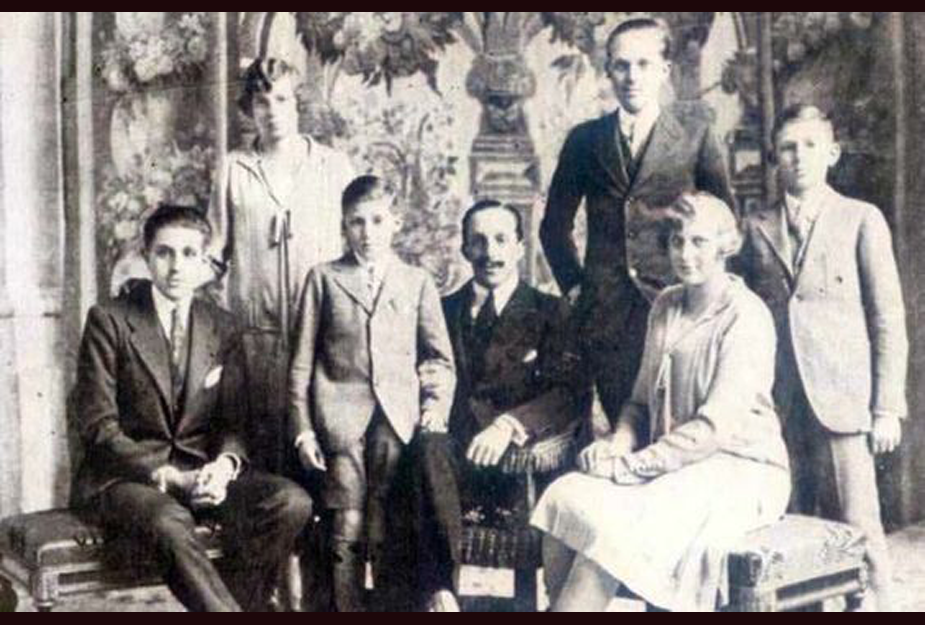
Queen “Ena” of Spain did not like bullfights… .. which made her Spanish subjects very mistrustful of her. Many found her to be “too English”, despite her constant efforts to follow Spanish customs and adapt to the culture. Along with the constant threat of revolution with countercultures, bombing, and threats on her life, Ena had a lot to deal with – from her husband’s infidelities to the populace disliking her.
(Photo: Ena takes a moment to rest from her worries and play tennis in the latest sporting fashion. Note the stripes – considered “casual” and worn at this time for sportswear only along with polka dots).
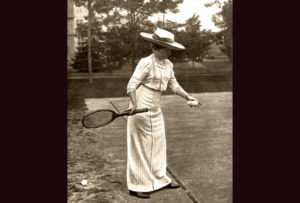
Ena reorganized the Red Cross of Spain… …There was strife and unrest in Spain during the time of Victoria Eugenie’s and Alfonso’s reign. Ena’s records show she complained to her ladies in waiting that Alfonso took “bad political advice”.
Between that and the populace’s general mistrust of her, that she had personal crises. To handle that, she turned to humanitarian work. She gathere
d Spanish currency, called pesetas, healthcare supplies, and clothes for the ill and injured Spanish soldiers who were in Morocco in the war in North Africa.
This effort re organized the Spanish Red Cross, which had been founded in 1864 for worldwide relief. She updated Spanish methods using those she learned from other European countries, such as personal hygiene and use of sanitary and modern medical supplies.
(photo: Ena in her Spanish Red Cross Uniform about 1910)
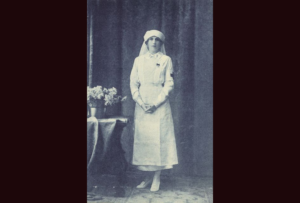
Beatriz Ena’s daughter Beatriz, continued the Red Cross tradition… Thanks to the queen’s efforts, the first Spanish Red Cross hospital was opened in 1918 in Madrid. Both of Victoria Eugenie’s daughters, Beatriz and Maria Cristina, would receive their nursing training there nearly a decade later.
Victoria Eugenie received many awards for this. Some of these awards included the Silver Cross of the Red Cross from Venezuela, the Italian Red Cross Medal, and the Golden Rose of Christianity from Pope Pius XI in 1923.
(Photo: Infanta Beatriz proudly wears the Red Cross uniform of Spain)
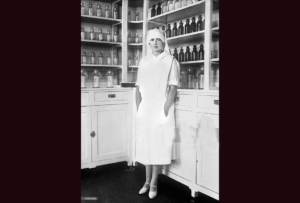
Ena’s 2nd daughter, Maria Cristina also wore the uniform… … of the Red Cross of Spain. She entered service alongside her mother, Victoria Eugenie Queen of Spain, and her older sister, Beatriz.
(photo: Infanta Maria Cristina (same status as an English Princess)
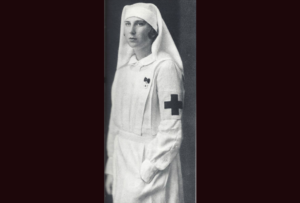
We stop here with this generation, as we have already strayed into the Edwardian Era, and will now define the fashions of the Victorian Era, now that we know the key influencers of fashion.

Many Factors Creating Fashion

There were 3-4 evolutions of Victorian style, with crossovers and modifications, but basically there was “early”, which was like ornamented Regency, “middle” with bustles and crinolines, and “late” with more bustles and the black for mourning and white for weddings dictates.
1830-1855 as shown was “early”.
The Victorian Era was next led by… … surprise! Queen Victoria of England who dominated almost 60 years of fashion worldwide. Her exacting dictates regarding “costume” – every event had a specific fashion – led to white for weddings and black for mourning, which switched the previous rules.
Even to her end, she was fashionable, and demanded it of others. Here she is in the 1880’s with (left to right) 1st born daughter Victoria “Vicky”, last born daughter Beatrice, and granddaughter Irene.
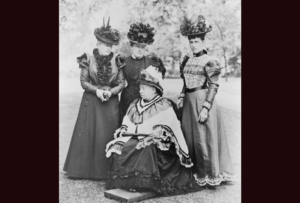
Queen Victoria’s buddy also influenced Victoria fashion… … Empress (later wife of the President when the empire was dissolved) Eugenie of France was another key fashion figure of influence. You can imagine the mix of admiration, curiosity, jealousy, and giggling when Eugenie first showed Victoria the new 8′ crinoline hoops.
(Portrait: Eugenie in about 1862 in just one of her many Charles Worth, Parisian designer hoops and crinoline ensembles – rare in gold, because she usually wore purples and blues)
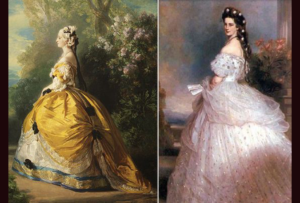
Victoria Eugenie “Ena”, Queen Victorias granddaughter… … the Queen of Spain and goddaughter of Eugenie of France was the next key fashion influence. Her “hey day” was the Edwardian Era, although she was stylish well into the 1920’s.
(Photo: Ena in about 1906 after her marriage)
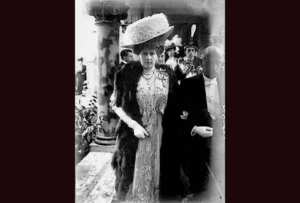
And one more key fashion influencer, Edwardian… … Alexandria of Russia. She was THE favorite in America during the Edwardian era because they were buddies with the US president at the time. She carried “La Belle Epoque” (French Parisian High Fashion) into the “Titanic” eras – along with famous Parisian designers introduced the Princess Line.. the hobble skirt.. and the tango shoes.
After that, World War I entangled all countries, affected all women, and changed fashion forever in a virtual explosion of ideas and innovations. That’s why we stop depictions at 1914.. on the ledge overlooking a complete change forever.
(Alexandria at the height of her power in 1907 and with the height of her princess waistline. Unfortunately, Alexandria and all the Romanov family would be horrifically executed when Stalin and Lenin took over during the Bolshevik Revolution)
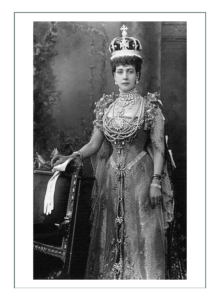
Queen Victoria competed with the influence of French fashion designers. Charles Worth of Paris was actually from England, but made a name and had extreme input to Victoria’s style. He invented the term “costume”, meaning “the right thing for every event”, and he introduced crinolines and hoops.
His costumes for balls and masques introduced new ideas that would be used in the early 1900’s as designer Poiret’s “hobble skirt”.
(Left: Charles Worth gown 1865 with hoops; Right: 1870 ball costume)
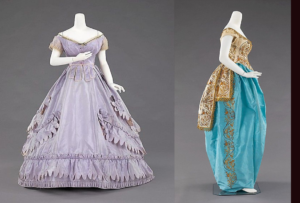
Designer Worth and his son who took over the business.. .. crossed over into the Edwardian era. His Parisian House of Worth was “La Belle Epoque”, and embraced the corsets and lines of the Edwardians as well as Edward himself. Edward’s wife and most royals of the world wore Worths.
(Left: Charles Worth gown 1882 Victorian; Right: 1901 Edwardian)
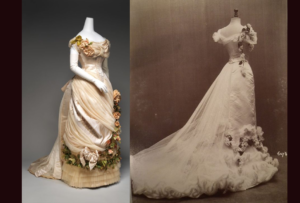
Notice after Victoria, they aren’t Key WEARERS, but Key DESIGNERS… … the world had changed, communications had changed, political boundaries had changed, and so loyalties had changed. In America in particular, there was an explosion of ideas and technology and so fashion. Countries worldwide were influenced by – countries worldwide – and not people of fashion specifically.
Notable designers like Poiret and the Callot Soeurs of Paris set the stages (literally, as in theatre) during the Edwardian era and beyond. Hundreds of designers would follow.. Coco Chanel.. Paquin… Gioseffi..
(Left: Paquin gown; Right: Poiret hobble skirt sketch)
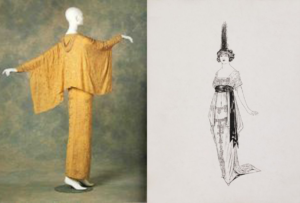
We saw influential old friends brought back by Edwardian designers… … Charles Worth, top designer through Victorian and Edwardian eras (late 1800’s and early 1900), claims to have invented the large paniers and short shepherdess look.
We know better, as proven by the 1776 real garments on the left, and the 1850’s Worth sketch on the right.
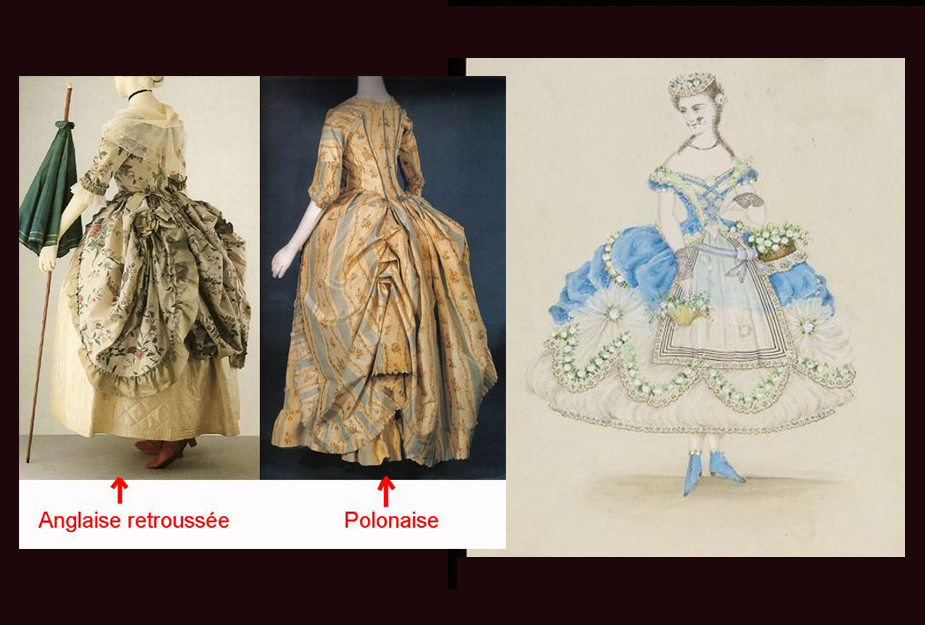
Queen Victoria of England reigned… …over England for 64 years. Crowned at age 18, she also ruled over fashion from 1837 until her son Edward’s flippant styles crossed over hers into the Edwardian Fashion Era around 1900. 1837 to (about) 1891 are called the “Victorian Years” in fashion. This applied to clothing, furniture, and anything that was crafted or created by an artisan.
(Portrait: Victoria Duchess of Kent as a preteen with her spaniel, Dash)
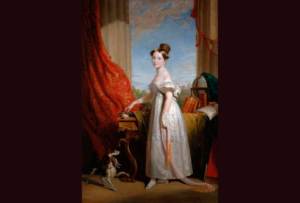
When Victoria became Queen of England in 1837, she was 18 years old. In 1837, it was still the Regency Era – defining fashion and attitudes – coming off the former King Georges and influences of the French under Napoleon Bonaparte.
Regency’s “little white dress” had evolved into elaborate Rococco ornamented styles, lower waistlines, and stiff, “tinkle bell” shaped skirts that would become the signature shape in the ’40’s and ’50’s worldwide.
(Portrait: Queen Victoria in 1843, 6 years into her reign and 24 years old. You can see the Regency shape morphing into something new.)
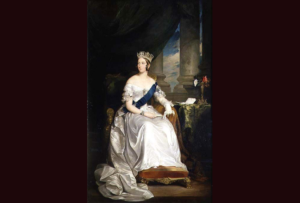
When Queen Victoria of England married Albert of Saxe-Coburg… .. in about 1840 , “Victorian” dictates took definite shape. It was defined by Victoria’s “prudish” attitude and strict rules for moral behavior that lasted until about 1890 when Prince Edward the Prince of Wales and his high spirited “Edwardians” took over societal conduct even though she was still ruling.
(Photo: Queen Victoria with son and future King Edward in 1897 near the end of her rule)(Below: Albert, Consort (husband) to the Queen)
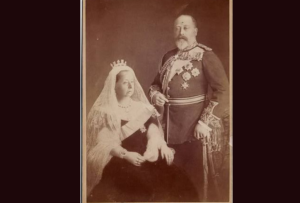
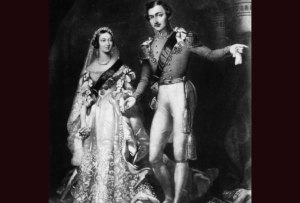
England’s world status defined world fashion… .. Remember the 6 Key Concepts from last month that affect fashion? Technological developments, industry, and so economic status directly affected what women wore at any given time. In England, a big part of that was class status as it changed.
In America of the 1840’s, because women were still looking out of the corner of their eyes at the English and French.
(Photo: A prosperous and industrial Baltimore, Maryland in America 1840 when the cookie company moved in)
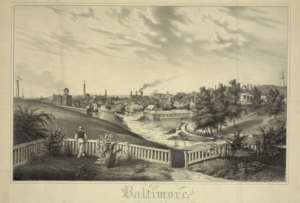
Victorian prosperity meant… ….Country became Urban. English elite prospered in the reign of Victoria due to development of new machinery, improved work methods, and an underpaid workforce that consisted of adults and children who lived in poverty.
(Photo: 1840 working class on a typical London business district street)
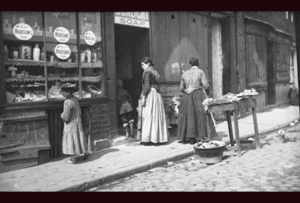
The train in Victoria’s early reign took British to the cities… Many people previously rural became urbanized because they could take the train to town. Country families moved into crowded conditions in towns and cities to stay with relatives while they looked for work. Due to the huge population boom, many lived in poverty without water, sanitation, and sometimes food.
(Photo: poor women of 1850’s London receive baskets of food from the Queen)
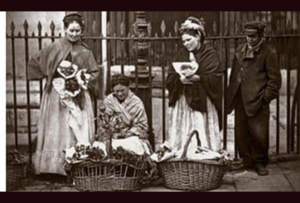
As a result of British society changing, Class structure… …dictated the rules of fashion. Each activity had appropriate apparel for those who could afford it. Those who couldn’t emulated the wealthy with simpler, less structured, and less costly versions of the elite. There was a HUGE industry of clothing resale with peddler carts in special districts for clothing for the working and lower classes.
(photo: London’s tunnels like this under Fleet Street in 1840 were built in the early Victorian era)
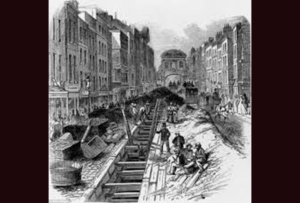
Places like Almack’s and White’s in London… … were highly valued organizations that nobles and elites of London aimed to access. Exclusive “clubs” by invitation only, the London “Seasons” were designed to meet and greet those of similar class status. For men at least, places like White’s were for socializing with entertainment and leisure away from the women. Fashion of the elite was very specifically defined.
(Featured: Almack’s for balls; below White’s for men to gamble, drink, and be ‘manly’)
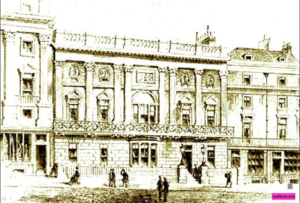
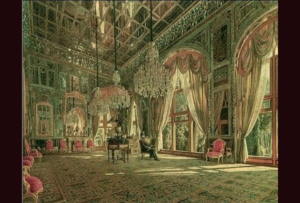
Queen Victoria of England hosted events… .. like balls – small and large scale for entertainment for royals and elites. Her dictates on clothing were EXACT.
(Sketch: The Devonshire Ballroom in London in 1840 – from the local newspaper introducing its debut)
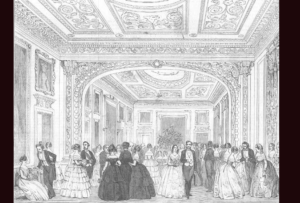
Britain’s population became urbanized… .. and by 1850, under Queen Victoria, half the country had moved to the cities. Industrial growth and the resulting building boom, and the spread of the railroad combined with a population boom had the character of Britain suddenly changing.
Small towns were overtaken by giant industries. Towns like Crewe which were already on the railroads became “hubs”. “Hubs” met each other to become large joined towns.
By 1870, Britain had grown from 10 million people to 26 million.
Factors of population growth, change in occupation, change in location meant change in culture and economy which would mean – change in fashion.
(Photo: St. James Park, London before industrialization)
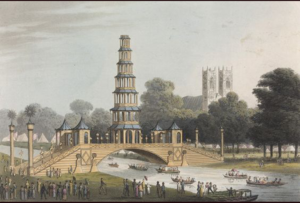
New Social Classes emerged in Victoria’s Britain… Improved transportation and the ability to get around meant the English could seek jobs that were not available to them before. While many lived in poverty, others rose in status as the previously defined class structure changed.
Employers moved away from their industrial source of wealth. They bought country estates and were often considered landed gentry. Men without noble ties, previously considered lowly, now rose in status on the basis of their wealth. Some built new streets of houses at the edge of town for their skilled workmen and artisans to live in.
Their key employees and managers built villas outside of town too.
(Painting: Apsley house, the home of the Duke of Wellington as it looked in 1816. Villas and homes like this were no longer reserved for titled gentlemen like the Duke by the 1850’s in Britain)
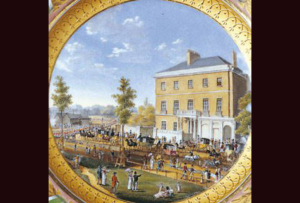
British class divisions were still apparent… ..in places like church where the higher classes sat in reserved pews, and on trains where they had luxurious cars. Lower classes remained lower classes, but the rising bourgeoisie middle class had an outward display of wealth through clothing and possessions that allowed them to mix in with the high society that was formerly reserved for blooded and titled nobles only.
British wives of industrialists and business owners, dressed in finery “fit for a queen” as they were their husband’s business marketing representatives. It became difficult to distinguish these women from nobility based on how they dressed or behaved.
(Painting: by Ritchie, 1858 “A Summer’s Day in Hyde Park” shows the mixing of classes in Britain)
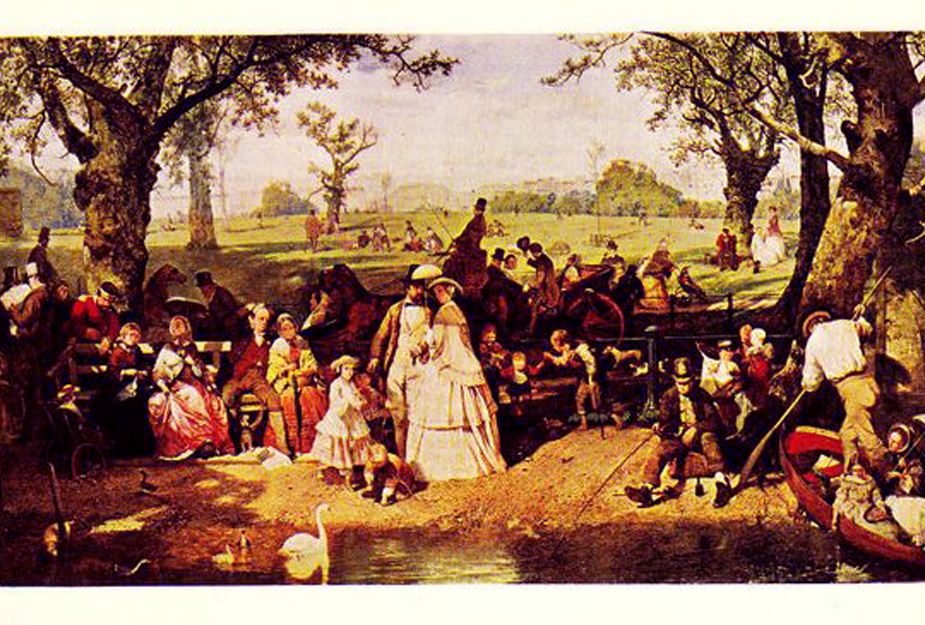
Victorian fashion had everyone dressing like a queen… .. under Victoria, Britain grew, expanded – literally boomed in every way. She was a champion of British technology, arts, sciences, and fashion. In every situation she required, or at the very least, suggested, British goods be used in manufacture of textiles and clothing. The new wealth of the rising middle class of merchants and tradesmen allowed everyone to dress like a queen.
(Portrait: 1840’s “Derby Day” painting by Firth shows the classes mixing at the horse races)
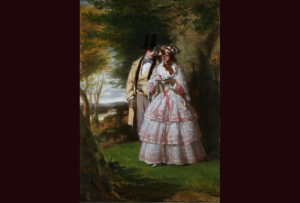
The wedding of Victoria and Albert set fashion trends… Breaking all the previous “rules” of fashion, Victoria insisted on wearing white to her wedding, establishing the “rule” for that activity.. forever. Her dictates from this point on, told all Britains (and so all other countries who were following their lead) what was appropriate to wear on what occasion.
Note: this is just before photography became available. Her early reign is documented in portraits and sketches. Her late reign and her children would be well documented, especially since her daughter Beatrice would become a photographer and have her own dark room.
(In 1840, Queen Victoria was married to Prince Albert)
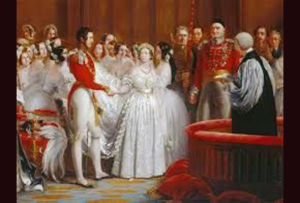
Queen Victoria ordered guests to wear… .. specific items such as British made lace, or Scottish plaids. She held balls and activities that specifically order the participants to dress a certain way.
(Photo: Victoria’s actual Tartan (plaid) gown worn in 1845)
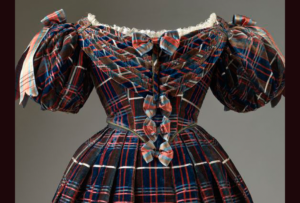
What people wear depends on… … what’s available, accessible, and affordable given the information at hand. As we study the Victorian era and fashion, it is important to understand the many levels and the complexity of the time in many countries. Victoria did set fashion trends, but they were interpreted differently by different women in differing situations.
(Photos of 1889 women at leisure: left – merchant class English woman in walking suit; right – Queen Victoria in a very different and royal kind of mourning/walking suit)
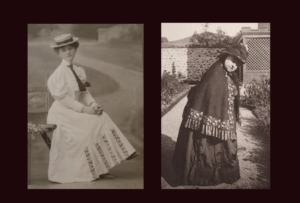
To understand Victorian fashion, you need to understand… …Victorian women. While the houses, streets, and many of the gadgets we use today were just earlier versions of what we have today (pianos, carpet sweepers, sewing machines), the main difference was the place of women in society.
A woman’s place was in the home.
There were of course, independent women with original thoughts, and the expression of that varied with region and country. The Victoria Era spanned 64 years, so it would be wrong to lump everyone as having one same lifestyle. As the era closed, attitudes would shift drastically towards reform in laws pertaining to women, but in general throughout the time, society made life much easier for women if they accepted that a woman’s place was in the home.
Queen Victoria herself changed through the years.
(Photo: Newlyweds Victoria and Albert in 1841)
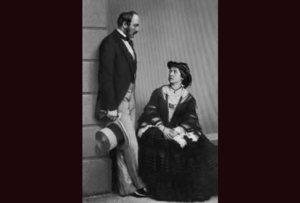
Women “stayed by the hearth.. whilst men…” … wielded their swords.” (Tennyson). The prevailing attitude of men towards women in the Victorian Era was that all women were weak and helpless fragile and delicate flowers incapable of making decisions beyond selecting the menu and children were taught moral values.
A gentlewoman ensured that the home was a place of comfort for her husband and family from the stresses of Industrial Britain.
“(A wife’s) prime use is to bear a large family and maintain a smooth family atmosphere where a man need not bother himself about domestic matters so he can get on with the making of money.” (“Beeton’s Book of Household Management“)
(Photo: in the 1840’s, young women were taught to let the man win in a game of chess)
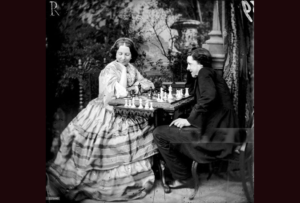
The objective of the “proper” Victorian woman was… …marriage. Girls were groomed like racehorses in preparation for that, making sure she could sing, play an instrument, speak foreign languages, and above all be innocent, virtuous, biddable, dutiful, and ignorant of all intellectual opinion.
(Colorized photo: Dating in 1860’s upper Manhatten, USA)
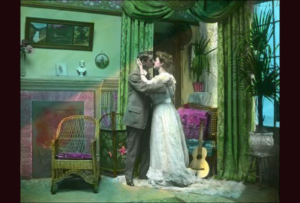
Victorian wives were required to be faithful… .. even though husbands kept mistresses, and were free to mingle in their “gentlemen’s clubs” where they could find a warm welcome among male friends, and often comfort in a woman’s.
If a women took a lover it was never to be made public because if it did become public knowledge she would be cut by society. If she divorced, she would have zero chance of acceptance in society again, although men easily moved on to the next relationship.
As a result, it was a time where relationships were quite artificial, for upper and merchant classes at least.
Until 1887 a woman could not own property, and even that which she inherited from family was turned over to her husband the day of their marriage. She herself was “owned” by her husband. In 1887 the Married Woman’s Property Act gave English women rights to her own property.
(Painting: Flirting in a Parisienne Salon in the 1880’s)
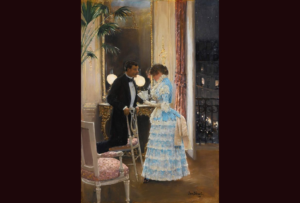
Life for wealthy vs poor Victorian women of Britain… … was very different. An affluent wife was supposed to spend her time reading, sewing, receiving guests, going visiting, letter writing, seeing to the servants, and dressing the part of her husband’s social representative.
Her clothing was made specifically to show off wealth, and that became more and more lavish as the 1800’s progressed until rich women’s outfits literally “dripped” with lace, beads, ribbons, and bows. She had up to 6 wardrobe changes a day which changed over 3 seasons a year.
In contrast the very poor wife of Britain wore clothing handed down and remade, typically “5th hand”. They ate food leftovers from rich households, and what they bought was often inferior stringy meat, old bread, cheese, herring, porridge, or kippers.
(Photo: 1880’s Bryant May mill workers; working lower class women of London)
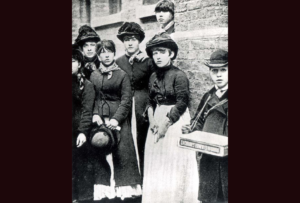
For wealthy, noble, and elite Victorian women.. … Victorian fashion required different ensembles for different occasions. Designer Charles Worth, an Englishman-turned-Parisian-designer, introduced the word “costume” at this time, and Victoria expanded upon the concept for her country.
“Costume” meant there was morning and mourning dress, walking dress, town dress, visiting dress, receiving visitors dress, traveling dress, shooting dress, golf dress, seaside dress, races dress, concert dress, opera dress, dinner and ball dress.
Fashion plates were hugely successful in this era giving ladies supposed to women visual clues on how to dress for their new found status. New activities were invented just to show off status through “costume”, such as parading around city parks in carriages.
(Sketch: a typical 1868 Victorian fashion plate which shows women how to dress in Costume)
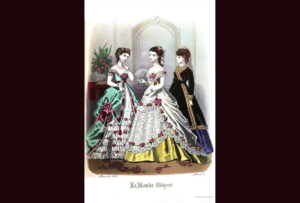
Change in Victoria’s Britain was happening… …everywhere and at all social and class levels. New inventions and how to use them opened doors for poor women to improve their situations through work. Acceptance of women as thinking beings as the era progressed closed the gap to give women common causes to rally around. The place men and women were equal was in the use of new “gadgets’, because no one could figure them out. The dynamics of men and women, and poor and wealthy, changed as the Victorian Era progresses.
By 1900 the railway, typewriter, telephones, post, camera, sewing machine, synthetic fabric fibers, and the bicycle became used in every day life. Women became secretaries, operators, and opened their own shops.
The Tailor Made Garment movement had women designing, making, and selling garments, as well as wearing them to work outside the home. The industry gave them credibility and confidence outside being just an asset to a husband.
(Photo: Mary’s Haberdashery in London started in the 1880’s and was still in business well into the 1980’s)
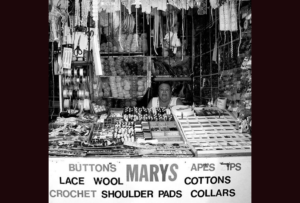
Reform for women happened through the Victorian Era… … as Victorians began to recognize women as thinking people. As the year 1900 approached, women intellectuals began to speak openly. Many joined the Fabian Society, a group of socialists. Others sought reform for more practical dress (e.g. no corsets), better education, the right to keep their profits from paid work for themselves, better employment prospects, and better pay for women.
Most notoriously, women began the campaign in Britain that would lead thinking women around the world to have the right to vote and for birth control. The Victorian Era would be known for beginning the women’s rights movement worldwide.
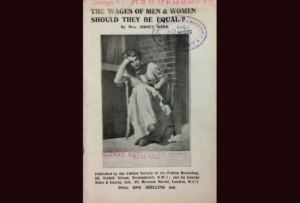
Historians break Victorian fashion into eras… … and there were many as Queen Victoria reigned from 1837 to 1901. In the beginning, most fashions lasted about a decade, but by the mid 1850’s, mass communication and mass production had improved so much that by 1901 the history of fashion was moving in almost a yearly cycle.
Silhouettes breaks down the eras into six using key features like bustles, crinolines, and sleeves into “early,””mid”,”late”, and “pre-Edwardian.
There were actually many, many more subcategories and countermovements such as aesthetic and reform dress in those years (as per sketch featured).
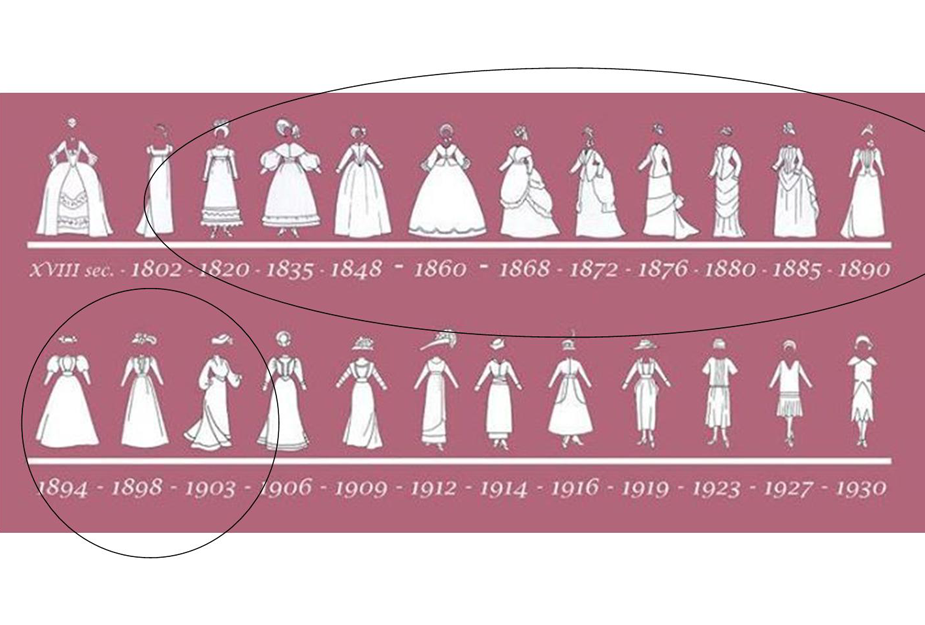 The 1st Victorian Fashion Era was… …considered by historians to be Queen Victoria of England’s early reign, 1837-1860. In this time she was a teen, was crowned, was married, and had all of her children.
The 1st Victorian Fashion Era was… …considered by historians to be Queen Victoria of England’s early reign, 1837-1860. In this time she was a teen, was crowned, was married, and had all of her children.
Victorians in the United States
Why would Americans care what an English Queen thinks?
In 1837 when Victoria was crowned Queen of England, American independence from England was only 54 years old. Most people in America had a family member or some connection to the War and England in some way. In that same time, England had gone through 3 King Georges and the (English) “Regency” period, Napoleon had risen and fallen, and the Bourbon lineage was back on the French throne.
Trade was abundant between a thriving United States that could provide raw goods to those war torn countries of Europe who continued to fight amongst themselves (the French and English notably). Americans were reaping the benefits of inexpensive finished goods from Europe and European worldwide colonies, and now that the Asias had opened up to trade, American women had a lot of choices whom to follow and how.
Most chose England.
(Portraits: 3 key fashion influencers 1783 (official end of Revolutionary War) to 1837 (start of Victorian era): left to right – Marie Antionette married to Louis XVI a Bourbon, Josephine Napoleon’s 2nd wife, and Victoria in about the 1860’s the prime of her career).
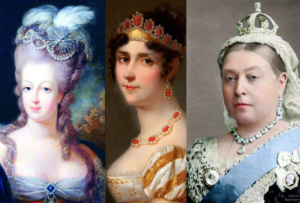
By the end of the Victorian Era, England would.. … become so enamored with the American spirit, the casual and less structured lifestyle of Americans, and particularly the romantic American West, that the English and Europeans would start to “peek” at American women to set the fashion trends.
Stories of Daniel Boone at the turn of the 18th into 19th centuries had awakened the curiosity of the English in particular, and in about 1900, with Buffalo Bill Cody’s Wild West show coming to England to show first hand what those legends were talking about, the influence would switch.
In 1837, however, it was Victoria who was running the worldwide fashion show.
(Poster: Annie Oakley was always in the height of fashion (in her Victorian corset); here photographed for marketing advertising Buffalo Bill’s Wild West show which would perform in England around 1885 that year)
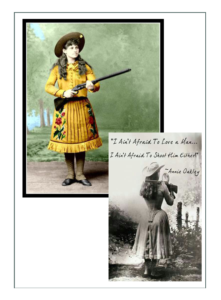
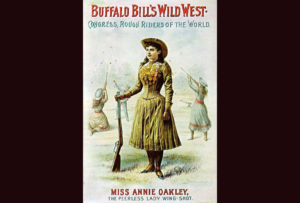
Victorian England had class disparity… … as we discussed in detail earlier this summer. There were those of rich and noble blood, and then there were poor. BUT, as was happening in America, there was a rising middle class made of merchants, industrialists, and financiers.
They walked among the previously “taboo” royal or noble elite – men we are talking about of course in 1837. The women associated with this middle class were mostly the social advocates for their men.
Fashion for a middle class Victorian woman was a status symbol, and much discussion in all worlds was about “pecuniary emulation” (translated – “showing off your stuff”).
(Photo: Afternoon Tea in New South Wales 1890. Settlers moved to towns created by industrialists and developed a whole new middle class structure while hob nobbing alongside blue-blooded nobility)
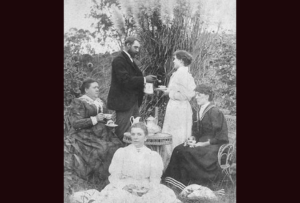
Victorians had gender disparity too… Although women over the 1837-1901 period made HUGE gains, each country was slow in progress towards women’s right to vote, elimination of slavery, marriage and ownership laws, and equality in the work place.
Under Queen Victoria, England was the first among Europeans (Scandanavians), and Americans to abolish slavery, give the right to vote, and give women the right to own property. The Scandanavians (Holland in particular) were the first to have women in higher education and to have the first medical professionals and scientists.
American women and blacks would not get the right to vote until well after the era, and while they could work, play sports, and run businesses, they were still assigned specific societal roles with limitations throughout the era.
(Photo: a Russian man and his wife illustrate gender disparity in 1900)
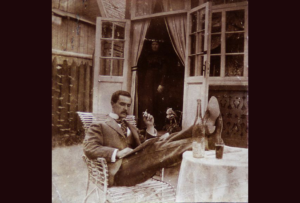
Not Everyone in Europe Followed the Queen
In the industrial and technical world of this time frame, movements like the Rational Dress Reform Society and the Aesthetic Dress Movement arose in reaction to what was going on economically and socially.
(Photo: Bloomers were introduced to society in 1855 by the Reform Movement, but were only worn by women in insane asylums)
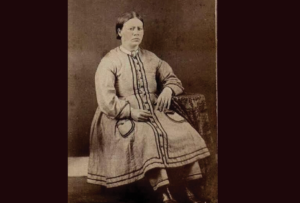
The Rational Dress Movement
The Rational Dress Movement during the Victorian era also introduced… … soft and comfortable corsets, approved by physicians. The concept of wearing something other than highly “trussed”, constricted style that had been in vogue since the invention of metal grommets in 1822, was indeed challenged by many throughout history, yet few women embraced the idea.
The position of a woman in society in the Victorian Era was reflected by dress. Anything less than the prevailing silhouette was considered vulgar and demeaning by most women.
(Photos: Left – 1890 Gibson Girl the ideal of that day was very constricted and shaped vs Right – the wife of Reform Movement leader in her Reform (corsetless) gown in 1903)
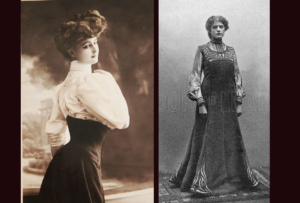
Aesthetics & Pre-Raphaelites
The Aesthetic Fashion Movement came out of… .. the Reform Movement. Aesthetes saw fashion as ugly machine made products from the Industrial Revolution. Their dislike ranged from distaste for the ugliness of false structures and veneers to the crudeness of synthetic dyes to the over working of Victorian imagery.
They ignored the benefits of cheap costs for mass produced goods for those of low income or those who wanted to imitate upper classes on a lower budget.
(Portrait: Mrs. Frances Leyland in Aesthetic dress about 1874)
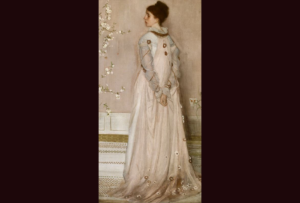
Aesthetes hated sewing machines… … because it allowed excessive embellishment of dresses because trims were so cheap with mass production and because trimming could easily be added at home or in the shop.
(Photo: a family of Aesthetes in full Aesthetic fashion in about 1900)
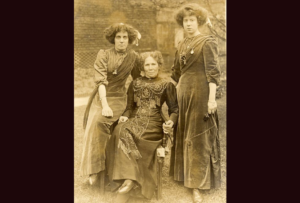
Aesthetes were dangerous to vegetables… The Aesthetic (“counter fashion”) movement within and counter to the Victorian fashion era went beyond textiles and fashion. Aesthetes were also often vegetarians and campaigned for animal welfare rights.
They objected to the use of feathers on hats and the use of whole dead birds as a hat ornament. Modern vegetarianism has its roots in this movement.
(Photos: 1897 Aesthetic tea gowns. They loved this carrot orange color!)
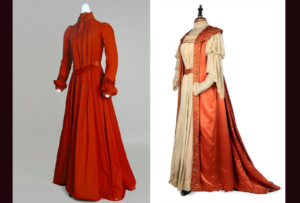
The Aesthetic movement was technically 1870-1880… … in the mid-Victorian Era, although it got its start in reform and the early eras and in response to industrialization and mass production. They were a group of talented artists, poets, writers, and actors.
The leader was painter William Morris. He and architect Voysey designed houses together being fastidious about every detail from wallpaper to furniture, to window and fireplace proportions. Morris designed textiles and embroideries which he produced through his company Morris and Co.
Many of his original flowing organic designs are still used today, although the colors are adjusted to suit modern tastes.
(Fashion Plate: late 1880’s-90’s Aesthetic gown like Morris’)
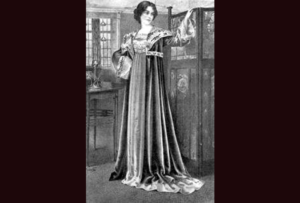
Paintings were the inspiration for Aesthetes… …as they were influenced by the Pre-Raphaelite paintings of Dante Gabriel Rossetti and Edward Burne Jones who idealized medieval life in imaginary ethereal scenes. The women in these paintings appear to wear no corsetry and have freedom and “naturalness” that was admired by the Aesthetes.
(Featured: painting by Pre-Raphaelite leader J.W. Waterhouse “Hylas and Nymph”)
(Below: painting inspiration by Aesthetic for gown)
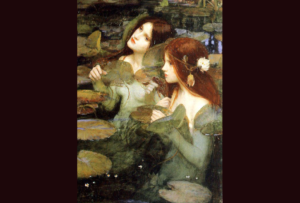
Pre-Raphaelites who inspired Aesthetes were artists… .. in the 19th century who despised the “schooled” method of art that was prevalent in the day which required certain lighting, levels or realism, and specific rules. Pre-Raphaelite art was often erotic, sensual, and depicted women scantily clad in dreamlike settings with mythological themes.
The Aesthetic counter-Victorian fashion movement embraced the Pre-Raphaelite concepts of wanting to show the beautiful, natural, and organic forms of the body, plants, animals, and the world around them.
(Painting: “Circe Poisoning the Sea” by JW Waterhouse, Pre-Raphaelite movement leader. Mythological themes, beautiful sensuous women, idyllic settings, and many plants and organic forms are the hallmarks of Pre-Raphaelite art)
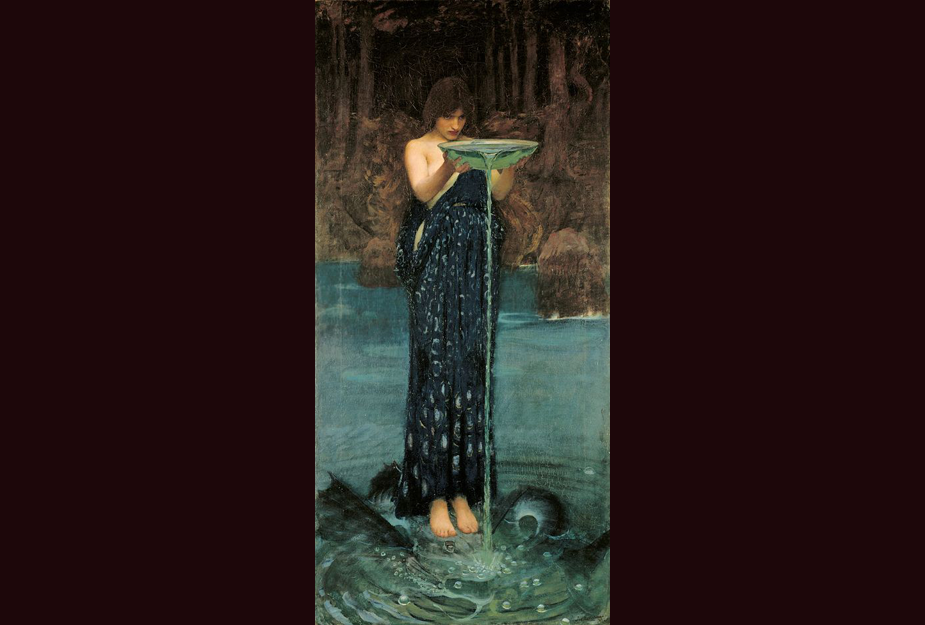
Pre-Raphaelites, Aesthetes, & Reformers… .. the counter design movements to the Victorian eras – the Pre-Raphaelites preceding and inspiring the Aesthetes, and the Reformers building on those concepts – took place worldwide, and predominantly in Europe.
As would be the Art Nouveau fashion movement in 1900, forms and styles were regional, meaning Prussia might have different interpretations than England or France of the same Aesthetic concept. Germany had a very strong Aesthetic influence.
(Photo: German Aesthetic tea gown of 1900)
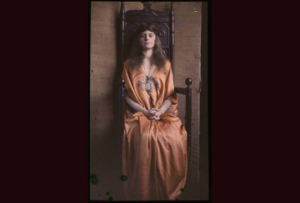
Aesthetics did not limit themselves to fashion… … or fabrics. TheAesthetic movement within the Victorian fashion era were big in the development of interior design elements and architecture.
(Photo: The Green Room in the Albert and Victoria Museum in London, was designed by William Morris, a leader of the Pre-Raphaelite movement, and inspiration for Aesthetes)
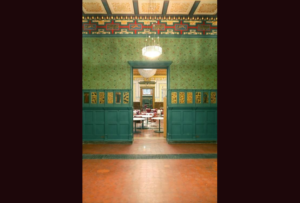
Wallpaper, stained glass, and other highly crafted… … interior and exterior designs as well as beautiful fabrics were the Aesthetic Movement’s contribution to Victorian society.
(Photo: an Aesthetic wallpaper and stained glass interior from about 1900)
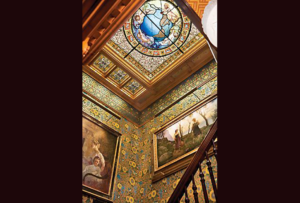
Counter Victorian fashion movement Aesthetes felt women needed to look more like… … the nymphs and sensual creatures of art. To blend and suit these surroundings it was felt that some reform in style of dress was needed. Among artistic people the resulting fashion was known as Aesthetic dress.
(Photo featured : 1900 approx. Aesthetic Tea Gown has the Victorian model looking like J.W. Waterhouse’s Pre-Raphaelite paintings below)
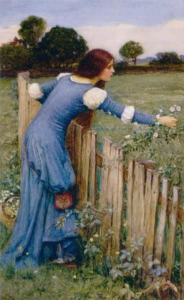
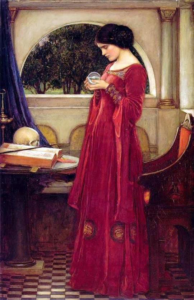
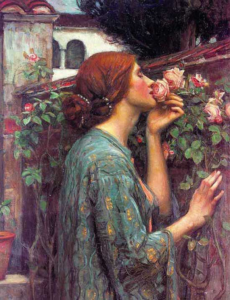
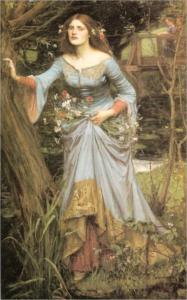
Pre-Raphaelite Waterhouse vs Aesthetic… .. paintings vs. how the Victorian counter-fashion movement the “Aesthetes” interpreted them. The Aesthetes, like the Pre-Raphaelite painter J.W. Waterhouse, looked for sensuous beauty, organic forms, flowing movement, mythological and ancient themes, and rich colors and textures with amazing fabrics and highly crafted trims and details.
The Aesthetic gowns of the Victorian era were deceptively complex in their draping and ornament so as to be beautiful and comfortable.
(Left: Aesthetic day dress vs. JW Waterhouse painting right)
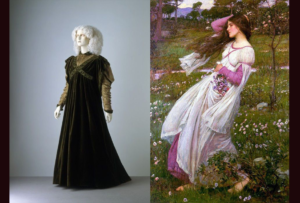
More Victorian Era Aesthetic Gowns vs. Pre-Raphaelite.. .. paintings. Both gorgeous depictions of rich fabric and ornament, flowing movement, and lovely colors. The Aesthetics wanted the women who wore these to be comfortable, sensuous, and to have the adventures of the J.W. Waterhouse depictions.
(Left: 1909 Aesthetic gown; Right: J.W. Waterhouse “The Knighting”)
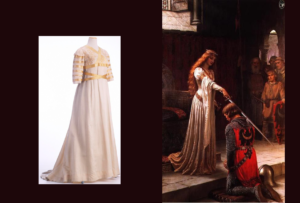
Yet another idealized painting vs real Aesthete dress.. .. does capture the spirit, attention to detail with intricate trim, and flowing fabrics and colors of the Pre-Raphaelites. The Aesthetic concept of draping and fabric is still used today in bridal, formal wear, and costuming such as CosPlay.
(Featured left: 1900’s Aesthetic velvet gown vs. J.W. Waterhouse Pre-Raphaelite painting “The Crystal Ball”)
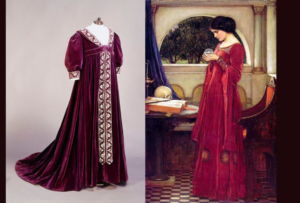
One more Aesthetic vs Waterhouse painting… .. this being part of Pre-Raphaelite J.W. Waterhouse’s “Ophelia” series, and a favorite inspiration for the Victorian era Aesthetic gown designers.
(Photo left: 1909 tea gown; Right: “Ophelia”)
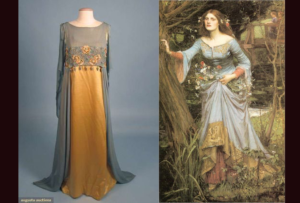
The “counter” Victorian fashion movement, Aesthetics. These were artisans, craftsmen, and designers committed to maintaining the highest quality of fabric, texture, line, and design in response to what they felt was “crass” mass production.
Getting their concepts from the “Pre-Raphaelites” who were a “rebellious” artistic movement (“Pre-Raphaelites” were protesting the formula type of art where light, composition, subject, and content were dictated by strict rules – thus wanting to go back in time before the “Raphaelites” who made all the rules came into power in the art world), the Aesthetics used the “Pre-Raphaelite concepts of eroticism, mysticism, mythological themes combined with artistic draping and fabulous colors, organic forms, fabrics, and notions to build what looked very much like the Pre-Raphaelite paintings. Their influence would blend and merge with “Art Nouveau” .
A key Aesthetic rule was that there were to be NO CORSETS, and NO UNDERSTRUCTURES. They felt the forms and messages would convey enough. A few women embraced their designs, but most of the Aesthetic models and real life customers were considered quite radical for the time.
(Photos: left – Violet Lindsay; right – Jane Morris (wife of the founder) – both about 1894 in Aesthetic Dress. They were the key champions for the cause, and don’t they look happy)
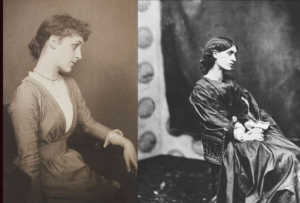
Aesthetic fashion imagery extended to the home.. .. in stained glass, wallpaper, carpeting, and design. Differing from the “busy” Victorian household, the Aesthetes aimed for balance and comfort, and although not knowing the concept yet, a type of “feng shui” in the flow and dynamics of house, home, and costume.
(Photo: an Aesthetic stained glass from the early 1900’s. Note the same imagery as the Waterhouse paintings is used, and how familiar the organic imagery is to the Art Nouveau which was being developed at the same time)
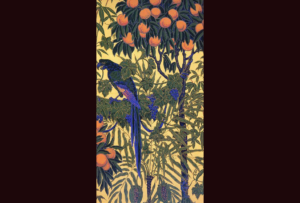
Aesthetic customers were not “poor” or “radical”… .. many wealthy women, and particularly English and American women, could afford to be what was considered “on the fringe” of fashion by wearing Aesthetic clothing. The obvious difference between Aesthetic gowns and high fashion of the day was a distinct lack of corset. Second notorious feature were flowing and mythical draping; 3rd the gorgeous fabrics and textures.
As with all Victorian culture, the wife of a rising merchantman was his marketing agent. She had to dress to impress.
(Photos: Rosamund Hussey, wealthy woman from Kent, proudly marketed for the Aesthetes to try to get her peers to embrace the fashion movement)
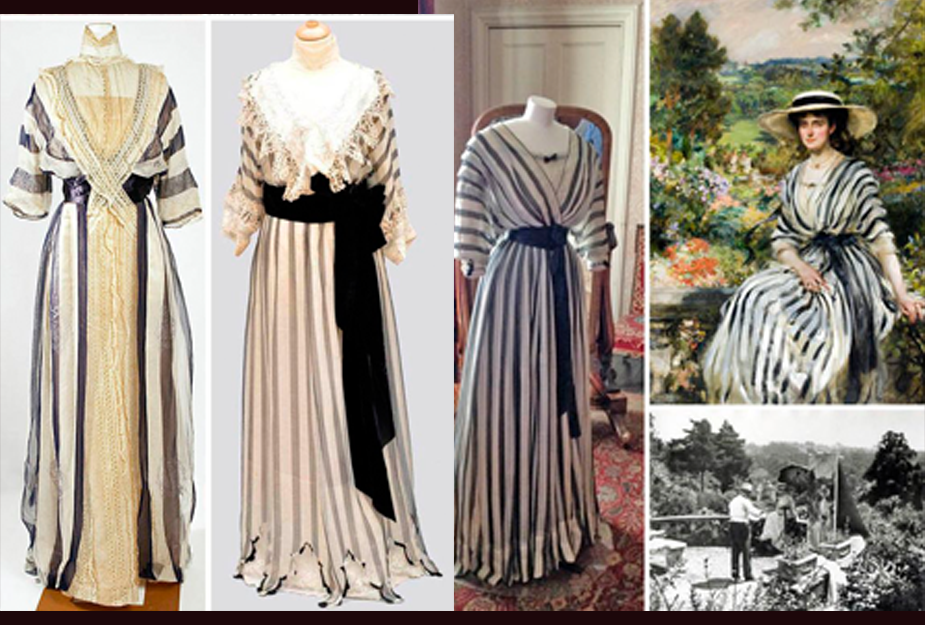
The sensuous image the Aesthetes were trying to present.. .. sometimes fell a little short of the ideal that was presented by Pre-Raphaelite paintings. The result of “natural and beautiful forms” sometimes resulted in frizzy hair, poor draping, or strange accessorizing. You have to give them credit for trying as they believed every woman was beautiful and sensuous if stripped away all the artifices of fashion. Unfortunately, not every woman could look like a Waterhouse painting in her “natural” form.
(Left: Waterhouse portrait of the ideal woman vs. a real 1900 Aesthete trying to look sensuous on a humid day with naturally curly hair)
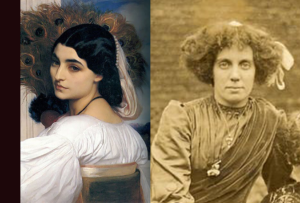
Aesthetic fashion is here today… .. you can find the concepts of mythological figures, lack of corsetry, emphasis on the “natural” shape of the female body, flowing and organic forms, colors of nature, and attention to detail, draping, and ease in movement in today’s bridal wear.
The main difference is that today synthetic fabrics and notions are prevalent to keep the cost down and to enable mass production, as often the gowns are worn for a single event. The problem is, the modern wearer will have no concept of the comfort of the 1900 natural and breathable fabrics as they sweat down the aisle in their polyester replications.
(Photos: left: “We are Stardust” at a bridal and formal wear fashion show; right: bridesmaids dresses for sale on Etsy)
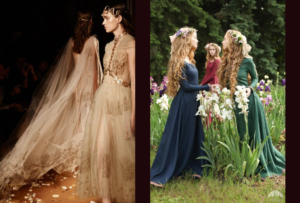
Gorgeous Aesthetic gowns took gorgeous fabrics… … and Liberty of London’s was THE place to buy. Not only did they create original, high quality, natural fabrics with dyes and prints specific to the Aesthetic cause, but they provided key fashion designers. It was Liberty’s that brought the Aesthetic dream of fashion to life.
(Left: Pre-Raphaelite inspiration “Lady of Shalot” and right: “Mariana in the South” embrace a Liberty of London silk Aesthetic tea gown from about 1900)
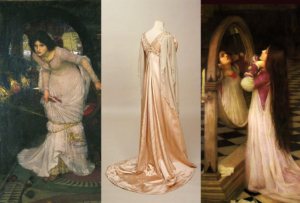
Victorian era Liberty of London fabrics… … sold to high fashion as well as Aesthetics. They catered to those wanting fine quality textiles and trims like these tea gowns are made of. The carrot orange is seen often in early 20th century gowns. Today Liberty adjusts colors and designs to suit modern tastes.
(Photo: Liberty gowns vs. JW Waterhouse Pre-Raphaelite painting)
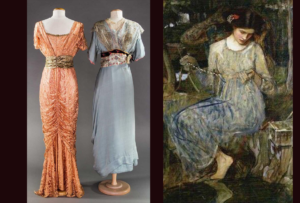
Today’s Liberty of London… … sells cosmetics, home furnishings, textiles, custom design, household objects, and other toiletries in addition to providing fashion design and oodles and oodles of fabrics. The current price of a “Tana Lawn”, which is considered “traditional printed cotton” for them, is about 23 British pounds, or about $40 US after shipping from the store in Carnaby, London.
(Photo: The Liberty of London store front 2018)
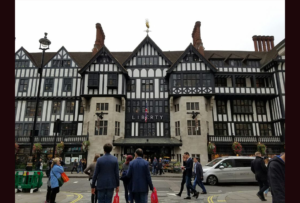
Liberty of London fashion design today.. .. still has a lot of the Victorian Era “Aesthetics”… comfortable, rich, luxurious.. and there are certainly no corsets! Today’s imagery, however, is specifically designed to appeal to modern buyers.
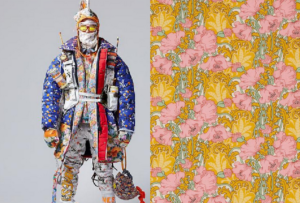
Liberty of London still makes beautiful.. .. fabrics and apparel; suited to modern tastes.
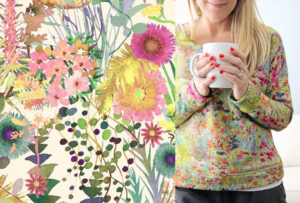
Leaders of the Aesthetic movement were largely.. … the wives and daughters of male Aesthetic artists and designers.
(Photos: left Violet Lindsay; right Jane Morris in about 1894 were leaders in the Aesthetic design movement, and German models)

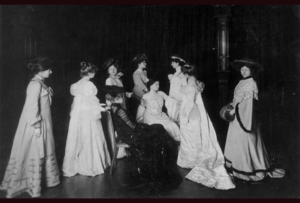
Aesthetics marketed to the public… .. using photographs and settings as picturesque as the images they were trying to create with the garments.
(Photo: Aesthetic leader Jane Reece in 1907 in this self portrait called herself the “Poinsetta Lady”)
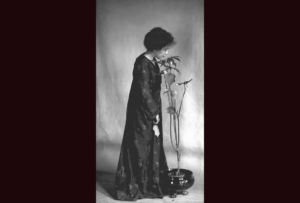
The Aesthetes had lovely portraits made by other Aesthetes, and made self portraits like this 1890’s wool dress which have become famous today as it is presently displayed in a London museum.
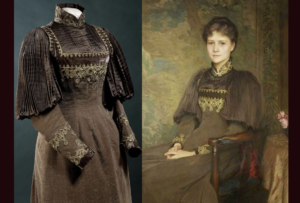
A few more Aesthetic leaders, marketers, and… … models: featured 1895 Catherine Hueffer, and below, 1890 Louise Jopling
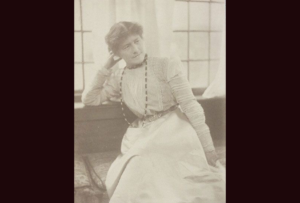
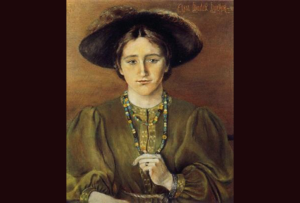
Museums have beautiful examples of.. .. Aesthetic gowns. They were so well made, and of the highest quality fabrics, that they have lasted through time (and washings).
Featured and below are Aesthetic Tea Gowns from the early 1900’s made from Liberty of London fabrics. (orange and maroon again???)
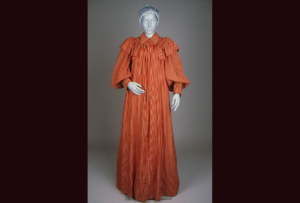
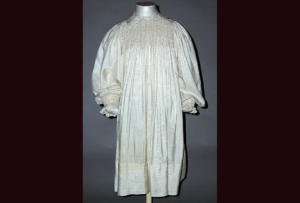
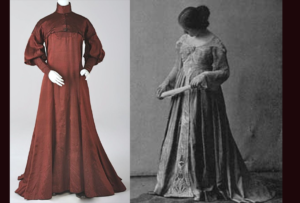
More samples of historical Liberty Aesthetic.. … gowns from the Victorian into the Edwardian eras. The Aesthetics blended into Reform and Art Nouveau movements, and the French Belle Epoque designers of the Edwardian era also worked for Aesthetic customers.
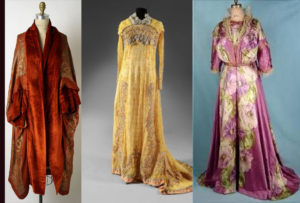
Yet More Liberty Aesthetic gowns.. …from the turn of the 19th into the 20th century. Note the common use of frocking, silk, and the cinched waist. High fashion of the day had a tightly corseted waist. This apparent attempt at give the illusion of a small waist does indicate the Aesthetics were not immune to wanting to be in style.
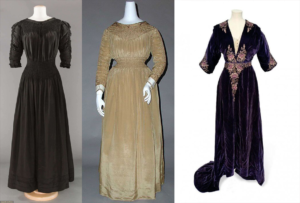
And more Liberty aesthetic gowns
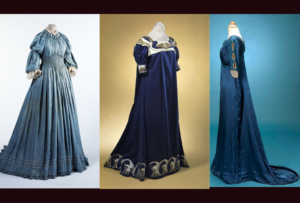
Reformers
Yet another Victorian group wanted to get rid of corsets too… The Aesthetes were dedicated to comfortable and sensuous clothing for women, but it was based on artistic principles, symbolic themes, and art forms of previous eras. This second type of “counter fashion movement” to the highly structured and dictated costume of Queen Victoria, the 2nd type of reform in dress came from those who thought medical reasons were why women’s clothing needed to change.
(Photo: 1909 Reform gown. )
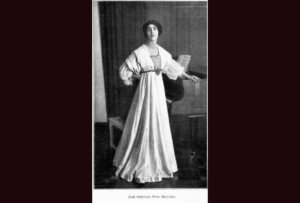
The Reform movement was in the Victorian Era.. .. but in the latter part, so is typically associated with the next, Edwardian Era.
“Reform” clothing was directed by medical professionals and health care providers. It included items such as bloomers, loose fitting corsets, natural fabrics, and especially “doctor’s orders” that every woman should wear wool next to the skin – even in a bathing costume that made her sink when it got wet.
(Sketch: 1858 Wool Reform Bathing Costume)
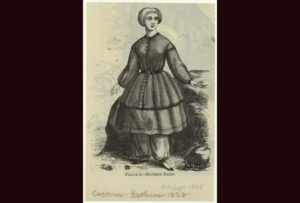
Victorian Dress Reform was… … the objective of the Victorian “Dress Reform Movement” which was also called the “Rational Dress Movement”. Reformists were mostly middle class women involved in the first wave of feminism in the United States and Britain from the 1850’s through the 1890’s, but it persisted into the next century.
The movement emerged in the Progressive Era along with calls for temperance, women’s education, suffrage, and moral purity.
(Photo: Key Reformists like Mileva Roller in this 1908 Reform gown were also advocates of women’s rights)
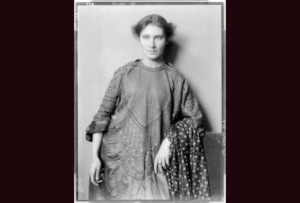
Bloomers & Trousers
Reform dress had been around a long time… … It had been discussed by female political idealists in France during the French Revolution, and American women (following the French at the time) liked the idea of wearing “trousers”. They had seen indigenous tribes wearing them.
With the concept of a new country where both genders worked hand in hand, it made sense to American women to have a garment they could wear toiling in the field.
(Photos: Left North American Ojibwa women and Right Cherokee woman of late 19th century in traditional dress which included “trousers”)
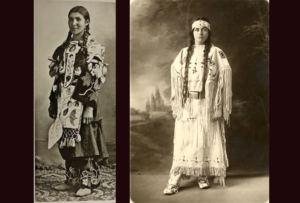
Victorian “Reform” Bloomers were baggy.. .. frilly trousers that reached to the ankle. They were cuffed and worn with a simple knee length skirt and bodice. Mrs. Bloomer thought it sensible and hygienic compared to boned fashion bodices and long weighty skirts.
The “bloomer” outfit was worn by a minority which included the Rational Dress Reformists, and never gained popularity until after her death. She herself had abandoned the idea when the cage crinoline was invented, which she had to admit was light and comfortable as it removed excessive use of petticoats.
The baggy bloomer trousers she liked reached to the ankle, were frill cuffed and worn with a simple knee length skirt and bodice.
(1900ish Reform worn in dress shops)
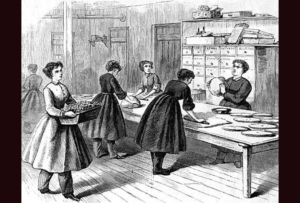
The Ups & Downs of Bloomers In the Early Victorian era, there arose American Mrs. Amelia Bloomer who caused quite a stir when she wrote and article in her feminist publication “The Lily” promoting the idea of women abandoning their petticoats and corsets for a “bi-furcated garment” later called “Bloomers”.
Mrs. Bloomer had seen trousers worn by Turkish women, and suggested all women would benefit by removing their voluminous skirts.
(Featured: 1858 Bloomers in insane asylums)
(Sketches below: Mrs. Bloomer shown in early concepts of her bloomers)

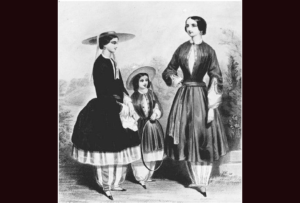
Victorian era fashion Reform clothing just made sense… … for women in cold climates, harsh conditions, or places far away from those who would judge them on the basis of being fashionable. While the Reform Movement and Reformers were making a political statement regarding the status of women, and a charge against corsets and fashion as being unhealthy, it was already practiced in America because of sheer functionality.
Quietly and without fanfare, many women, particularly women of the western settlements, by the 1860’s had abandoned fashion and wore the female counterpart of men’s trousers, jackets, and shirts. They did seem keep the basic silhouette and fabrics of the time, however, so fashion was not completely thrown away.
(Photo: left: 1867 Wisconsin farmer in trousers; right: Kiowa girls in traditional dress. Indigenous women for centuries already knew the benefits of wearing trousers.)
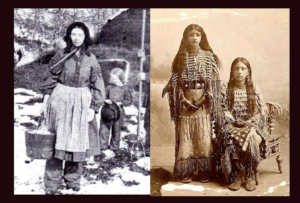
Victorian Bloomers were embraced… … worldwide only later in the 1890’s. By 1906 everyone was wearing them.
(Photo: 1906 Maori women making a political statement on behalf of the now well accepted Reform movement by wearing “Knickerbockers” as their sports and school uniform)
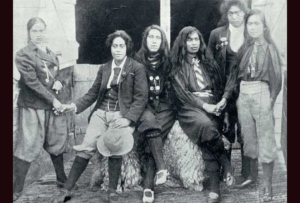
In the end.. Bloomers were accepted by all… … in 1895, a year after Mrs. Bloomer’s death, and almost 4 decades after she had suggested them. The trousers were now called bloomers, were adopted as suitable cycling wear for ladies.
(Below: Illustration for an article in the 1880 edition of “The Girl’s Own Paper” which suggested that the tricycle dress must have no trailing garments, and shows the design below as a suggestion for proper cycling apparel)
(Featured: Fortunately, women figured out the old bloomer was a much safer idea for sportswear, as illustrated on this 1897 magazine cover showing women with the complete Amelia Bloomer ensemble)
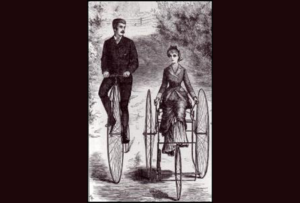
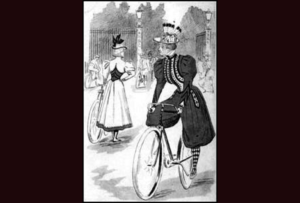
Reform vs High Fashion
We’ve been discussing the “counter fashion” movements within the Victorian Era. We started with the Aesthetes, who emulated sensuality and mythological themes using gorgeous fabrics, colors, and imagery.
Next is Reform, which comes from the medical community in attempt to get rid of corsets and make comfortable and sanitary garments become fashion.
In reality, both movements were closely related to high fashion as they followed the silhouette of high fashion of the time, and even as high fashion changed.
(Photo: Left Reform, Center High Fashion, Right Aesthetic gowns of 1909. Note the silhouette is the same, although it is achieved in entirely different ways)
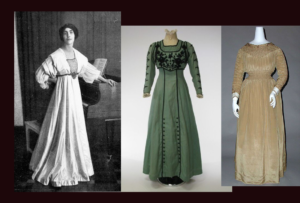
Reform was still Victorian… … it had the same basic silhouette, same lovely fabrics and trims, and same lengths and drapes as whatever was in fashion at the time. The main difference was the type of fabric, being breathable and of natural sources in Reform vs synthetics of high fashion – and – the corset.
(Garments: 1895 Reform left; 1895 High Fashion right)
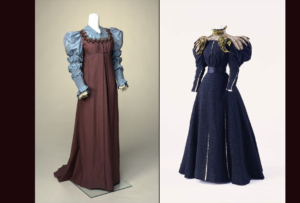
The corset makes the difference… … between Reform fashion and Victorian high fashion.
(Extant 1900 corsets: left Reform; right High fashion)
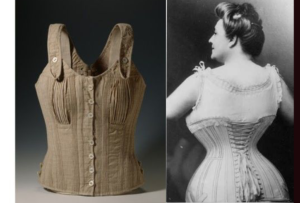
Reform corsets were not necessarily more comfortable.. .. because by the 1880’s, women had been wearing corsets since they were 6 years old, and adult styles since they were 10. Their internal organs and lifestyle had been gradually adjusted for high fashion.
It was the Reform corset that seemed odd and out of place at the time; almost like being naked.
(1880’s corsets: Left Reform; Right High Fashion)
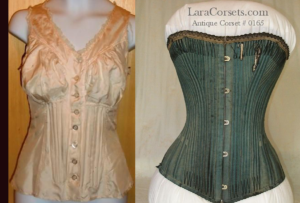
Victorian Reform corsets certainly presented a different… … Silhouette, and so image and social presentation. The Reform movement in the Victorian era represented a small number of women, but its influence was significant later – as in today – when corsets disappeared.
It only took them about 150 years to accomplish their goal of getting women into comfortable, sanitary, yet also attractive clothing.
(Early 1900’s extant gowns: Left Reform’s evening gown vs right “La Belle Epoque” (high style Parisienne))
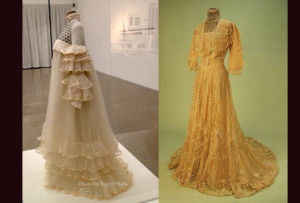
High Fashion of the Early Victorian Era
Early Victorian were the years 1837 to 1856. The era aimed to achieve a look of demure, prim gentility. Hats of the 1820’s leading up to it were giant, stiff, and had a flirtatious air.
When the 1835 bonnet was introduced, the look of fashion changed, and so gowns had to change too. Bonnets became lavishly trimmed, feminine, soft, and coy. They would set fashion trends until about 1890.
(Sketches: left hats of the 1820’s vs right bonnets of the 1850’s. While at first they seem the same – lavishly over embellished, there is a different “feeling” that led to different behaviors by wearers in the different decades. As with most fashion – headwear was a reflection of women’s situations)
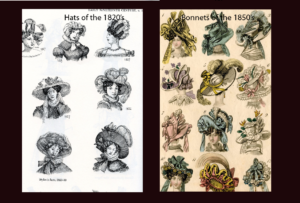
Late 1830’s & 1840’s
There were gigantic “Gigot” sleeves… .. in fashion in Europe and America in 1836. When Victoria took the throne in 1837, the sleeves collapsed abruptly so the ensemble began to have that “Early Victorian” look we associate with the prim, proper, and sentimental style of the time.
The popular ringlet hairstyle epitomized the attitude women were trying to express at the time.. a demure, feminine, and wistful kind of gal. The Victorian era was as much about “attitude” as it was about appearances.
(Portraits of English Royals – just before Victoria’s influence, showing the large sleeves, low waist, and style coming out of Regency – with the subtle differences as Victorians began to create the demure and more “feminine” look using ringlets, bonnets, and emphasis on the waist)
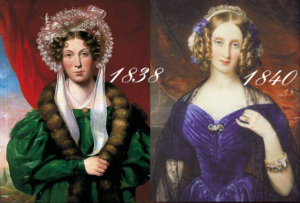
By 1840, the collapsed sleeve was… .. much narrower, but still had the dropped shoulder. The bodice of a gown in the Early Victorian era was tight fitting and pointed in front; much longer and with a small, tight fitting waist.
It was accomplished through restrictive corsets and extensive boning in the bodice itself. They also directed all decoration and boning vertically to look slim and smooth, and to keep bodices from bending over or folding. The whole focus of fashion in 1840 was a teeny tiny waist.
(Photos of real garments: note the sleeves getting smaller and the waist getting longer and sharply pointed as the late 1830’s turn into the 1840’s of Victoria’s early reign)
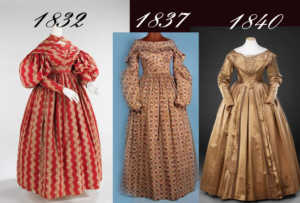
Helplessness of a woman… … is associated with our vision of the Victorian era. This is part of the demure and delicate image desired in the early part of the queen’s reign.
The boned bodice of 1845 with its very elongated “v” shape, plus the drooping shoulder seam line meant that women’s arm movements were restricted. This meant the woman not only appeared to be helpless, but that she pretty much actually WAS helpless.
(Portrait: 1845 delicate print, ringlets, looong inverted “v” waistlines, and sleeves that dropped low and were tight on the arms meant a fashionable woman could do little but sit around and look sweet)
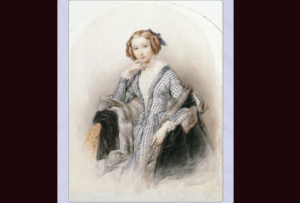
That dainty refined air of the Victorian woman… .. in the early days of the 1840’s could be accomplished by wearing freshly laundered detachable white collars and false undersleeves called engageantes. Both were made of delicate lacework.
(Portraits: Two women of 1845 of high fashion. Note the looong pointed waist, lacework on collar, large sleeves, and in these – not ringlets. This hair might be the more matronly look of the next Victorian era, but they sure look dainty and demure with those little smiles.)
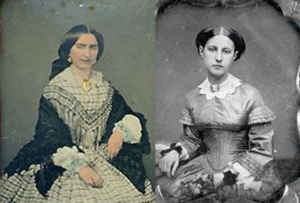
That early Victorian silhouette was made by… … a corset of course! By the early 1820’s, the metal grommet had been invented, allowing for tight lacing. By the 1840’s the corset had become a shaping instrument to mold the body to fashion.
The corset changed gradually between the early Victorian 1840’s into one with a tighter waist that was in the center vertically in the 1850’s and ’60’s.
(Sketch and 1840 corset: which solves the mystery of what women wore during their periods! Note the hook center front, presumeable to tie a rag or pad front and back… or perhaps it’s for post-birth bleeding since they had a LOT of children in those days).
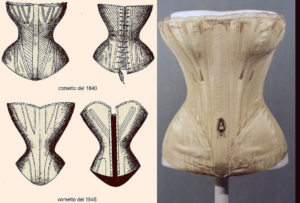
1850’s Corsets were a bit different… .. in that they were shorter and less pointed through the front. The metal busk (front metal part that hooks to close it) had been invented, allowing for increasingly strong cinching and the ability to shape the body. As with the corset on the right, “lips” were added for attaching the heavy petticoats so the weight would hang from the shoulders and not the waist.
In this they were similar to the 1600’s when they wore the “farthingale” which was a lot like a bicycle wheel around the waist. This trend to support the skirts on the corset would continue to increase into the 1860’s until the crinoline hoop was invented that took all that weight away.
(Corsets of 1850 – note the gorgeous embroidery on boning points. It would be another 40 years before they would be mass produced in abundance, so these were still made by a professional)
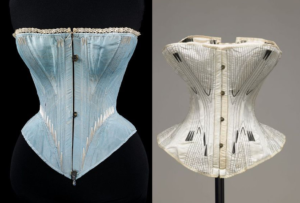
Waists got tinier as time went on… .. in the early Victorian Era. Busks and metal boning became stronger, and the rib cage started to move from its normal position. By the 1860’s, the 13″ waist of Scarlett O’Hara in “Gone With the Wind” would be possible due to her corset.
(Corsets: left 1850 and right 1860 – getting tighter and more controlling; simpler and less ornamented)
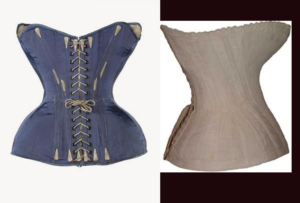
Scarlet of “Born With the Wind” would have been 20 years old… … when the Civil War ended. Although a fictional character, Scarlet O’Hara told the tale of the extreme of women’s fashion. At the time of the early to mid Victorian era, the American south did indeed lead the fashion movement in the U.S., although the dictates still came from England and Queen Victoria.
(Photo: the actress in her reproduction corset, chemise, and drawers (left) alongside a real 1862 corset (right). Most women did not have 13″ waists, although 18″-19″ was not unusual because of the movement of internal organs by corsets.)
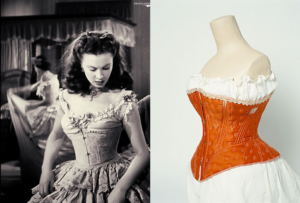
Getting into your corset was a big deal… … throughout the Victorian Era. While the main job of middle class women in the 1840’s was to be the social representative for their husband, most did not have a serving woman to help them get dressed. These cartoons from 1830 (left) and 1840 (right) indicate that most likely the young husband in upwardly social climbing households was put to work in “Le Matin” as the cartoon is called (“The Morning”) until they could afford a housemaid.
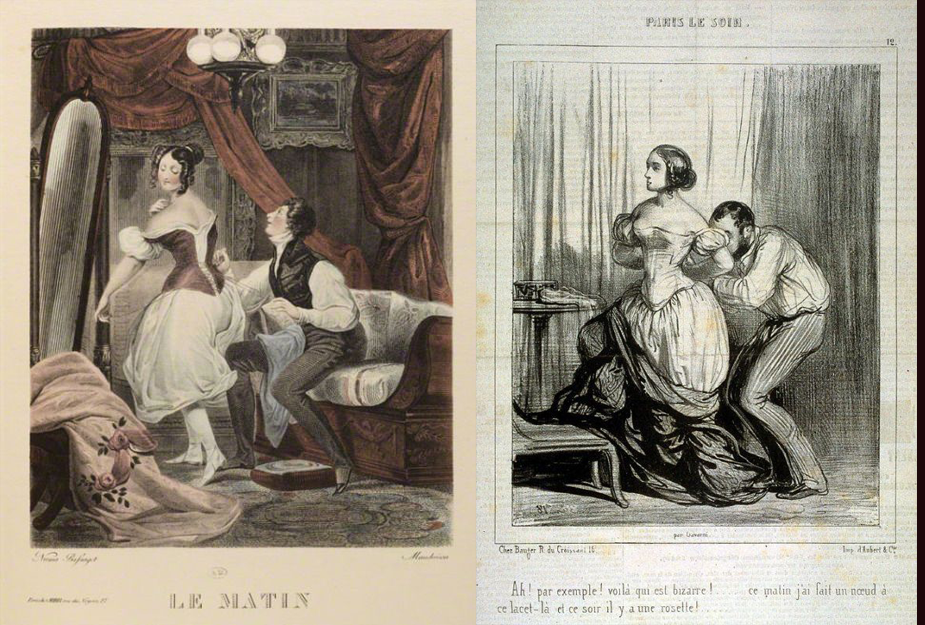
An American corset company, started by a man… … the Worcester Company in the US was on the rise as the leading manufacturer or mass produced corsets in the world during the early Victorian era.
By this time corsetiers were both men and women thanks to the sewing machine which had been modified “back” from being single needle “punchers” to industrial models. It would be in the early 1860’s that Singer would put the sewing machine into homes.
(Photo: late 1860’s chain stitch home sewing machine from Canada, and an 1898 mass produced Worcester corset)
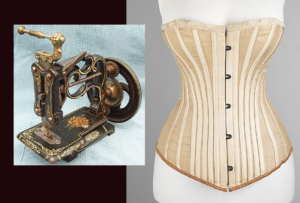
By the time corsets were mass produced in the Victorian era.. .. there were MANY kinds, including nursing and maternity, sport, and health/reform.
(Photo: Late 1860’s maternity corset had side laces so the bones were still aligned correctly. Women could actually be in danger if they suddenly removed their corsets for pregnancy, because their organs and rib cage had been moved and/or altered in wearing a corset all their lives).
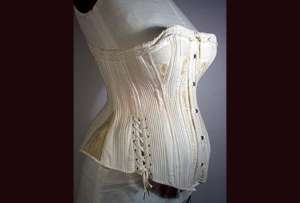
Unfortunately.. women did die in child birth… .. throughout history, but during the Victorian Era, it had a lot to do with the organs moving and childbirth. The body adapted through training to a corset since childhood, but when the corset was suddenly taken away for pregnancy and birth, the sudden movement was dangerous to women.
(Photo: an 1840’s father and child mourning the loss of wife/mother in childbirth)
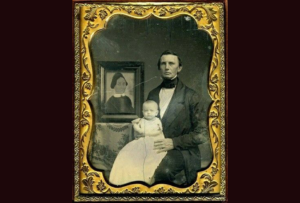
On the brighter side, Victorian men and women.., .. enjoyed a freedom in their relationships that had not been seen before (except the wild and crazy Regency era when they were young perhaps). Roles were clearly defined, and while women were active in the politics to gain the right to vote, marital property laws, and rights to education, in general men and women got along.
With all the new-fangled gadgets being invented, they were equal in that no one could figure anything out.
(Photo: 1840’s engageante sleeve and lacework collared wife claims her man symbolically by laying her fan on his knee.. proof Victorians did have some fun.)
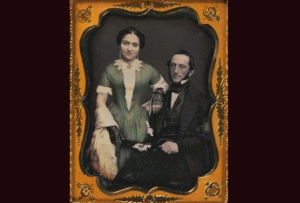
Victorian women of fashion were neat… … ladylike, soft, and demure, or at least their clothing was. Delicate dimity patterns and pretty pastels were a favorite in the Early Victorian years around 1840.
(The Countess d’Hessenville strikes the pose of the ideal woman of 1845)
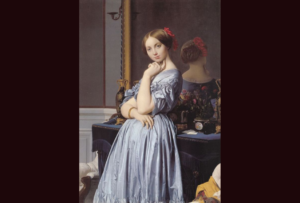
From the day you were born Victorian girl.. … you were expected to follow a certain lifestyle. While class structure was changing in America and Europe due to a rising merchant middle class, in the early Victorian era (1840’s-’50’s) the aristocracy still reigned in England.
Wives and daughters of industrialists with their new found wealth, however, mingled in high society, starting to blur the lines between classes. The U.S., as it had since its inception, still had the highest standard of living anywhere in the world because of them.
(Photo: as the profession of photography developed, more and more every day people had their portraits taken. Note the lace collar and hairstyle typical of the early Victorians.)(Note also the photos we have been using are framed. At this time, it becomes much easier to track what women were wearing because families have kept their ancestor’s portraits.)
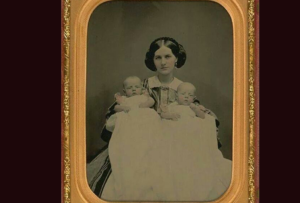
History & literature want you to believe… . the Victorian era had only terribly wealthy people or noblemen vs impoverished farmers or servants who lived in the basement, but in reality in Europe 3 out of 4 people did some sort of manual labor. In America, still basically an agricultural society but with industry on a steep rise, the number was even greater.
(Photo: a “typical” upper working class 1840’s English family at the dinner table was not entirely the romantic image movies would lead you to believe was Victorian decorum)
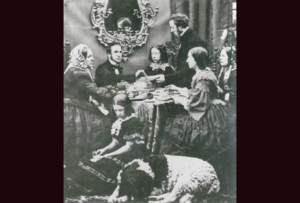
Early Victorian women of all ages & sizes,… .. positions in life, and lifestyles wore some version of the same high fashion design. Of course, it started with the corset, but accessories and fit of the dress varied.
(Photos: two Victorian women of the early 1840’s with the collar, sleeves, and hair indicative of the time. Note the fan – not only functional in warm climates, but used as a sort of “language” like it had been in the 18th century)
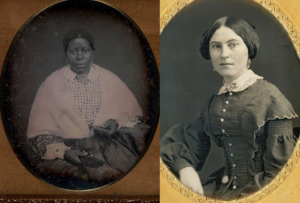
High fashion of the early Victorians.. .. was worn by young girls to old women, but of course modified to suit their station or status. Since the upper and middle classes posed for portraits, we can assume in the photos of the 1840’s and 1850’s, that they are dressed in their best. Young girls emulated the same demure look of their mothers, with the pointed waist, large sleeves, and collar.
For dress or evening wear, the collar and inset (aka fake “blouse” or chemisette) was left off and the should of the gown dropped further off the shoulder, leaving the neck exposed. This change in shoulder and sleeve was the start of the next stage of high early Victorian fashion.
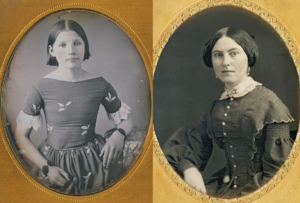
The dropped neck and shoulder line… … by 1845 became the prevalent design in Victorian fashion. The corset was still the same, but the waistline was getting less pointed, and the bodice more tightly fitted. Young women and preteens wore the same as older women, and they did wear corsets, but the shape didn’t look quite the same without the lift of the bosoms.
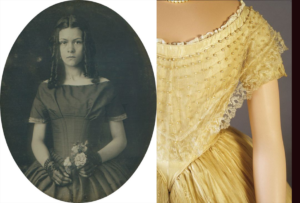
Early Victorian teens wore… … the same shape and fashion as their mothers. Motherhood was the expected profession of all young women, so regardless of class or occupation, young women learned the basics of running a household and caring for children from an early age – all done in a corset of course. They started wearing a corset between 6 and 10 years old, and they would wear them even at night for the rest of their lives (the night corset was a bit looser).
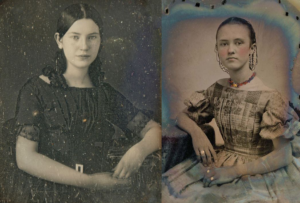
Some Victorian teens were rebels.. … as were many women of the era. With the Reform movement and the Aesthetes (discussed last month), many teens rejected high fashion’s dictates with tight corsetry, bodices, and delicate flowered fabrics, and wore the flowing robes and rich fabrics with natural hair of the “fashion rebels”.
(Photo: 1840’s teen in Aesthetic gown)
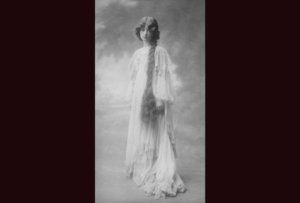
1850’s
Dimities turned into plaids… … as early Victorian fashion followed the queen’s whims into the 1850’s. Victoria had visited Scotland, and was enamored with “plaids” (kilts) and bold fabrics of the Scots. The rest of the world followed suit.. we mean dress.
(Sketch: Prince Albert, Victoria’s husband, and Photo: Victoria with her first born in mid-1850’s in Scottish inspired plaid)
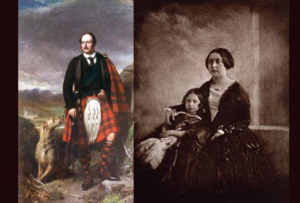
Today’s British Royals still embrace Victorian plaids… .. as seen in a (left) 2013 photo of Princess Charlene and one (right) of Prince Harry’s new wife from America, Meghan Markle in 2018.
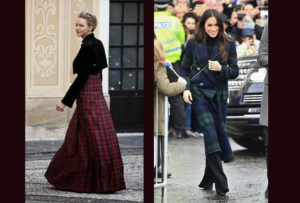
A few of the plaids were delicate… … and always had the fashionable silhouettes of the era. Here and 1845 sheer gown has the longer shape of the bodice with a rounded bottom (as opposed to the sharp “v” of the previous 5-8 years), and the concept of “over and under” (like we saw back in the 1805ish Regency era) of a sheer over an under skirt.
The shape at this point is made by heavy petticoats – often 6 or 7. The gathered rather than fitted bodice was a harbinger of the day dress of the mid 1850’s that was to come to women of all classes.
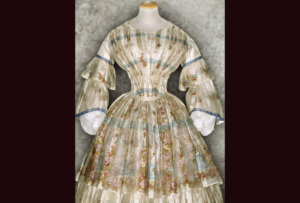
Class & Status were clear for Victorian women… … and clothing and whether it was fashionable or not clearly marked a woman’s station in life. All women, however, followed the general dictates of Victoria in the line, length, shape, accessories, and hairstyle. The difference was in the quality of the cut, fabric, design based on income – and function.
A woman working in a factory had much different function than a merchant’s wife, or a Royal, yet they all had the same silhouette.
(1855: left, laundresses; right, Princess Victoria, daughter of Queen Victoria and Albert)
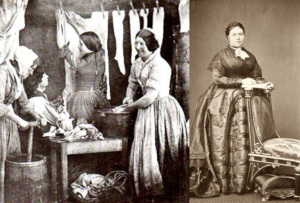
Trim, color, and notions made the difference… .. in quality and how well a woman could mark her status. The silhouette was dictated by young Victoria, but the personality was added by the individual.
(Photos: Left, 1860’s maid; Right, Fanny Fern, American humorist and novelist in the mid 1850’s obviously is poking fun at high fashion with her almost cartoon-like sleeves, trim, and caricature of a dignified lady’s pose)
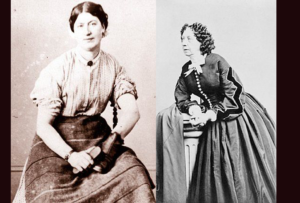
Young Queen Victoria of England broke fashion rules.. .. and when she married, she wore (gasp) white. Previously, black was considered formal, and many other colors were worn. 20 years later, after Prince Albert’s death (Victoria’s beloved husband who died of TB after a visit to their son), black was the rule for mourning, and an entire fashion industry was developed around mourning apparel worldwide.
Many of Victoria’s innovations in fashion would become the norm even to today.
(Photo: Queen Victoria and Albert’s first born child, Victoria, was married in 1858 in the epitomy of Victorian wedding white)
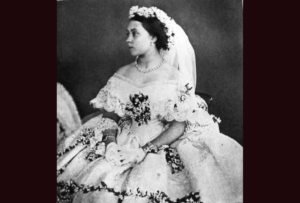
Along with mourning rituals, a new post mortem obsession… .. of taking photographs of the dead person gained huge popularity in the Victorian era. It was common late in the Civil War mid-1860’s to take pictures of the dead man sitting with his family. As 1900 approached and photographic and ability to prop up the dead tachniques improved, it seemed everyone who could afford it was doing it.
It’s a bit frightening to do photo searches today to see what people were wearing because you never know if the person depicted was dead or alive at the time. The favorite was to show children and young women alongside their siblings.
(Photo: 1845 sisters. Which are dead and which are alive?)
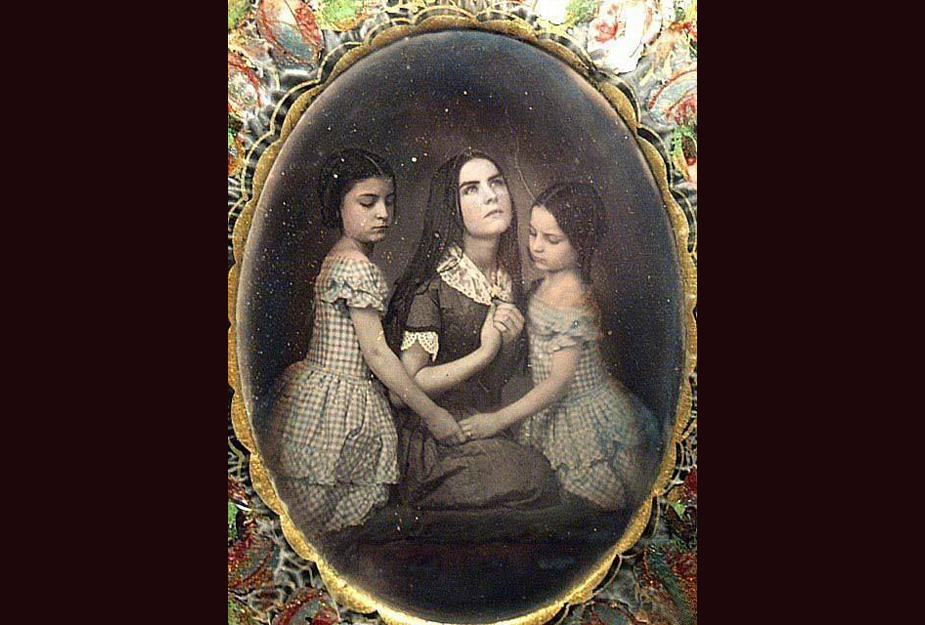
It’s hard to tell who’s dead in Post Mortem portraits… .. and we’ve gotten scared to search for Victorian fashion photos because we’ll run across these when we least expect them, thinking it’s a lovely scene with siblings or mother and child.
Can you tell in the two portraits who is dead? (Hint: the ones who are fuzzy are the live ones that couldn’t hold still for the slow cameras of the era)
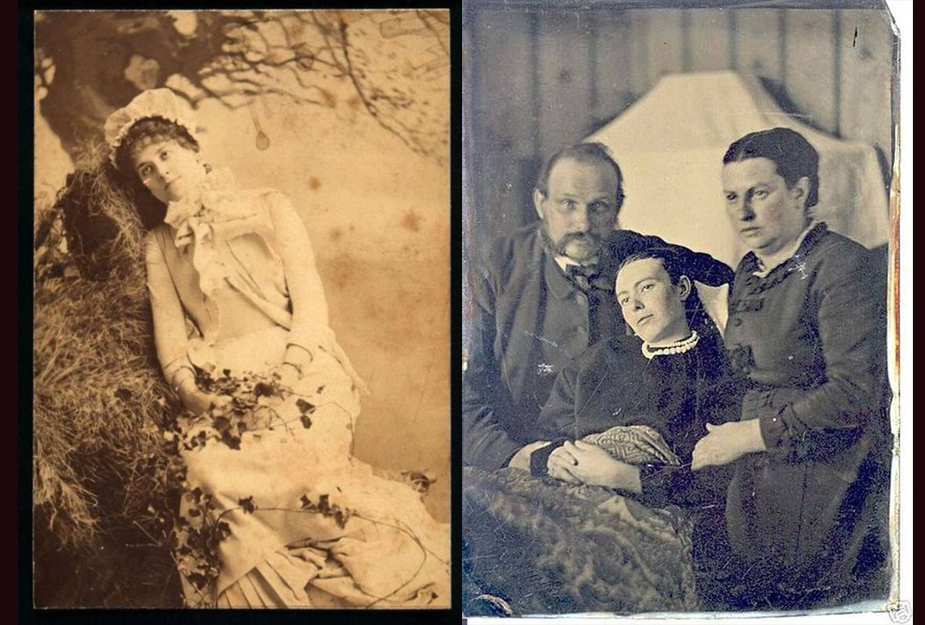
Now you’re nervous we’ll show dead Victorians again… .. we promise not to knowingly post any Post Mortem Victorian portraits on here. What you have to understand about the Victorians (1837 to 1bout 1900) is that they embraced technology and then did weird stuff with it.. like build a successful commuter hot air balloons, and then try to make a ship run on hot air like the one in 1855 that had to be towed back to land.
They also did strange things with their new synthetic dyes, like make a green out of arsenic that killed the wearer, or her dance partner or anyone who touched her sweat.
(Sketch & photo: after discovering the dangers of “Arsenic Green”, much fun was made of it by cartoonists. This is a real museum sample of the same; hopefully in an airtight case)
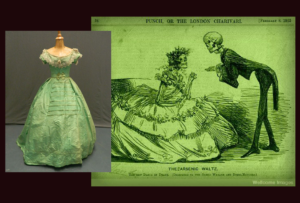
No, we don’t have obsession with death, but… .. the Victorians did. The other strange thing they did was to save their hair (women wore it long!) from their brush, and weave it into gifts for their loved ones. When a loved one died, these “hair lockets”, brooches, and watch fobs were worn in memory of the one who had gone.
(Portrait: We promise she’s not dead in the picture.. a girl and her hair in a mourning brooch)
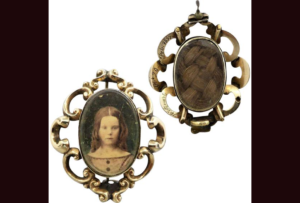
Hair from the deceased became an art form… .. often combining the hair of several people (usually women or girls because it was long) into elaborate images.. some a little odd to our minds today.
(Pictures: “Hair Shrines” to the dead from the 1860’s; a big business and an art form – as with this 18 carat gold setting)
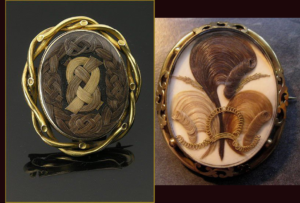
Watch fobs & little picture window lockets.. .. were a favorite of the Victorians to honor their dead, because they could put a sketch or photo of the deceased loved one in the front, and their hair in the back or vice versa.
(Photos: 1855 locket and watch fob for mourning)
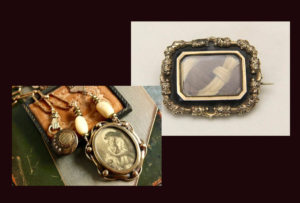
Sketches of the loved one or tranquil scenes… .. were put on the lockets, fobs, and pictures alongside hair or separate from it. Designs specific to the Victorian eras surrounded the sketch; usually highly ornamented with scrolls and symbols taken from ancient societies like Greek and Roman gods, or religious institutions.
Often the cemetery was depicted, with the loved one “haunting” their own grave, or like this 1790 brooch, the loved one’s dog sits crying. Brooches of the 18th century and 19th century were much similar in depiction, but different in materials, as new synthetics, resins, and imports became available at the approach of 1900.
(Mourning brooches: left, 1790; right 1860’s)
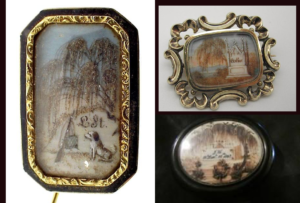
Whitby Jet was a favorite for mourning jewelry… .. in the Victorian era. Jet is a product of high pressure decomposition of wood from and ancient type of coniferous tree millions of years ago. It is found in hard form which is the result of carbon compression and salt water. Soft jet is the result of carbon compression and fresh water.
(Raw Whitby Jet and an 1860’s stick pin carved from it)
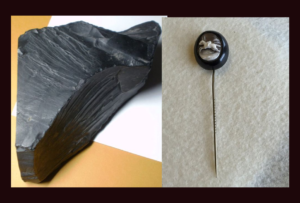
Whitby Jet in raw form is found in… .. Whitby England. This jet is approximately 182 million years old. Here it is fossilized wood from a species similar to the Chile pine or Monkey Puzzle tree.
Jet is also found in Poland, Northern Spain, and near Erzurum in Turkey. A common gift for a Turk to bring to a US host are Whitby Jet prayer beads, which have a unique odor.
(Portrait: Woman of 1860’s wearing necklace made of Whitby Jet.)
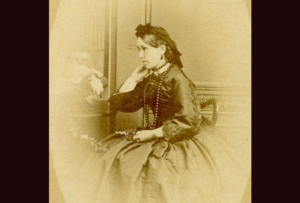
Jet has been used in Britain since… .. at least 10,000 BC when a model of a botfly larva was found made of it near Baden-Wurttemberg, Germany. Britain used it through the Bronze Age, predominantly for necklace beads.
Jet went out of fashion until the early 3rd century AD, although the Anglo-Saxons and Vikings – and later those in the Medieval period used it sporadically. In Roman Britain from that point on it was used in rings, hair pins, beads bracelets, necklaces, and pendants, but it was not worked in Whitby itself. The raw goods were transferred to what is now York.
Samples of historical jet works have been found on the beaches mostly.
(Pictures: Modern day cutting Whitby is no easy task, and a recently carved jet cameo with pink sea shell)
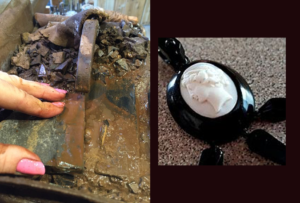
The Romans thought jet was… .. magical, and they put it into amulets and pendants because of its supposed protective qualities and the ability to deflect the gaze of the “evil eye”. Pliny the Elder of Rome wrote “the kindling of jet drives off snakes and relieves suffocation of the uterus. Its fumes detect attempts to simulate a disabling illness or a state of virginity”.
Samples ahve been found all over the Roman British Empire and in Europe including bracelets made of jet with gold inserts found along the Rhine.
(Samples: Modern Whitby jet jewelry despite advanced technology for cutting and inlays is expensive. This necklace made of sterling and Jet sells for $500, and the ammonite shell inlays drive the price even higher. Many past and current jewelry samples come from Scotland and represent Celtic symbols)
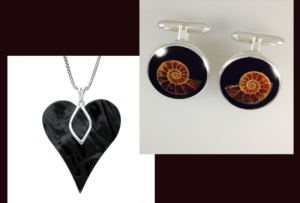
Jet had a huge resurgence in use in the late Victorian era… .. because Queen Victoria wore it as part of her black mourning ensemble at the death of her beloved Prince Albert.
(Photo: Victoria and her daughter Beatrice in mourning apparel for Prince Albert)
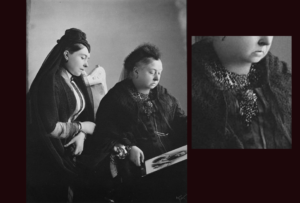
Whitby Jet became a necessary part of.. mourning jewelry, and a huge industry developed during the Victorian era. Its somber color and modest appearance in all forms had it formed into religious artifacts and jewelry such as rosaries for monks.
(Photos: Late Victorian typical mourning gown with “high” and “low” Whitby mourning jewelry. Below: sample of a favorite mourning brooch design which might include bars for number of children, a spouse, or other beloveds left behind by the deceased)
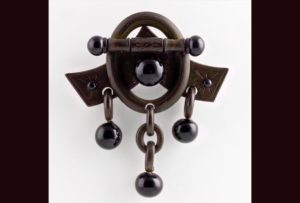
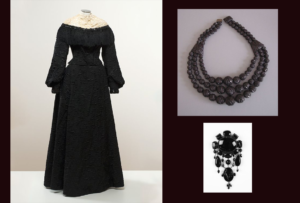
Victorian mourning apparel was complete… … and prescribed from the day forward to which Prince Albert of England died. Of note is – this is a PHOTOGRAPH!! Common by the 1890’s, but very new in the 1840’s…
(Photo: all of Queen Victoria and Albert’s daughters, in a typical Victorian portrait, pose around a bust of their recently deceased father. We have seen the same thing in Napoleon’s era, where the women posed with statues of brothers, uncles, fathers, and military men in painted portraits).
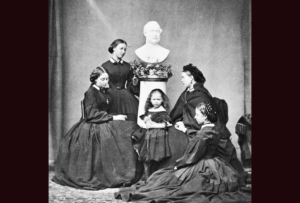
For a full and detailed explanation of Victorian Mourning rituals and apparel, see the 1903 Mourning Maid project here.
Back to Victorian fashion.. … having waylaid ourselves with Post-Mortem stuff, culture, lifestyle, women’s roles, and other “stuff”. We will be going through the different Victorian era fashions using – CATS! – yes, cats to describe them.
With the invention of the daguerrotype photo imaging process (a method of using silver on glass slides to process reverse images) in 1839 by a Frenchman, and the common availability of the method by 1861 – some of the first images of “what women really wore” came out of the early Victorian era…
.. and.. those women just had to have their CATS when they sat for that portrait…
(Daguerrotype: One of the first, this is in a bordello in the 1840’s. Those early ones seemed to be in bordellos, or of old women/mothers.. is it the (obviously male in the early period) photographers were testing the new technology on the favorite women in their lives..?)
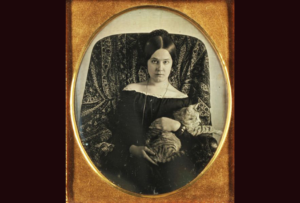

The early Victorian era which started with her coronation in 1837, established the Queen of England as the fashion trend setter world wide.
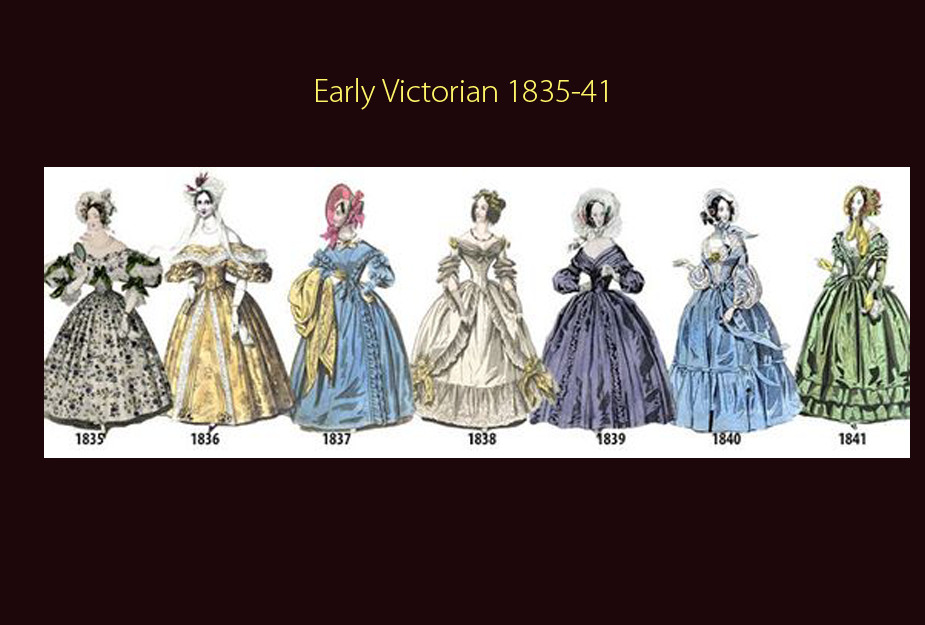
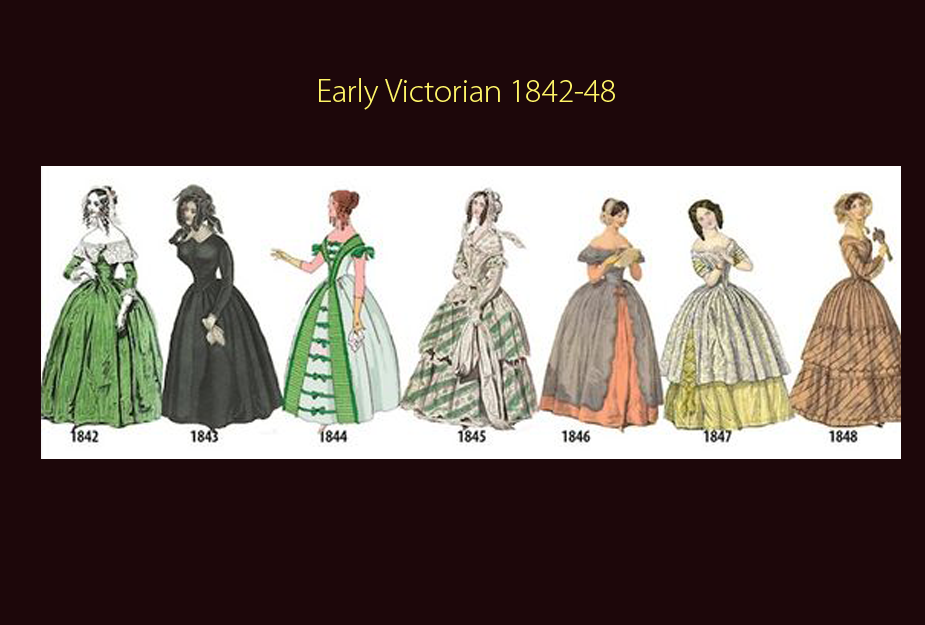
More 1840’s-1850’s
Colors of Victorian fashion in 1845… .. became more saturated as the 1850’s approached. The pale delicate and girlish dimity fabrics became the rich colors of a Scottish plaid, or an imported silk.
Mid Victorian 1861 to 1866 fashion kept growing bigger… .. literally into larger skirts and bigger attitudes. With America at war, and Europe making tenuous peace. women wanted to be noticed.
Mid-Victorian Fashion according to historians started.. … in 1860 and lasted until 1880. There were four significant changes and factors they say made a distinct “line in the fashion sand” between the end of the ’50’s and the start of the ’60’s.
These affected the silhouette, construction, design, and presentation of women’s clothing.
(1865 to 1900 silhouettes: Mid to Late Victorian)
As early Victorian merged into Mid Victorian fashion (1855-68)… … everything became bigger, bolder, and more colorful. It was the world of “Gone with the Wind” and notable 12′ diameter skirts with layers and layers.. until the introduction of the crinoline to the fashion world by Eugenie of France – who was a buddy of Queen Victoria, and thus the idea of the REALLY BIG skirt would fly worldwide.
1855-1868
High fashion, directed by a young and newly wed Queen Victoria, came out of England, but with the vast communications, trade, and import/export worldwide opening up with improved merchant ships and development of railroads on every continent, “English only” meant any idea or material brought from anywhere in the world.
(Photo: Your 1845 cat is a dog! In this early daguerrotype from England, you can see the engageante sleeves, Van Dyke collar (see last week’s posts), and deep “V” of the bodice.. but even in black and white you can tell the colors are deep and rich, and the fabric is fine in this middle class portrait)
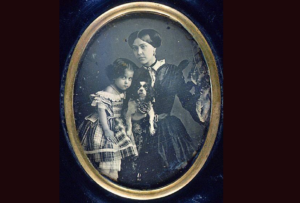
1845 Victorians wore bonnets and colors.. .. beautiful imported fabrics from all over the world became easy to find. In America with its rising industrial and merchant middle classes, the need to produce their own goods became reduced. America of 1820 led the world in cotton production, and this extended to dye and textile processes.
What this meant for American women was they had access and the money to buy almost anything they wanted. Godey’s Lady’s Handbook was THE GO-TO for fashion inspiration. Fashion plates like this one were in all the books, while some books include patterns as well.
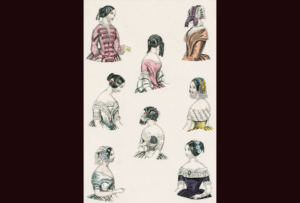
The Victorian silhouette changed by 1847… … In the early Victorian era, it was a smooth and consistent evolution of line, shape, color, and texture (unlike some abrupt ones that would come such as “bustle; then no bustle”. The 1845 “V” in the front of the bodice was still there, as were the collars and undersleeves, but the “V” became deeper and was pleated at the bottom.
The shoulder dropped, and especially in evening wear, went below the shoulder.
(Portrait: 1847 evening gown with cat. Rich, saturated colors and the off the shoulder with the tight “V” waist marked the year.. plus note the artistry of the portrait accelerated world wide with the easier access to photography, as not everyone embraced the accuracy of the photo. Many women preferred to be painted as they wished they could be)
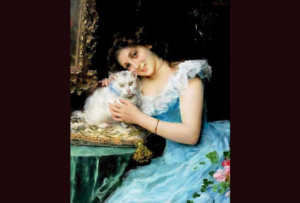
Skirts were the most visible difference.. .. in Victorian fashion. Cartridge pleats as shown in this 1841 skirt on the left (with 1770’s fabric!) piled up thickness of fabric to fit into the tiny waist.
After 1846 (sample right is 1845), flat pleating, and “modified box pleats” and various combinations around the waist allowed more fabric at the hemline, and so the much wider skirt as the 1840’s went into the 1850’s.
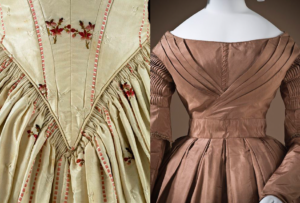
Women wanted BIGGER skirts in the 1840’s.. .. than they could get with cartridge pleats or current designs.
Because the 1840’s skirts did not have as much fabric or width at the hem, between 1840 and 1845, women added big flounces on evening dresses.
(Garment: 2 tiers of deep flounces mark the years 1840 to 45)
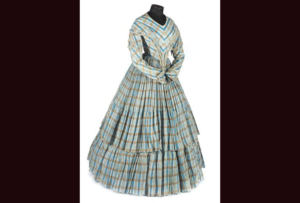
Flounces and Overskirts added skirt width… .. in the 1840’s. By 1845, big flounces and an additional overskirt became the regular feature of day as well as evening wear.
(Garment: 1841 estimated short overskirt over the main skirt. It was built into the waist and tightly gathered)
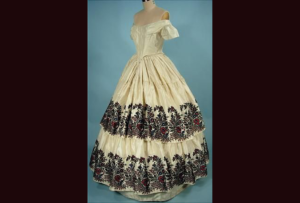
As the 1840’s turned into 1850’s, skirts… … were given MORE flounces and MORE tiers. It started out as 2 tiers as more of an overskirt with main skirt in the beginning, and then 3 tiers became the norm.
Each tier was tightly gathered at the top, and weighted down with horsehair braid at the bottom so it would lay flat along the one below and not stick out like a bad haircut.
(Sketch: high fashion that women followed, mimicked, and copied from “Godey’s” Lady’s handbook shows the 1855 large 3 tiered style)
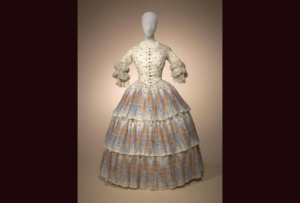
The 3 Tiers of flounces got BIGGER… … deeper, had more gathers at the top, and bigger diameter at the bottom. The shape was made by the fabric of the skirt and the waist pleating detail at this point. It took several large and elaborate petticoats to help hold the skirt out like this sketch from a sales periodical of the late 1850’s (hint: crinolines to come..)
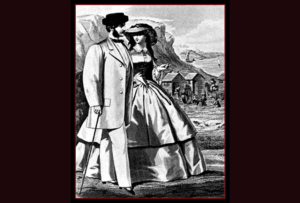
Petticoats of the 1840’s were… … large, with elaborate detail, and beautiful enough to be worn as outer garments. The one on the right might have been a “sheer gown” of the era – worn on the outside of a plain colored silk petticoat that would show through underneath.
Note the same pleating and silhouette is used for the petticoat as the main skirt in the 1840’s.
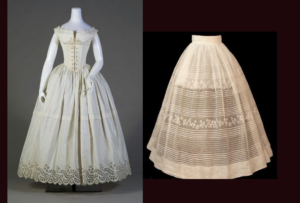
Petticoats remind us of.. … those of the late 1700’s. In both eras, the petticoat provided warmth, modesty, and fullness to the skirt. In both eras they were often quilted, embroidered, and beautiful enough to be worn on the outside, but the quilted petticoat like this from 1850 France was strictly a private thing and not for show.
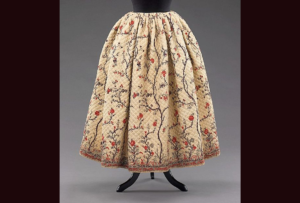
The 1840 2 or 3-Tiered flounces.. … became ornamented at the bottom- with scallops, early versions of rick-rack, braids, and other interesting trims.
Some day dresses like the one shown had flounces on the bodice too. It was not unusual to have 2-3 flounces on the bodice, and 2-5 flounces. on the skirt in the late 1840’s like the 1845 day dress shown here.
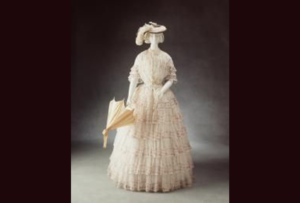
It was a mix and match game of bodices.. .. and skirts. Even in simple, cotton day dresses like these Massachusetts gowns shown, there was great individualism in detail on the bodice and skirt. The 1840 dress (left) shows the deeply pointed “V” at the waist that was favored early in that decade, with the beginning of simple flounces and a narrower, yet flat pleated skirt that would be used extensively in the next 2 decades.
On the right is an 1845 shirred bodice. You note the waist line is rising and less pointed. While the skirt does not have flounces, it is just as full as the flounced one because of the lines of the skirt and the petticoats beneath. The more rounded waistline became necessary as the type of pleating changed to accommodate the bigger skirt.
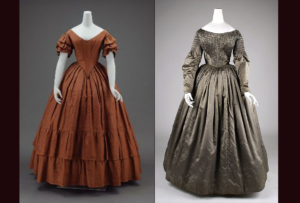
By 1848, skirts had 5 flounces.. .. and high fashion of the day dictated those must have visual weight with lots of trim and detail, as well as actual weight to hold them flat so they wouldn’t stick out sideways.
(Sketch: 1848 from Godey’s Lady’s Book again.. the “bible” of the era for American women to follow for fashion)
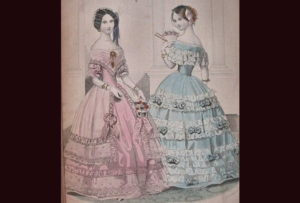
1850’s
Even poor women had flounces.. .. Museum examples of “every day” women of the 1840’s and 1850’s show large flounces in matching fabrics with as much trim as they could afford. Since the home sewing machine was not available for another decade, they must have had dressmakers make these; terribly pricey because of all that fabric. One could assume they reworked older garments into matching trim or flounces to “stick” onto newly shaped garments.
(Garments: Late 1850’s evening (left) and day (right) dresses of plaids and prints typical of the decade. Note the simple flounces – and fewer of them – in these “lower class” garments)
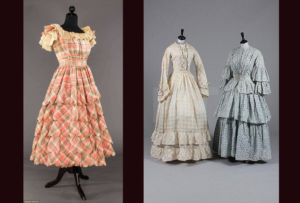
Women were smart in the 1850’s… … They figured out ways to stretch a single (expensive) garment for multiple uses, or different weather. Like this 1850 overskirt/2-tiered evening gown, they built in adjustments for activity, weather, or fashion. They could remove or add the Pagoda sleeves, and change the number of tiers or petticoats to make a dress casual or formal.
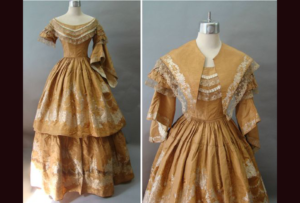
Fabrics & colors in the 1850’s… … used the new dye and weaving processes of the day, learned from other countries like Scotland, India, and NOT the Asias yet.. non-Asians were only just allowed open trade and movement in the Asias about this time).
Printed and hand-dyed fabric rose in popularity for those who couldn’t afford to imported woven plaids or expensive prints. These replicated the look of fine silks coming out of India, and you can see influence of Indian “batik” and other resistance dye processes of the time.
(Photo: left, 1855 dressing gown paisley silk influence from India; right earlier 1830-40’s gown painted and dyed silk, also Indian influenced techniques)
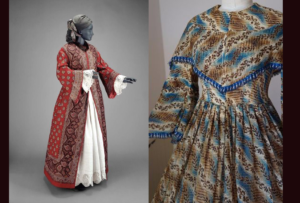
Which brings us back to the CAT.. … of 1850. You thought we had forgotten?? This cat is with a woman who is NOT wearing the flounces and frills of the era. She is most likely a Quaker, or other religious sect, although it would be rare for a Quaker to pose for an elaborate portrait like this.
The point is – while the predominant fashion was tiers and large skirts and delicate fabrics with shirrings, pointy waistlines, and tight corsets – we must not forget that not EVERY woman in the world followed fashion.
The Reformers, Aesthetics, Pre-Raphaelites we have discussed before prevailed throughout the entire Victorian Era. They wore less ornament, lovelier fabrics with draping, and more basic silhouettes.
We still suspect that’s a really BIG skirt under that cat though…!
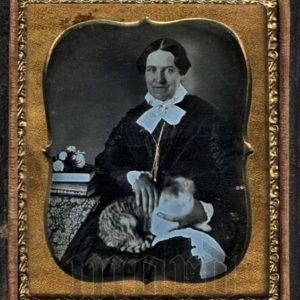
The cashmere shawl.. (not cat hair!) came back into fashion about 1840. Because the new version was larger it acted as an outer wrap and when folded in half and draped over the shoulders would reach almost to ground level in some cases.
Note the paisley is more influence of the Indies as discussed yesterday.
(Garments: left, the 1824 shawl covered the narrow Regency skirt. It got bigger as the ’40’s progressed and skirts got bigger, right)
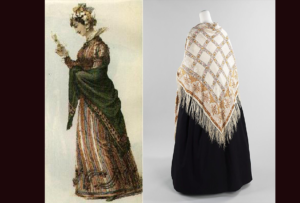
The not cat hair shawl… .. just got bigger and BIGGER along with the diameter of the skirts. The cashmere shawl with its paisley prints, made popular by Queen Victoria of England, but originating in specific patterns and meanings out of India, was wildly popular.
(Garment: 1850-60’s big shawls)
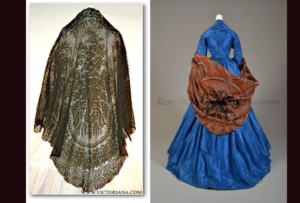
The not cat hair shawl… .. just got bigger and BIGGER along with the diameter of the skirts. The cashmere shawl with its paisley prints, made popular by Queen Victoria of England, but originating in specific patterns and meanings out of India, was wildly popular.
(Garment: 1850-60’s big shawls)
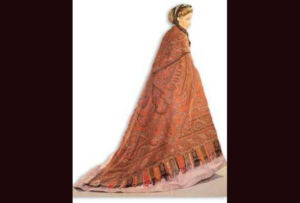
Paisleys came in print or woven.. … and of different values. Color combinations, images, what other designs were integrated or around the main design varied. Originating in India and imported to England, it didn’t take long for England and then others to replicate the designs and weaves and mass produce them. Scotland was known for paisley shawls.
(Garment: 1850 Kashmir from India in a traditional Sikh design – very valuable today as it is a woven form)
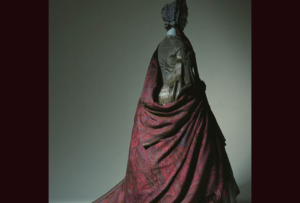
Paisley was ripped off.. .. copied, and duplicated on a large scale by the end of the 1860’s. They eventually became so cheap due to mass production and locally made versions that everyone could have one, leading to their loss of popularity.
Some countries like Scotland changed the way it was made or designed, but the most valuable depicted histories of India and were woven.
(Paisley examples from the 1840’s: left Sikh dynasty India woven; right Scottish representation printed on fabric)
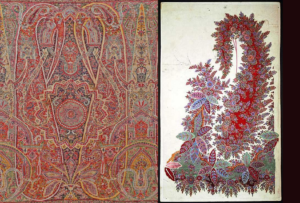
Wildly popular in the 1850’s.. … across Europe and the US, shawls were worn for every occasion important or daily, like this 1851 wedding shawl.
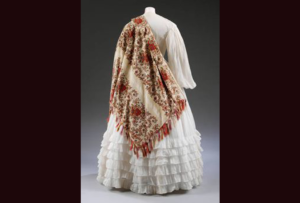
Which brings us back to shawls and cats.. … or dogs in this case. This sketch depicting 1846 shows the rural fashion well with a locally made shawl (for England), and a pet.
They really liked their pets in the early Victorian era!
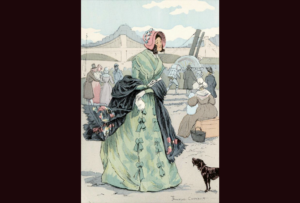
Under the scarves, skirts.. of the 1840’s became wider and more dome shaped than those of the 1830’s. By 1842, they needed more support to get the width than you could get piling on many petticoats.
Petticoats began to be stiffened with horsehair woven into fabrics like linens.
(Photos: the widening dome of this 1843 cotton dress is made by the 1843 horsehair predecessor to the crinoline)
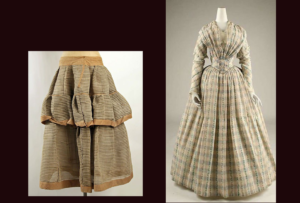
Between 1843 & 1845, skirts domed… .. even more, and the undergarments had to accommodate the enlargement.
(Photos: 1845 modified horsehair petticoat with more tiers to get even wider with its resultant skirt shape in theis 1845 cotton tiered day dress)
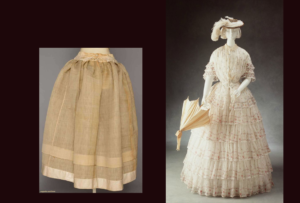
Fashion in the 1840’s was Victorian… .. meaning style was set by Queen Victoria of England during this early Victorian era – BUT – it was Godey’s Lady’s Handbook that was communicating to women around the world what Victoria expected.
The changing silhouette, and particularly the increasing dome of the 1840’s skirt can be seen in these Godey’s Fashion plate sketches. Note how they usually have two women together doing something leisurely and of high class status. This is most likely because the poor, working classes did not have time and money to buy Godey’s book, but got their information from other sources.
(Godey’s sketches: Demure skirt of 1832 (left), gets wider and more bold by 1837 (right); both still supported only by petticoats)
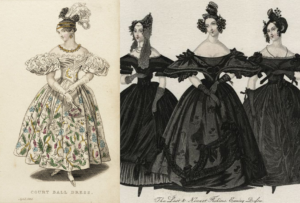 Skirts got wider with tiers… .. as the 1840’s (and Queen Victoria’s) reign progressed in its early stages. As the 1837 (left) skirt in a Godey’s sketch shows the pleats and fullness, by 1840 (right) it was domed and supported by the horsehair domed petticoat beneath.
Skirts got wider with tiers… .. as the 1840’s (and Queen Victoria’s) reign progressed in its early stages. As the 1837 (left) skirt in a Godey’s sketch shows the pleats and fullness, by 1840 (right) it was domed and supported by the horsehair domed petticoat beneath.
English Designer Charles Worth of Paris… .. and his fashion house, are credited with introducing “the real” crinoline to fashion society via Eugenie of France, but in truth, it was evolving from the tiers and layers and horsehair efforts at bringing the skirt out out out.
(Photo: Eugenie’s 1854 gown shows the early recognizable shape of the crinoline used distinctly apart from layered petticoats – although she would still have at least one petticoat covering the frame at this date)
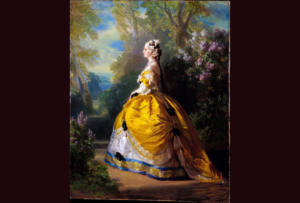
The desire for wider skirts… … demanded innovation, and so the tiers became flounces, as illustrated in the change in size and shape from 1848 (left) to 1850 (right) according to Godey’s.
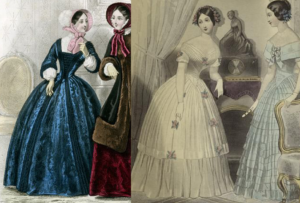
More tiers, more flounces mark the late ’40’s.. .. which were leading up to something. They wanted bigger, and bigger, and wider domes, but were not.. quite.. sure how yet.. but the Parisian designers had something up their… sleeves? No.. skirts.
(Godey’s fashion plates left show the 1848 tier in attempt to get bigger, was made even more elaborate in 1850 (right))
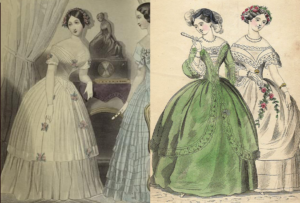
By 1848, something HAD to be done to get the shape… .. of the skirt. There were only so many tiers and ruffles one could add without the weight of them smashing the petticoats below, and defeating the whole point of making a giant, domed skirt.
When Victoria’s buddy, Empress Eugenie of France introduced her to the “crinoline”, the world was introduced to it too.
(See the 2017 blogs about Eugenie. Here she is surrounded by courtiers, also in crinolines in 1855)

The word “Crin” means… … Horsehair in French. Use of the word “crinoline” in describing the new 1840’s undergarments suggested that horsehair was used to give it stiff shape.
At first horsehair was used in a strip as a lining hem, and then at the top of a sleeve to keep its shape.
(Left: horsehair petticoat 1850; Right: early crinoline hoop 1852)
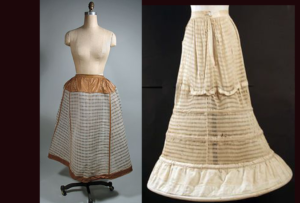
Later the word “Crin” meant… …by 1850 the word “crinoline” meant the whole of the beehive shaped skirt. Later, the cage hoop or support framed petticoat would also be called “crinoline” or “crinoline hoop”.
(1852: reproduction tape and wire crinoline hoop and day dress reproduction of Victoria’s favorite plaid)
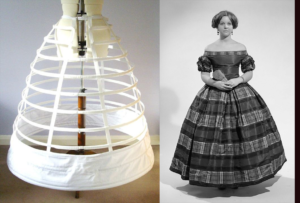
An American patented a cage frame… … (hoop, crinoline) in 1856. W.S. Thompson invented the steel frame cage and marketed it throughout America and Europe. It freed women of the weight of petticoats, although they kept a petticoat to go over the frame so the metal bands wouldn’t show through the dress.
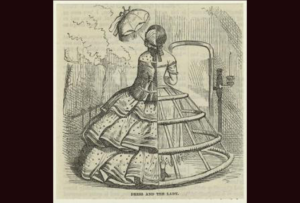
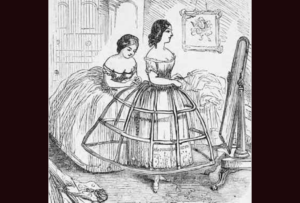
Women’s legs could breathe in 1856.. … without 6 layers of petticoats, and they could move freely underneath at last. Unfortunately, a hoop could blow up in a gust of wind. Fortunately women of every class and age had been wearing drawers for some time.
Cartoonists loved the crinoline, and most of our knowledge of them comes from satire like this one from 1856.
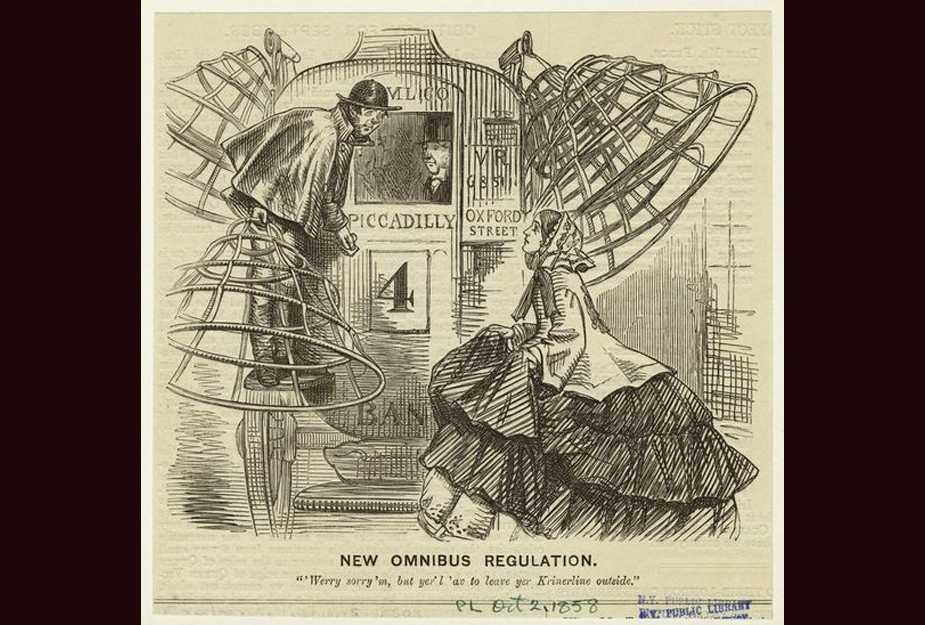
Women looked like they were wearing beehives… .. as the crinoline hoop made a giant, rounded and gigantic dome. Petticoats were cut to match the domed shape.
Freed from the excess petticoat weight of the 1830’s and ’40’s, women of the mid and late 1850’s had a bouncy spring in their step.
Cartoonists were having a grand time.
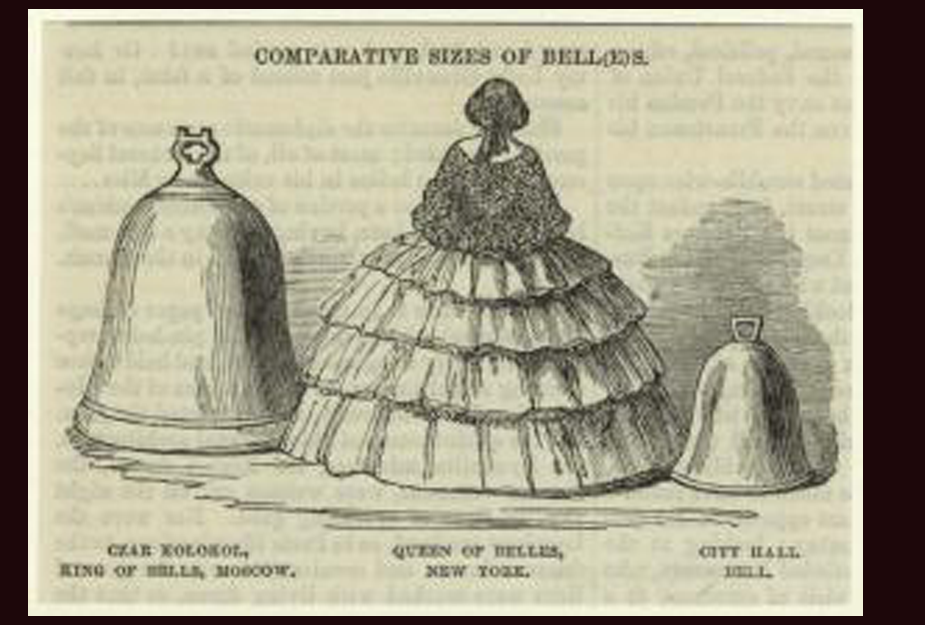
Through the 1850’s, the beehive became… .. flattened a bit in the front so it was less domed, and more of a pyramid by 1860. There came many versions of it that were articulated (folding), and constructed of a variety of materials, although the steel cage remained the most popular.
(Photo: late 1850’s reticulating hoop translates to the 1865 shape of Princess Helena’s day dress with the somewhat flat front and full back.. though at both timeframes both the symmetrical and the flat front versions were worn)
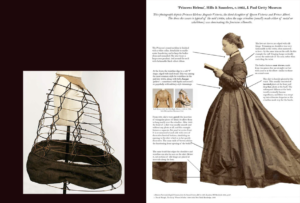
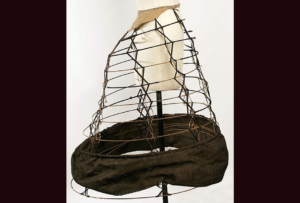
The difference between early 1850’s and… .. late 1850’s could be seen in the shape of the skirt (and the tiers). In these photos of Queen Victoria, left we see the 1851 shape with multiple heavy petticoats, and right the 1861 larger and lighter shape made by the crinoline hoop.
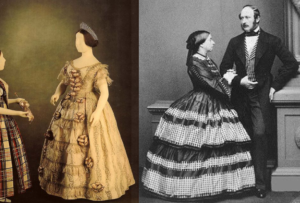
The lovely shape we equate with the Civil War… .. .began with the steel hoop of 1856. Here, Princess Alice of Hesse wears the newly introduced 1857 hoop under her bridesmaid ensemble.
NOTE: a wonderful portrait painter of the era, Franz Xaver Winterhalter, is responsible for documenting the high fashion of many European royals and their families.
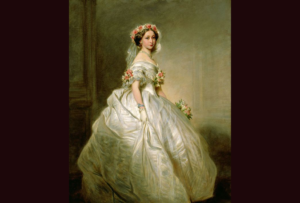
A deadly trend that went alongside hoops… … was the newly invented green dye, made with arsenic. Cartoonists had fun with this too, although it wasn’t fun in 1862 when anyone who touched the sweat of the wearer such as a dance partner, died of arsenic poisoning.
Slippers and gowns were made of it, and even after the dangers were known, women still insisted on wearing them!

We can now date this dog… … to 1857 or ’58 based on the skirt shape, size, and apparent lack of petticoat and lack of tiers (which would indicate 1855-56), even though it’s hard to see the bodice and sleeves which would normally help pinpoint it more exactly. The hair and hat places it in eastern Europe, perhaps Holland.
The dog appears to be timeless.
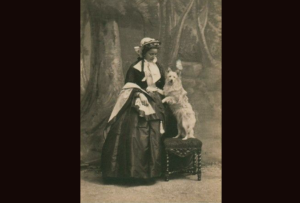
Shoulder lines of the early Victorians were… … very low. In the 1840’s-1860’s, women filled in the open neck for daily wear.
Fashion Plate from 1845: low neckline and exposed shoulders for evening vs. all covered up for day wear
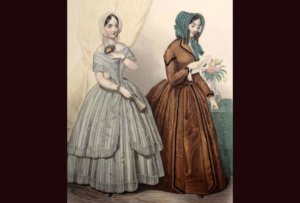
A “Bertha” was a style of… … neckline worn in the early Victorian era for evening wear. A “Bertha” totally exposed a woman’s shoulders, so they often trimmed it with 3-6″ of flounce or lace, or draped it with many horizontal bands of fabric pleats.
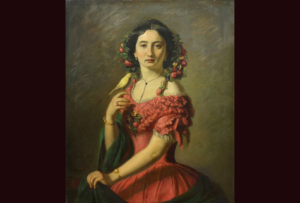
There were beautiful and innovative necklines… .. using pleats, tucks, flounces, and ruffles on the “Bertha” dropped neckline of the 1840’s and ’50’s.
(1845 silk gown with innovative pleating on the “Bertha”)
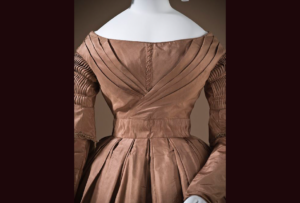
Royalty embraced the “Bertha” style.. .. and applied the ornament to Court fashion. Evening wear was reserved for the wealthy and elite as this era had much conspicuous class disparity, particularly in Europe.
(1851 Princess Charlotte of Belgium sports the newly introduced hoop, low ‘V’ waistline, and “Bertha” neckline with lovely vertical pleats and lots and lots of lace from – you guessed it – Belgium!)
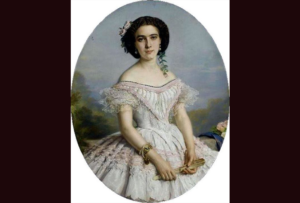
Some Royals preferred simple necklines.. .. and complex sleeves. The neckline and sleeve combination gave a horizontal “winged” appearance which was meant to make the neck look slender and long and expose “creamy breasts” of the ideal woman.
(Portrait estimated 1840, the wife of the Hungarian ambassador to England looks like she has a long neck, but you can tell she’s not comfortable with so much skin exposed as she has completely covered it with a thick necklace. Not everyone in the Early Victorian era wanted to show everything, but they did like to be considered fashionable, as fashion was a symbol of status)
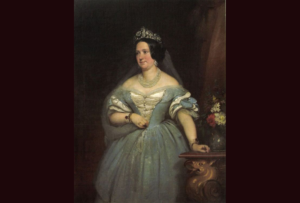
By 1858, Eugenie of France had taken the neckline… … to a whole new level of ornamentation. Empress Eugenie of France and Queen Victoria of England would ‘duke it out’ to be top of the fashion world as they were close friends and fashion fanatics.
Eugenie had introduced the crinoline hoop to Victoria, courtesy of her Parisian designer Charles Worth who was actually an Englishman.
(Eugenie’s “bertha” decoration in 1858.. some say this portrait is Anna of Hesse, but we’d know that Eugenie style anywhere!)

Queen Victoria’s necklines were.. .. actually quite sedate and tailored for the time. She loved the Scottish plaids and English florals, and used them in rich fabrics woven by Englishmen.
(One of Victoria’s 1851 evening gowns)
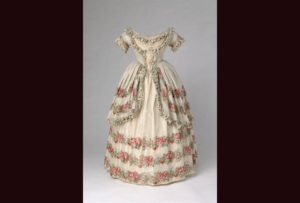
Even at an historical costume ball, Victoria.. .. had to be in the current fashion. In Queen Victoria of England’s 1851 costume for Empress Eugenie’s “Stuart Ball”, she has the Bertha style (daringly low for Victoria) beautifully adorned with English lace. It has the 1850’s shape, waistline, shoulder line, and overall silhouette.
Her nods to history are the gorgeous tapestry like fabric (possibly authentic from the 1700’s?). narrower sleeves with lace cuffs reminiscent of the Georgian period, and the flower center front. She’s trying to give the idea of having a stomacher and fichu, but it still looks quite “Early Victorian” to us. Why not a stomacher with a costume we ask?
Most likely Victoria didn’t want to give up her waist cinching corset. She was getting a bit wide in girth by 1851.
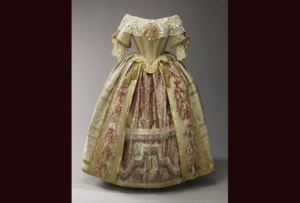
All this skin exposure was restricted to.. .. middle and upper classes. Victorian working class women would never reveal so much flesh. This meant the shawl had to become an essential feature of dresses.
(Portrait by Lepoitteven: “Farm Girl at Toilette”)
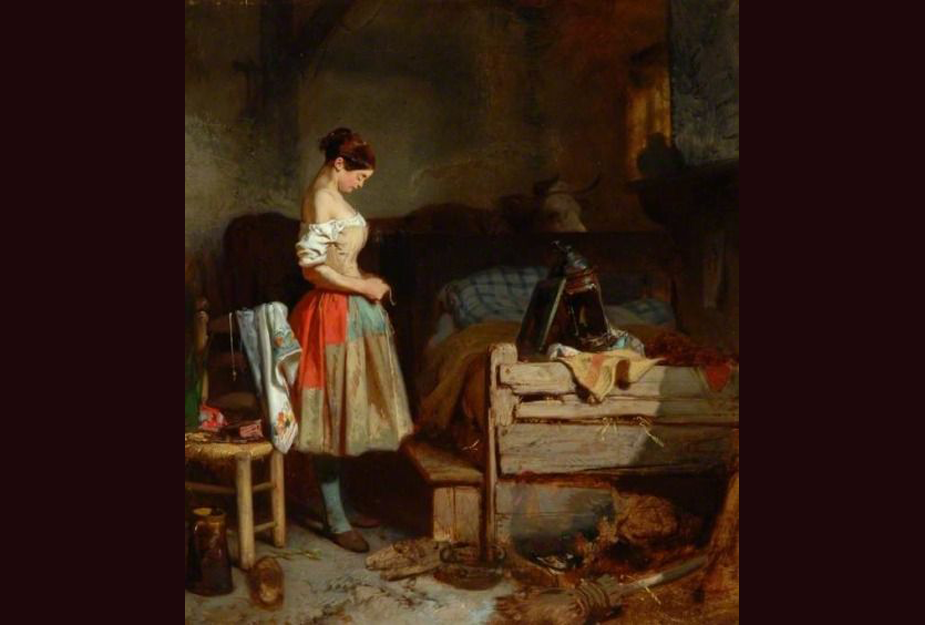
ondering how they got into these clothes? Satire and portraits of the day tells the “real” story. Wealthy and middle class women had servants and maids to lace and dress and button and adjust. The rest of the world had.. each other!
(Portrait: working women help each other lace in the 1830’s)
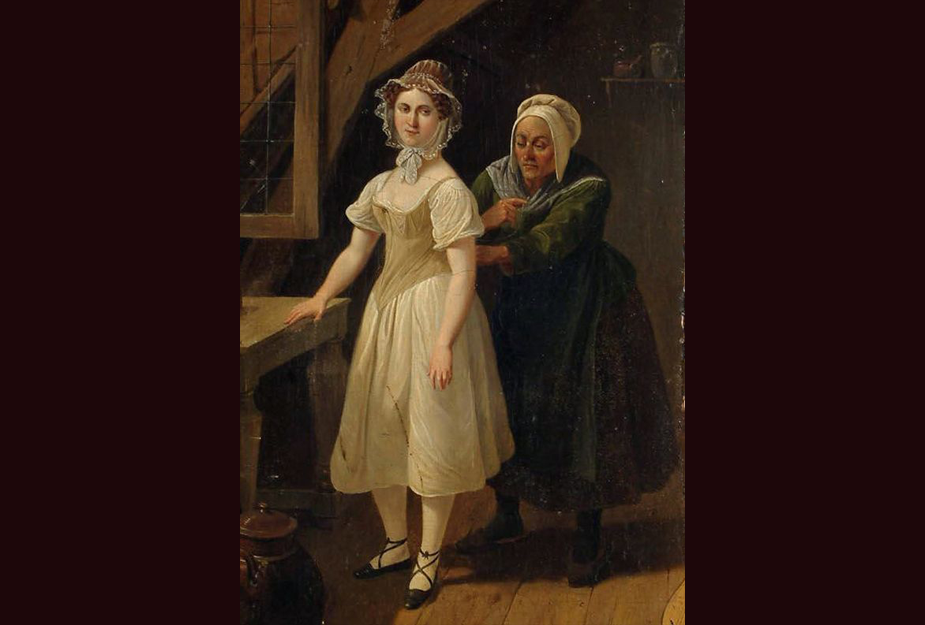
ictorian women lived with other women… … lower class families lived together or nearby. Grandmas were there to help little ones; women understood the needs of each other to make adjustments for periods, pregnancies, and health issues.
For those who struck out on their own and dared to live with just their husbands, cartoonists of the 1800’s assumed it was the newlyweds who worked out the lacing. For a man to admit to this would reduce the boys “at the club” to tears of laughter and a loss of face.
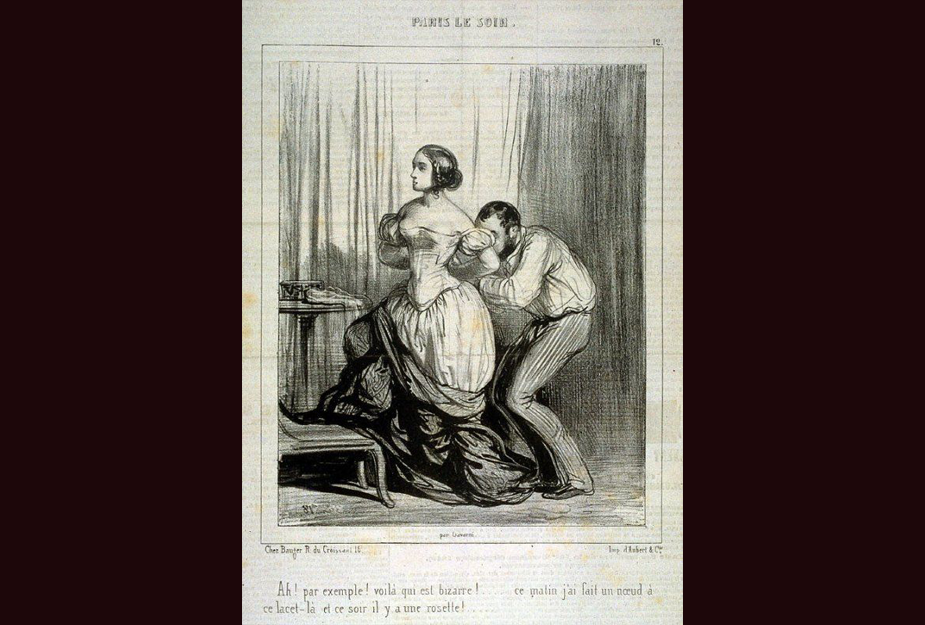
With the new Victorian bodice… … and the skirts and bodices separated in the early Victorian era (started 1937), a tighter waist could be achieved. The “robe”, or the “little white dress” of the prior Regency era had evolved into a “dress” made of bodice attached to skirt. The fashion for 2 piece ensembles would last until about 1908, with the exception of rural dresses of the 1880’s.
(Day dresses 1823, 1837, 1848. Oh what a difference a decade makes! Regency with it’s high waist, single construction, natural waist, becomes cinched waist and huge top and bottom of early Victorian)
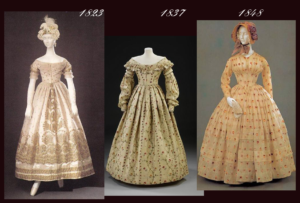
The hourglass silhouette.. became the ideal early in the Victorian era. By the 1850’s, the wide shoulders from the “Bertha” neckline, combined with the huge width of the hips with the crinoline hoop, meant the only thing remaining to get the desired silhouette of the era was to bring the waist in to be as small as possible.
(Portrait: The Robinson sisters of 1848 in the most current fashion of the day)
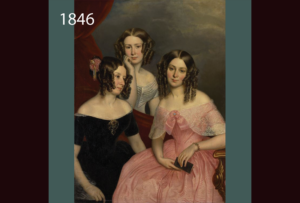
Corsets & The Victorian Hourglass Shape
That Victorian waistline came from… .. a corset of course! The invention and application of metal grommets in 1822 made the tightly cinched waist possible. Prior to that eyelets were made by hand with metal ring reinforcements and whip or buttonhole stitching.
(1825 Handmade eyelets with whip stitching on a nursing corset)
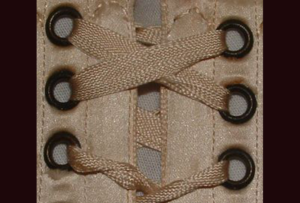
A grommet for a corset is… .. a ring made in two parts, “male” and “female”. A hole is punched through all layers of fabric. The female part is on one side, and the male part goes through the fabric. Since the male part is slightly flared, a grommet machine or tool is like a pair of specialized pliers. It “crimps” the male and female together, folding the male part into the female.
(Modern day brass and aluminum grommets are not strong – but they don’t rust either!)
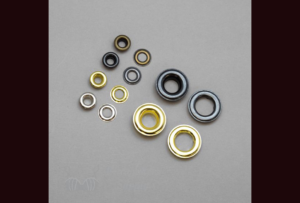
Eyelets on corsets continued into the 1830’s even though.. …the metal grommet had been invented in 1822. As with any new technology, there was some doubt as to it’s effectiveness, and women trusted what they new. The metal grommet was really not effectively applied until 1828.
(In 1829 women still liked their handmade fancy work and hand sewn eyelets, especially on areas that didn’t carry stress like the hip gussets of this late Regency type corset of ’29)
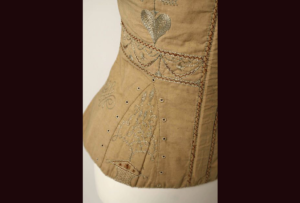
Early 1820’s metal grommets were not… strong or durable yet, but they were stronger than hand sewn eyelets! Corsets were not yet capable of tight cinching in the ’20’s and ’30’s.
Of course, that being the late Regency period, most corsets were only used for smoothing and slimming, and many were corded, not boned, so there was no need for more than “gentle lacing” of the bodice or corset.
(And 1830 approx. corded (strings run through channels instead of metal or bone) wedding corset with the new and improved metal version of grommet.. which rusted)
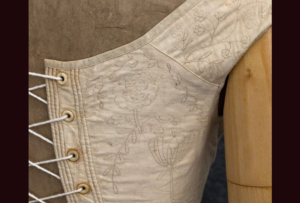
The new and improved grommet was made of.. .. steel! In 1856, inventor Bessmer applied new technology to the teeny rings. By this time, women were trusting the metal grommet, and were open and willing to try a new type of metal.
(Featured the new steel grommet on an extant corset. Below, a late Regency/early Victorian corded instead of boned “light” corset with old fashioned shoulders and early metal grommets – the shoulder straps and light boning would die quickly in the late 1830’s)
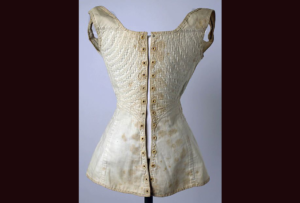
The “Wasp Waist”.. .. recognized in the US as the Civil War Era fashion, was the result of the metal grommet which got smaller in diameter and stronger and less rusty as time went on.
(1864 tightly cinching corset – the ideal shape and highly innovative structure of the day)
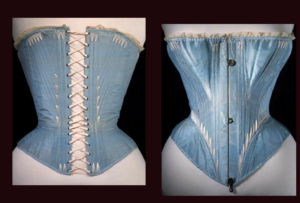
By the end of America’s Civil War… .. women of legend, like “Gone with the Wind’s” Scarlet O’Hara, were aiming to achieve 13″ diameter waists.
(Photos: the 1864 corset makes the 1864 silhouette)
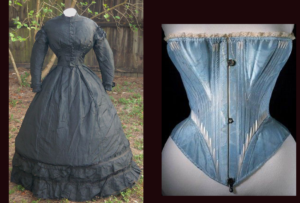
On record the smallest waist was.. … 33 cm (12.99″) set by Ethel Granger of England in the early 1920’s due to her husband’s obsession with corsets and piercings. She also pierced her nipples, nose, and had huge piercings in her ears.
(Ethel Granger’s 1920’s 13″ waist when she set the record.. and Ethel about 10 years later)
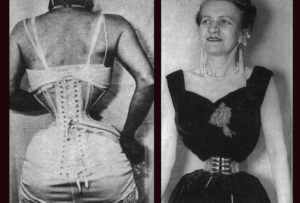
Ethel made it to Vogue Magazine years later… .. in the 1930’s, long after corsets had been tossed out in favor of the new brassiere and girdle invented late in the 1910’s with the application of rubber for apparel at the time of WW1.
Here Ethel poses for the world in an odd combination of many fashion eras.
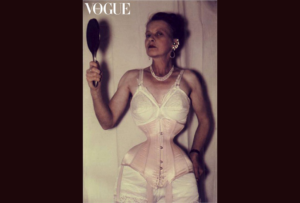
While corsets were out of style by the 1920’s… … a few women copied Ethel’s “wasp waist” . Cathie Jung now in her late 70’s, began her obsession with corsets in the the 1960’s. She set the record in 1999 which still holds for the smallest waist of a living person at 13.91″.
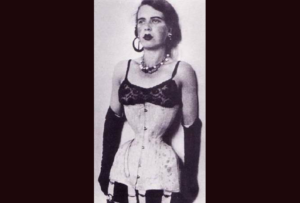
Cathie Jung today holds the record.. .. of the smallest waist of a living person at just under 14″. Scarlett O’Hara would be jealous.
While there are some drag queens approaching the number, it’s not a fair contest since the organ structure of men is different than with women.
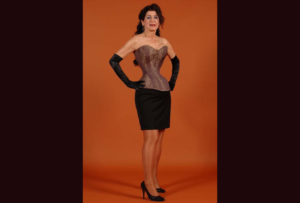
This is what is really happening in a Wasp Waist… … Victorian tight cinching grommeted corset. Women wore them from age 10 up, and throughout the 19th century, they wore them night and day. The night corset was a bit gentler, but they had to wear them or their organs would move back into position which could be – and was during childbirth – deadly.
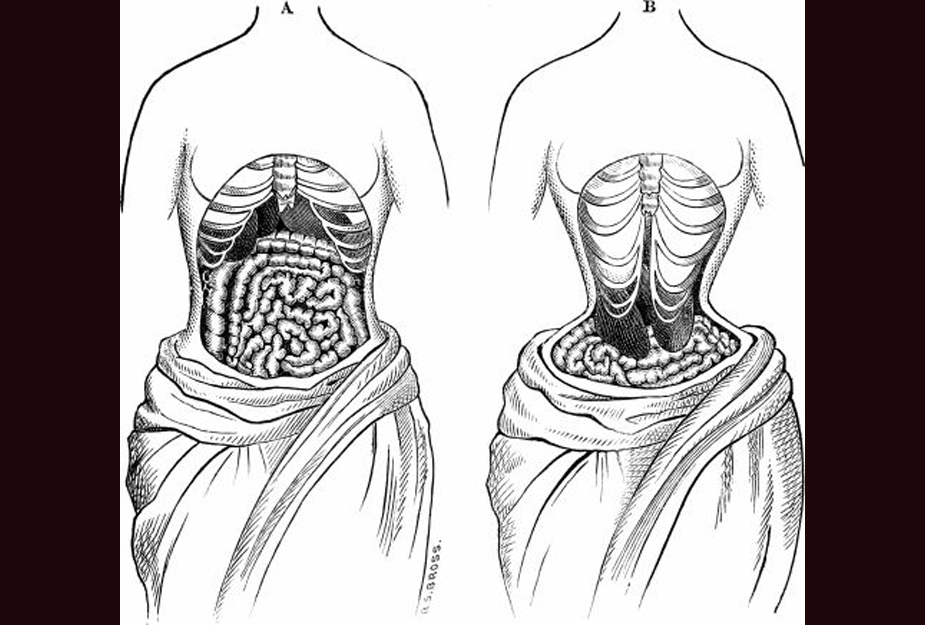
Today, Victorian waist-cinching corsets… … and metal grommets are used in innovative ways. Corsets are typically worn on the OUTside of the body as decoration and not for shaping (except the odd and rare person who tries to achieve odd and rare things).
(photos: Today’s metal grommets)
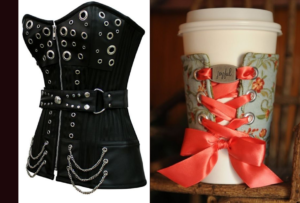
arly Victorians used the corset, huge skirts, and… …large sleeves to make that giant “hourglass with bell” silhouette. The Engageante false undersleeve balanced out the effect of the cage crinoline or hoop. They too looked like bells.
(Dogs are back! Here’s an early 1860’s woman with engageantes and a dog who doesn’t care about her sleeves at all).
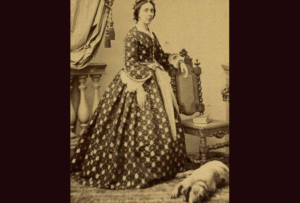
Engageante sleeves were made from… …fine lace, linen, cotton lawn, cambric, or Broderie Anglaise (cotton with holes that have been embroidered around), were easy to remove and launder.
That’s why they were white. (Plus after romping with a wet dog, they could be dried quickly).
(Photo: Museum quality 1860’s engageantes not on a person with extensive embroidery on white cotton lawn)
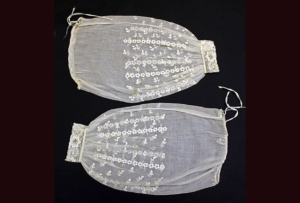
Victorian huge sleeves of course were… … introduced by Queen Victoria to the public, although they had been worn in the 18th century. They were not a Victorian innovation. American women had long ago figured out the advantage of wearing a washable cap, sleeve, and outer petticoat in the way today’s women would wear aprons to protect them from splashes, spills, and muddy roads.
(Photo: early 1860’s shows a casual Victoria with her daughter, looking like a working woman with her sleeves rolled up; her egageante sleeves, that is.)
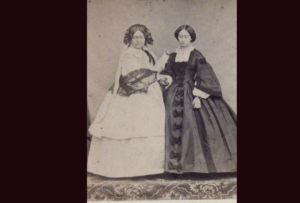
Victorian huge sleeves of course were… … introduced by Queen Victoria to the public, although they had been worn in the 18th century. They were not a Victorian innovation. American women had long ago figured out the advantage of wearing a washable cap, sleeve, and outer petticoat in the way today’s women would wear aprons to protect them from splashes, spills, and muddy roads.
(Photo: early 1860’s shows a casual Victoria with her daughter, looking like a working woman with her sleeves rolled up; her egageante sleeves, that is.)

Royalty around the world wore the sleeve… … so functional, comfortable, cheap, and making women look huge.
(Photo: Princess Maria of Prussia wears engageante sleeves in this casual portrait. By the 1860’s, portraiture was more comfortable for people, but it was still mostly the wealthy, elite, and royal who could afford it. Beatrice, Queen Victoria’s daughter, had her own darkroom at the palace during her adult years. We believe the many casual and captured moments of Queen Victoria must have been photographed by her daughter in private).
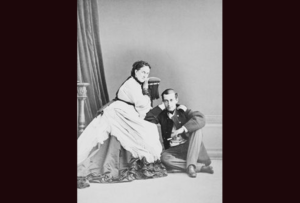
Some Victorian women would do anything… .. to get the look of the egageante huge sleeve. In this, what might be set up as a joke between photographic shots, an early Victorian woman uses umbrellas instead of fabric to create the giant look of the sleeve of the day.
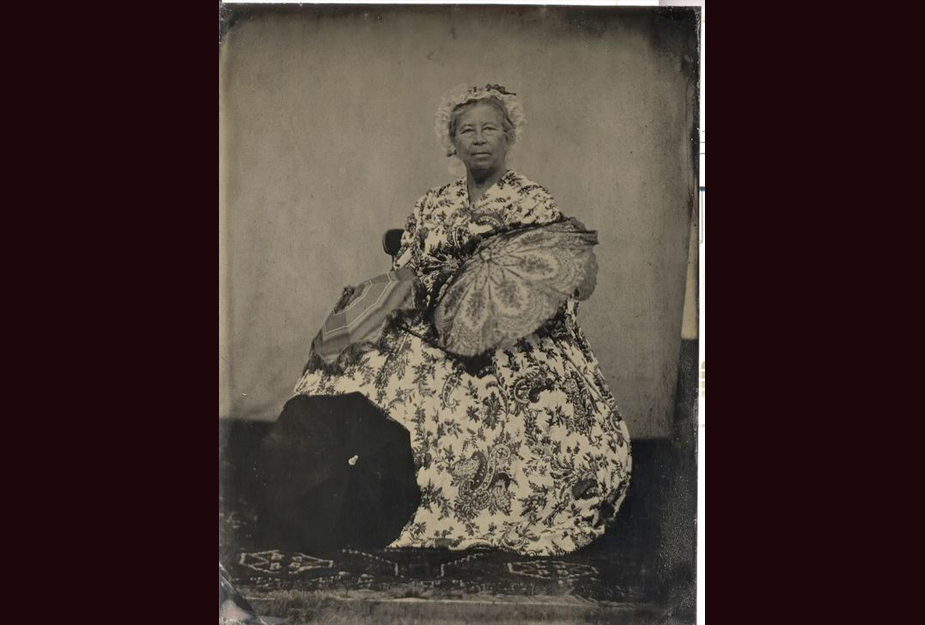
High fashion designer Charles Worth… … an Englishman who established a fashion house in Paris in the mid-1850’s, and was the key creator of the many types of sleeves we will discuss through the entire Victorian era. His son would continue creative designs into the 20th century.
Worth was a favorite of the French empresses and English royalty. He was responsible for the crinoline as a part of high fashion and the engageante sleeve.
(A worth design sketch from the mid-1860’s)
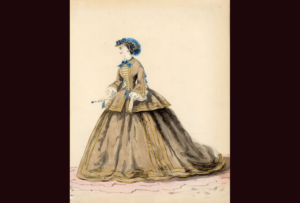
Which eases us without fuss into the next… … Mid-Victorian era. It is difficult to establish where one starts and one stops – an actual dilemma with fashion history as a whole. Just like us today, women wore their favorite out-dated fashions long after new ones were introduced. It might take a long time for women to learn or be able to obtain a new style.
There were not distinct lines saying “this is fashionable now”.
What women wore depended on what was available, affordable, and possible given the information at hand.
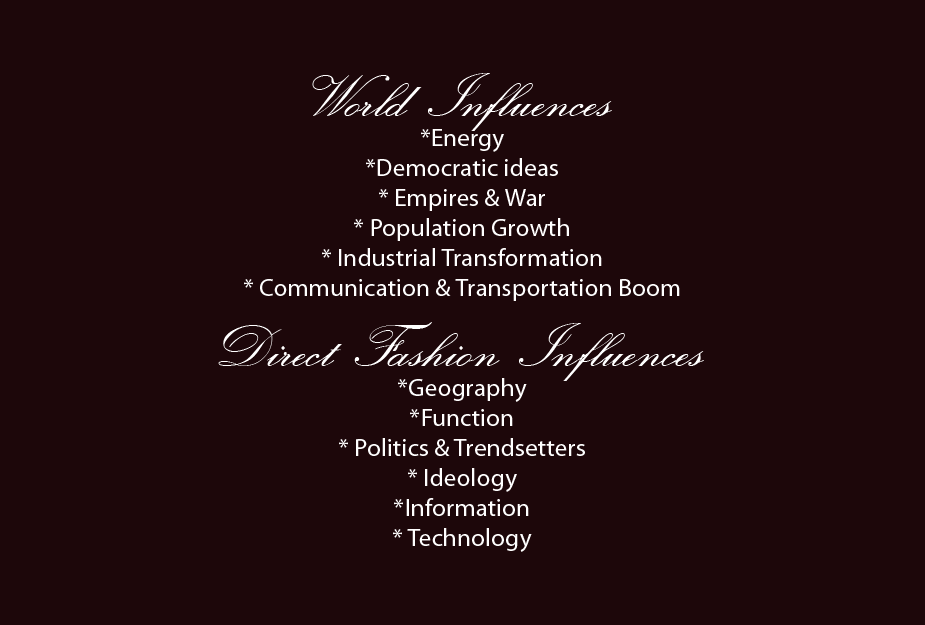
Factors Defining the Difference between Early and Middle Fashion Eras
Mid-Victorian Fashion according to historians started.. … in 1860 and lasted until 1880. There were four significant changes and factors they say made a distinct “line in the fashion sand” between the end of the ’50’s and the start of the ’60’s. These affected the silhouette, construction, design, and presentation of women’s clothing.
(1865 to 1900 silhouettes: Mid to Late Victorian)
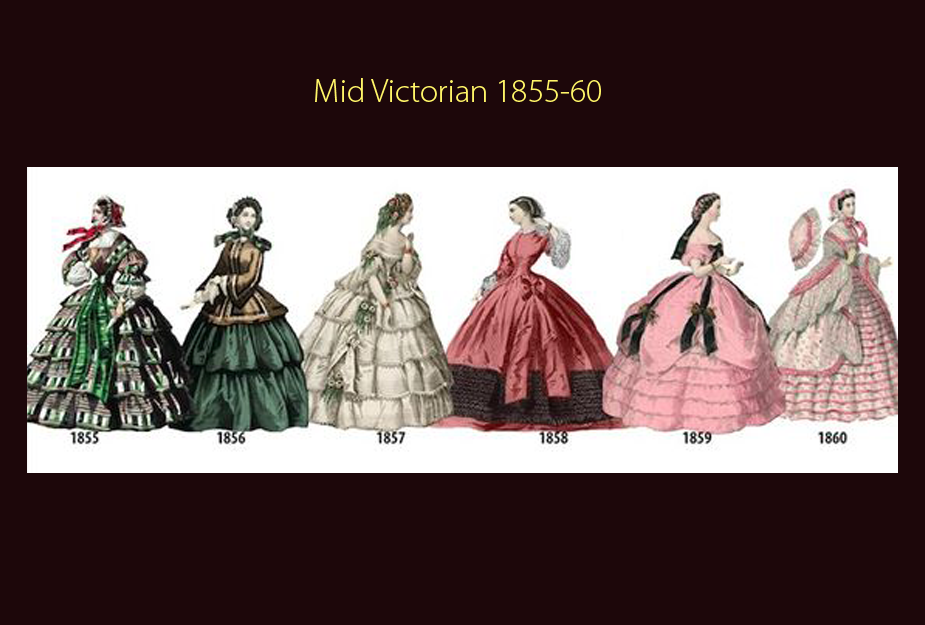
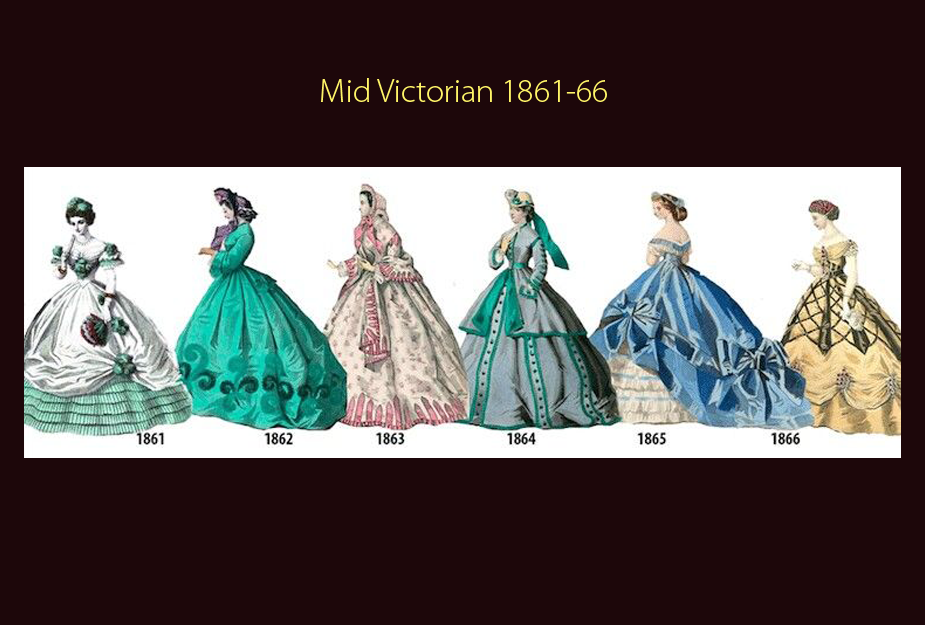
1. Invention of the Home Sewing Machine
The first thing that moved Early into Mid Victorian… … was the invention of the light weight, home use sewing machine. In 1851, Singer had taken the heavy industrial, stand up models that the textile industry was using, and made it gentle and delicate enough for use by the general consumer (as opposed to factory workers).
Putting little stores in different towns, he also invented the franchise or multi-shop concept.
(1851 advertisement for Singer. Note the voluminous ensemble of the older and larger woman)
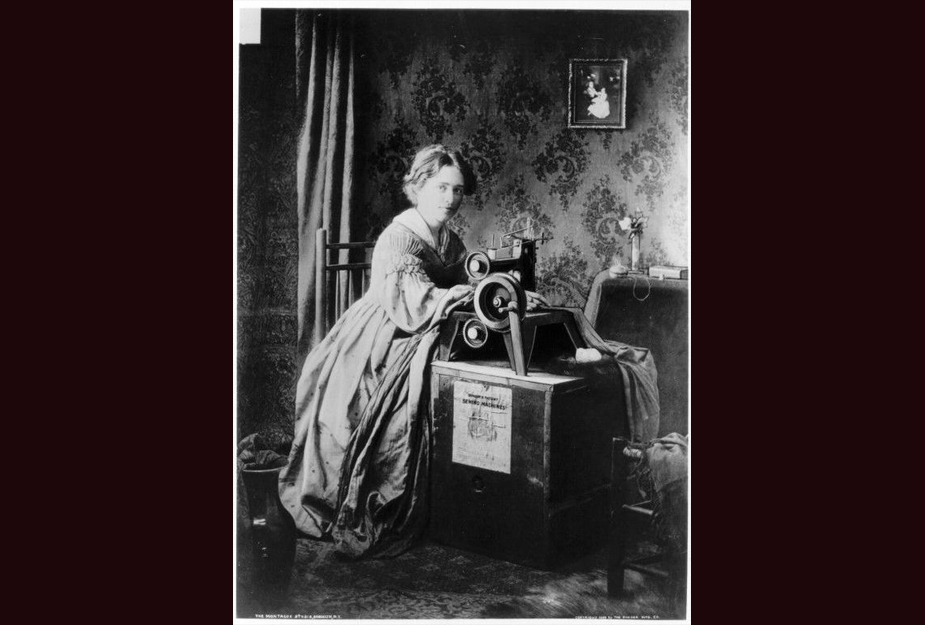
The concept had been around for many years, but the ability to use a model for every day women or “light” sewing in industry had eluded inventors. In 1755 German Charles Weisenthal patented the needle that would lead the big, heavy industrial machines of the past into functional and diversified pieces of equipment.
In 1804 Frenchman Thomas Saint with James Henderson and Scott Duncan developed “embroidery machines” building on the Weisenthal model.
(Photo: Weisenthal left with the Thomas Saint 1790 machine which built upon the Weisenthal needle concept)
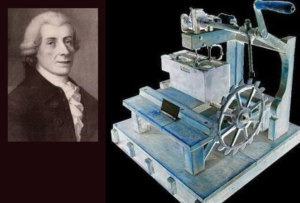
Early sewing machines, 1st reason Victorian.. … eras switched from “early” to “mid”, continued with the 1818 John Adams model.. and the same thing being developed by Doge and John Knowles – which all completely failed.
(Photo: an early model industrial machine for punching leather)
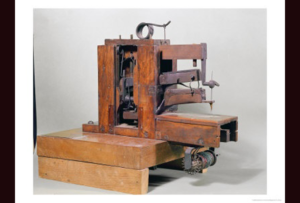
The 1830 Thimonnier sewing machine… … was the first success at building a functional and lightweight model that could be used in homes and light industry! Built by French tailor Bartholemy Thimonnier, it had a hooked needle like one uses to crochet now, and could make an embroidery-like chain stitch.
The problem was, other tailors burned down his factory and nearly killed him. They didn’t want a machine that might replace them and their hand sewing techniques.
(Photo: Thimonnier and his 1830 machine)
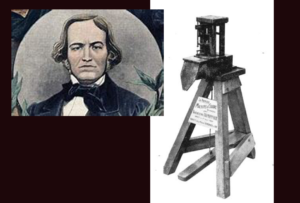
Americans made pretty good sewing machines… .. Walter Hunt made one in 1834 that built on the successes of those who came before him, and it didn’t have to do a chain stitch, but could sew a straight line. The problem was he never patented it because he was afraid American tailors would try to kill him as the French had Thimonnier.
At the same time, American Elias Howe (yes THAT Howe of steam engine fame) bravely built on the Hunt model and improved it using a needle with an eye on it that could make a “lockstitch”.
(Photo: Elias Howe and his 1840 model lockstitch sewing machine)
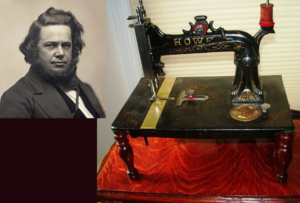
Lots of sewing machine inventors… .. stole the Howe and Hunt ideas and continued to build upon them and improved the concept. Early machines like Howe’s moved back and forth to sew.
It was Isaac Singer who made the big step for home sewing by inventing the up and down mechanism we know today.
(Photo: Other inventors sold machines in he 1840’s and 1850’s including this Raymond brand that came from a cabinet company)
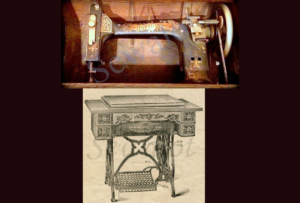
Elias Howe had the 1846 sewing machine patent… .. which took 5 years in development. Howe, from Massachusetts originally, was an educated and specifically trained (post “high school”) machinist who worked for a company that made and repaired precision instruments. He heard about the sewing machine as they were repairing some of the early types, and decided he wanted to make one that could really work.
His first one, which got the 1846 patent went sideways.
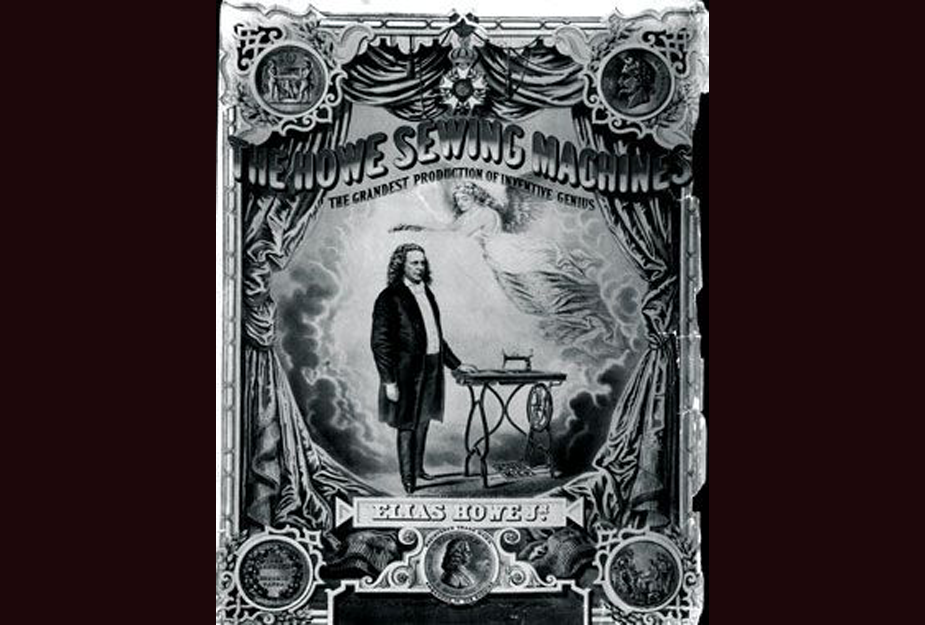
In 1851 Isaac Singer improved the Howe sewing… … machine concept to make the machine scaled for home use, and to make the needle go up and down instead of back and forth.
Patent wars followed between Singer and Howe among others. Singer prevailed and got the rights to the patent until 1854 when Howe took it back legally. Singer had to pay royalties for not only the years between when he had “stolen” the patent, but forward for as long as the patent was in use.
(Sketch: Howe demonstrates his 1846 invention during legal presentations to determine patent ownership)
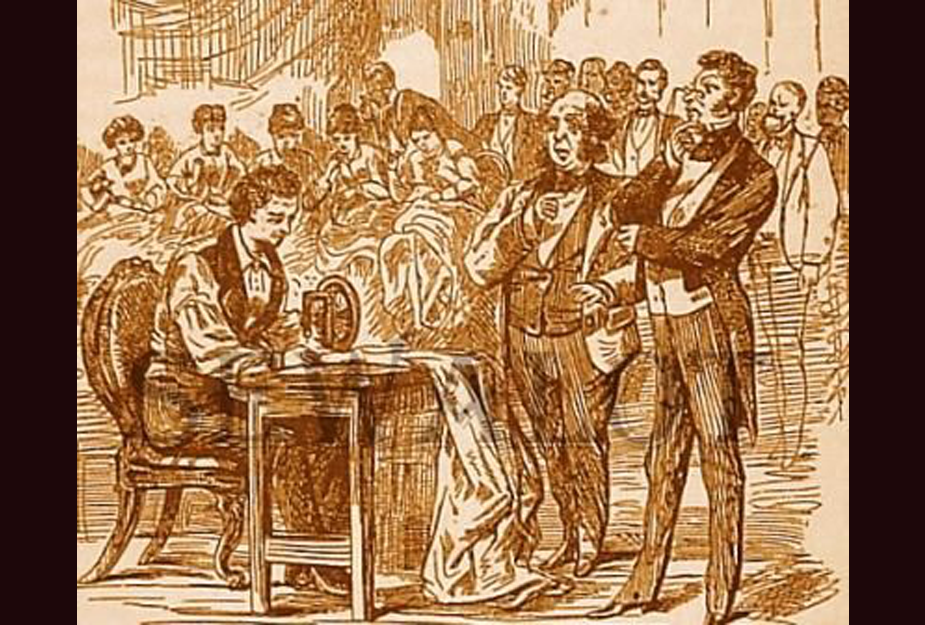
The Singer sewing machine was… .. so very successful, that Singer, required to pay Royalties to Howe for the patent, ended up paying enough money that Howe was able to finance a whole Union regiment in the Civil War.
(Picture: Live demonstrations of the new models were the marketing method of the choice in the 1850’s)
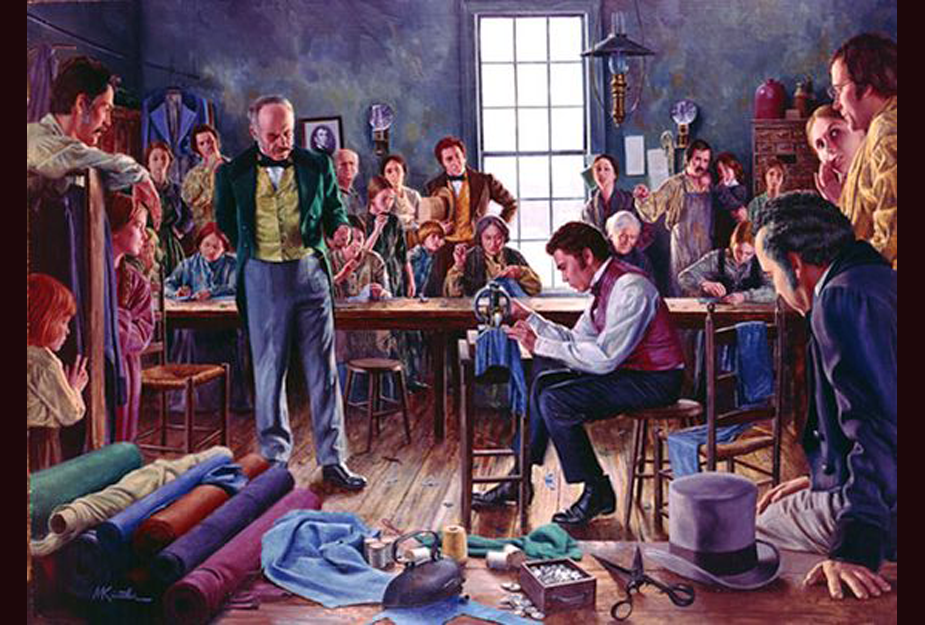
1856 saw sewing machine patents for many companies.. … Howe, Singer, Wheeler & Wilson, Grover & Baker to name just a few, but by 1900 the Singer company held 90% of the world share due to shrewd marketing, multiple franchise shop placements (a new business concept), and continued development of a quality machine.
(Ad: The 1900 Singer Sewing Machine)
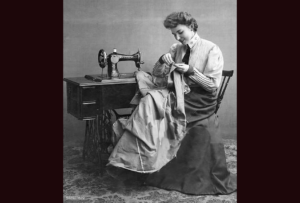
Isaac Singer of sewing machine fame was quite a character… .. He was first an actor, who invented a rock drilling machine. He improved on it to be able to carve wood and metal, and accidentally came upon the world of sewing machines when he went marketing to stores which sold small precision machines.
The store sold Lerocut and Blodgett machines which were similar, and Singer looked them over and thought he could make a good sewing machine. He built his based on the Howe model in violation of Howe’s patent, but was very successful in improving the design.
(Photo: Singer and a 1919 machine)
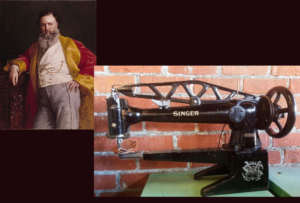
Singer sewing machines made Isaac Singer… .. rich. He went back to acting and had 24 children by 4 wives – 3 of them at the same time. He divorced his 1st wife, but the 2nd wife took him to court for bigamy. The court did not penalize him, but his reputation was gone, so he took one of his other wives/mistresses and ran away to England where he spent his days until his death.
He had built a mansion on 5th Avenue in New York at the peak of his success in the 1870’s for one of his families.. presumeably the 2nd wife and 2 children by her.
(Painting: Singer’s Oldway Mansion in New York City built in the 1870’s)
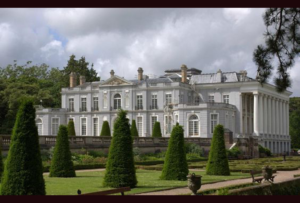
Singer of sewing machine fame built another mansion… … in England during his “exile” (running away) in 1875, but he never saw it completed. His son altered it in 1907, and it became the Torbay Country Club in 1929. During WWII it was used by the Royal Air Force, but has been otherwise empty since 1913.
When Isaac Singer died in 1875, he was 63 years old, had 24 children, 4 wives, and was worth $13 million.
(Photo: Singers’ “Wigwam” estate in England that he never lived in)
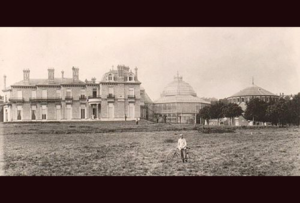
Meanwhile, the sewing machine continued… .. to be improved and advanced in technology. The reciprocating shuttle had been invented by Allen Wilson in 1851, but a big change came with Helen Blanchard’s invention of the Zig Zag in 1873.
Helen was from Maine, and had already invented “hat-sewing machines”, surgical needles, and other sewing machine parts and components, so it was only natural that she should change the industry.
With the Zig Zag, seams could be finished quickly to be very sturdy, and buttonholes could be made by machine.
(Photo: Helen Blanchard and her Zig Zag invention)
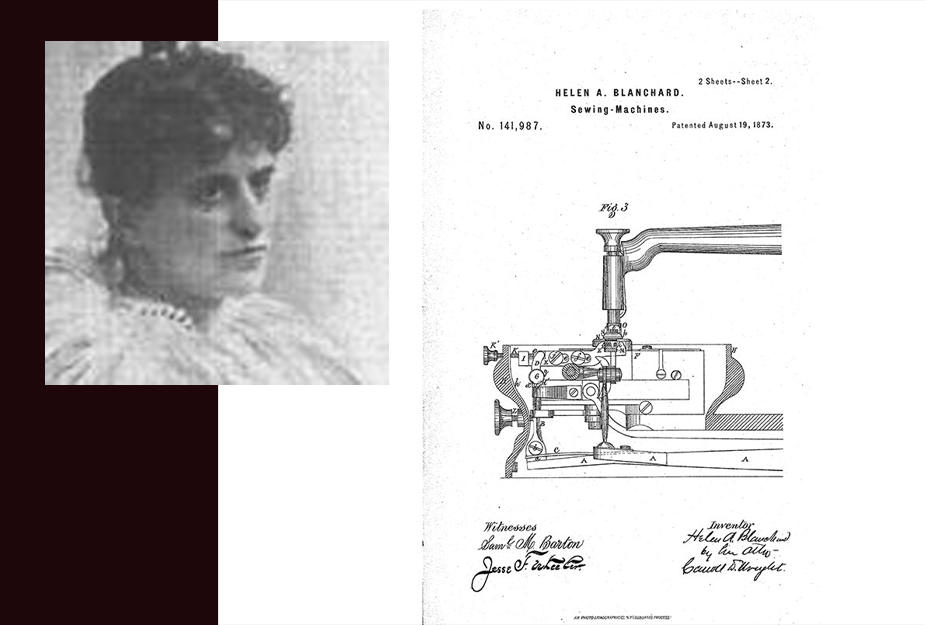
By 1889, sewing machines were common… .. in the home. The hand wheel had been replaced by the foot treadle by the 1860’s, and competition was hot between the many manufacturers, although Singer held the market share.
(Photo: Singer advertisement and sale of toy sewing machines boosted home sales in 1900)
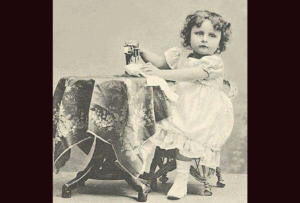
The machine that started Mid-Victorian era.. .. ended the Victorian era too, as home sewing and easy mass production with mass marketing and catalog sales worked alongside fashion designers to redefine Victorian fashion into Edwardian at the turn of the 19th into the 20th century.
(Photo: Singer ad looks more like High Fashion design marketing at the turn of the century)
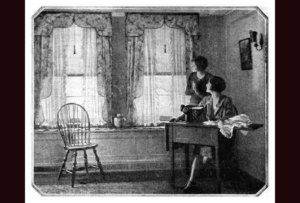
In 1905, the sewing machine.. … went electric. By the 1960’s, the world of home sewing had exploded like this Singer Model 500m plastic and electric “The Rocket”.
Plastics and digital technology would continue to develop and change the industry.
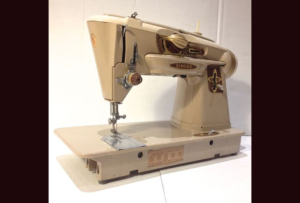
2. Professional Fashion Designers
Previous to the 1860’s, clothing was designed and built by tailors and seamstresses. Information was shared by the 1860’s through printed material and word of mouth; advertising.
Hand colored beautiful illustrations were available in high end Parisian generated magazines like Le Follet shown here from the 1850’s through the 1860’s.
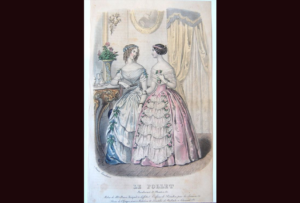
Periodicals available to American women… .. like Harper’s New Monthly Magazine told them what was being worn in Europe and around the world. Since this was the Mid-Victorian era, it was still Queen Victoria leading the way, but she was getting her ideas from her friends like Eugenie of France, who was getting HER ideas from the French designers.
(Harper’s from June 1860)
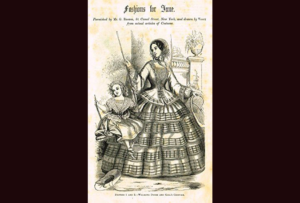
Beautiful portraits by artists like.. .. Franz Winterhalter showed what the elites and royals were wearing.
(1840 Portrait by Winterhalter)
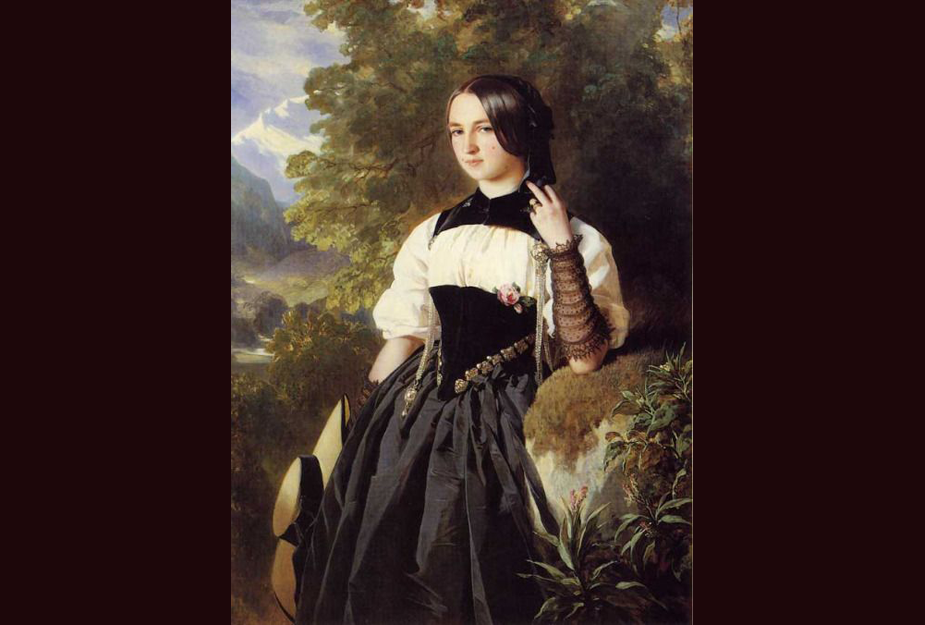
2a. Photography to communicate Designer Concepts to the public
Another influence was photography of course… … as fashion concepts were initiated by designers, promoted by queens and empresses, distributed through periodicals, and reinforced by photography.
(Photo: Early 1860’s dog-on-skirt)
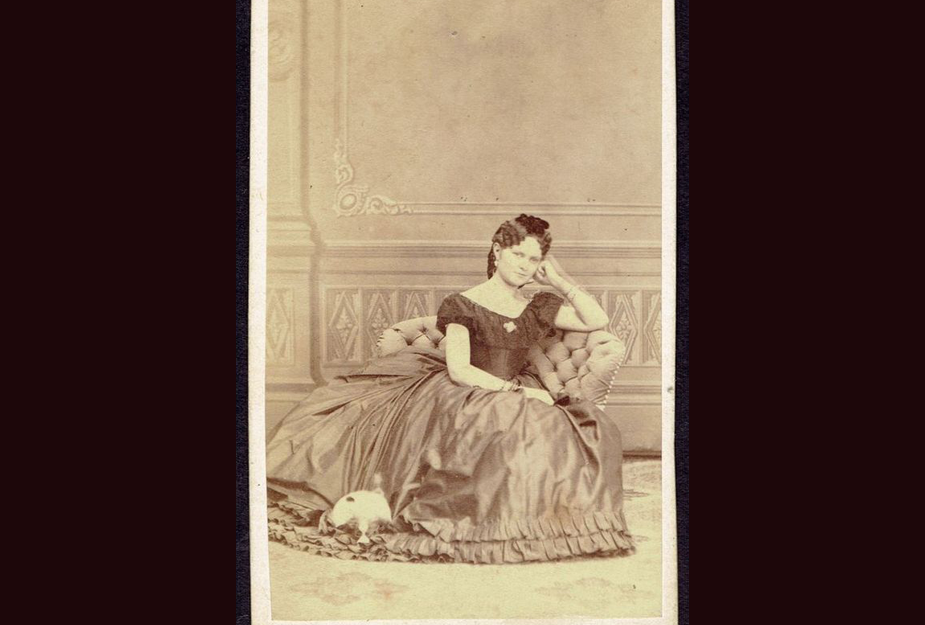
All these information sources in Mid-Victorian.. .. era.. emphasized the class structure and disparity (as discussed last month) as the rising merchant classes in Europe and America used fashion to define status. In fashion, royalty, class, status, and financial status was getting mixed up.
(1860 fashion plate showing the industrial merchant class mingling with nobility)
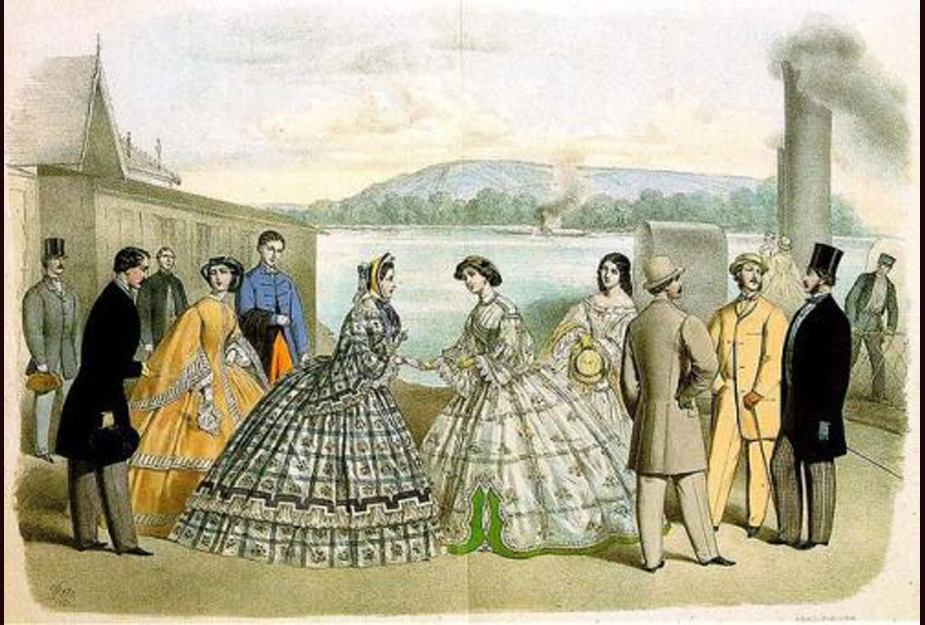
Fashion Designers arose in the early 1860’s… .. as an elite group. There were MANY of them which opened their “fashion houses” or “salons” in large cities, but they also traveled to special clients, especially if such clients would influence others and promote the new innovations.
We have in the fashion eras pages on this website in depth details on these designers and samples of their concepts, so we will only touch on them in brief here.
Top designers of note, because they influenced the top promoters of fashion in the beginning were: Worth, Hirsch, Manning, Minangoy, Redfern, and Vogels. There would be many more by the 1880’s (late Victorian).
Photo: House of Worth in Paris around 1900)
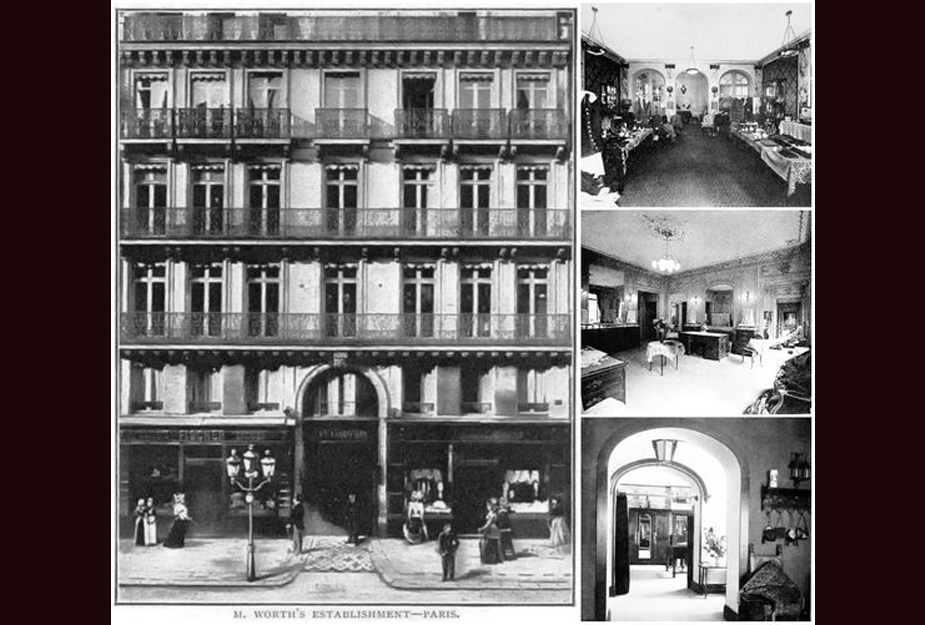
Hirsch & Cie, Victorian Fashion house in… 1882 …In 1882, Maison Hirsch & Cie opened its doors at the Leidseplein in Amsterdam – a fashion house, focusing on haute couture, that drew a client base ranging from Queen Emma, Queen Wilhelmina and Queen Juliana, to the famous dancer Mata Hari.
(Photo: Queen Emma of the Netherlands in Hirsch & Cie Court Gown in about 1900)
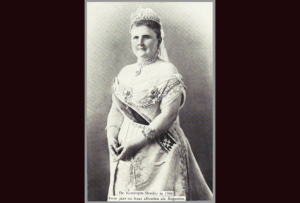
Mata Hari, client of Hirsch & Cie… … high fashion Dutch designers in Belgium, was an exotic dancer, courtesan (mistress to the Royals), and was alleged by the French to be a spy in World War I.
(Photo: Mata Hari in about 1912 in a Hirsch & Cie day ensemble. Note the use of lace and 3D flowers in the Hirsch designs; logical since the Netherlands in the early 1900’s led the world in the highest quality lace production – although Queen Victoria in England was having it duplicated for the English)
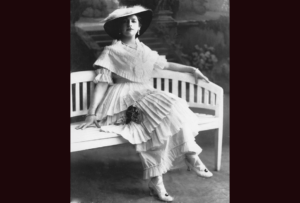
Mata Hari, seductress, courtesan, and… … alleged spy was executed by a firing squad in Paris.
(Photo: Mata Hari in what looks like “Jersey Lily’s” (Lily Langtry, same courtesan and seductress to the English royals) newly invented “jersey” bias wrap, in about 1905 is assumed to be a Hirsch & Cie design, although it does not carry their usual marks, but looks more like something from Langtry’s favorite high fashion designers Worth or Margaine LeCroix who developed the “Sylphide” (corsetless) live mannequins)
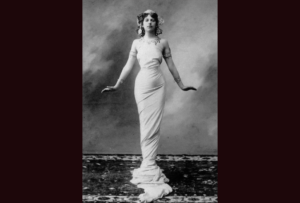
Brussels house of fashion Hirsch & Cie… .. mostly had clients from the Royal Court of Belgium. Although located and focused on Belgium, they won design awards in Brussels, Amsterdam. In the 1914-1930’s era they employed over 1000 employees. Hirsch & Cie designers’ fame was in gowns, coats, and fur trimmings.
(Hirsch & Cie design sketch for coat around 1900)
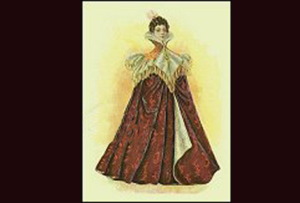
Ippy and Gertie were models… …for Hirsch & Cie Design House in Brussels. Twins, they were born in 1895, but at the age of sixteen, they were sent to London by their parents to broaden their education and to learn English.
The girls’ modeling talent was discovered when they went to work for Maison Lucile, an established fashion design company whose clients included aristocracy, royalty, and theatrical clients.
(Ippy – or Gertie? In a Hirsch & Cie ensemble in 1913)
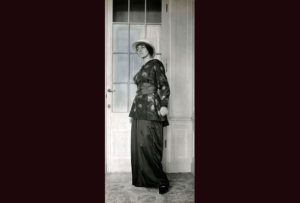
Hirsch & Cie models Ippy & Gertie… … were wildly famous, and worked with artists and photographers for the Design House as well as for fun and extra money.
While working for Lucile in Paris, Gertie got engaged to a French count, but he was killed at the beginning of the World War I. The twins decided to return to Amsterdam.
From 1916-1918 they rose to great fame in the world of modeling. It was as this time that Israëls made his many portraits of the twins.
(An 1893 Hirsch gown)
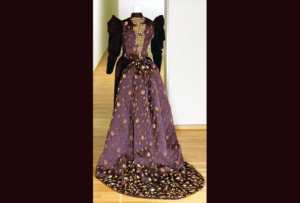
Ippy & Gertie, famous models also… .. acted in a minor role in a 1920 film. They faded from view in the new fashion era of the “Roaring 20’s”.
Both married and moved to live near each other in Amsterdam until Ippy died of a stroke in 1964. Gertie died in 1975.
(One of the twins in a painting)
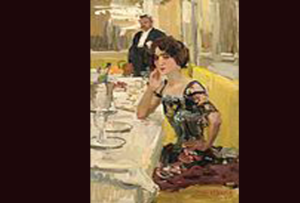
Famous painter, Isaac Israels loved Ippy & Gertie.. …the famous twin sister models (Helena and Geertruida Wehmann) of the Fashion House Hirsch in Amsterdam. He was a Dutch artist who was introduced to the fashion world and the girls by his friend Therese Schwartze who was a portrait painter.
(Portrait: Israeli’s most famous 1916 portrait of Ippy and Gertie)
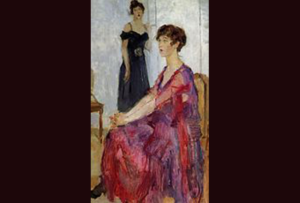
Israelis embraced the world of high fashion… …and went on to work throughout “haute couture” in the world of high fashion in Amsterdam and Paris. His ability to show the real world of fashion, rather than the glamor, gained him notoriety. A favorite was to depict the seamstresses and women behind the scenes as well as their wealthy clients.
(Israelis portrait of seamstresses about 1916)
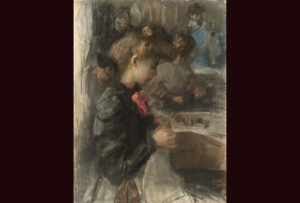
Israelis portraits showed… … high fashion as it was worn in real life and on real women.
(“Reading in the Park” by Israelis)
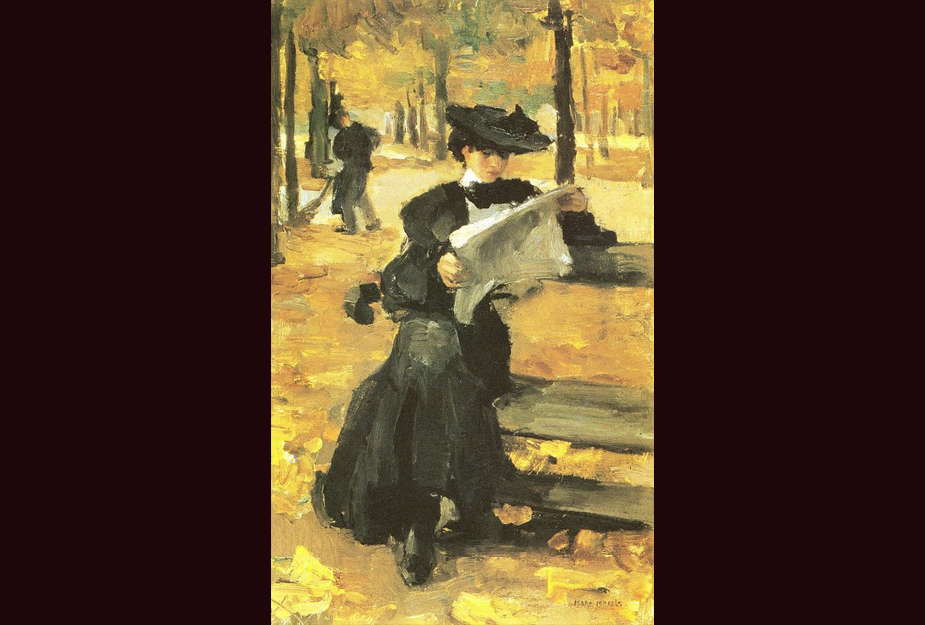
ashion house Hirsch & Cie was so successful it expanded… it outgrew its available space. Thanks to the high quality and well paying clients, notoriety of its models, and fame through art, it had a long run as a fashion house.
It was decided to say goodbye to the original buildings and build a new fashion house on the existing site, that suited its clients and offered enough space. The Hirsch & Cie as you know it today was built, and opened its doors in 1912.
(Photo: Sylvie Hirsch in a Hirsch & Cie design in 1950)
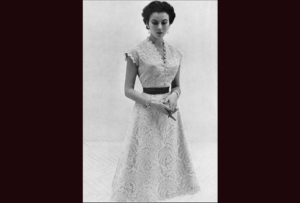
Hirsch & Cie high fashion survived… … two world wars, but increasing competition from ready-to-wear and rapidly changing fashion trends, ultimately led to Hirsch & Cie closing its doors in 1976.
The Hirsch & Cie building is once again the gem cherished by many an Amsterdammers. It is presently an Apple (MAC) computer store.
(Hirsch & Cie now a MAC store)
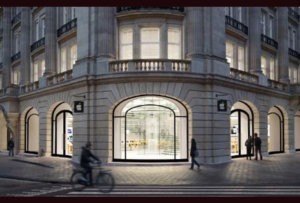
The Hirsch & Cie design house… ….was greatly successful in Amsterdam until 1943, when it was forced to close as part of the Nazi policy of dispossessing Jews of their property during the repossession of the Netherlands.
It re-opened in 1948 after the war. The iconic building had various functions in the 1970’s and was acquired by the Nilsson family in 1989 who made large scale restoration and brought in great tenants.
(Hirsch & Cie in 2007 restored, but no longer fashionable)
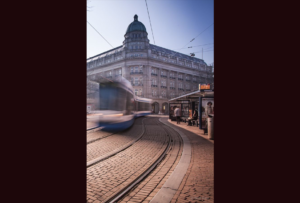
Some examples of Hirsch & Cie fashion.. .. featured lace, details, 3 dimensional objects, and lots of texture.
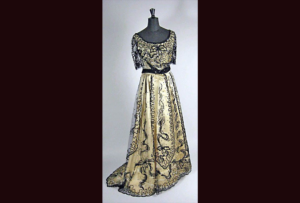
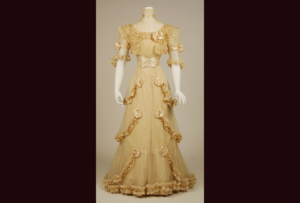
More Hirsch & Cie designs… … from its almost 80 year run. Along with many other fine design houses, it exemplified the changing shape of fashion – the silhouette.
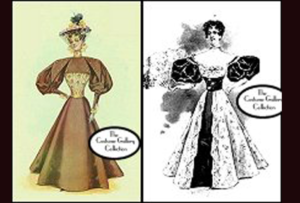
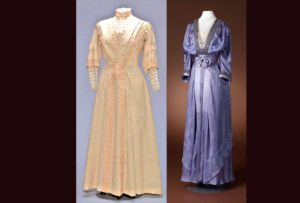
Mid-Victorian is considered to have started around 1860-61. There were only a few fashion houses open that early; most opened in the 1880’s.
3. The Crinoline
The next we will discuss was instrumental in not only the factor of high fashion, but also the 3rd factor – the crinoline.
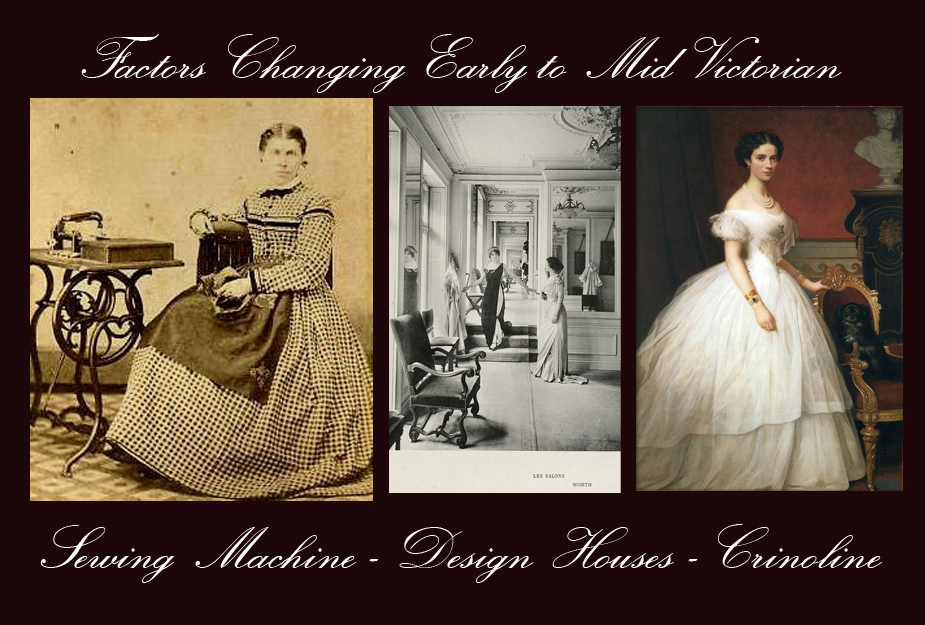
The Worth Fashion House & Crinolines… .. go together in creating a key influence that changed the silhouette and the fashion of the day in about 1861. There is a section in the website under La Belle Epoque which details the Worth Company‘s influence and history, so we will go into it only “lightly” here.
(Photo: The Worth Fashion House in Paris’ sales salon in 1910)
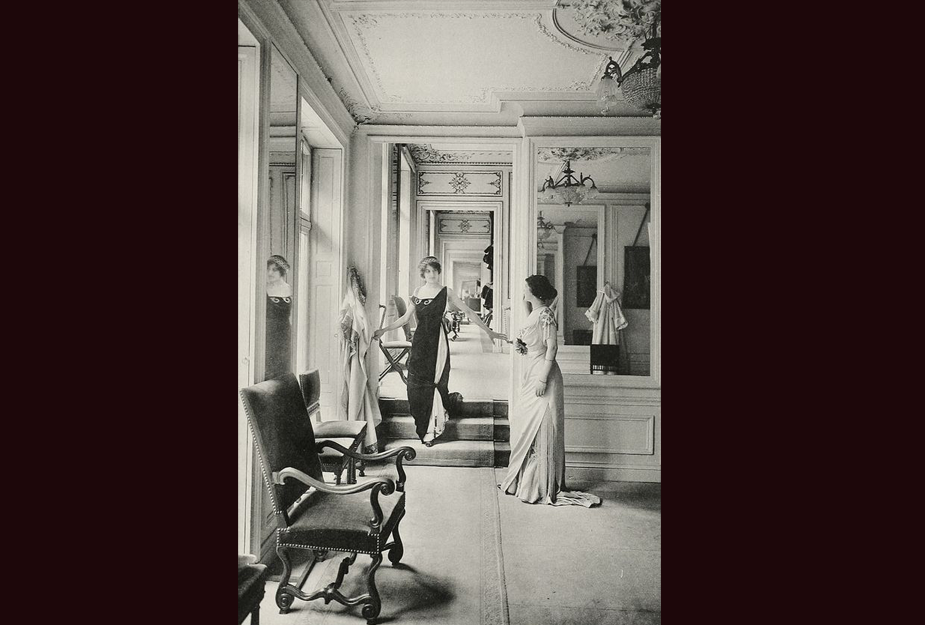
Charles Worth, Mid-Victorian Designer… … was one of the factors causing early Victorian to become the mid Victorian era. It was the influence of high fashion of “La Belle Epoque” in Paris that influecned women worldwide. Worth was THE key designer in the 1850’s and 1860’s.
Born in Bourne, Lincolnshire, England on October 13, 1825, Charles’ first jobs were working with London textile merchants. He decided he had a lot more to give than that, so moved to Paris, the center of the fashion world, in 1845.
(Photo: an 1850’s Charles Worth, working with and alongside key designers for 40 years – as French designer Poiret shown left in the early 1900’s)
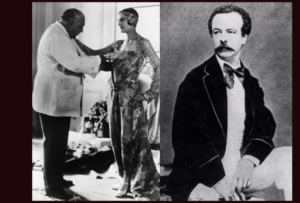
Worth… … struck out on his own and opened his own business. Worth had extremely good timing. Napoleon III ascended as emperor, and took as his wife the fashionable Eugénie, and the revitalization of France initiated by the emperor. The trendsetting initiated by his wife, led to an insistence for high fashion that mirrored the fashion demands of the late 18th century. Empress Eugénie became a patroness to Worth, setting the stage for his enormous success.
(Portrait: Empress Eugenie in her official Court Dress by Worth)

Called the “Father of Fashion”, Charles Worth… … started by working in 2 design houses in London before he moved to Paris to use those credentials to work for dressmaker Gagelin. Gagelin sold textiles and some ready-made garments. Worth, working his way up to become the lead salesman, he opened a dressmaking department. This was where Worth established his reputation as a great designer, winning fashion contests at the Great Exhibition in London (1851) and the Exposition Universelle in Paris (1855).
Empress Eugenie of France was his first key customer for whom he sold her entire wedding trousseau. His success designing for her had him named French Court Designer, and obtained for him many more wealthy, noble clientele.
(Portrait: A young Eugenie in 1855 always wore Worth and required her Ladies to do the same)

With Napoleon III as the new emperor… … Paris was once again an imperial capital and the setting for numerous state occasions. Napoleon III implemented a grand vision for both Paris and France, initiating changes and modernization that revitalized the French economy and made Paris into a showpiece of Europe. The demand for luxury goods, including textiles and fashionable dress, reached levels that had not been seen since before the French Revolution. When Napoleon III married Empress Eugénie her tastes set the style at court.
(Portrait: Eugenie in 1858 in an early Worth crinoline gown)

Eugenie, Empress of France, introduced… … the Worth creation of the crinoline (see prior month’s discussion on Early Victorian development of petticoats to hoops and crinolines). It is easy for us today to look back and identify the Mid-Victorian era by the crinoline with its giant diameter and wide back of the early 1860’s, but one must remember it had never existed before. Eugenie was showing the world something entirely new and different that had never been seen nor done before.
It was a Charles Worth creation, and a Worth marketing effort that brought the crinoline to fame.
(Portraits: left Empress Eugenie of France; right Empress Elisabeth of Austria in Worth about 1861)

The 1860’s crinoline was different… … larger, and with an elongated train, under Worth’s design. It was perfect to show off important women in Court, and the nobility loved it.
(Museum photo: the 1861 Cage Crinoline and silhouette it created)
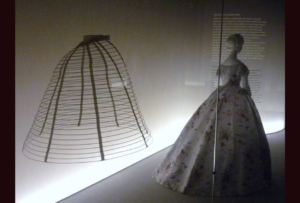
The Cage Crinoline… … which defined early and mid Victorian fashion eras, just got bigger and bigger under Charles Worth’s hand. Not only Court Dress and evening wear, but also day wear featured the huge silhouette. While the earlier symmetrical hoops could be made of horsehair or tape, the new shape had to be made of riveted steel and heavy tapes. A whole new industry was created, and fortunately, this one did not include hunting of whales.
(Photo: extant 1962 Cage Hoop)
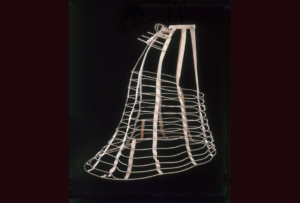
Even “simple” day dresses by Worth… … featured the hoop. Whether elaborately trimmed, or sophisticated and tailored, the early 1860 silhouette was dictated by Charles Worth and his staff. His success as a designer to the wealthy, allowed him to open his own Fashion House right in the center of the fashionable section of Paris.
(Extant garment: 1862 Worth day dress for the wealthy)
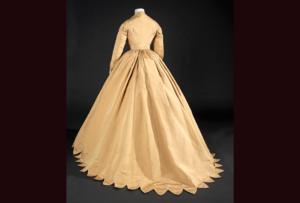
Designer Worth’s early designs evolved… … as he worked with and hired other designers to implement his concepts. His business grew, and fame spread to the United States.
(Photo: an 1865 Worth ballgown made for Empress Eugenie of France)
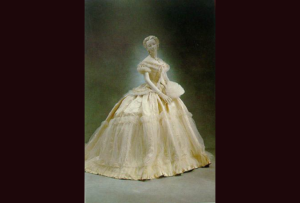
Charles Worth, born English, was the key.. … designer in the Mid and Late French Victorian eras, and his son would carry on into the Edwardian eras.
(An early 1860’s design Sketch from Worth House of Fashion showing the application of the different cage hoops or crinolines to his original design concepts).
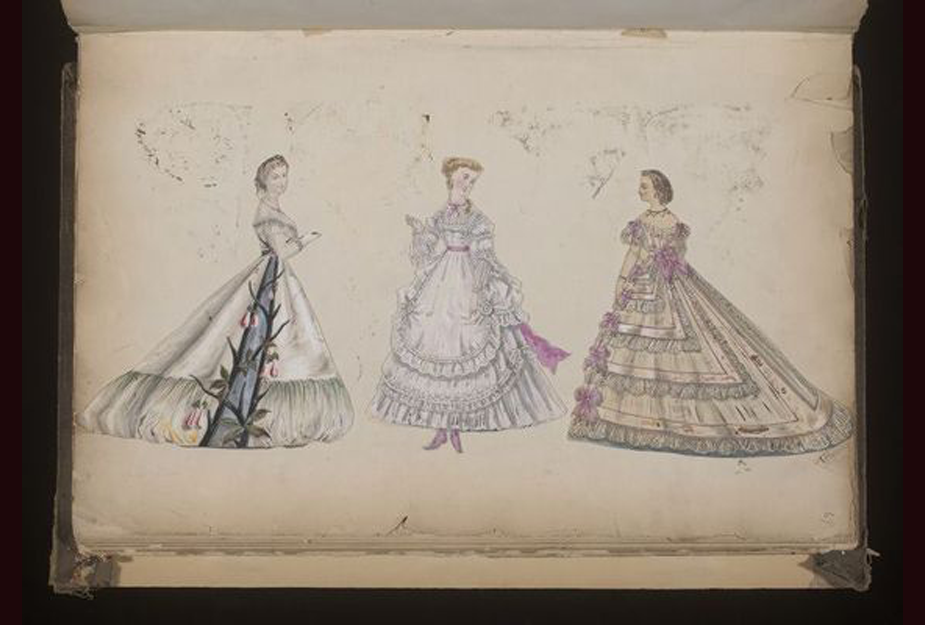
Worth had a business partner, … a young Swede named Otto Gustaf Bobergh, and in 1858 the duo set up in business at 7 rue de la Paix, naming the establishment Worth and Bobergh. The business stayed open even after his death under the ownership of his sons, and notable designer son Jean-Philippe Worth (which gets confusing in the history books).
(Photo: original Worth and Bobergh fashion house on Rue de la Paix, Paris)
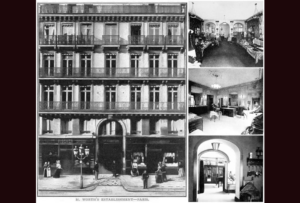
The Worth building is still in service today.. .. although it has been modified for multiple modern businesses.
(Recent photo of the Worth Fashion House in Paris, France)
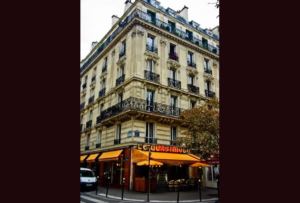
Out of the Worth fashion business… … came innovative designs and introductions of concepts from the crinoline into bustles, princess lines, and the later Titanic and WWI fashions. Also out of Worth came the concepts of the runway fashion show and multiple shop sales.
(Another Worth introduction, the “tournure” or metal bustle of 1885.. to be discussed later)
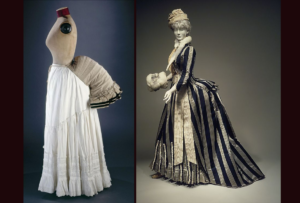
To get an idea how famous Worth was in the fashion world.. ..worldwide, and the scale to which he did things – when the Suez Canal was finished in 1869, Empress Eugenie of France had Worth make her 250 dresses so she could attend the opening.
As the Second Empire of France (the Bourbons back on the throne after the Napoleon eras; Eugenie was the wife of a descendant of the Louis who had been dethroned by the French Revolution – and were back again) boomed, so did Worth catering to the multitude of royals.
(Photo: an 1861 early career Worth royal gown)
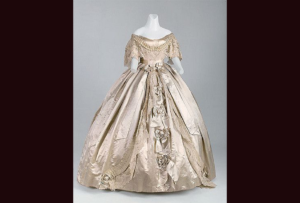
Ever expanding his market, designer Worth… … looked to royals of all the countries plus the US. In one such effort, after a successful sale to the wife of the Austrian ambassador so she could attract the notice of the Empress of France, Worth became Court Designer for Russia, Italy, Spain, & Austria as well as for France.
(Photo: 1863 the Duchess of Morny in a Worth Gown with cage hoop crinoline)
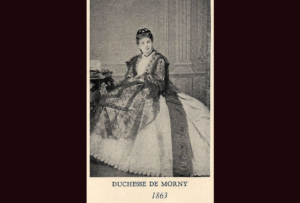
Worth was not without his critics though… … humorists, critics, and satirists had great fun with the crinolines. Much of what we know today is through cartoons and satirical writing of those who wanted to comment on the huge hoops of the mid Victorian era, and Worth himself. Some of the jokes were merited, as wearing a crinoline had serious disadvantages: fitting into carriages, through doorways, or fitting in a room at the same time as another woman.
(1860’s French cartoon about the dangers of crinolines)
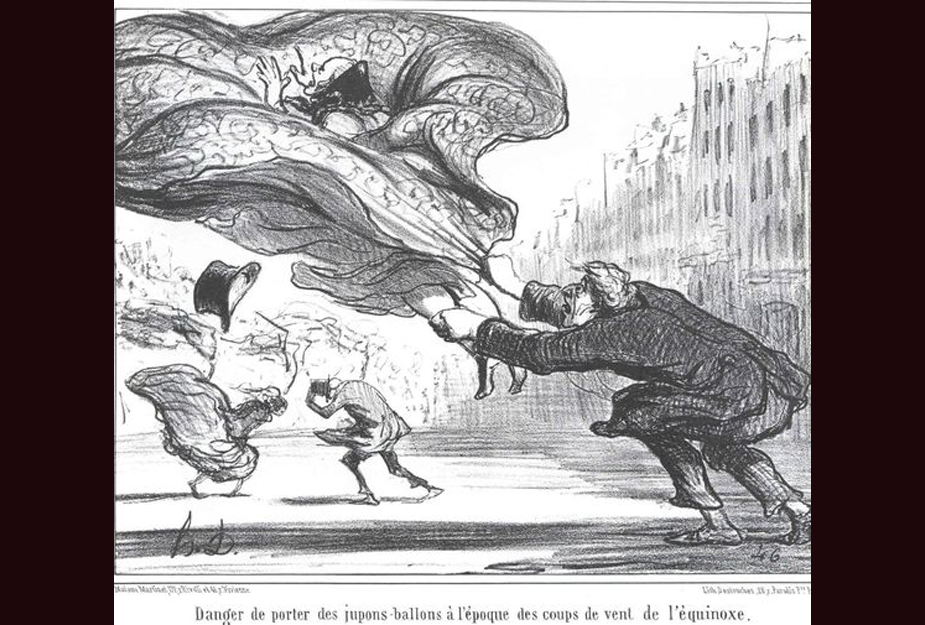
Leading ladies of the Victorian stage.. … including Sarah Bernhardt, Lillie Langtry, Jenny Linda, and Nellie Melba were Worth customers. Not only did he design for royals, stage (and later screen), Parisian High Fashion designer Charles Worth also created special event pieces such as masquerade ball costumes and wedding dresses.
(A Worth sketch of a masquerade ball costume named “RAINBOW”)
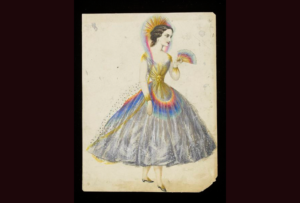
“Haute Couture” (“High Fashion”)… …was a concept invented by Worth to sell more clothing to the wealthy and elite. “Haute Couture” invented the term “costume” which dictated that each different function or activity should have it’s own “costume”.
Worth encouraged wealthy women of all the European countries and the U.S. to make at least 4 changes of “costume” per day, meaning each one had a full wardrobe of Worth fashion.
(Photo: Pauline of Metternich, a very good Worth customer bought many “costumes” in the 1860’s; this in 1865 showing a fairly common design theme of that mid Victorian era day dress with the panels and overlapping wide fabrics (see Worth’s design sketch for another customer which is quite similar from same year below:)
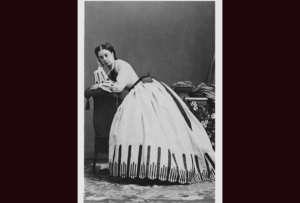
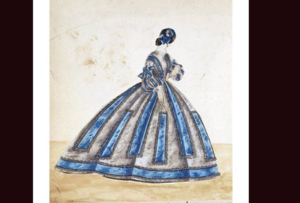
4 times a year, Worth would prepare… … several designs for the SEASON, rather than let the customer dictate the design has had been the previous dressmaking practice by himself and other designers.
Worth would make a flamboyant introduction of the seasonal designs by putting them on live models who would show them in private sessions to the customers. People would pick from what they saw on the model.
These were the first fashion shows.
(Photo: Worth’s shop/salon in the 1870’s where he would have live models show customers the current seasonal designs)
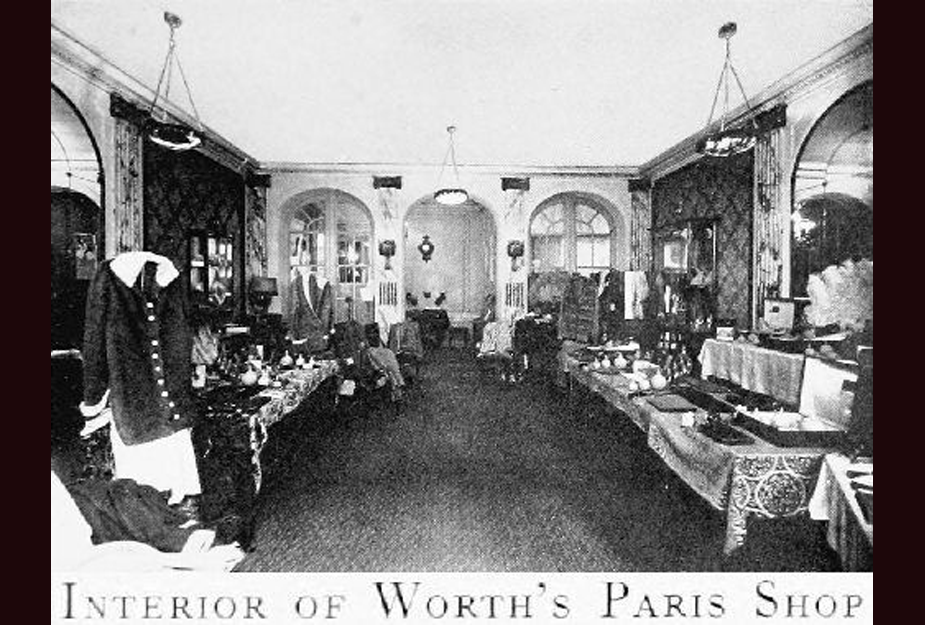
Focusing on luxurious materials… … and exact fit, the Worth design salon had special lighting that made his customers look beautiful. Clients would make selections & have their measurements taken right there in the work rooms. His fame and notoriety was unique to other designers who would travel to the clients’ homes for custom fittings. Worth’s customers came to him.
(Photo: Countess des Portales in a Worth “costume” in the 1870’s)
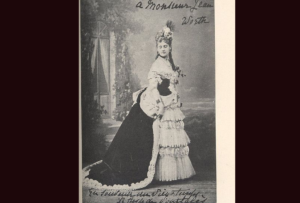
In America, Worth’s popularity was… .. just as big as in Europe. America’s industrialists were very wealthy, and the Astors and Vanderbilts were big clients.
(Mrs. Alva Vanderbilt of the elite wealthy class in America, models a late 1870’s Worth gown)
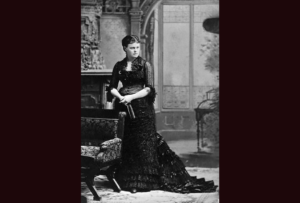
It is said, Mrs. Vanderbilt asked designer Worth.. … to make her a ball gown of such uniqueness and to make a statement about her family’s contribution to innovation and society, that Mrs. Astor would take note and invite her to the higher levels of American society during the “Gilded Age” (1870’s into 1880’s). This Worth gown named “Electric Light” was designed for Alva Vanderbilt in 1883.
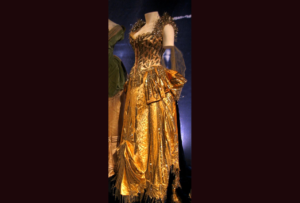
Worth’s innovations went beyond runway, design.. .. and marketing. In the beginning when Worth was still in England, he cut off French clothing labels & sewed them onto his English made clothes, introducing the first designer labels. Later, when his designs and market could stand on its own, he made his designs available to other dressmakers, clothing manufacturers, and department stores, thus creating the first wholesale structure for the clothing industry.
(Photo: Charles Worth at the peak of his career in the 1880’s and 1890’s not only serving top clientele from around the world, but also introducing new concepts of business structure)
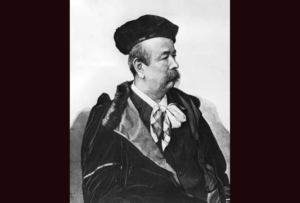
Worth was known for lavish fabrics… .. and trims which made up his beautiful (and expensive) garments. These often drew from historic influences such as the “Shepherdess look”, or “La Polonnaise” which he claims to have invented, even though it had been high fashion in Marie Antoinette’s era a century earlier.
(Photos: left, 1890’s Worth “Polonnaise” he claimed was original concept; right 1775 French “Polonnaise” of Marie Antoinette’s fashion era)
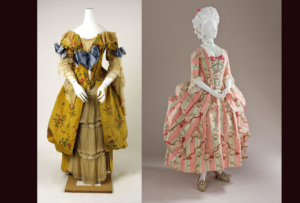
Designer Worth visited the National Gallery to study… .. historic dress, and the influence of what he studied can be seen in his later designs. In the 1890’s, there was a popular trend to go back to the “good old days” – of the Colonial Era. Worth designed gowns in this revivalist spirit of the 18th century which were wildly popular.
(Photos: left: Worth 1890 gown for costume ball; right: authentic 1770’s robe a l’anglaise)
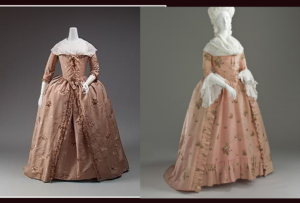
As well as one-of-a-kind designs, Worth… … also made collections which were displayed on live models. Less wealthy clients could order in their own size, and they were somewhat “mass produced”, although by hand by his designers using the highest quality techniques and materials. They just weren’t “custom costumes”.
(Worth sketch: basic design for travel in the 1860’s; produced and copied around the world and in America for daily wear)
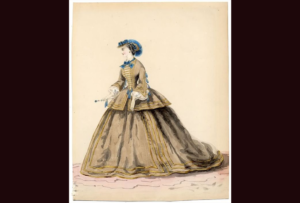
Working from a vast array of color, designs… .. and silhouettes, Worth would provide entire wardrobes, including morning, afternoon, and evening dresses, nightgowns, wedding gowns, gowns for masquerade balls, and costumes for special events.
(Photo: 1865 unique Worth ballgown for a specific customer.. although we can’t imagine whom..)
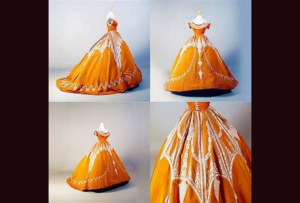
A hallmark of Worth fashion design… …is the asymmetry of the skirt drapery. This was extremely difficult to implement, and showed exquisite craftsmanship. Worth had a fascination of eastern and Asian cultures, and he in particularly was attracted to Japanese influence.
There had been a renewed interest in Japan in at the end of the 19th century due to the re-opening of Japan’s borders to the western world by Admiral Perry in 1854, so it is not surprising the assymmetry, bold colors, beautiful silks, and Japanese influences should be seen in Worth designs.
(Photo: “Tulipes Hollandaise”, estimated 1895 bed gown by Worth shows the Asian influence in design, draping, color, and fabric)
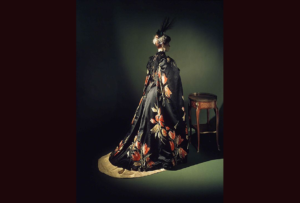
Another key influence to Worth’s fashion.. .. was the Art Nouveau movement that swept the world around 1900 until 1909.
(Photos: Worth gowns left; 1858 scrolling velvet design is like the wrought iron and scrollwork of the Art Nouveau architectural movement; right 1908 gown for Queen Maud of Norway one of his last projects shows the excellent craftsmanship and organic forms indicative of the art form)
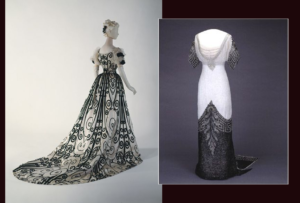
Museums in the United States… .. hold a large number of surviving Worth garments and collections such as at The Costume Institute. This is a testimony as to how very popular this English born, French “Haute Couture” designer was in America, as well as with European royalty and nobles.
American clients traveled to Paris to purchase entire wardrobes from The House of Worth. For a wealthy woman like Mrs. Astor or Mrs. Vanderbilt, a complete Worth wardrobe would consist of morning, afternoon, evening, and “undress” costumes such as tea gowns and nightgowns (worn in the privacy of home).
Women around the world also looked to Worth to supply gowns for special occasions such as weddings and costume balls.
(Photo: Worth “undress”, about 1900)
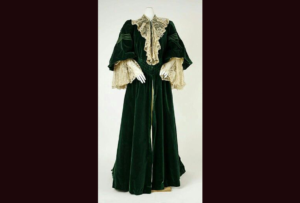
Worth also introduced changes… …in the way clothing was designed & constructed. He would mass produce parts of a piece of clothing, and then put them together in a different way; e.g. a sleeve would be produced in bulk quantity, but used in different dresses in different ways to get a different look. This increased his profitability and sped up production while maintaining the originality and custom quality aspect of his designs.
He still used beautiful and luxurious fabrics and trimmed them in rich decorations including fringe, lace, braid, tassels, and pearls in every ensemble.
(Photo: Am 1867 girls’ dress demonstrates Worth’s unique use of everyday components – in this case a silk sash – in mixing gorgeous fabrics and trims to result in a simple, clean and gorgeous gown)
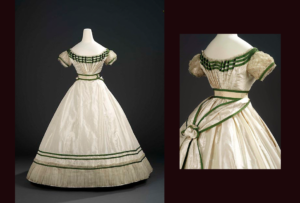
In addition to introducing the crinoline, Worth… … designer made a shockingly short walking skirt which was – dare we say? Ankle length. Another key design was the princess gown that had no waist. It hung simply and straight in the front while draping with pleats in the back.
(Photo: 1913 Worth short walking suit with long draping waist)
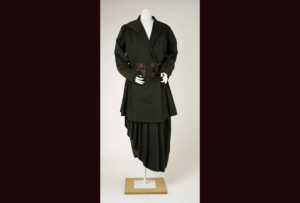
Charles Worth with his talent for design and.. .. promotion.. built his design house into a huge business until his death from pneumonia in 1895. He had been married to his wife over 30 years, and had one of the most profitable businesses in the world.
(Portrait: Height of fashion, Charles designed a presentation gown to Queen Victoria in 1885 with an 11 foot train)
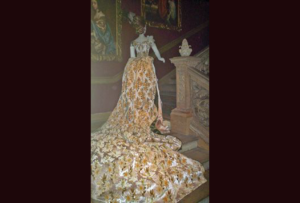
Charles Worth had left a legacy… … of unique garments, new business structures including wholesale and designer-readymade, fashion shows/runways, and designer branding, along with 1000’s of examples in museums in Europe and the US today.
(Extant example:1862 examples of American Worth Gown and travel dress (below)
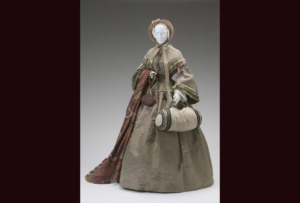
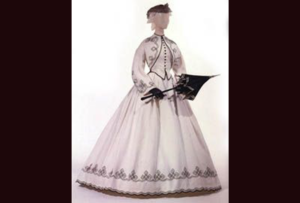
Worth had also demonstrated how… .. to use high quality and luxurious fabrics to make women of every size beautiful, while making himself a tidy profit.
(Photo: The Worth “Pelzmantel” – “Fur Coat”)
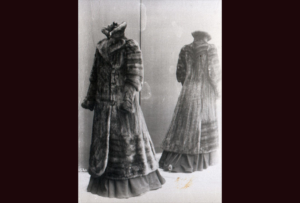
Worth’s sons took over… .. Gaston-Lucien and Jean-Philippe took over their father’s business and succeeded in maintaining his high standards. Jean-Philippe’s designs in particular follow his father’s aesthetic, with his use of dramatic fabrics and lavish trimmings. Jean0Philippe became a talent and notorious of his own merits, as well as being Charle’s successor as a top fashion designer.
(Photo: Jean-Philippe and his signature colors and fabrics in 1910)
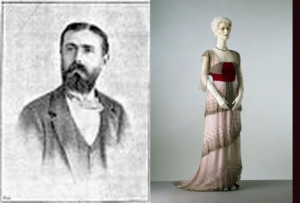
Jean Philippe Worth built on his father’s… … high fashion design legacy as he took design to yet another exciting stage when Norwegian royalty wore & marketed his gowns. Queen Maud of Norway is perhaps his most famous client, known even today for her corseted, tiny waist and Princess silhouette.
(Photos: The Norwegian Royals in about 1900 in Jean-Philippe Worth Court gowns)
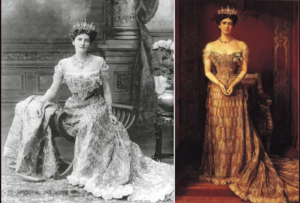
Every Worth gown at the turn of the 19th into 20th century… … by Jean-Philippe overflowed with rich silk fabric, trimmings of intricate embroidery, ruffles, frills, & floating fine silk tulle like this 1902 ball gown.
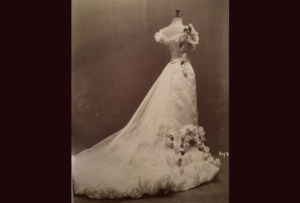
In the beginning, Jean-Philippe Worth was.. … obviously experimenting and testing his wings. He had been working alongside his father, famous Charles Worth all his life, so he knew the techniques and concepts; he knew the marketing strategies and methods of marketing. What he had to grow into was his own style, rather than a modified version of what his father had done.
His early sketches show an entirely different direction for the son to lead fashion into the next century. This 1897 gown looks like Jean-Philippe’s up and coming concepts mixed in with his father’s old “fluff”. It doesn’t seem to work very well.
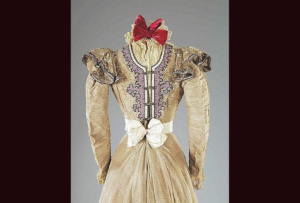
But as he got comfortable, new designer Jean-Philippe… .. Worth found his own clientele, and his own way. His designs utilized the new synthetic fabrics with different color schemes and textures than his father had used. The new fabrics draped differently and had different properties. Mass production made different types of trims available too – beads, feathers, and sequins.
(Portrait: 1898 the Countess of Warwick introduces the simple clean lines of the new Jean-Philippe Worth style)
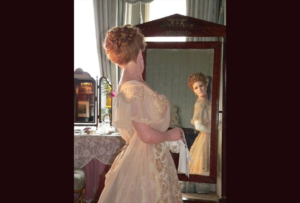
White and gold were… …Jean-Philippe Worth’s, the new “Haute Couture” legend of Paris fashion, favorites to use. The new gold lame’s and sensuous draping opened his mind to all sorts of uses. He liked to combine the white and gold with high contrasting accent pieces in red and black. Eventually, he would focus on black, white, and silver as a color combination.
(In 1891, the new Jean-Philippe designs were cleaner, simpler, and taking on the “wood block” concept of the Art Nouveau specialists that were also being embraced by competitor up and coming designers Poiret and Lanvin)
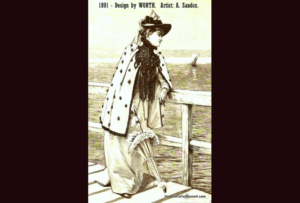
As he evolved, designer Jean-Philippe Worth removed.. … the excessive ruffles & frills of his father’s designs, and his of the 1890’s in favor of rich fabrics in saturated colors which would show off women’s sensuous curves in flattering outlines. The “outlines” concept was taken from that of Art Nouveau.
(Photo: This 1910 evening gown flatters the wearer by emphasizing sensuous curves and minimizing the frills while “pointing” at the things the designer wanted the viewer to focus on – luscious hips and breasts)
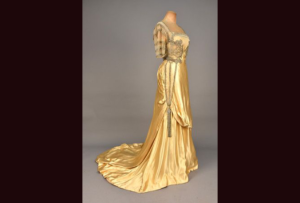
While Jean-Philippe Worth’s favorite design style was… .. high contrast in gold, black, reds, whites, and silvers, he worked in deep, rich saturated colors of blues into blacks as well. His designs took on the shape of the Pre-Raphaelites, Art Nouveau, and Craftsman styles of the time which emphasized the beauty of natural and organic forms, as well as introducing a concept of storytelling and ancient nymphs and imaginary women of extraordinary women.
As the House of Worth evolved in a world with moving pictures, exotic dance shows like burlesque and the Moulin Rouge, with impressionistic painters, Jean-Philippe was able to capture the mood of the late Edwardians even with his simple day dresses. He did this with imaginative use of color, texture, draping, fabric, and ornament.
(Photos: left: 1908; right 1909 artistic movement type gowns by Jean-Philippe)
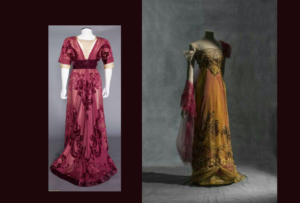
Jean-Philippe Worth’s ability to combine color… … texture, and form took his father’s art form in fashion to a new level. He used colors others would not think of putting together and maintained the overall silhouette of the fashion of the day even in “undress”, nightgowns and daydresses for use in private at home by the wealthy and privileged such as this one from 1900.
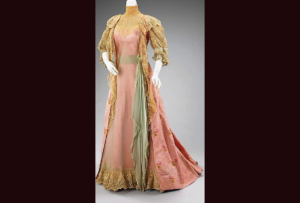
Jean-Philippe could make basic… … simple, and plain black garments appear to be magical. He was applying his father, Charles Worth’s flair for the dramatic and innovative use of fabric, draping, texture, and ornament.
(Featured: the “Draping Salon” in the House of Worth 1907; below: 2 black “undress” garments – 1905 left and 1908 right negligees for use at home)
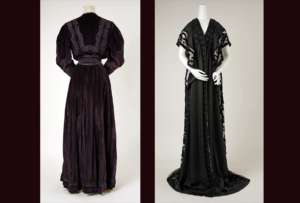
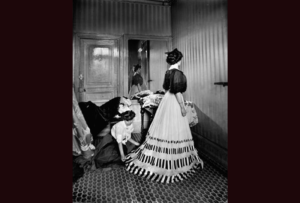
The Worth Fashion House building.. .. itself was an artistic expression. Continuing his father’s use of live runway models, Jean-Philippe also exhibited at the Exposition in Paris and other art shows.
(1905 Worth on display in the White Palace in Paris)
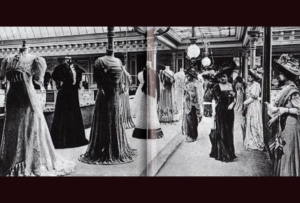
It was the Titanic era though.. … that had Jean-Philippe at the top of his game. 1912 “La Belle Epoque”, a movement of French Designers which brought a “mood” or spirit” to fashion, was the ideal platform. It combined top quality construction technique with the finest fabrics and materials that could be found, with Asian and eastern concepts and novelties. Women and society was changing, and the designers wanted to create a new spirit of independence and daring among women.
In this era the silhouette completely changed, the corset was being abandoned, women were demanding more function out of their clothes, and for a designer like Jean-Philippe who loved color, texture, and ornament draped artistically so that a woman looked good – it was ideal.
His designs from about 1909-1914 will stand as examples of the era above all others.
(Photo: 1909 Tea Gown making even elderly and larger women look fabulous)
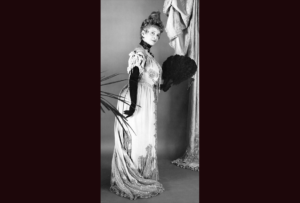
More Jean-Philippe Titanic examples… This 1911 gown was designed per the instructions of the King of England.
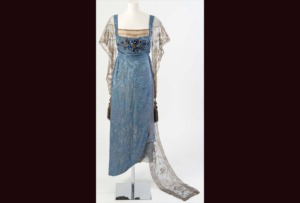
By 1916 Jean-Philippe had created an empire… … and continued the innovations his father Charles had begun in the late 1850’s.
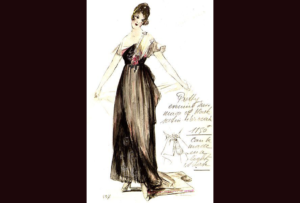
The House of Worth continued to flourish… .. through the sons’ tenure well into the 1920’s. The great fashion house finally came to an end in 1952 when Charles Worth’s grandson, Jean-Charles, retired from the family business and closed the doors.
(Photo: This iconic Titanic Tea Dress by Jean-Philippe Worth stands as one of the landmarks of fashion design ending the Edwardian era, and a family dynasty).
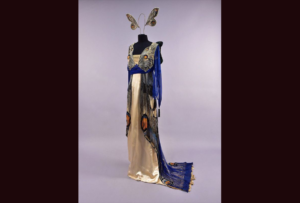
4. Synthetic Dyes
We have been studying Worth, the crinoline, .. and the sewing machine as we discuss the factors that made the Early Victorian Era change into the Mid Victorian Era. There are many other design houses worthy of note, but extensive discussion of these are already on the website, so we will move ahead to the 4th and final factor that defined the Mid-Victorian era.
That key factor was – DYE.
No, not “DIE”, as in what this little girl of 1860, the first year of the Mid-Victorian era, is doing to this poor dog. (Remember we were looking at cats and dogs way back when we started this journey about the Victorian Era..? We didn’t forget…)
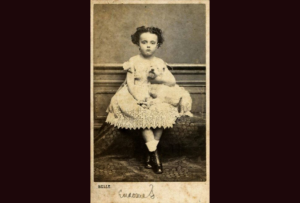
Please click here to go to the specific Dyes & Colors Section.
(We will review the section on synthetic dyes here which is applicable to the section, beginning with Indigo, which was the beginning of synthetics…)
Indigo was first introduced into South Carolina.. … by Eliza Pinckney, where it became the colony’s 2nd most important cash crop behind rice. There were three species grown in the US, (“indigofera caroliniana, I tinctoria, and I suffruticosa”). It became an export crop. By 1775, South Carolinan indigo production exceeded 1,222,000 pounds.
When Benjamin Franklin went to France in 1776 to get France’s support for the Revolutionary War, he took 35 barrels of indigo to sell to help the war effort.
(Sketch: 1770’s Carolina rice plantation run by slaves)
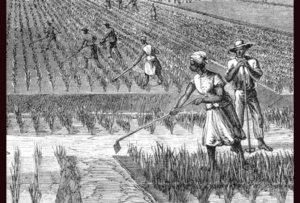
Called “Blue Gold”.. indigo.. .. had a high trading value into the 19th century around the world. There were many conflicts and misuse of indigenous people used to plant, cultivate, and process indigo in many places such as Bengal, and India, but the demand for the dye continued to climb. In 1897, 998 square miles were dedicated to its growth in India – about 2 times the size of New York City.
(Photo: dying indigo in Miao)
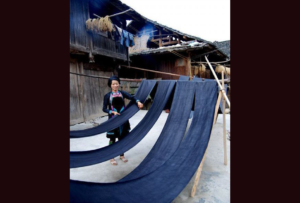
England start to grow indigo in about 1774… … but the “Prussian Blue” which was made with iron salt and a process using potash plus aniline and bleaching powder made brighter blues than they could grow, so by 1834, they gave up.
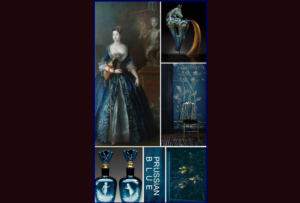
Synthetic indigo was discovered by a chemist.. .. who was trying to synthesize the medicine quinine to treat malaria. 18 year old chemistry student William Perkins made a murky residue which was the first aniline (synthetic) dye. It was called mauve, and it was consistent and permanent, unlike natural dyes.
(Photo: the first aniline synthetic dye – mauve)
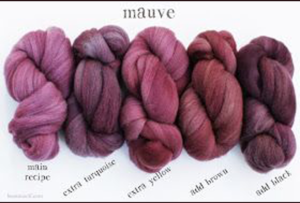
Adolf von Baeyer worked on indigo… .. specifically after that to come up with an aniline equivalent to the plant sourced dye. In 1865 he started, by 1878 he had a first attempt using the chemical “isatin”, and in 1880 he made a 2nd successful attempt using the chemical “2-nitrobenzaldehdye”.
In 1883 he finally figured out the chemical structure of natural indigo, and gave up trying to duplicate it. Instead, chemists like von Baeyer continued the work to create an entirely new structure that would look the same yet be able to be synthetically mass produced.
Karl Heumann, using “Badische anilin- and Soda Fabrik” or BASF, eventually figured it out.
(Photo: natural indigo today in India)

The new synthetic indigo.. .. was reasonable to produce commercially from the Baeyer “BASF” process of aniline dye. In 1897, 19,000 tons of plant based indigo were being produced, but by 1914 because of the new synthetics, it dropped to 1000 tons, and by 2011 50,000 tons were being produced worldwide.
(Photo: the indigo plant as grown in the US)

Part of the reason synthetic dyes came to be.. .. was there was a rise in interest in chemistry in the 1870’s. Perkins, who had accidentally discovered the mauve dye “mauviene”, had his own London factory to produce it. From 1858 until the early 1900’s, magenta or fuchsine – two other purplish blue colors – had patents constantly revising and improving. All of them could easily be produced in factories.
(Photo: Perkin and his 1856 mauveine dye formula)
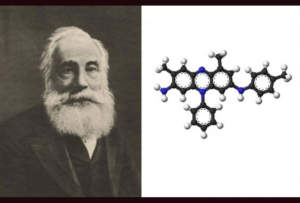
By the end of the 19th century, only.. ..a few Scottish tweed manufacturers were using exclusively natural dyes in commercial processes. With the synthetics and mass production of the Industrial Revolution, a rising middle class in particular were wanting the affordable and rich colors of the aniline dyes.
(Photo: 1860’s wrapper dyed with new synthetic dyes of the Mid Victorian Era)
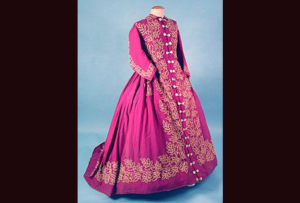
A list of early synthetic dyes… .. includes the new “indigo” which is used for blue jeans today. Most of the aniline dyes were named for war skirmishes in Europe.
1858: magenta by Vergoon
1861: Methylviolet by Lauth
1862: Hofmann’s Violet
1862: Bismarck Brown by Martus and Lightfoot – the first water soluble dye
1863: Black by Light foot
(Photo: 1830 linen dyed with natural indigo)
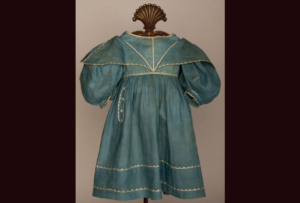
List of synthetic dye inventions continues… 1866: Methyl Violet
1868: Synthetic Madder called alizarin
1872: Methyl Green – still in use today
1873: Sulpher Brown
(Photo: 1868 American dyed indigo – natural)
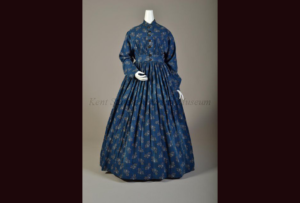
More synthetic dye inventions listed… 1875-76: Chrysoidine 1st type of Azo dye
1876: Methyl Blue
1877: Malachite Green
1878: Biebrich Scarlet, Pure Red (acid dye as bright as cochineal for the first time)
1878: Synthetic Indigo – marketed in 1897
1900 forward – 1 to 2 new ones introduced each year to present day
Here are a few natural indigo dyed.. .. historical examples below. Note the consistency in the color regardless of the fabric or yarn used.
(Indigo dye today)
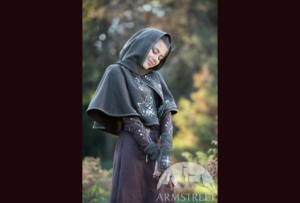
(Present day natural indigo dyed fabric at Colonial Williamsburg)
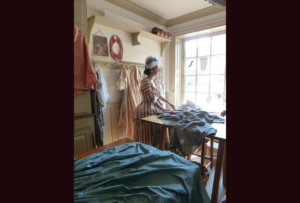
(18th century linen indigo dyed stays)
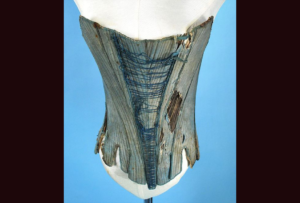
(Variations of natural indigo using mordants)
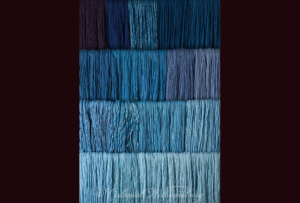
(Mixing natural indigo dye today using old methods)
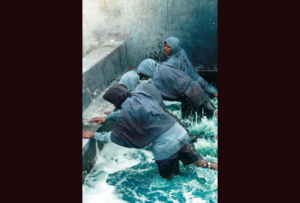
Talking about dyes in Mid Victorian era… ..we have been discussing the development of synthetic dyes that started somewhat accidentally from the search for a cheaper way to make indigo than growing plants.
With the rise of the new synthetic dyes, came the ability to adjust color of natural or synthetic dyes with the use of chemicals called “Mordants”.
Most natural dyes throughout history needed to have something added to the fabrics so the color would “stick”, so from the beginning of dyes, mordants like sources of aluminum, copper, iron, and chrome were used.
(Photo: 20 different colors of wool dyed with Madder just due to the different pH of Mordants)
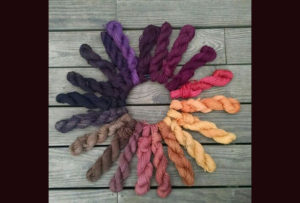
Mordants also make.. .. different tints or shades of a particular color. For example, magnesium mordants made and make alizarin dyes have a purple hue.
(photo: natural dye variety on cotton with alum mordant)
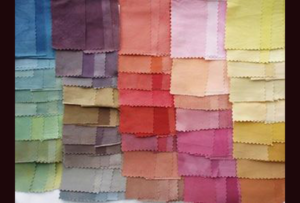
Synthetic dyes mark the change between Victorian eras… … because it was during the 1850’s that they were developed. The textile industry at the time was booming, and the increased demand for cost effective, easy to produce and replicate and apply dyes were in great demand.
The economic limitations in growing, gather, harvesting, and processing natural dyes on such a large scale, combined with large scale farms and specialized agricultural methods made synthetics that could be produced in a factory a symbol of the era.
Synthetics were powerful, “stuck”, cheap, and intense in color compared to naturals.
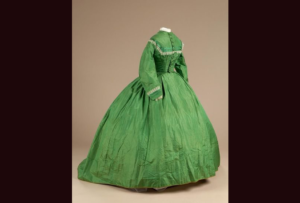
There were problems with some synthetic dyes… … like “Scheele’s Green” which was made with arsenic, and killed the wearer or anyone who breathed in, touched, or came near a dress, shoes, gloves, flowers, or anything dyed with it.
(Photo: 1860’s “Arsenic Green” day dress)
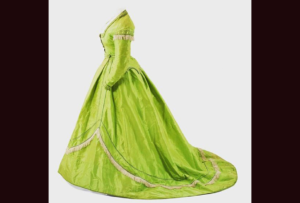
Coal and Tar were used… .. in the development of dyes under the leadership of August Wilhelm von Hoffman of Germany at the Royal College of Chemistry in England in 1845. He trained chemists including William Perkin who accidentally discovered the first synthetic dye called “mauve”.
While “mauve” was only popular a short while, it paved the way for further research. By 1900 more than 50 compounds had been isolated from coal tar. By 1914 the Germans had well established the synthetic dye industry that would lead to today’s products.
(Photo: 1914 German chemist doing a test on the color stability of a coal tar derived synthetic dye)
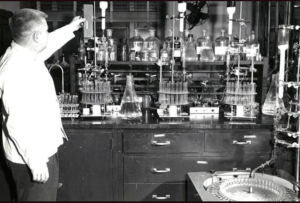
Another brief mention of Mordants for dyes… Historically and in modern times, when a fabric is to be dyed a color, it was either dipped into the dye, or the dye was applied to the fabric (like Indian “batik”).
Many fabrics like cotton need a chemical aid to make the dye adhere and stay. A “mordant”, called “adjective dye”, is an element which aids the chemical reaction between dye and fiber.
(Photo: dying by submersion today)
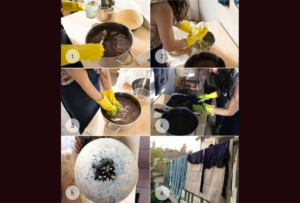
The container used to dye fabric in.. … is important because a “mordant” will change the chemistry between fabric and dye, and a brass, copper, or iron pan will alter the chemistry in the dye. Enamel is preferred for dying.
(Photo: container makes the difference. Dying in stainless steel)
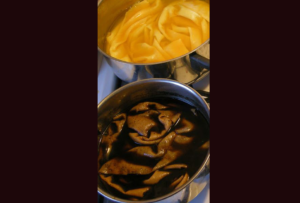
Please go to the Dyes & Colors sections for more on this topic concerning natural dyes.
5. Marketing
It’s the Mid Victorian Era we were talking about.. … before we strayed into dyes. We went there because dyes were one of the main reasons early Victorian evolved into Mid-Victorian fashion eras. The sewing machine was another, and the rise of fashion designers, notably in France with the likes of Charles Worth meant high fashion was originated according to a plan – the plan of someone making money off of it.
It was also a time marketing came into play. With increasing methods of communicating and traveling worldwide, a French magazine like this one could make it to American rural women by the 1860’s.

The Fashion that Resulted as Early changed to Middle Victorian
Now we will discuss the fashion features that resulted from those influences, so you will be able to look at an historical example and be able to place a rough date on it.
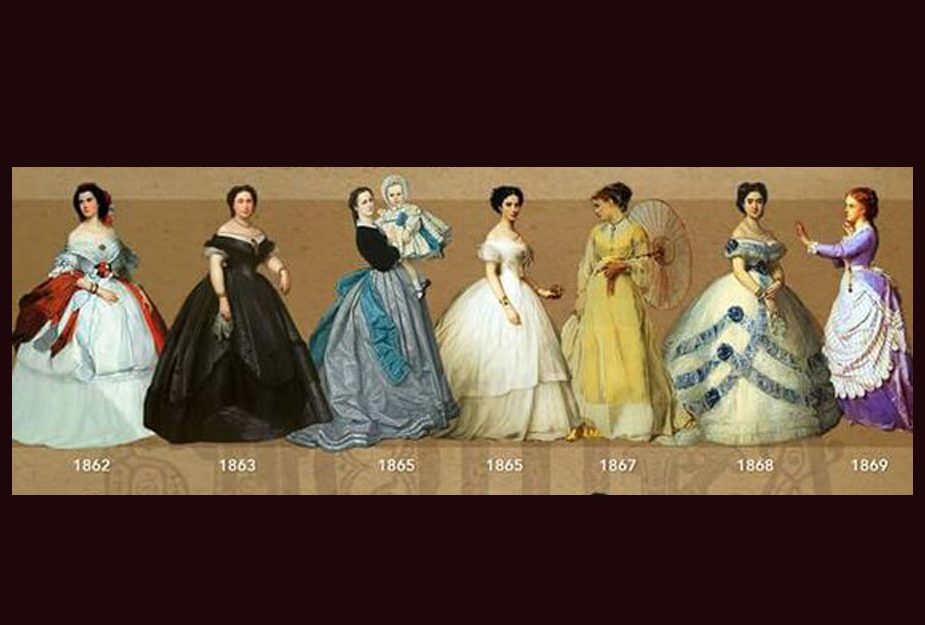
Undergarments defined the Victorian silhouettes… The change from the late 1830’s Early Victorian fashion era when Queen Victoria of England took control of fashion dictates for the world, through the ’40’s and into the Mid Victorian era (placed at around 1861 plus or minus due to the factors we’ve been discussing) was very gradual.
1840’s
The 1840’s were defined by the ruched shape of the bodice with its long torso and tapered center front.
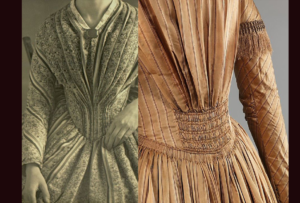
The 1840’s silhouettes were also defined by.. .. skirts. They were coming out of a stiff “bell” and becoming rounder. As the ’40’s progressed, flounces were added to make the skirt wider and wider with the intent of giving the appearance of a narrower and narrower waist. The addition of the Bertha collar and drop shoulders of the bodice created the huge figure 8 silhouette that became more and more extreme at the approach of the 1860’s.
(Photo: 1840’s skirts)
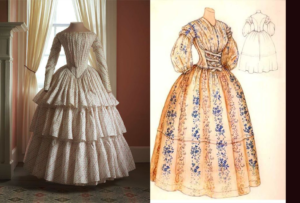
Early Victorian dresses could be told apart from… .. mid Victorian as the sleeves worked in combination with the elongated front and back torso, overlapping flounced skirts, and wide sleeves (with engageantes – see February posts). Ornamentation on the sleeves always brought the silhouette wide at shoulder and hip to emphasize the small waist.
(Photos: late 1840’s bodices with different sleeve trim typical of the late part of the Early Victorian era)
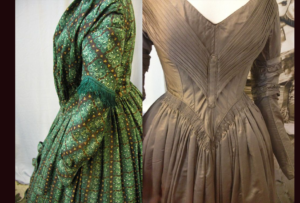
It was really the Early Victorian attitude though… .. that changed. The diminuitive and demure woman of the 1840’s and ’50’s who was covered from head to toe including her hair “as if controlling passion”, started to bare her shoulders and show her shape in more fitted garments as the ’60’s approached. The ruching, gathers, flounces, and trim simplified to elegant lace, overlays, and a more tailored look.
(Photo and sketches: the Attitude of the 1840’s and ’50’s has women showing off instead of hiding out)
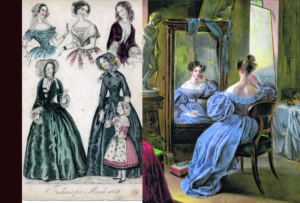
Sewing machines, designers, hoops, dyes, and the 5th factor.. … new types of undergarments were major factors that changed fashion from Early to Mid Victorian fashion eras.
Empress Eugenie of France had shown her friend Queen Victoria the crinoline as we discussed before. That of course was a blatant change from wearing multiple petticoats to adding a hoop which eliminated the need for all but one petticoat. The new light weight structure gave a sort of freedom from copious volumes of fabric and layers, but at the same time made fashion more cumbersome and unwieldly; less functional for a woman to actually DO anything.
Working women wore hoops and crinolines, but more refined with simpler garments on top.
(Photo: late 1840’s undergarments with layers or fabrics with a multitude of pleats at the top to create the skirt volume. Note the waist is not so tiny – yet – at this time.)
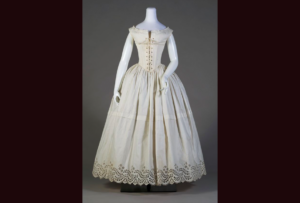
It was the corset again, that changed the shape of fashion. 1850’s corsets had been waist cinching and because of the improving steel boning, metal grommets, and metal busks, had by that time become restrictive and shaped and formed the body.
(Photo: 1851 fashion ideal sketch and a real 1851 corset. Waist cinching, it did not constrict hips or force the breasts into shape, and it was still “ok” to have a somewhat “vase” shape on top, meaning the breasts were just sitting on top of the corset and not formed or shaped)
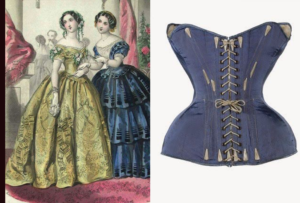
The 1845 corset was designed to.. … smooth lumps and bumps much as early Regency corsets had at the turn of the century, and as had those of early Victorian. By 1853, it reached lower over the natural hips to smooth those too, but did not attempt to cinch in the hips. The flare at the bust was still considered fashionable in the 1850’s, but would become vulgar in the ’60’s when the top of the corset would be pulled snug along the breasts.
(Photos: 1850’s corsets longer over the hips and smoothing overall to match the long bodices of the decade)

1850’s
By 1858 the corset had become more.. … rounded at the bust, with the waist even more tightly cinched than in the late 1840’s and early 1850’s. The extreme lacing fully supported the breasts, but to get the desired silhouette, the internal organs had to go either up or down from their natural place.
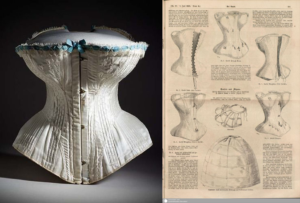
The 1858 silhouette was not quite the layers.. .. and flounces of the prior decade, but not quite the huge skirt with hoop that would come in the next 3 years under the influence of Parisian designer Charles Worth with Empress Eugenie and Victoria embracing it. There were a few years of transition where the huge Renaissance like sleeves and skirt made full by petticoats without structures were indeed a hybrid cross between what was before and what was to come.
This point was the crossroads between early and middle Victorian fashion eras.
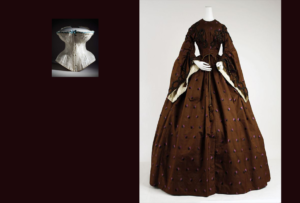
1860’s
The Early 1860’s corset… … moved the organs up and down inside the body, and pushed the breasts high. The improved metals of the busks and grommets made very tight cinching possible to intentionally shape the body, aiming for the smallest waistline possible.
(Photo and sketch: Early 1860’s corset and 1863 corset patent sketches)
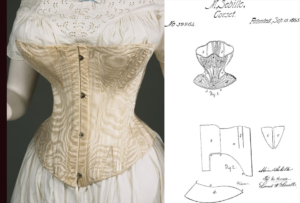
As early Victorian became mid Victorian.. .. in 1860 the crinoline domed skirt silhouette had a flatter front than in the ’50’s and began to show a dramatic leaning towards the back. This silhouette is the easiest to define the change of fashion era.
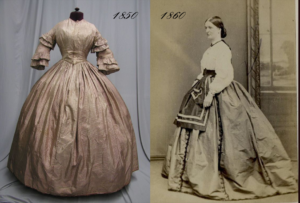
By 1866, a new silhouette was emerging… The new Princess line was a gown cut in one piece with a number of panels fitted and gored from shoulder to hem. It shaped the figure through seaming. The early and mid Victorian style was changing quickly into late/mid Victorian style.
There was no clear line to separate the styles; just the women who wore them as they were introduced caused everyone to take note and follow suit (or gown in this case).
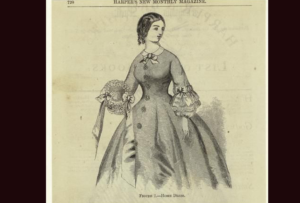
The 1866 silhouette was worn by all… … women and girls (who could afford it). The huge crinoline hoops were still in play and the silhouette was still very wide at the skirt, but flaps and overlays were replacing the layers of flounces of the late 1850’s, in favor of a smoother and more tailored look overall.
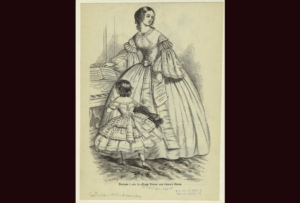
Subtle yes, but changing definitely from the 1850’s.. .. into the mid 1860’s. Historians suggest this might be because women’s roles were changing post Civil War in America. It might also have to do with availability of delicate fabrics and laces and trims in a post-war recovery. One might also guess the flaps and overlayers might have been made from scraps of other dresses to make an old dress seem new after the ravages of war.
(Sketch & extant gown: left 1856, right 1866 – VERY similar at first glance, but construction method and overlays and use of trims are quite different between pre and post Civil War garments)
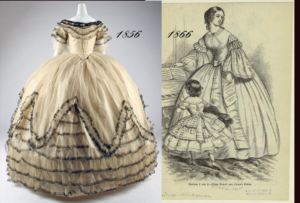
The new Princess Line gave a sleeker… .. more tailored look in the mid-1860’s compared to even the early 1860’s. The difference can clearly be seen in the junction between bodice and skirt. On the later model, there isn’t one. We can see developing the next fashion eras with the cuirasse (armor-like) long bodice of the late 1870’s to come.
(Left: American example 1862 from the MET; right Harper’s Weekly again)
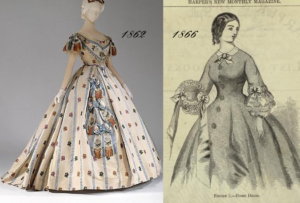
The Gabriel Princess gown had a neat.. .. little white collar. The gown was usually made in gray silk and had the fuller skirt lines of the era. This constrained and buttoned up look is used to represent repressed governesses in Jane Eyre movies and such.
(2017 Oscar for costuming a repressed woman)
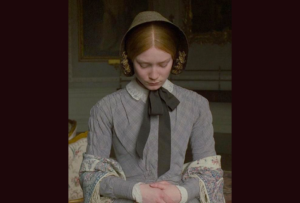
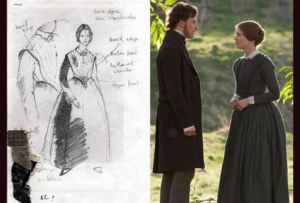
Later Princess styles were… .. slimmer and much more form fitting. Sleeves in day dresses were often of a banana shape.
(photo: 1866 bodice from a 2 piece day dress with banana shaped sleeves)
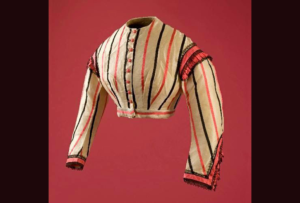
2-pieces became more common for day… .. and casual wear. The later Princess bodice designs still had the seaming as if they were one long piece, plus the very full skirt with hoop, but overall things were tailoring and fitting closer to the body. The banana shape was made by a new cut of the sleeve.
(Photo: 1866 2 piece ribbed silk American day dress of late Princess style)
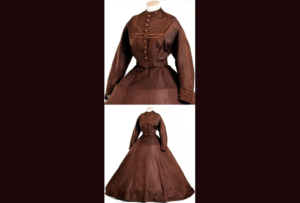
By 1867 the fullness of the back of the skirt.. …was bunched up like the polonaise (curtain) style of the 18th century. Crinolines and cages suddenly disappeared. The tournure or bustle appeared.
(Painting: we sneaked a CAT in again! With an 1866-67 silk skirt too)
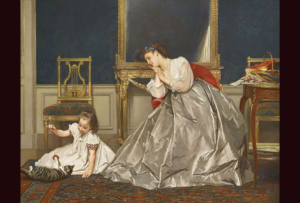
This being the Mid Victorian Era, Queen Victoria… .. both introduced and embraced the new silhouette which still had a full skirt in front, but draping and more fullness in the back.
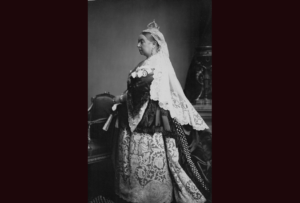
Victoria had the whole royal family… ..by 1868 wearing the full skirts of the late ’60’s with the fullness in the back.
(photo: Queen Victoria with family at Balmorea 1868)
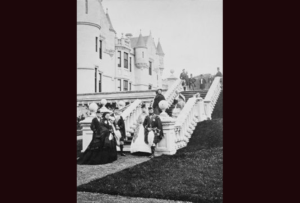
1870’s
Queen Victoria’s mourning dress of 1873… … 12 years after Albert’s 1861 death, showed clearly the back draping and smooth front that was evolving into a full bustle style. Difficult to obtain on a large woman, and better suited to tall, lithe figures like Queen Victoria’s friend Eugenie at the time, the extra frills and ornament not only made an all black ensemble interesting, but worked to “trick the eye” the same way stays had in the 18th century on large women.
(Photo: Victoria in full mourning 1873)
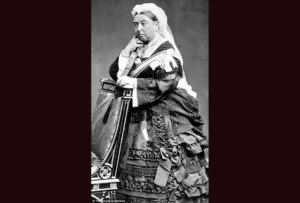
Empress Eugenie in 1873 was.. … just out of exile. As the wife of Napoleon III, she had been imprisoned when Napoleon I was exiled in 1871. Even out of “jail”, she came back to France with the new Princess seam that gave her the smooth, single lined look in front, with fullness in back that would become the new fashion for all by 1874.
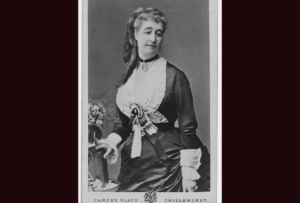
Eugenie hit the fashion world running… … with her designer, Charles Worth leading the way. He had despised the crinolines, and claimed he had invented the polonaise draping, assuming people in 1873 couldn’t remember fashion 100 years before.
(Photo: Eugenie in the long lined Princess seamed look that would become the “natural form” era in a few more years)
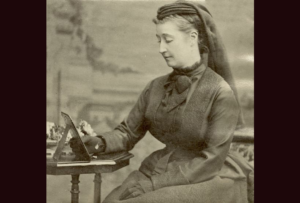
Eugenie, now Empress of France again… … and soon to be wife of the President of the Republic of France, began to add ornament, trim, and frill to the plain smooth princess line of the late 1860’s.
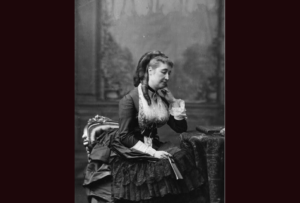
The “new” bustle style looked might familiar… … although Parisian designers claimed it was entirely original. Even the bustle was not original, as 18th century women had worn stuffed rumps and metal wired paniers and bustle like structures very much like those of 1873.
The major difference was fabric type, synthetic dyes, the sewing machine, and mass production; not to forget mass distribution of goods like trims and information like how to build it. The 1870’s had the advantage, and unique features they couldn’t have done in the 18th century… like tightly cinching corsets.
(Fashion plates 1773 vs 1873. Even the colors and textures are the same!)
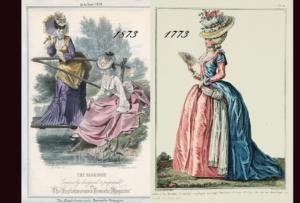
The complex ornament just wasn’t different enough… … from the 1860’s style, so Eugenie of France’s designers add much more in the way of structural support – the bustle.
(Photo: 1874 Eugenie with the first bustle era)
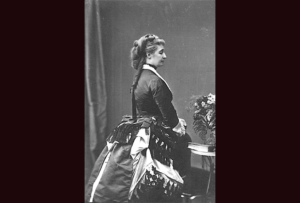
Even into the 1880’s, the “new” fashions… … of high style and Court dress looked very familiar, although the designers of France claimed it to be entirely new.
(Photos: left 1750 silk Court dress with elaborate draping tunic; right 1881 dress Mark Twain’s wife wore to Court)
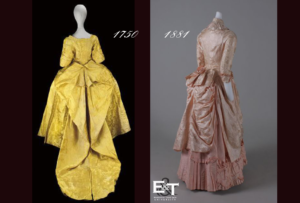
French Designer Worth had introduced the.. .. draped overskirt. His underskirts or linings were in a contrasting color, which was revealed when the draping was pulled back over the rear end. This was considered the “soft bustle” fashion silhouette which lasted in various forms from 1867 to 1875.
(1868 gown with contrasting colors when the draping was turned)
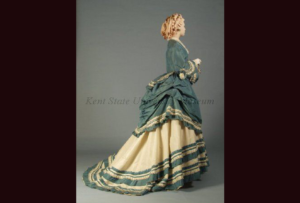
As the 1870’s approached… It still had the shape of the large, ovoid crinoline hoop 1868-1870, but the draping was piling up in back, and the skirt was losing the round fullness in the front.
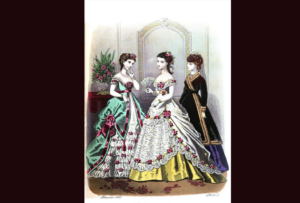
Waistlines began to rise.. ..ever so slightly, and became rounder.
(1868 Gown)
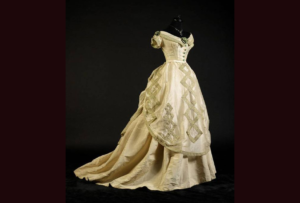
In 1868 there were more overskirts piled on… ..top of the draped fabric in the back over the rear end. They made the woman look like a piece of upholstery.
Other top skirts were called aprons and they were also draped making the wearer look like a piece of elaborate upholstery.
(The 1868 gown had elaborate trimming front AND back.. but it would move around to just the back very soon. Right now it still has the ovoid shape of the mid-Victorian crinoline hoop)
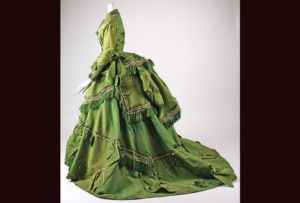
By 1870, ballgowns always had.. .. a train in back, dragging on the floor. By 1873, every day dresses would also have a train.
(1870 ballgown with characteristic contrasting colors, back draping “flipped” over itself to reveal the underside, train, rounded somewhat high waistband, and the new synthetic purple dyes! See last 3 months about dyes)
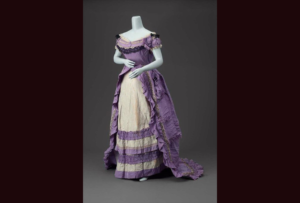
By 1875, every dress had a.. .. train, and the front of the skirt became less ornamented, flatter, and the crinoline was gone.
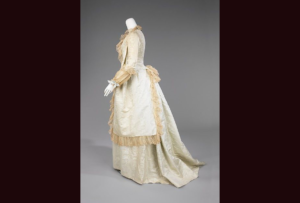
You can see the difference between 1868 and 1875 shapes… … because the skirt and draping had lost the look of an oval shaped crinoline, in favor of a tiered draped and frilled train. The front became plainer, with the entire skirt silhouette much less symmetrical. The trains got more and more ornamented with frills, pleats, ruffles, braids, and fringing
The 1875 bustle evolved out of a gradual transition from draping to a soft “polonaise” style reminiscent of the 18th century.
(Photos: Differences were subtle, but you can see the front getting flatter and more vertical, and the drape becoming higher and fuller towards the small of the back – but all the fringe and decoration was quite the same between 1870 and 1873)
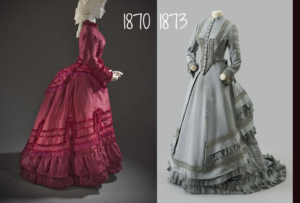
The home sewing machine was to blame.. .. for the copious amounts of detail and trimming. Trim was cheap and readymade and easily available to most women across America in the early 1870’s, as the design of the machine was improving constantly from the original Singer models of 1861.
(Photo: Lecturer on women’s rights, Sojourner Truth in about 1862 with one of the first models of home sewing machines. This was a postcard she sold at her events)
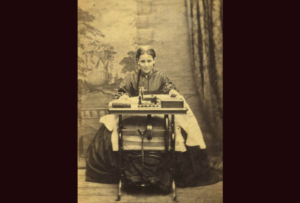
Change was also due to the new synthetic dyes featuring.. .. new intense hues of magenta, purples, blues, and greens. The early 1870’s with a sudden interest by the public in science led to many new inventions at the time.
(Photo: extant dress estimated to be 1873 in the new synthetic purple previously reserved for royalty as purple was expensive and difficult to process using natural dyes (see April posts on the evolution of dyes in this mid-Victorian era)
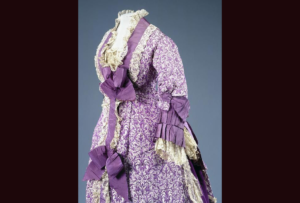
Draping on the back of the skirt got more elaborate.. .. as the decade of 1870 progressed, and then the ornament went to the front of the skirt.
(1870’s garment in museum and fashion magazine sketch from the same time)
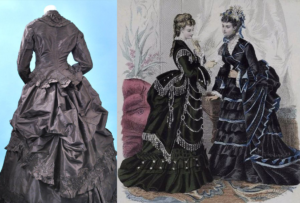
Bustles & Rear Ends
1870’s & 1880’s
Where did the idea for draping the rear end come from? Parisian designers at the time, with wealthy and influential patrons like the Queen of England and Empress of France were certainly initiating the changing styles, but in reality, the world had seen quite a bit of this before.
The various “rump” and “polonaise” styles of the 1780’s reappeared by the 1880’s, although the latter would add a train and more on the bottom. One can only guess that was because a decade later, fabric, trim, and clothing was much cheaper and easier to obtain – plus fabric was wider than the 22-26″ available in the 18th century, so the 19th century designers could put a lot more back there.
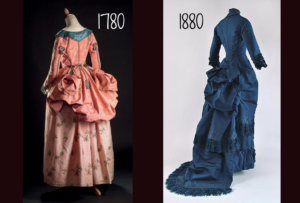
In the 1780’s fullness over the rear was made by.. .. a false “rump”, almost always some stadium cushion like pillow over the rear end. While the earlier 18th century “farthingale” (think bicycle rim around your waist) was metal and structured, it was not nearly the engineering accomplishment of the many types of early bustles in the first bustle era leading to 1880.
(Photos: modern reproduction of a 1780’s false rump vs. extant 1880-81 metal and cotton tape bustle).
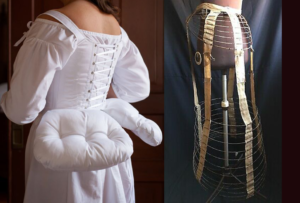
Invention of the bustle allowed more and heavier fabric.. .. to be hung over the rear than could a simple stuffed pad, thus allowing long trains and skirts that dragged. The early bustles were “crinolettes”, which still had pads over the rear end, but added metal loops covered with fabric. Early crinolettes were specifically designed to just hold the fabric away from the legs so a woman could walk.
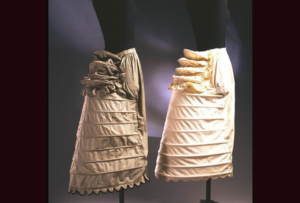
As draping and trim got heavier and more numerous.. … the “crinolette” evolved away from just keeping the drapes away from the back of the legs, into a shaping structure in themselves. Different designs accomplished different things; a crinolette, still considered a transition between the earlier crinoline and the bustle to come, was getting stronger and stiffer.
They were still rather light in weight and not strong enough for the heavier fabrics like this 1872 crinolette or early bustled hoop cage.
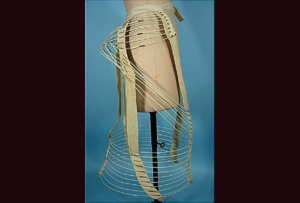
They were called “bustle cages”, as they got… .. heavier, stiffer, and began to form the shape of the dress. This was called the “first bustle era” which would come and go pretty quickly between the mid 1870’s until about 1879 when they would disappear in favor of lightweight “tournures” during the natural form era, and then reappear as the huge “horse rear end” 3rd bustle era.
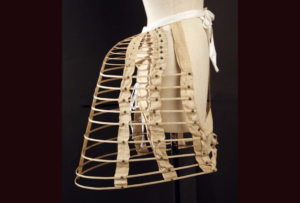
There were 3 bustle eras, with an “in between”… .. when light understructures and draping slimmed down the silhouette for about 3 years. The “natural form” era between the mid-1870’s 1st bustle era, and the 2nd one only looked good on long, tall, lean, and young women, so didn’t last very long, although this is the style most often depicted in movies and shows about the “Wild West”.
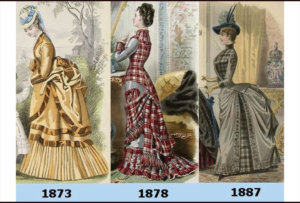
We’ve been discussing what defines Early & Mid Victorian.. .. fashion. So far we have discussed the corset (longer, cinching, different shape), the skirt (becoming assymetrical with fullness in the back and a smooth front), dyes (synthetic), methods (in home sewing machine), and designers (“Haute Couture” out of Paris creating “new” lines under directives of royalty like Eugenie of France influencing Victoria of England).
We also discussed culture – differences in Europe and America with class distinction, and sources – where did fabrics, trims, ideas come from.
Now we’ll go straight to the silhouettes and elements that make them.
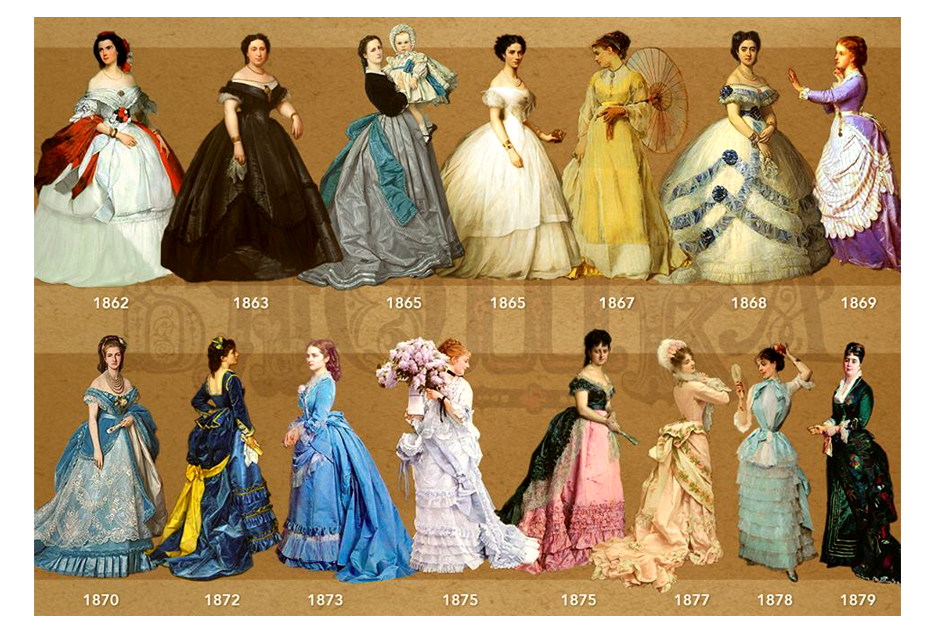
A Silhouette is the recognizable shape of fashion… .. as it changes. It is not exactly a black line drawing as we show here because it is in 3 dimensions (heighth, width, length) with subtle variables – but historians can place them through the most distinguishing characteristics.
Regard yesterday’s post with drawings of women, and compare to today’s picture silhouettes. You note that just in 2 short decades, in the middle of the Victorian fashion era, the silhouette was very easy to distinguish and changed quite drastically.
This period from the early 1870’s to the late 1880’s is probably the most confusing in American history because fashion went from the huge crinolines to the bustle to nothing at all to an even bigger bustle before it suddenly disappeared in a “puff of smoke”.
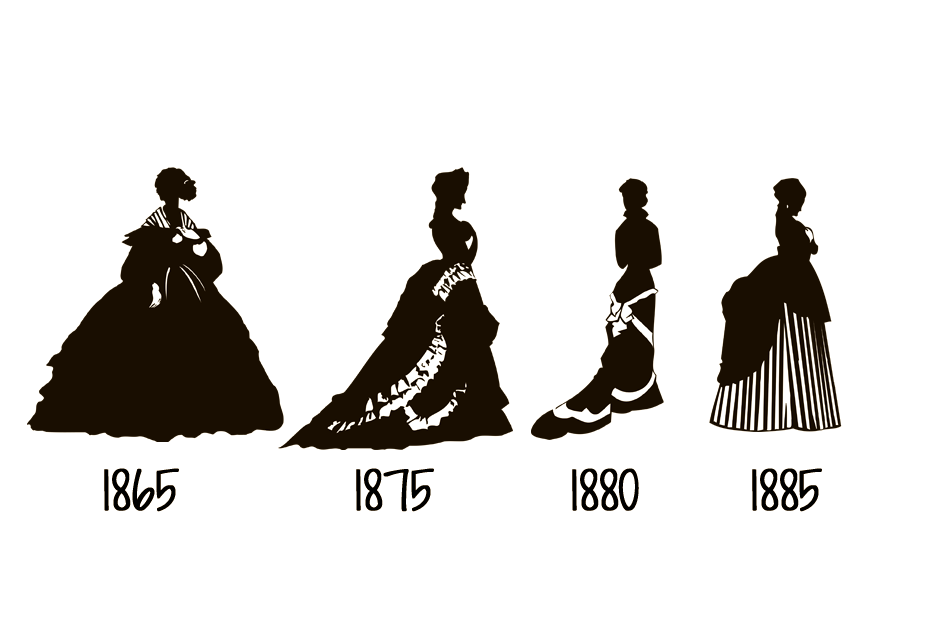
Along with the changing shape of skirts & draping… …The other main feature of the style change was the introduction of the cuirasse bodice which dipped front and back extending a little over the hips. By 1880 the soft bustle styles of the 1870s had totally disappeared.
See in these fashion plates (left 1875, right 1878) how the bodice goes from sitting on the waist to clinging to the waist plus the hips below.
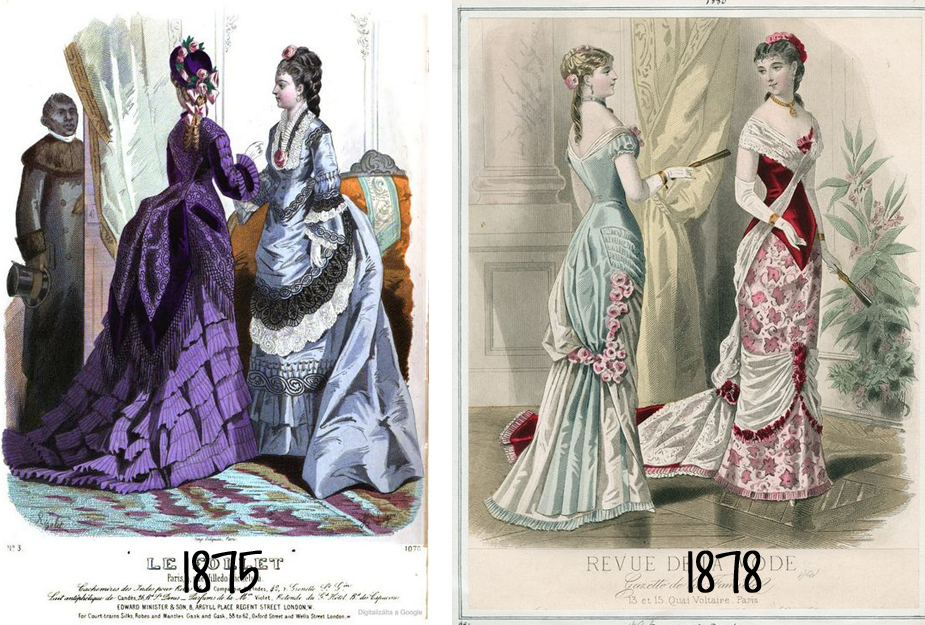
Between 1878 and 1880 the bodice… .. was becoming more form fitted, clung more to the hips, and seemed to integrate the skirts into the bodice, although they were still 3 parts: bodice, skirt, drape/tunic. This “armor like” bodice defined a brief 2-4 year period called “Natural Form”.
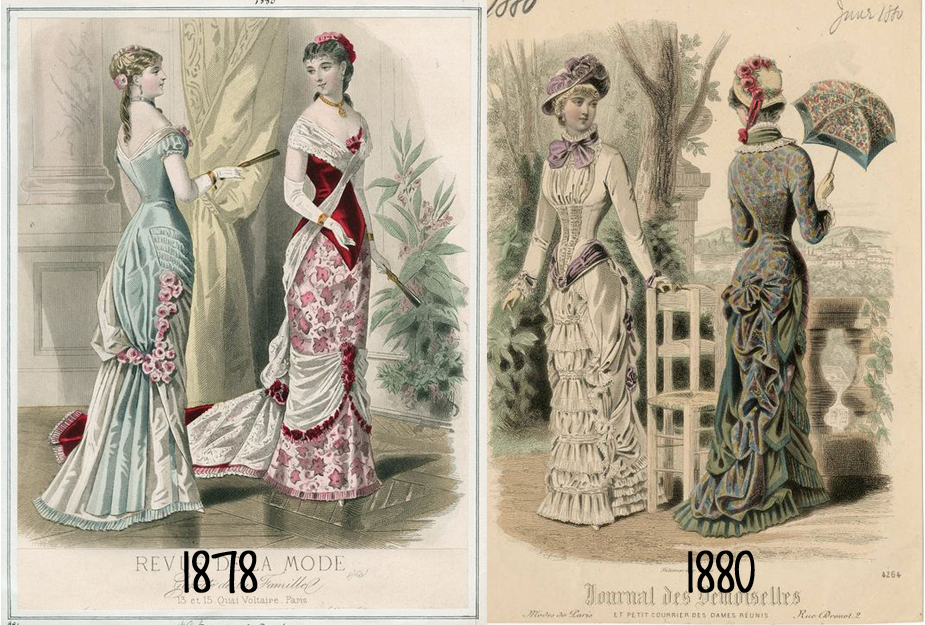
By 1885 the “unnatural” structures would be back… … and the “Natural Form” era which only looked good on long, slim, and young women, would be over. The 2nd “large bustle” era would last only a decade or so. As with any fashion era, there is no distinct line between one or the other, because just like today’s women, some would hang on to the older fashions, while others would embrace the new.
The date of a fashion Silhouette was given by historians when the key characteristics were predominant in fashion periodicals (such as these we are showing) announcing the new style for women to adopt, or when it was implemented by key fashion figures such as queens and empresses; thus the naming of “Victorian Era”, etc.
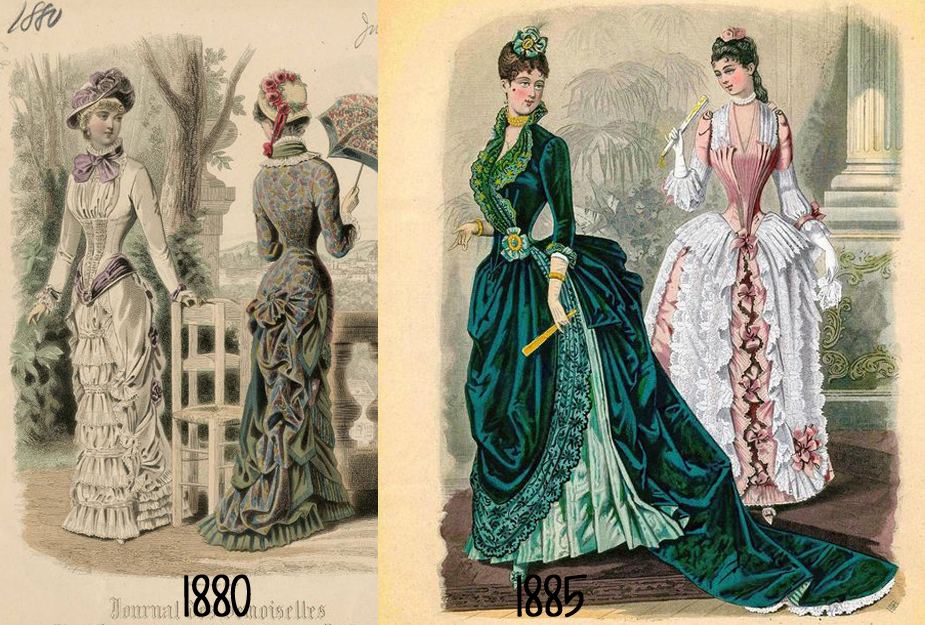
Interestingly there was no “Eugenian” fashion era… .. even though Queen Victoria of England, for whom the fashion eras from the start of her reign in 1837 until her death in 1902 was the namesake, was good friends with Eugenie of France (Empress, then wife of the President through France’s changing political structure).
Eugenie and her key Parisian designer – Charles Worth (and others) were responsible for creating the concepts, although Victoria is credited with the marketing and spread of fashion, especially to American women. (see earlier blogs about Eugenie and Worth).
(Painting: Queen Victoria visits Eugenie and her husband Napoleon III in France)
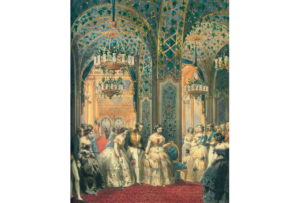
The 1878 Cuirasse Bodice… .. as the new, long “armor-like” bodice was called, gave a clear and visual difference between the early and mid Victorian Eras, and what was evolving to become Late Victorian.
Sketch: cuirasse (“curass” or “sheath”) bodice covered the torso, waist, and hips. This one 1879-80, it started in about 1878
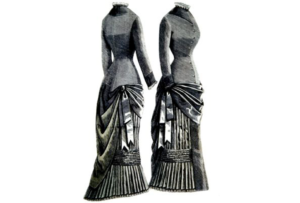
The natural form “cuirasse” style… .. was very expensive as it demanded a high level of skills by the dressmaker to get the body-tight fit, was made of fine fabrics and trims, and was structured much like the corsets of the era including boning and special seaming and reinforcements to hold up to rigors of daily wear.
(1878 into 79 spring fashion plate for daily wear in the Cuirasse bodice and princess line)
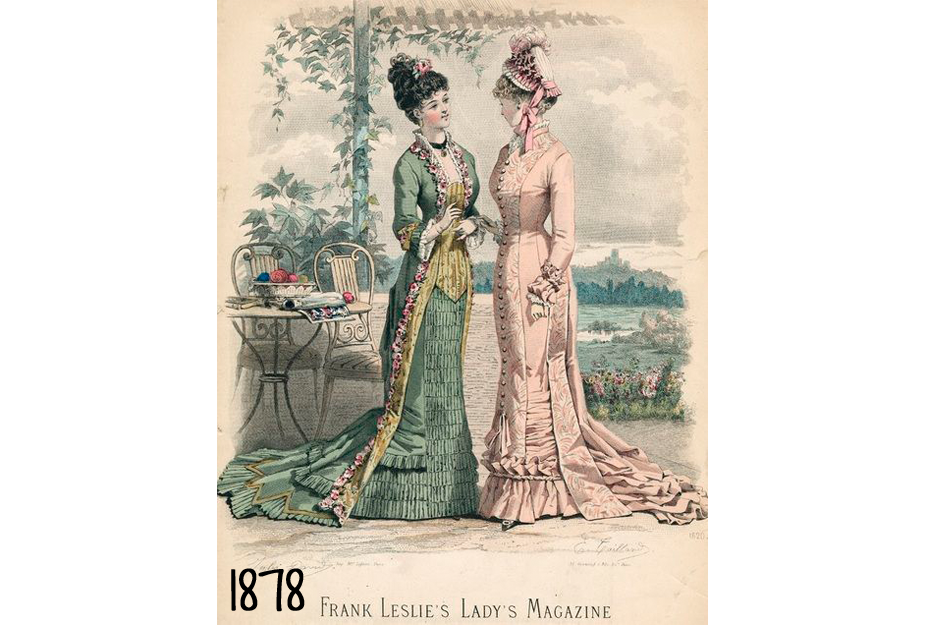
Enter a new fashion icon for American women… … Princess Alexandra of Russia who looked beautiful in the long, slim line of the “Natural Form” era with its fitted bodice, expensive draping, and beautiful fabrics. At the peak of her political power, Alexandra gave the name of this shape/Silhouette the “Princess Line”.
(Painting: Alexandra with her family in 1878)
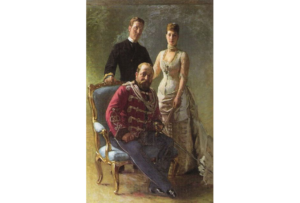
Alexandra’s “Princess Line”.. .. had a “sheath” or “cuirasse” bodice line that was even longer than the early ones. It now had no waist seam and the bodice and skirt were cut in one – unlike any other garment previous which was always at least two pieces – bodice and skirt.
(Photos: left, 2-piece with cuirasse bodice or sheath bodice; right, the “new” Princess line of 1880 with bodice and skirt cut as one)
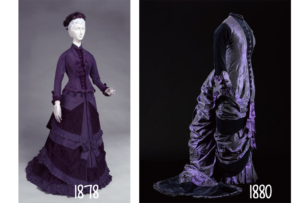

1880’s – Big Women; Changing Roles & Silhouettes
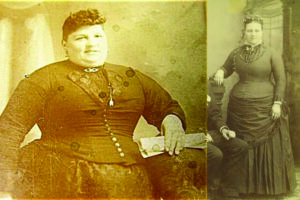
As with any fashion era, there is no exact line where one stops and another begins. Women wore the “old” fashions well into “new” eras, and concepts and parts were carried forward from old into new. As we noted, there were 5 distinct factors distinguishing the early Victorian era from the Middle Victorian. There were no distinct factors defining Middle from Late, so historians appear to pick whichever suits their interpretive purposes.
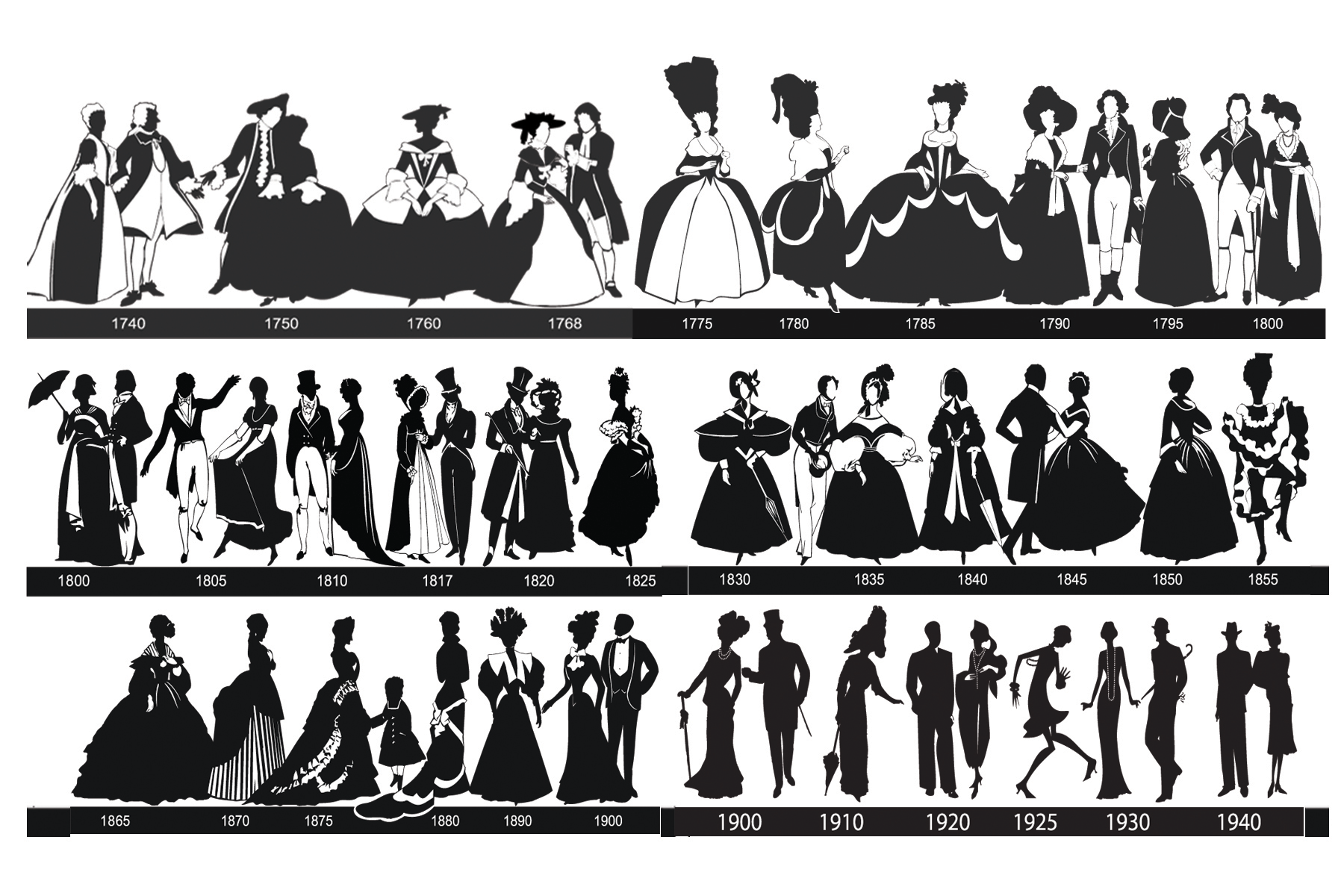
For us, we make this break at the beginning of the large bustle era in approximately 1881-83. This is more because the roles of women were changing as they gained empowerment, property, rights, and access to jobs and the world outside the home. Culturally in America, these things would accelerate at a profound rate alongside technological advances, increased communication, and the approach of an Industrial Revolution.
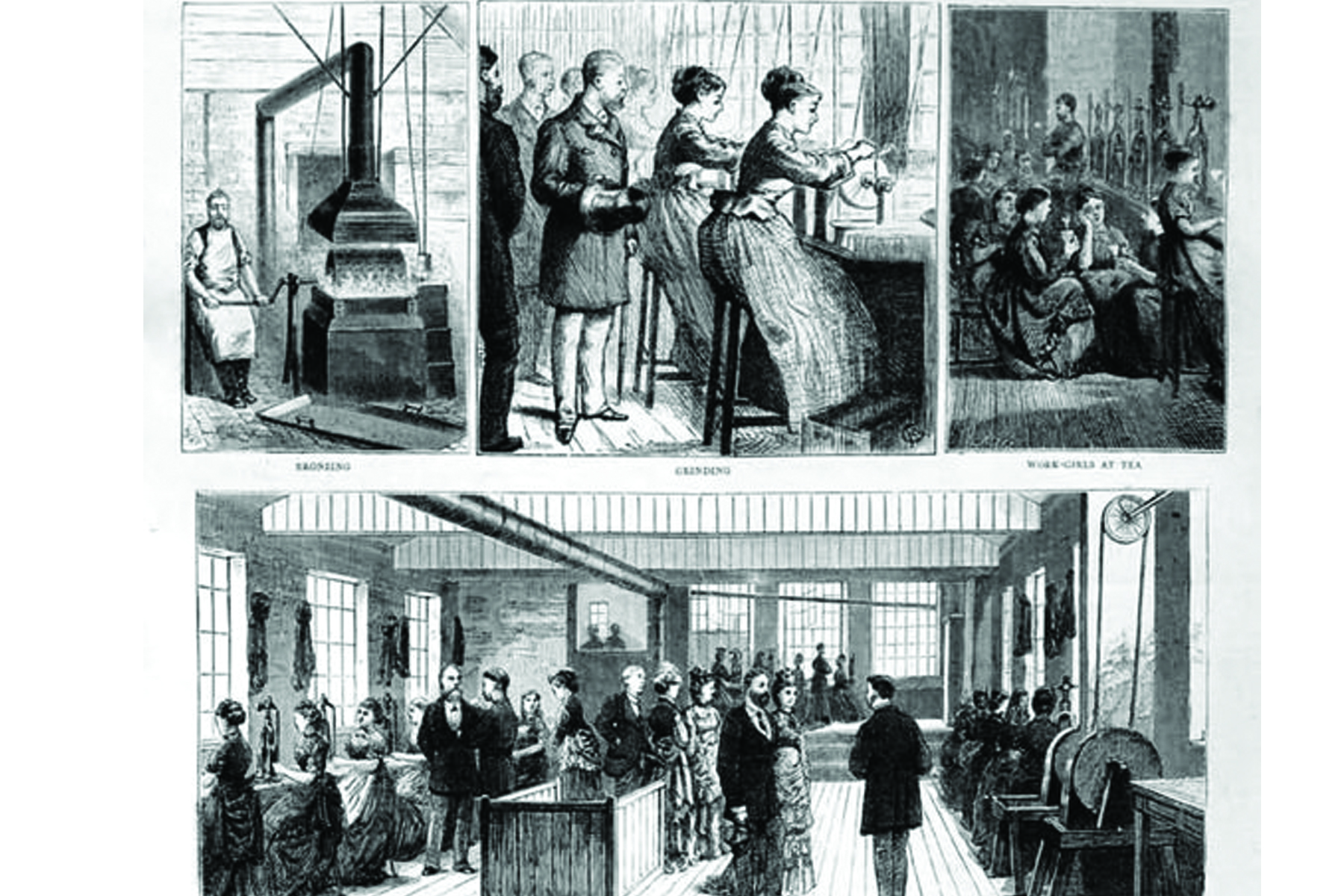
These factors we leave for a different discussion as they involve the emigration patterns, employment, roles, and situations of women as well as the socio-economic situation in America at the time. For purposes of this discussion, we will leave it that the big woman of the 1880’s reflected and was created by their situation in the US at the time.
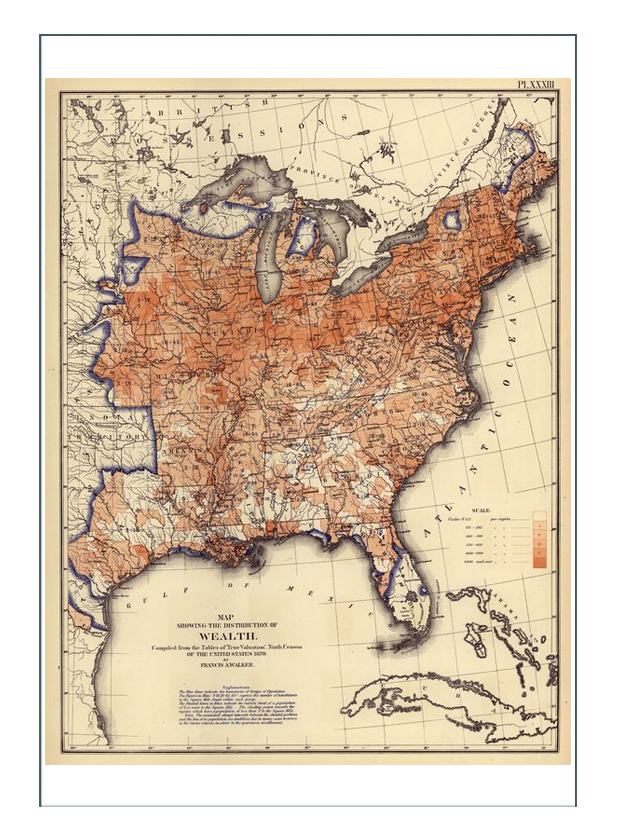
With just a 2 year difference, the fashion silhouette changed at the end of the 1870’s drastically with the Princess Line, where the dress and bodice were cut as one. This demanded very wide and durable fabrics to sustain both the elaborate draping of the skirt, and the heavy built in structures like a corset into the bodice. They also had to be draped on the body to get the exact fit, making this a hard to reach fashion ideal, worn best by royalty and those with the means to pay for it.
(Example: cuirasse bodice of 1879-80 switches suddenly to the Princess line in 1880-82)
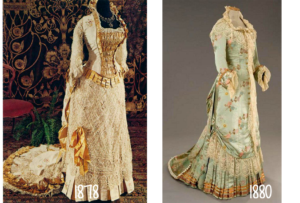
By 1878 the cuirasse bodice had reached… … the thighs. It was like a very long corset and went even lower in center front and center back, extending well down the hips creating the look of a body encased in armor.
(Photo: cuirasse from 1878)
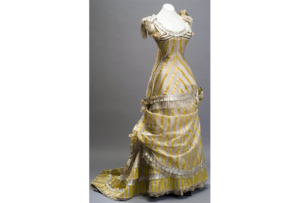
The ideas merged in 1880.. .. so that the idea of the Princess line (bodice cut in one long piece with single vertical panels from shoulder to hem) and the Cuirasse Bodice (armor tight skin fitted bodice almost to the knees and over the rear) made a very slim and elongated silhouette.
(Sketch: the 1879-80 silhouette)
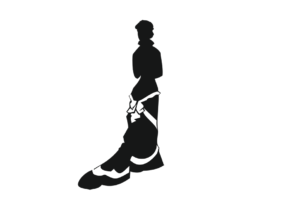
The long, slim line was emphasized by… .. long trains on the back of the skirt – even for day wear. These were sometimes integrated into the draping of the skirt, and sometimes detachable. The petticoats underneath we designed to enhance the silhouette.
(Photo: extant 1878 gown with full train)
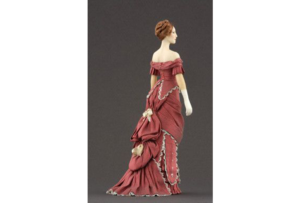
A tournure or bustle pad was the right thing… .. to wear with the new form, as the small bustle which had been used for a few years prior, were not needed with the cuirasse or Princess sheath dresses, but a small pad or “tournure” helped lift the trims, draping, bows, and frills in the back over the rear end so that they would drape more elegantly.
(Photo: reproduction tournure from the 1879 era)
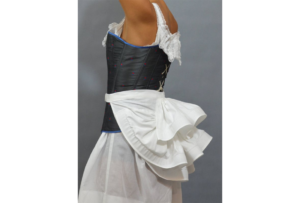
There were many types of ruffled… … petticoats with and without trains. Each had a specific way of lifting the skirt. Some were stiffer to lift up heavy fabrics like wool or linen, while most were fairly light in weight using just layers of ruffles or thin twisting strips of horsehair in cotton (a “tournure” in French) to give a light support. Most just used a rump pad much like had been used in the 18th century to make rear ends look bigger.
(Shown: ruffled petticoat and supportive tournure)
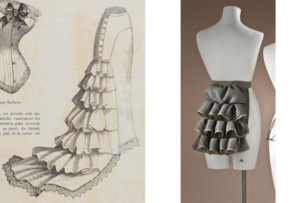
Note the position of the fullness changed… … lower to almost the knees when the cuirasse bodice and Princess sheath took over the fashion ideal. The lifting tournures and bustles of the mid 1870’s suddenly shifted to a lower position around 1880 so the fullness was not specifically over the rear end (although decoration and draping gave fullness there) for the undergarments.
This is the noteworthy feature which designates a short 3 year and short lived period called “Natural Form”.
(photo: modern interpretation of Natural Form style showing the low draping and fullness in the back)
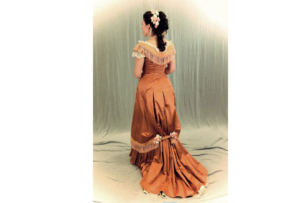
It is easy to get confused, as there was a bustle era.. … then no bustle (“Natural Form”) and then bustles again. During all the times, ALL fashion aimed for the same silhouettes. That makes it hard for us today to determine which is which, since a tailored walking dress or riding suit of 1879 would have the same features, design, and construction, but might look completely different than a ball gown.
Whenever defining a date of an ensemble. Look for the construction. In this we look for the structured long bodice through the waist and down to the knees with a single vertical paneled seaming – regardless of whether it is split as with a riding jacket, or full as with a ball gown.
(Sketches: 1880 walking dress vs theater ensemble)
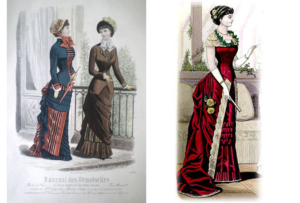
The 1880 silhouette, made by the… .. new Princess line and the Cuirasse bodice combined, was a sleek and slim look and required professional dressmaking skills to get a flattering fit. When done well and fit correctly it was gorgeous, but most women just had swaths of fabric wrapped and arranged across the garment to hide dressmaking flaws.
(1880 gowns: (left) fabric to hide the flaws, (right) lovely fit)
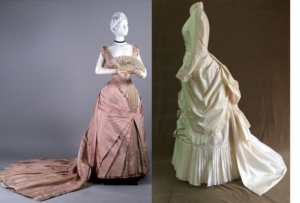
The slim lines of 1879-80 were only really good… … for very slim women and those who did not have to work. It took time to get into, was difficult to move in, and required yards and yards of expensive fabrics and trims to get the look right. It was a look for young and tall women, and lasted barely 3 years because of the cost, difficult to wear, and complete lack of function.
(Photo: modern interpreter in 1879 reproduction gown. Can you imagine anyone actually doing ANYTHING wearing this? Even eating and walking would seem to be difficult.)
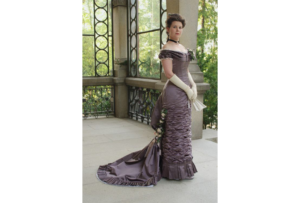
For some reason, Western movies like Natural Form fashion.. .. and the late 1870’s to early 1880’s time frame for their depictions. It is likely because those were the days when Wyatt Earp and brothers were at the peak of fame, or because it was the time of cattlemen range wars.
Caroline Lockhart, famous Western novelist from Cody, Wyoming, wrote her stories about real people in her real time (1910’s) in reaction to all the favorite writers of the day like Zane Grey telling the same tales of 1880 with the good guy in the white hat and the bad guy in the black.
(Photos: Natural form in Western “high fashion” in “Deadwood” with proper corsetry (left), and a farmer’s daughter interpretation of the same in we don’t know which movie (right)
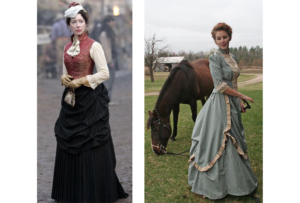
Some of the newest Westerns just out.. .. like “The Lone Ranger”, have taken their 1880 depictions to extreme. In a world of fantasy costuming, though, saloon girls can dress like ladies, and ladies can paint themselves like saloon girls. They don’t have to be historicallly correct.
(Photos: can you now pick out the historical accuracies and inaccuracies of these late Victorian saloon girl ensembles in “The Lone Ranger”?)
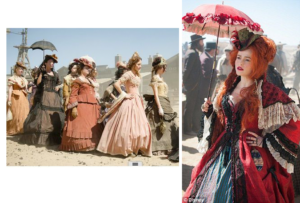
And some of the older Western movies like… … the Wild Wild West of 1999 which take place in the Natural Form Era (around 1880), were quite a bit off the mark. Like many of the Westerns of the 1940’s, it appears instead of a corset or a heavily boned cuirasse bodice, she is wearing a spandex body girdle under her allegedly historically accurate ensemble.
(Photo: leading lady of the Wild Wild West movie of 1999)
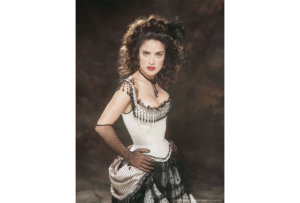
One of our favorite Western movies for historical accuracy though. … is the 1993 “Tombstone” with Kurt Russel. Not only are the character depictions spot on (wives are sedate in homemade goods, while the rich actress is in high fashion silks with copious trims), but they even have the undergarments fitted as the characters would. The “regular women” wear “every day clothes” with some fitted better than others, while the “high fashion women” are flawless in design and accurate detail.
(Photos: Leading women of “Tombstone” 1993. Character defined through costuming: wives (left and below), actress (right))
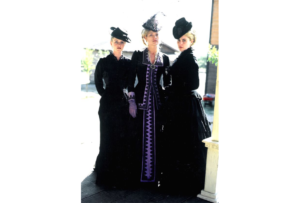
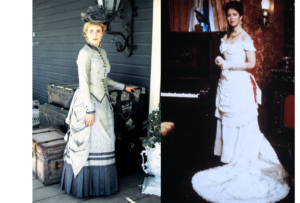
In the movie “Tombstone”, the dead on accuracy… … of the men in shooting and the women’s ensembles is legendary. In one of the opening scenes, you can see the leading ladies wearing the long, single seamed Princess dress of 1878-79 before it merged with the Cuirasse bodice that made it armour like (which the high fashion characters wore).
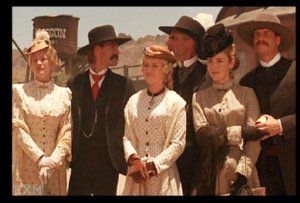
It’s still fun to watch old Westerns like Gunsmoke.. .. where, in spite of her corsetless shape and historical inaccuracies, you’ve still gotta love a woman like Kitty who runs her own business wearing form fitting Natural Era made out of rayon and spandex.
(Photos: Miss Kitty and the gang in about 1956 TV series “Gunsmoke”)
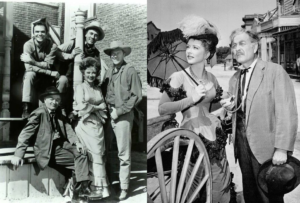
And we must give credit to outstanding Natural Era designers… .. from other genres of film and TV, like this gorgeous ensemble by designer Joan Bergin, worn by Scarlett Johannson in “The Prestige”.
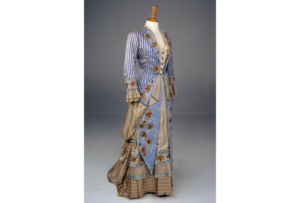
Also honoring the outstanding design work of… …Gabriella Pescucci for “The Age of Innocence” gowns for Wynona Ryder. One can clearly define each year as the show progresses from 1878 into the 1880’s. The skirts and draping are the keys to date identification.
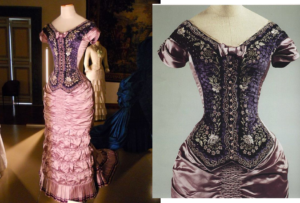
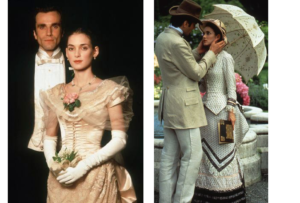
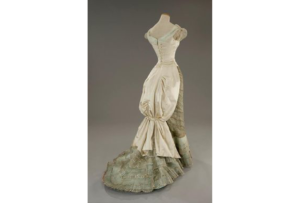
And one last nod to the “Penny Dreadful”… …Showtime series with Mrs. Eva on set.
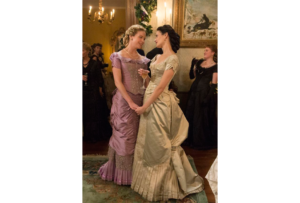

How to tell the Late Victorian & Bustle Eras Apart
Back to work now.. we have been discussing Natural Form.. .. and how the Mid-Victorian Fashion changed drastically between the early 1870’s and the early 1880’s, covering the 1st bustle era with its various shapes and drapes and structures, then no bustle (Natural Form), and now as the bustle reappears larger than ever.
To figure out the date on a historical garment, the best clues are:
- location and type of draping
- seam construction of the bodice
- shape, especially symmetry or assymetry of the skirt
- the corset (what does it DO?)
(Sketches: review of the Mid and Late Victorian Silhouettes we’ve been discussing, and are headed for)
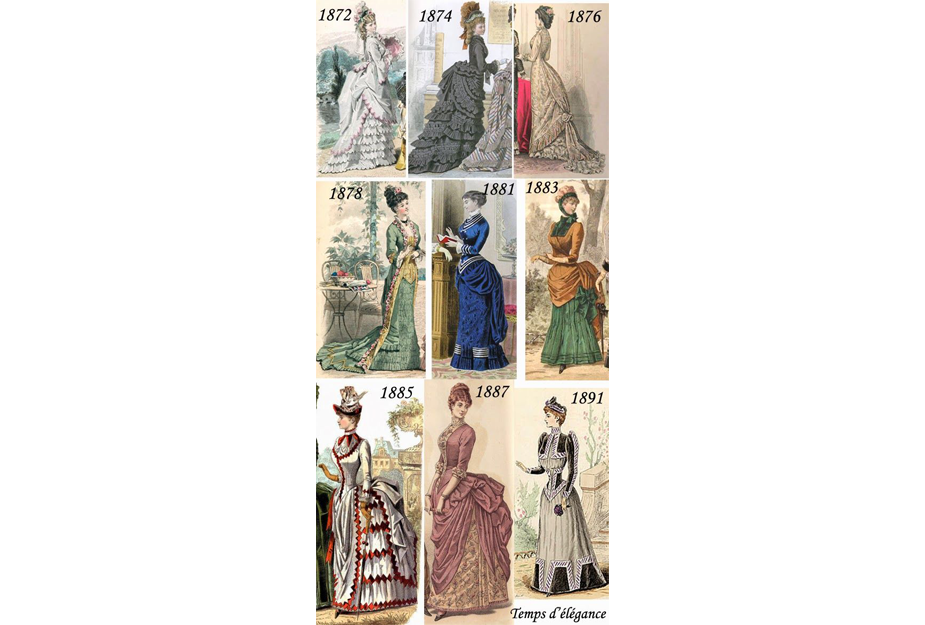
Quick Review of Victorian fashion… The Victorian Era started officially in 1837 when Queen Victoria of England was crowned and took over as leader of world fashion, knocking the French off that pedestal.
That Early Era that took the Regency Fashion concepts of 1800-1828 and made the skirts bigger, the corsets tighter, and the bodice lower and longer, evolved through the 1840’s an 1850’s. Suddenly in the 1850’s the hoop or crinoline was designed by Parisian designers, and carried to Victoria by her buddy Eugenie – thus the French took over the fashion lead again.
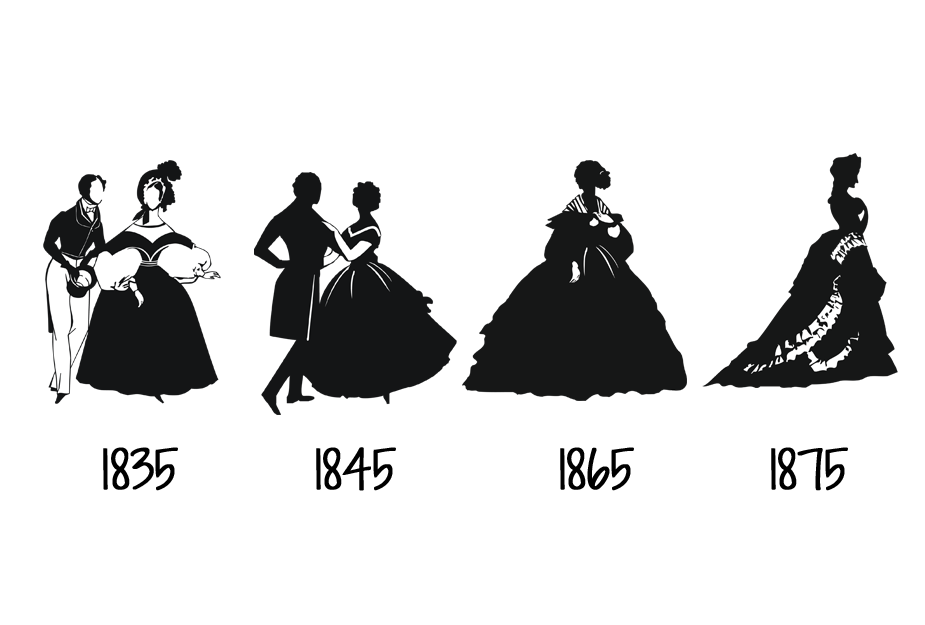
And Mid-Victorian quick review.. By the early 1860’s, under the innovations of Charles Worth, Eugenie’s designer and a whole variety of cultural and economic factors including Victoria’s desire to help her lower classes by manufacturing everythin in England, and Eugenie’s desire to have everything made in France – the crinoline hoop became huge.
1862-1865, the peak of America’s Civil War was also the peak of the huge skirt.
(Portrait: Maria Feodorovna of Russia in Mid Victorian style)
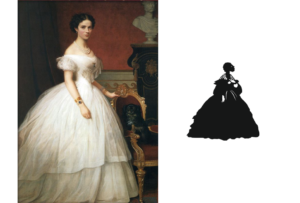
Late Mid-Victorian (Gilded Age, Reconstruction) review.. After the Civil War, Americans were obsessed with science and technology – bringing the sewing machine to common use and new synthetic dyes along with exponentially increased improvements in the textile and garment production industries. World wide trade and the full access to the Asias had the Middle Victorian Era full of new ideas that could be gotten for cheap.
The crinoline evolved into the first bustle era, the smaller ones like tournures and wire and tape bustles or padded rumps from about 1873-1877 (during America’s reconstruction where there was a “high low” class disparity in the “Gilded Age”) when suddenly all understructures disappeared during the “Natural Form Era” for about 3 years.
Garment construction changed to the long lines and lean fronts of the Princess and Cuirasse silhouettes. Much of that was due to easier and cheaper access to fabrics and trims, plus the home sewing machine.
(Sketch: mid-1870’s “Gilded Age” a great time for some, while for others it was a struggle and fashion reflected it)
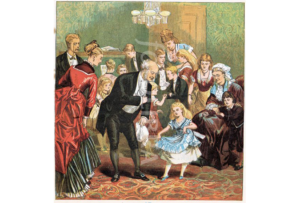
That takes us to 1883 America, where we find women.. .. working at their home sewing machines, buying undergarments and materials from catalogs, and copying the styles of the Queen of England at the beginning of the “3rd Bustle” or “Hard Bustle”, or “Horse Rear End” bustle era which signaled the start of the Late Victorian Era.
(Cartoon: Authentic French humorists of the 1870’s and 1880’s poke fun (pardon the pun) at the bustle eras in a warped way)
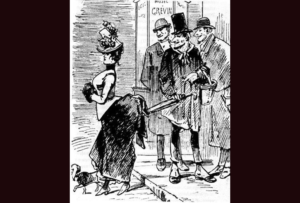
The new Bustle Era of 1883… … All of a sudden, seemingly out of nowhere, in 1883, every woman had to wear a huge, shelf like structure jutting out of her rear end like the back of a horse.
The style had been shown by fashion houses of Paris in 1880 in response to women not liking the Natural Form with it’s long slender and lean (expensive) form. This new type of bustle was much different that the two earlier bustle (and “non bustle” Natural Form) eras of the 1870’s. It depended on built structure underneath, which meant the layers and layers of draping and fabric used before, could be dispensed with.
(Sketch left: 1880 French fashion plate; Photo right: how it came out in reality in an afternoon silk taffeta walking dress 1883)
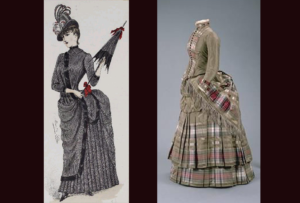
The new gigantic bustle of 1883… .. was worn with a dress that had much less drapery and fabric than the many decades before. While the structure was huge, the dress itself was slimmer, more fitted to the body, and the bodices was much more severely tailored to fit than those of 1879-1882.
(Sketches: Both from “Godey’s Lady’s Book”, (left) 1881 heavy draping vs (right) the new BIG bustle in 1884)
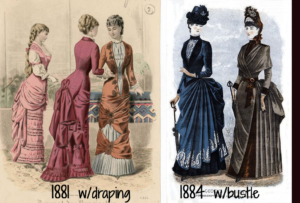
The new bustle dress of the early 1880’s… .. with its very fitted bodice had a Princess line meaning it was cut in long panels from top to bottom. The front overall was much flatter because of the panels. What drapery there was, went to the front and hung like a tidy apron.
(Photo: extant early 1880’s cuirasse bodice with Princess Line)
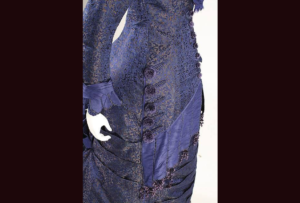
The little front Apron drape of 1883… .. would disappear as the 1880’s progressed.
(Photos: extant 1883 with front drapes (left) vs the new smooth line of 1885-86 (right))
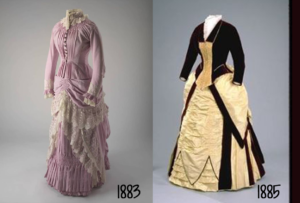
How to tell the difference between the 1870 & 1883 bustles is difficult, especially since there was crossover. The crossover happened largely because the new style was being introduced while most women were still wearing the old styles everywhere else. The style was definitely and intentionally being initiated by fashion designers in France.
1) Check the shape of the structure. The early ones were worn mostly 1870 – 1875. The 2nd 1883-1890 (although most had disappeared by 1886), but the 2nd ones had been introduced in Paris in 1880.
2) Check the hairstyle.
(Early 1880’s French cartoon: satirists were confused with the bustle eras, but mostly they just wondered.. “why…?”)
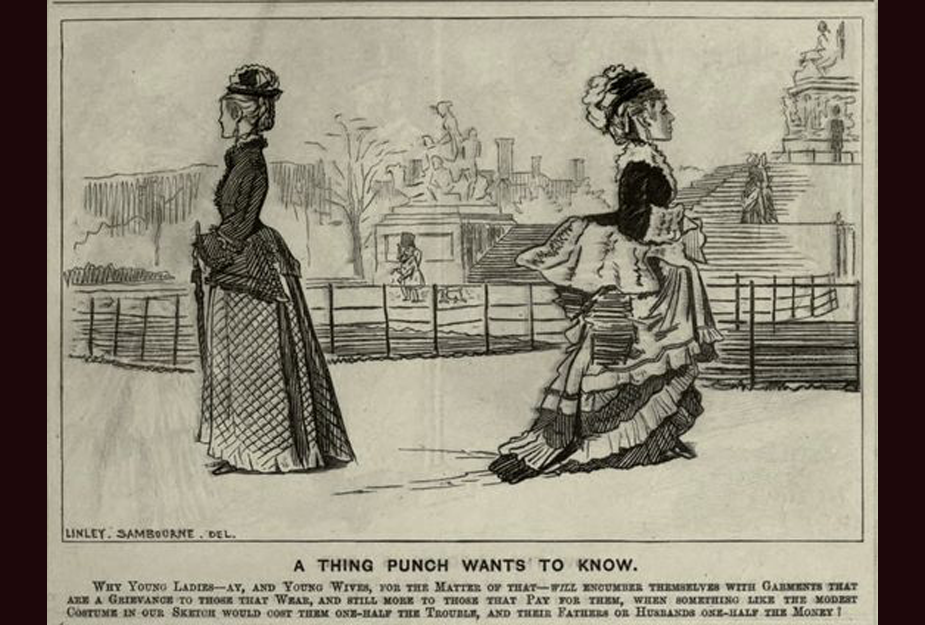
The hairstyle will tell you whether it’s an early or late bustle… .. Hair in the 1870’s was soft, with ringlets and braids. It had a vertical orientation and was piled vertically high to hold the bonnet which was precariously tipped forward. It was left to fall artistically and arranged to be romantic and alluring. This was one of the biggest eras for wearing false hair; extensions, pads, wigs, and braids and plaits.
Hair of the 1880’s was tamped down, coiled, and neatly piled on top of the head. If it was curled, the curls were tight and tightly to the head. There was some “frizz” along the face to soften the severity, but it was not nearly so “romantic”
(Hairstyles: (left) 1874; (right) 1883)
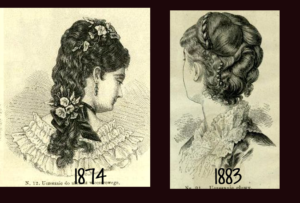
The 1870’s “1st Bustle” started from… … French designers intentionally to create something as different from the crinoline as they could get, and to take advantage of the cheap and abundant fabrics and trims.
By draping techniques, designers pull the large amounts of fabric previously used in the huge round skirt and pulled it to the back. The crinoline had already begun to elongate towards the back, so it was a logical next step.
The surplus fabric was draped and the shape was made by tapes and buttons sewn into the skirt.
To support the weight of the large amount of fabric, the small crinoline of the prior fashion era was brought back, and instead of horsehair and tape, it was made from a steel frame that hung around the waist. In some situations the “tournure” which was twisting layers of horsehair was used in flounces to support the weight of the back of the skirt.
By the mid 1870’s the crinoline was discarded altogether in favor of this “1st bustle”.
(Sketch: wired petticoat or mid 1870’s transition from the elongated large crinoline into the first bustles)
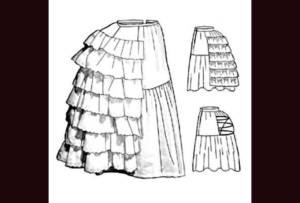
The 1870’s bustle can be distinguished from the 1883 by… .. looking at the fullness in the front of the dress. With the 1870’s style of bustle (or “tournure”), the drapery hanging over the bustle went almost completely down the front, or had the apron effect of draping. As it evolved the front drape became more a part of the skirt while the weight – visual and actual – started to pull to the back.
(Photos: extant ensembles (left) 1878 draping vs (right) 1881. Similar but subtle changes in the intent of the drape)
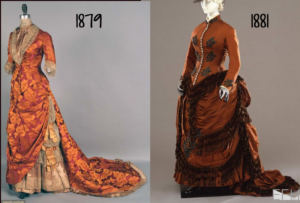
The slim Natural Form dresses of 1875-1883… … actually did have structural support in the form of “trained ruffled petticoats” to help carry the weight of so much draping.
For women who were not slim and tall in these years, the “Tea Gown” became a popular alternate choice. It was a flowing type of robe that was not fitted at all.
(Photos: museum examples of 1878 “Tea Gowns” for older and larger women of the Natural Form Era)
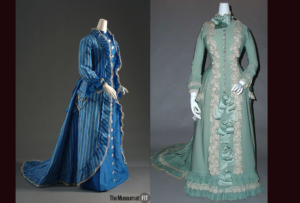
The 1883 bustle was first made of.. … a straw filled cushion sewn into the skirt, with a series of steel half hoops inserted into the skirt lining all the way to the ground. This threw the skirt way out horizontally from the waist.
(Sketch: Many bustles of the late 1870’s through 1880’s. Straw filled skirt with hoops noted)
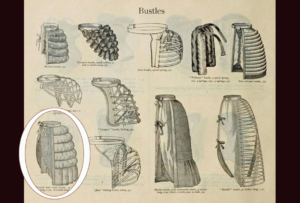
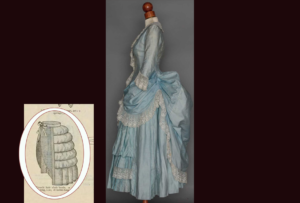
With the 1883 bustle, drapery moved to the… ..sides, or to the front panel of the skirt for daily wear. Ballgowns were more draped and similar to the prior era.
To recognize this later bustle, look for a smoother and more shelf like shape over the rear end being worn with a very tailored and quite structured square shouldered bodice.
Also check that the hair is tighter and less free around the head with no ringlets and braids pinned up. The hair of the large bustle era looks quite a bit like that of the 1890’s-1900.
(Sketch & Photo: (left) 1883 typical draping for walking dress; (right) same for 1885 – getting larger)
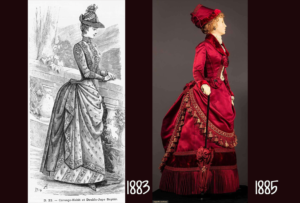
The other real difference between 1870 & 1883 bustles.. .. is that in 1883-90, the dress was made of plush fabrics like velveteen, plushette, and sateen. There was a depression in 1880-90 in Europe, so even women of wealth used cheap, mass produced fabrics and trims.
Regardless of the fabric or trim, the idea for all classes and status was to have an armorlike bodice with severe tailoring.
(Photo: The 1883 day dress has copious trim with mass produced (and often garrish by today’s standards) fabrics like purple leopard spots)
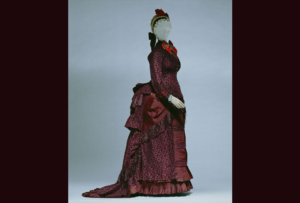
Victorian high fashion designer Charles Worth.. .. in Paris (discussed in detail earlier this summer during the “mid-Victorian” era section) was leading the bustle styles and the use of fabric and trims. Designing for key fashion influencers such as French, English, and Russian royalty throughout the mid to late Victorian era, the Worth House of Fashion in Paris set the trend for all to follow.
(Photos: House of Worth day dresses (left) 1874 and (right) 1883 show how the French designer elongated the bodice and fit it closer to the body. While the draping appears to be the same, in reality the early bustle era shaping was done by fabric and trim, while later there was some serious carpentry making the shape.)
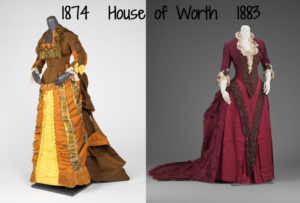
The late Victorian bodice.. .. in the hands of designers like Charles Worth of Paris, almost seemed to “mature” through the 1880’s and 1890’s as it became more tailored and more custom fitted and molded to each woman’s body. Worth’s early ensembles almost seem “clumsy” compared to the later ones.
(Extant Photos: House of Worth original designs from 1879 to 1883 became less “things stuck on” and more integrated and well thought out designs using unique fabrics and colors. Part of this was the abundant use of synthetic dyes and trims, but mostly it was the popularity of the new design worldwide by women of all shapes and sizes who could finally wear the current fashion).
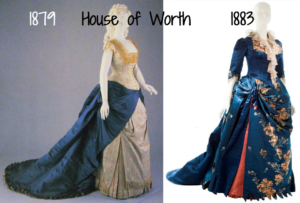
Remember in 1883, the large bustle designs were.. ..completely new inventions! Designer Worth with the other Parisian fashion houses at the time were INVENTING the style from nothing. Worth was taking what had been and pinching and pulling and draping to try to come up with something new. While we see bustles as logical (though somewhat odd) parts of fashion history, one must remember that like Worth’s crinolines, the bustles were completely new inventions.
(Photos: one of the many styles of 1883 large bustle, this with tape, wire, and cotton called a “lobster tail”, and the shape it made on real woman Cristine Nillson)
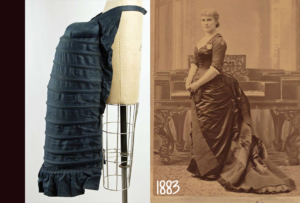
Granted, the 1880’s bustles were really evolved from… …18th century “rumps” and false bums”, but the application of new technologies in metal working, overuse of baleen and horsehair and so the new introduction of synthetics for padding and structures, made them very different than those of the prior century, although the overall result might have been very similar.
(Photos: (left) the 1760’s “false rump” or “bum pad” looks a lot like the (right) 1880’s “padded bustle pad”)
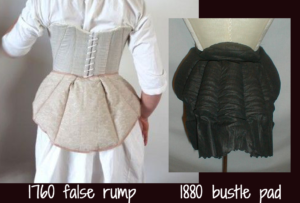
One might think all women of history were tiny… .. when one looks at garments hanging on mannequins in museums. While statistically women WERE much smaller on the average in the late Victorian era; e.g. median waist was 25″ vs today’s 32″, there were in reality women of ALL sizes from very small to very large.
The Natural Form era of 1878-1881 was a particularly bad time for large women.
(Photo: Natural Form dress by French designer Emile Pingat for large woman in black silk)
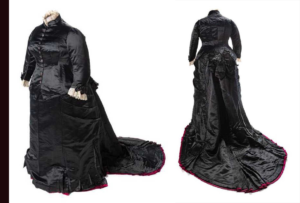
The 1880’s were much kinder to large women.. .. because everyone was trying to look large. The change in fashion matched a change in culture and economics. As the power of women to manage businesses, own property, to have rights over their children, and in many states like Wyoming – to vote! so did fashion ideals change to reflect women’s new status.
The ideal woman of 1883 was literally, as well as figuratively – large.
(Photos: (left) every day woman; (right) Queen Victoria – large women coming out of the Natural Form Era into the late Victorian Era where large women were revered.. and bustled)
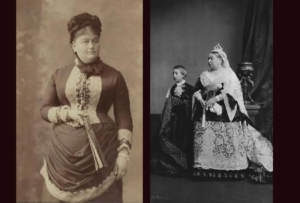
Late Victorian
1890’s
By 1893 & 12 years after it started, the 3rd “Late” bustle would disappear… .. to become just a pad over the rear end. This added on pad would be replaced by padding integrated within the new Edwardian “S Monobosum” corset of the new fashion era that was evolving at the end of Victoria’s reign.
Some sort of padding would be worn over the rear until 1909 when the long line corset and bust supporters would be invented by the same French fashion houses which heralded the end of Victorian AND Edwardian fashion eras at the advent of World War I.
(Photo: Princess Christiana of Schleswig-Holstein and daughter Princess Helena with the smaller rear and increasingly larger shoulders)
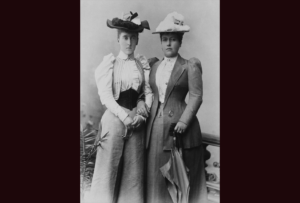
Victorians were really big on taking photos with their pets.
(Photo: late 1870’s kittens. Those who have been following our blog will be able to date the photo because of the hair and bonnet, even if you can’t see the ensemble very well)
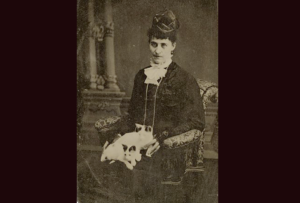
Quick thought before we dive into Late Victorian fashion… … One thing that stands out when ones like us spend most of the time studying women of history, and trying to figure out what they were thinking or knowing and so wearing, is that we modern people assume that things have improved and continue to improve in a straight line of sorts towards the future, with no looking back. Many modern people, except to enjoy theatre or movies, have no desire to know what came before, let alone wear it!
Once you learn, however, the secret of the adjustable corset with padding, or the 18th century bodice that still fits whether you gain a pound or lose a pound; once you’ve worn those lovely draping petticoats and skirts that hide flaws in thigh or derriere, or learned how convenient a nice pair of cotton split drawers are for using the restroom, it’s hard to shimmy into the rubberized skin tight synthetic clothing of today.
Of course, one can wonder “what in the world were they thinking??” when considering crinolines, bustles, and the gigantic sleeves we’ll be discussing next.
Modern or historical though, it still comes down to: what were/are they doing, what did/do they know about, and what did/do they have access to? While the 1860 swim costume will not win the next Olympics (and might drown somebody), a woman on the Oregon Trail would freeze to death in today’s spandex yoga pants and teeny lightweight short coats.
What women wore – and wear – is a reflection of society, culture, economics, and women’s roles at the time and place. This makes us those of us old enough to remember – what was with those fishnet stockings and mini skirts in the 1970’s??
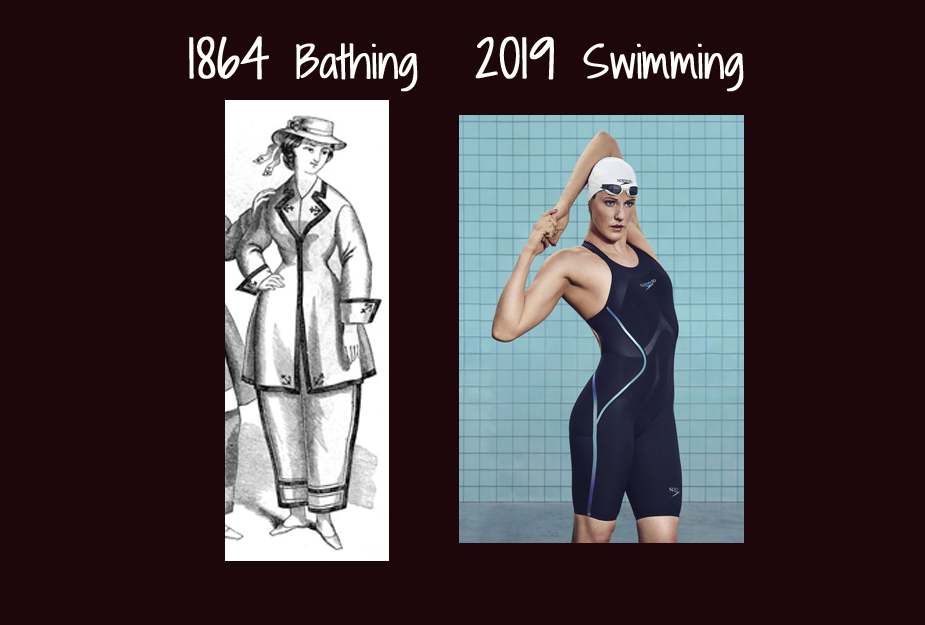
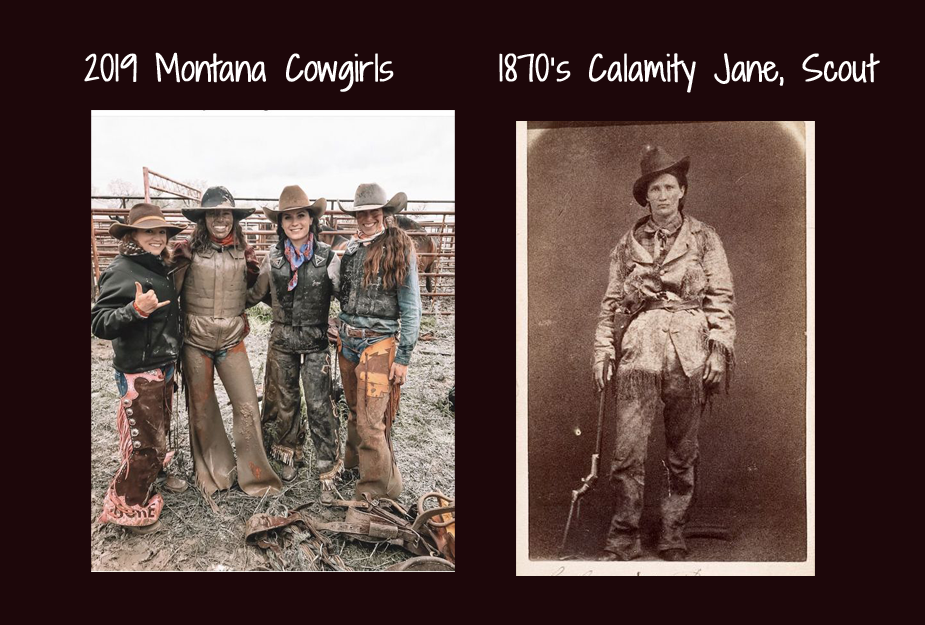
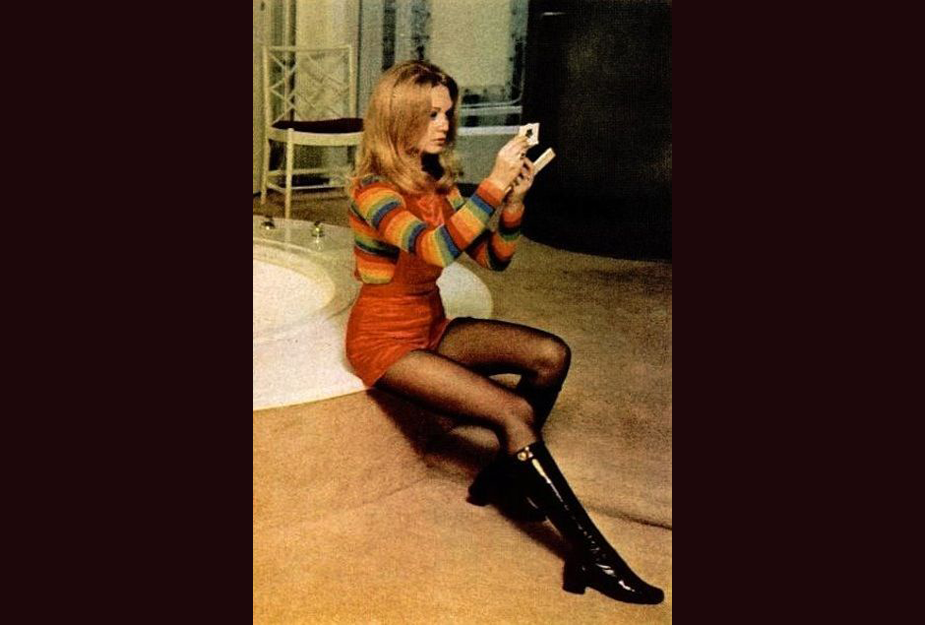
Back to work, Victorian style.. literally… .. Quick review. We have studied the design features of the early Victorian era (diminuitive women, fitted and changing bodices, increasingly larger skirts, and special collars and sleeves), defined what happened that made it change into mid-Victorian (designers, synthetic dyes, the sewing machine, and the crinoline), and launched into the first bustle era (mid-1870’s). We then talked about the Natural Form Era which was a brief 3 year period between bustle eras (in which large women looked pretty bad), and how that turned into the 2nd bustle era of about 1880 (in which large women looked pretty good) where we are today.
Historians record TWO Victorian eras: early and mid-to-late based on societal issues such as the rising power of women, but we actually see THREE. We count the 1880’s as part of a MID-Victorian era because fashion of the 1890’s made a complete change of silhouette, and we are all about the SILHOUETTE.
Here’s a quick review of Victorian Silhouettes so far:
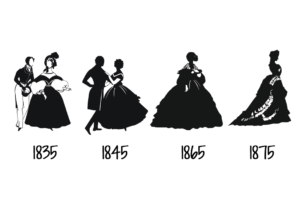
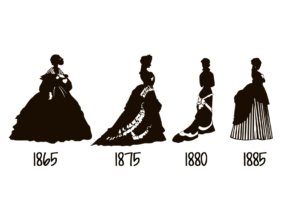
Key Influences – Victoria & Lillie
Victorian review: Victorian fashion launched when… .. Queen Victoria took the throne of the United Kingdom in 1837 at age 18. The world watched her grow up, and as she matured, so did her attitudes and programs and processes; especially regarding women and women’s place in society, the Arts, politics, and government.
They watched her fall in love, marry, be a mother, lose the love of her life – while leading a country. She was known as being innovative and adventurous; wanting to try new things.
(Photos: Queen Victoria married Prince Albert and created the entire concept of white for weddings)
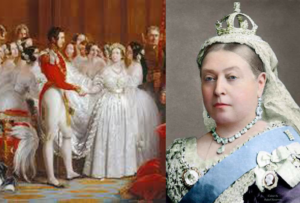
Queen Victoria was called the “mother of.. …feminism”, and as a role model for women worldwide, she led world fashion for more than 50 years; a culture that still influences fashion and behavior today. Victoria introduced the wedding white and traditions related to it. She also created the whole black mourning thing. (see pages here on 1903 mourning ensemble which goes into great depth about Victoria’s mourning rituals and the industry it created).
(Portrait: Queen Victoria wore mourning the rest of her life after the death of her husband, Prince Albert. Here she is in 1890)
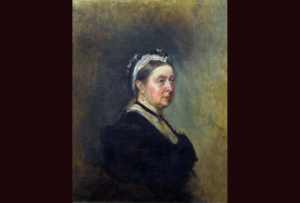
According to Historians, the 2 Victorian eras were… .. “early” 1837-1860, and “mid to late” 1860-1898 (or 1901 when Queen Victoria died and her son Edward took over the throne).
We at Silhouettes like to break up “mid” and “late” into 1860-1880, 1881-1890, 1891- 1898, and then we believe the Edwardian Era started in 1898-1912. We’ll tell you why, starting at 1880 and the 2nd (large, “horse rear end”) bustle era again.
We pick up where we left off, with the huge structural contraptions holding out copious amounts of fabric over the rear end, a long princess seamed bodice with skirt, front “apron/tunic/drape” decreasing in importance and size, and, the cuirasse bodice tightly fitted like armor.
We also introduce 3 characters leading fashion in Mid and Late Victorian eras in addition to Victoria: Princess Alexandra of Russia (towards the end), Empress/wife of the President, Eugenie of France (throughout), and Lillie Langtry of America/Britain (in the middle).
(Photos: Left Alexandra closer to 1900, Eugenie in early 1880’s, and Langtry 1882)
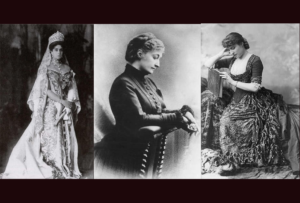
Lillie Langtry, also known as “Jersey Lily”.. ..was an actress who captivated London high society the very first night of her performance there. She caught the eye and the heart of Edward, Prince of Wales (who was married) and performed on stage for 34 years in Britain and America.
(Photos: Prince of Wales and his mistress, actress Lillie Langtry. It’s all in the eyes.)
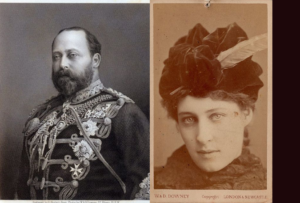
“Jersey Lilly”, Lillie Langtry was voluptuous.. … with full luxurious hair, perfect skin, eyes that could mesmerize, and said to be personable. Born 1852 (died 1929 at age of 77 years), her full figure (which kept getting bigger from the early 1880’s to the 1910’s) set the ideal for every woman.
The 1880’s was a time of “breaking out” for women worldwide, and especially in America and Europe where Lillie was beloved. The woman of the next 3 decades was like her: strong, powerful, and literally and figuratively – BIG.
(Photos: Lillie Langtry in court and day apparel 1882, the year she first appeared in New York City. She exemplified the lush figure silhouette ideal of the day).
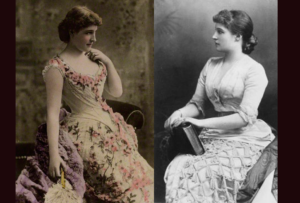
Lillie Langtry would become a key fashion figure… .. inspiring American and European women from the late 1870’s until about 1920. She navigated the new styles introduced by Parisian Fashion Houses and got involved in the science of bustles. She was most well known, however, for her world known affair with the Duke of Wales who would become the King of England.
She started her life without much fanfare, being born in 1853 to a Reverend at the Old Rectory in Jersey where her father was Dean of Jersey. She was the 6th of 7 children and the only girl.
Lillie’s governess was supposedly unable to handle her, so Lillie’s education fell upon her brothers’ tutor. Since boys at the time had a much broader range of studies than girls were permitted at the time. She also learned from her father’s example about infidelity as he had many affairs with his parishioners that resulted in many illegitimate children. Her mother left her father in 1880.
(Photo: young Lillie from Jersey in England was more aware of the world and its problems plus had more education than most young women of her time and place)
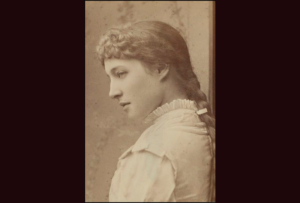
In 1874, 20 year old Lillie.. .. married 26 year old Edward “Ned” Langtry, who was an Irish landowner recently widowed. Ned had been married to Jane Price who was the sister of Lillie’s brother William’ wife.
They had a wedding reception at The Royal Yacht Hotel in St. Helier, Jersey. Langtry owned a large sailing yacht called “The Red Gauntlet” and Lillie talked Ned into moving away from the Islands where Jersey was located, and to move to Belgravia, London. In 1876, they rented an apartment, but moved to a larger place off Park Lane as Lillie was hosting quite a few society visitors.
(Photo: Ned and Lillie married March, 1874 in Jersey. Below: “The Red Gauntlet” yacht).
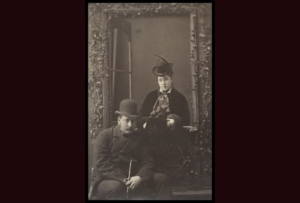
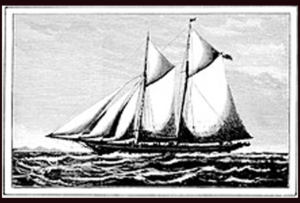
Lillie Langtry jumped right into London society.. .. taking it by storm. In 1877 Lillie’s brother had married Alice, the illegitimate daughter of Thomas Jones, the 7th Viscount Ranelagh who was a friend of their father. She was in mourning on the day of the wedding for her youngest brother who had been killed in a riding accident, so when she met the Viscount, she was wearing a plain and simple black dress with no jewelry.
The “little black dress” would later become her trademark.
That evening artist Frank Miles made a drawing of her that would later become a popular postcard. Another guest, Sir John Millais, also from Jersey, eventually painted her portrait.
(Sketch: the 1877 portrait of Lillie by Frank Miles)
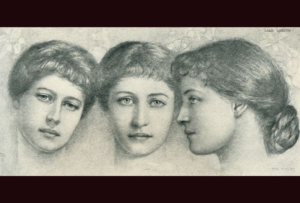
Lillie’s jump into Society… …was spurred on by the admiration and imagination of the men she met. She recounted her introduction to fame in an interview in 1882 with a London newspaper:
“It was through Lord Raneleigh and the painter Frank Miles that I was first introduced to London society … I went to London and was brought out by my friends. Among the most enthusiastic of these was Mr Frank Miles, the artist. I learned afterwards that he saw me one evening at the theatre, and tried in vain to discover who I was. He went to his clubs and among his artist friends declaring he had seen a beauty, and he described me to everybody he knew, until one day one of his friends met me and he was duly introduced. Then Mr Miles came and begged me to sit for my portrait. I consented, and when the portrait was finished he sold it to Prince Leopold. From that time I was invited everywhere and made a great deal of by many members of the royal family and nobility. After Frank Miles I sat for portraits for Millais and Burne-Jones and now Frith is putting my face in one of his great pictures.”
(Portrait: Lillie 1884 by Frank Miles)
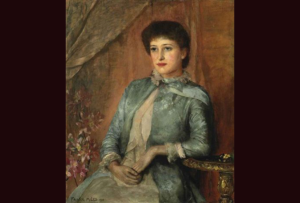
The fashion icon of the late 1870s & early 1880s… ..Lillie Langtry’s nickname, the “Jersey Lily”, was taken from the symbol of her home in Jersey, the Jersey lily flower. Painter Millais called his portrait of her “A Jersey Lily” and the name stuck. It was so popular when exhibited at the Royal Academy that they had to rope off the crowds.
Lillie’s popularity grew as she was invited to more and more social events as a result of the portraits. in 1885, the Prince of Wales, Albert Edward “Bertie” who would become King Edward VII at his mother Queen Victoria’s death, arranged to sit next to her at a dinner party given by Sir Allen Young, shortly after Lillie and her husband Edward were married in 1877. Husband Edward was seated at the opposite end of the table.
Although the Prince was married to Princess Alexandra of Denmark and they had 6 children, he was a well known philanderer. Infatuated with Lillie, he made her his mistress, and presented her to his mother the Queen. Princess Alexandra never showed jealousy, and accepted and acknowledged Langtry’s relationship with her husband.
(Photo: “Bertie” and Alix, married as Prince of Wales, later became King Edward and Lillie Langtry was openly his mistress)
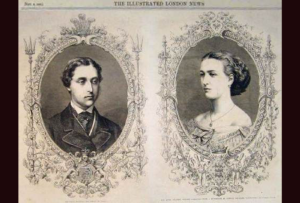
Lillie’s affair with the Prince lasted 3 years… .. from late 1877 to June 1880. Although they remained friends, her physical relationship ended with him when she became pregnant. No one knows who the father was, although most historians suspect it was her old friend Arthur Jones who accompanied her to Paris to have the baby.
She had a baby girl, Jeanne Marie in March 1881, her only child.
(Photo: Lillie with Jeanne Marie)
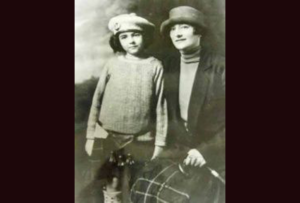
In 1880, Lillie had 2 more affairs.. .. one with the Bishop of Shrewsbury which became the source of gossip and scandal, and almost caused her divorce. With the withdrawal of Royal favor, even though the Prince supported her career, the Langtrys could not afford the lush lifestyle they had come to love.
A later discovery of torrid love letters between herself and Jones, plus the fact Jones went with her to the birth, indicated he was the father. Lillie had tried to tell the Prince the baby was his, but it didn’t stick. There is no documentation of what the husband was doing at this time, although newspapers hinted at divorce.
(Photo: Lillie Langtry 1885, by then a world famous actress)
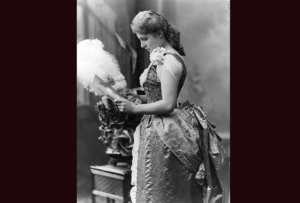
In need of money, Langtry’s friend Oscar Wilde… … suggested she try acting on the stage, and it kicked off her theatre career. She started in an amateur production of a comedy called “A Fair Encounter” with Henrietta Labouchere playing the other leading role and coaching Langtry on how to act.
Following positive reviews, she made a London debut playing in “She Stoops to Conquer” at the Haymarket theater. The public loved her, although the critics had some reservations.
Although her affair with the Prince was over, his attendance at her shows brought int big audiences. Early in 1882, Langtry started her own touring company that traveled across the UK, still under the teaching of Henrietta.
When Henry Abbey arranged a tour of the US for Langtry and her troups, she arrived in October 1882 met by a press and her friend Oscar Wilde. Her debut was anticipated, but the theater burned down the night before she was to appear. They moved to a different one and continued on a coast to coast tour of the Us for a full year and a lot of money.
When Langtry had an affair with Frederick Gebhard, a wealthy young American during the trip, Henrietta left the troupe over the conflict. Gebhard now escorted her across the country on more tours. The public loved her; the critics hated her, so she returned to Paris to study acting in 1883.
(Lillie in early 1880’s gown)
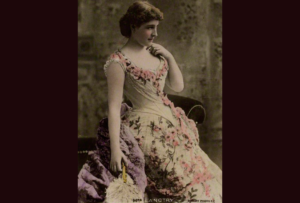
As we are telling Lillie’s story, pay attention to what she is.. … wearing. We’ll talk about Alix, the tolerant wife of King Edward (while he was having an affair with Lillie) and her fashion influence as 1900 approached – and – will tie in the fashion features Lillie was introducing in a few days.
Here’s a “test” for you who have just studied the Natural Form Era with us:
This is a photo of Lillie Langtry in 1881 just before her New York debut. Even though this is a stage ensemble, can you recognize the features coming out of the last fashion era? (Hint: look at seams of the bodice – do they run the full length? If so, it’s Princess seaming. Is the fullness in the back made by a structure or by draping or by something in between. This looks like somewhere in between indicating closer to 1880. AND – the hair! Look at the hair!)
And: whom do you guess “Princess Seaming” might be named after and why? (hint: Alexandra).
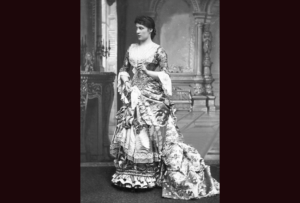
Lillie Langtry performed in the US and London.. …after very interesting ups and downs and more affairs. She hit the stage in the US and London over and over since her New York debut in 1882. In 1889 she played Lady Macbeth in Shakespeare’s “Macbeth”.
In 1902, she starred in “The Crossways”. She toured the US in 1906 and 1912, and her last appearance there was in 1917.
From 1900 to 1902 Langtry was the manager of London’s Imperial Theatre which she had rehabbed. (where now stands Westminster Central Hall).
(Photo: Lillie Langtry performed with famous actress Sarah Bernhardt in the 1890’s in roles such as “Cleopatra”)
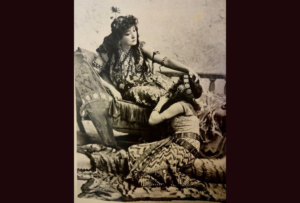
Langtry had another affair with an American… …from 1882 to 1891. She had divorced her husband Langtry in 1887 and gotten US citizenshp that same year.
Frederick Gebhard was 22 and Lillie was 29 when they met. He was supposedly a lover of feminine beauty and horses. His wealth was inherited from a grandfather on his mother’s side, Thomas Davis, who was one of the wealthiest New York real estate owners of the time. His other grandfather on his father’s side had come to New York in 1800 and was also wealthy from his mercantile business, banking, and railroad ventures.
In 1885 Langtry and Gebhard brought a stable of thoroughbred American horses to race in England. In 1888, traveling in her private care attached to an Erie Railroad train bound for Chicago, the railcar transporting 17 of their hours derailed in Pennsylvania. People, 14 horses, and her champion runner, Eole were killed.
Langtry and Gebhard never married. He married Lulu Morris of Baltimore in 1895, they divorced in 1901, and then he married Marie Wilson in 1905. He died in 1910.
(Photo: Lillie in 1890’s perhaps; undated photo)
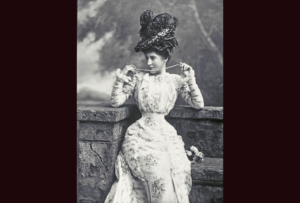
Lillie Langtry had ANOTHER affair then… ..(is anyone keeping count?) with bachelor George Baird (Squire Abington of Scotland) whom she met in 1887. He had vast estates and a large horse breeding business with a racing stable and more money than he knew what to do with. He had inherited from his grandfather who had made HIS money from coal and iron business, plus from his father who was also wealthy.
Langtry and Baird met at a race course and he later gave her a horse which Langtry named “Mr. Jersey” and raced for her. Their affair lasted from 1891 until he died in 1893 (isn’t this the 2nd who’s died during her affair?)
After his death, Lillie bought some of his horses and moved to the village of Kenford near Newmarket. She expanded her stables and hired relations of her brothers, and of her first husband (Langtry). She went through many trainers and jockeys (as in hired; not affairs) for 23 years until she gave up the business after much lack of success. She had, however, entertained the Prince of Wales (her first affair).
(Photo: 1890 Lillie. Must have been the eyes again..?)
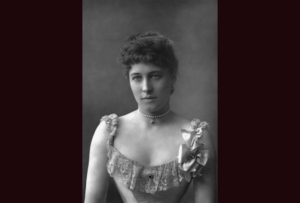
In 1888 Langtry owned land in America… .. when Frederick Gebhard and she bought ranches next door to each other in Lake County, California. She built a winery there that made red wine. She sold the business in 1906, and the “Langtry Farms” are still in business in Middletown, California today.
The divorce between Lillie and husband Edward Langtry finally came to be in 1897. Langtry said her US citizenship and ownership of property in the US made it clear she had no intention of being married to him any more. The “New York Journal” that year published his account of his relationship with her.
(Editor’s note: we wonder why it took him that long! There was yet another affair with a member of British Parliament in there that we didn’t even report on. She’d been having affairs since the 3rd week she was married to him.)
(Advertisement: on the side of everything else, Lillie posed for advertisements aimed at women. The public loved her!)
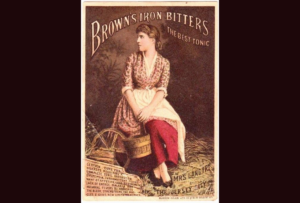
Langtry’s husband died a few months after their divorce.. .. He was found in a “demented condtion” in a railway station and died in an aslyum. It was ruled accidental, from a brain hemorrage after a fall on a steamship. When offered condolences, Lillie responded in a letter “I .. have lost a husband, but alas! It was no great loss.”
She got her husband’s Irish land holdings. (Our count.. 4 men she’d had ‘relations’ with who died within a short time after their relationships with her..?)
(Photo: Langtry models for High Fashion Parisian designer Charles Worth. Date unknown though it looks like early 1880’s)
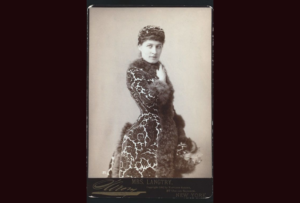
Right after her divorce, Lillie Langtry… … had yet another relationship with Prince Louis Esterhazy who shared her passion for horse racing.
A bit more than a year later, in 1899, Lillie married again. This time it was 28 year old Hugo de Bathe, the son of English nobility. Hugo was the heir to a baronetcy, because although he was not the first born, his parents had all his brothers and sisters out of wedlock, and he was the first “true son”.
The wedding was back at Langtry’s father’s former church in Jersey; the same day her horse won a major race in England.
de Bathe joined the British to fight in the Boer War, and they were still married in 1907 when his father died, making him Baronet, and Langtry became Lady de Bathe. They had many estates and properties including a house named “Langtry”. She sold them all in 1919 when she became an American citizen.
(Photo: Lady de Bathe in 1908)
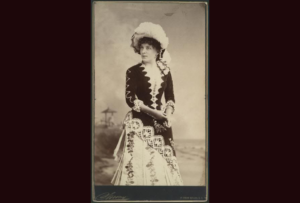
Langtry would die in 1929… .. .. living as Lady de Bathe. She is buried in the graveyard of her father’s St. Savioiur’s Church in Jersey.
(Langtry’s grave in Jersey. Interesting how her bust is naked, as if men then still found her sex appeal even after death)
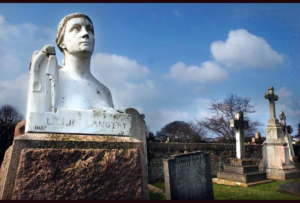
Through the early 1900’s, Lillie kept up.. .. with technology and culture. She bought an automobile and always dressed in the latest fashions. She was until the end in big demand for photos, and was on many postcards well into her later years.
In 1913 Lillie made her only film and worked on stage into her 70’s. Her pride and joy at the end of her life was her garden at her cliff top villa in Monaco.
(Photo: Lillie 1900 in style)
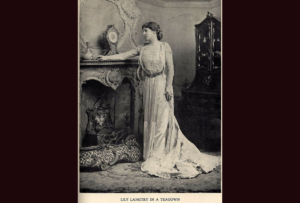
Langtry’s contributions to fashion… .. included the term “Jersey”, meaning a type of knit fabric. It was first used in the 1870’s thru ’90’s in the Island of Jersey where Lillie was born and died.
Lillie Langtry wore this finely knitted silk or wool in a way that clung tightly to her figure all the way up and down to mid thigh. It wrapped around her knees and was worn over a flannel or serge skirt.
Called at first the “jersey costume”, it was considered sportswear.
The “jersey” fabric we know today was improved and developed by fashion designer Coco Chanel in the 1920’s who made it into two piece suits. At that time it was a knit of cotton, nylon, rayon, wool, or synthetic material, although the term also means a type of thick knitted sweater originally worn by fisherman, as on the Jersey Isles. Today it is predominantly a thin knit made of synthetic material.
(Photo: On or off stage, “Jersey Lillie” wore the latest fashion)
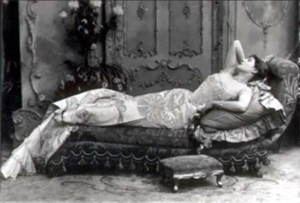
Langtry started out wearing one dress as a newlywed… .. and was considered “socially inept” when she moved to London with her husband in 1877. Through the 1880’s she was THE fashion icon, whom women in Europe and America, including the Royals modeled themselves after.
At the peak of her career (and somewhere around affair #6 by our count), she had millions $ and spent lavishly. The center of attention wherever she went because of her “luscious beauty”, intelligence, and humor – and her willingness to adapt to American society – men loved her and women wanted to be just like her.
She made it socially acceptable for a woman to pose for advertising. In the “Wild West” of the 1880’s and ’90’s, she was the dream of the cowboy, and western heroes like “Judge Roy Bean” who tried to pay her to come out, though she never did.
Langtry challenged Victorian cultural attitudies towards women, but was absolutely not a suffragette.
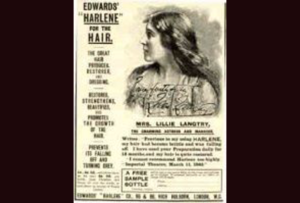
Langtry lived her philosophy… From Langtry’s memoirs near the end of life, reflecting back on her very dramatic life on and off stage:
- Anyone who limits her vision to memories of yesterday is already dead.
- You wouldn’t believe how the town was named for me. I was met by the whole population, headed by the mayor.
- I know I am at the end. I shall never get better, dear.
- Sympathy is charming, but it does not make up for pain.
- I’m not afraid. I never liked long last acts.
- I do not regret one moment of my life.
- Why in the world would anyone want to photograph an old woman like me?
- I am a grandmother now, and that means age is creeping on, creeping on.
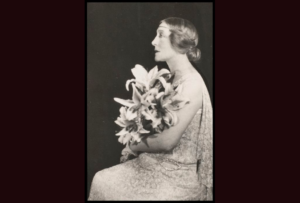
Another contribution Langtry made… …was a BIG fashion statement, initiated by Parisian designers, but advertised by women like Lillie to women of the world.
By the early 1880’s, when Lillie was on her climb to fame, the softly curved bustles of the 1870’s had been quickly replaced by a new silhouette. This “large bustle era” had a severely tailored front and draperies in the back.
Trains had disappeared, and a bustle with a well fitted skirt with gores made a straight line in front, hugging the hips, and then had huge fullness in the back made by gathers or pleats.
(Photo: Lillie Langtry and the early 1880’s silhouette)
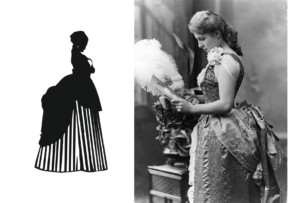
More About the Late Victorian, Late Bustle Era Bustle
The early 1880’s fashion featured… … a skirt that was flat and straight in the front and a back that was “poufed” out by use of a bustle or “tournure”. The large skirt “poufs” were below the waist and in the back.
Through the 1880’s, there were MANY kinds of bustles and “tournures”, ranging from stuffed tubes stacked on a cotton or linen flat piece, to extreme wire and tape contraptions. Each served a different purpose such as to support the lighter silks of evening gowns vs. the heavy cotton velveteen of walking dresses.
(Sketches: Left a “Pullman Bustle”; right “Tubular Bustle” of the mid to late 1880’s. Differing from the 1870’s bustles which tended to stay around the hips and upper thighs, these later and larger bustles both supported the back drapery from waist to floor. Note the fabric “tent” that pushed it away from the legs to keep the contraption vertical )
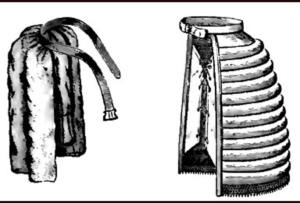
Later, larger bustles varied.. … in type and configuration, although they all accomplished the flat front with very full back.
(Photos: 1883 ensembles; right is Spring 1883 Mrs. Vanderbilt’s party dress)
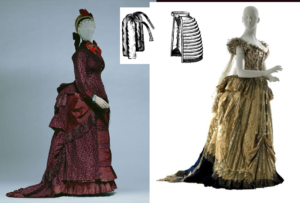
Indispensable to the 1880’s “costume”.. .. as Queen Victoria and designer Charles Worth of the time called wearing the appropriate clothing for the activity.. was the well – fitted tournure or bustle. Designed to expand the skirt of the dress below the waist, the bustle was THE required item for several decades.
Various styles were made from wires, springs, mohair pads, fabric, and sometimes lace (although that looked pretty strange on the carpentry of these contraptions.) The “tournure”, or “turning” bustle which was made of layers of horsehair in strips twisted and turning was used in the natural form era of the late 1870’s. It was no longer strong enough to hold up the heavy fabrics or volume of draping of the 1880’s.
(Sketch: bustles of the 1880’s)
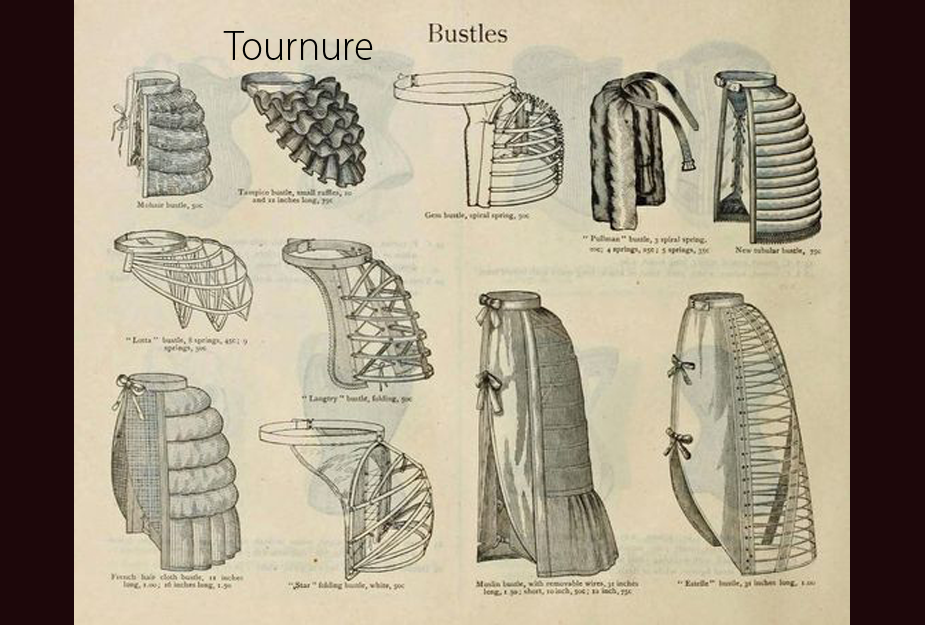
In 1882 more structured bustles.. … were needed to support the heavy fabrics. The early ones might still be padded, but were now on wires or springs. They were long and rounded over the rear; somewhat like the look of the Natural Form Era where it was more a purpose to make a larger yet naturally shaped rear end.
(Sketch: 1882 bridal fashion plate and possible bustles for it)
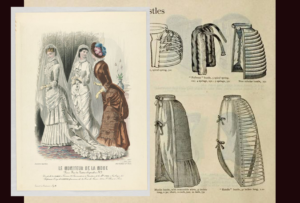
As the decade progressed, bustles became more… … structured yet, becoming elaborate and scientific in their design. The “horse rear end” was the nickname of the strong bustle that stuck horizontally from the rear end, making a large enough fullness that one could picture someone sitting on it like a horse.
(Sketches: 1885 – 86)
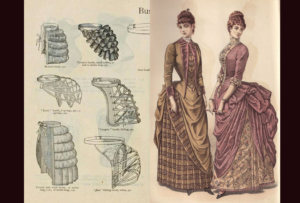
Satirists, especially in France where fashion was being… … initiated out of the Parisian “Haute Couture” houses such as that of Charles Worth, had lots of fun with the large bustles. Many were rather obscene, so it was hard to find a family appropriate example here.
(1885 French cartoon)
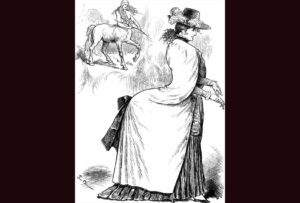
Enter on the fashion stage, Lillie Langtry (discussed above)… … who, being in the very height of fashion in the 1880’s, and taking her cues from Victoria, the Parisienne fashion houses, while hanging out with the rich, privileged, and Royal, was wearing the latest style – the large bustle.Also having influence and persuasion, she decided the bustle could use a bit of improvement. It was large, impossible to sit down in, and cumbersome.
(Portrait: Lillie in the mid 1880’s)
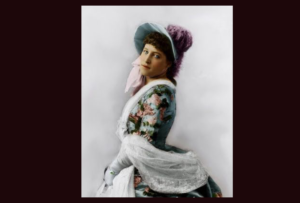
And so Lillie Langtry invented her own bustle… .. a large metal contraption suitable to the heavy fabrics and huge silhouette of the mid to late 1880’s. Lillie’s, however, differing from everything else out there, was “reticulating” – meaning it could fold up.
When a woman sat down, her bustle folded into itself, pushing the fabric up and against her body, so she had freedom of movement both standing and sitting.
(Sketches: the Langtry reticulating bustle design)
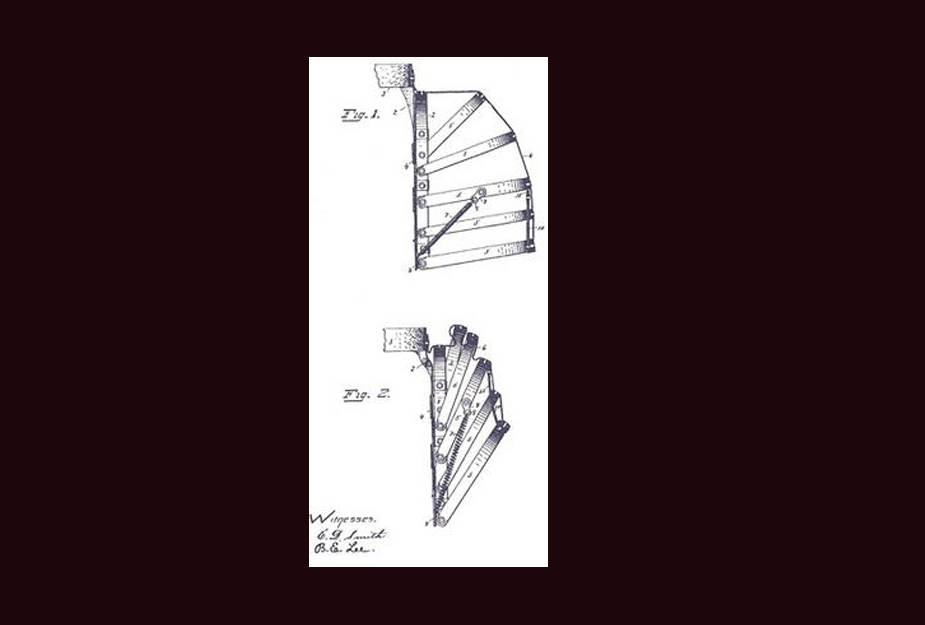
Whom actually designed & built the Langtry bustles… … is not known to the public, although one can assume there were patents somewhere; presumeably in England or France at the time. There are other models noted as her design; strong and rigid but not folding, which we might assume were early attempts at design.
(Other bustle designs credited to Langtry)
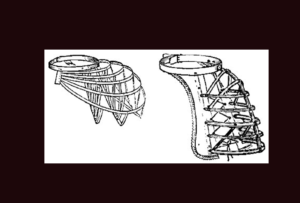
This photo of Lillie Langtry in 1882… … might be demonstrating her ability to actually sit in a bustle – her own. Almost all sketches and photos (and extant garments it seems) are of women standing, never sitting. Until the Langtry folding bustle, women had to stand up.
(Langtry in 1882 – photo)
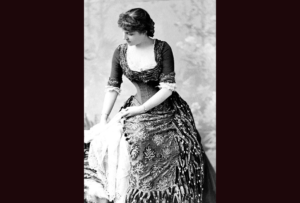
The bustle caused other societal changes… … like the necessity of church pews to have a slit where the bustle could fit through.
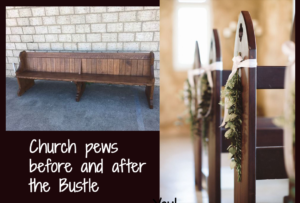
Wider sofas and… .. wider carriage seats were a result of the large bustle too.
(1880’s sofa)
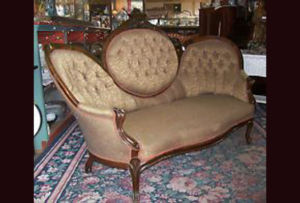
The concept of the large woman was.. .. not just the influence of luscious fashion icons like Lillie Langtry of the 1880’s, but was actually a reflection of women’s status in the world at the time.
Through the 1850’s and 1860’s (mid-Victorian) eras, women were required to be diminuitive, passive, and of a status beneath every man in her life; not just her husband.
By the 1880’s, women in American had gained property rights, and in some states like Wyoming, the right to vote, hold office, and direct businesses and government.
It is hard to say whether women’s position in society directed fashion to become larger, or if fashion reflected the attitudes of women. It is obvious through extant garments and photos to see that the large woman, after so many decades of tiny wasp like waists of the 1830′-60’s and the long slim lean lines of the late 1870’s were suddenly and abruptly replaced by large, healthy, and robust women and their huge sihouette.
(Photos: the new ideal woman of 1883)
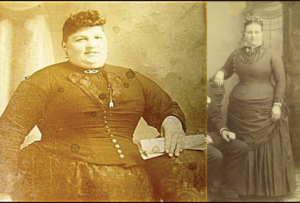
At last larger and older women could be fashionable… .. and comfortable. While the corset was long and restrictive, it shaped the body large or small into the ideal. There was no pressure to reduce overall size and stature.
Artists like Renoir idealized the full figured body in movement such as in these paintings from approximately 1883.
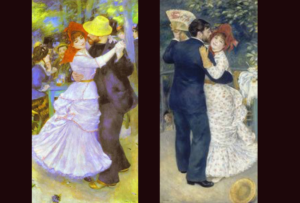
The 1880’s were a time of romance.. .. and at the same time technology. Innovations like the Brooklyn suspension Bridge were being built, and many people embraced all that was new and exciting. At the same time many longed for “Grandma’s Garden” and the beautiful days of rural life in America.
Impressionistic painters: Renoir, Manet and their peers were idealizing landscapes and people.
(Photo left Brooklyn Bridge shown in 1891; right Manet’s Garden painting)
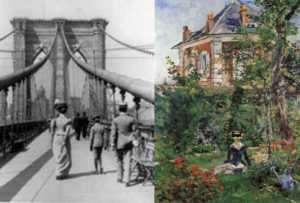
These 2 opposing concepts, technology and… .. romance.. were reflected in fashion of the 1880’s. Bustles and corsets became highly innovative, diverse, and technical, while the many ribbons, flounces, layers, and beautiful fabrics and colors lent the romance.
(Sketches: Feminine frills and flowers over intense and technological structures of 1883 and 1882)
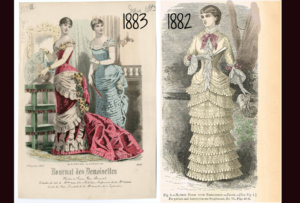
The Late Victorian corset… … had both femininity and innovation in it, and was largely responsible for the silhouette of the 1880’s and 1890’s.
It was longer, shaped the body, and was mass produced in a huge variety for every purpose and every body.
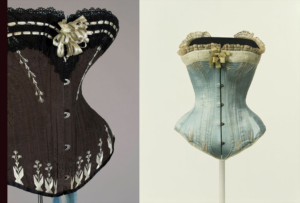
The long cinching corset of the 1880’s and ’90’s… … went from above the breasts and down over the hips. Heavy boned and tightly cinching to the point of moving the internal organs, it was probably more restrictive than even the waist cinching corsets of the 1830′-70’s because it covered the entire torso and hips.
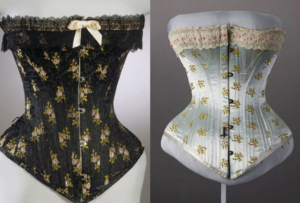
A new innovation the metal Spoon Busk.. …was heavily used in the 1880’s and ’90’s A busk had been used since the early 18th century to keep stays rigid in the front and to lift and separate the breasts. Through the early 19th century, it was still wooden and used for keeping the front flat and breasts lifted, but by they 1820’s when the metal busks were introduced, it became a key to opening and closing the corset. As it evolved, different shapes, materials, and thicknesses of metal were used for specific purposes (such as heavy duty and wide or double metal busks for working women who bent a lot).
By the 1880’s the new innovations of the metal “spoon busk” tipped in below the tummy so no line or ridge would show (and so it would hold in the tummies of large women, a favorite corset for today’s re-enactors for the same reason). It allowed the long and very smooth flat line required for the BIG silhouette, plus added strength and durability for the now, much more active woman.
(Photos: modern spoon busks are typically stainless steel and cost from $40-$90 depending on the metal used for the hooks – some are gold or brass and country of manufacture as well as thickness of the metal)
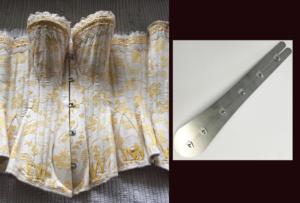
There were many, many, many types of.. … corsets available in the 1880’s, as catalogs were available even to the western frontier of the United States, as well as custom tailors and easy-to-import high fashion due to brisk trade at the time with Europe. Most “every day” women bought reasonably priced corsets in generic sizes from catalogs or department stores, and then had them customized in finishing or fit locally or by a family member (or themselves).
The quality and manufacture; design and fabric and materials varied from costly oriental silk outer fabrics to durable cottons and duck. The #1 manufacturer of corsets at the time was the American, Royal Worcester company, started by a man and his mother.
(Photos: Royal Worcester basic mass produced long late Victorian corsets currently at auction offered at $800/both. At the time of their manufacture, they cost $4-$6 each).
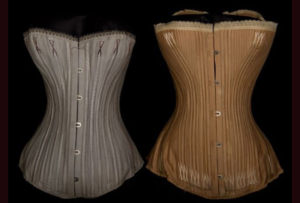
You can now understand the shape.. and the allure.. ..of Lillie Langtry in the late 1880’s. She was rounded and full as the ideal of the day, with good skin as much was exposed. She had trained to the tightly cinched waisted corset through the 1860’s and ’70’s, so that by the 1880’s and 90’s, she had a teeny waist that could easily be corseted in the long late Victorian shape.
Covering the hips and under the arms, the late Victorian corset was ideal for someone like Langtry because it guided her curves into the “right places” (that men particularly liked), even as she gained weight around 1900.
(Photos; Langtry in the mid-1880’s in the corset of the day in evening wear)
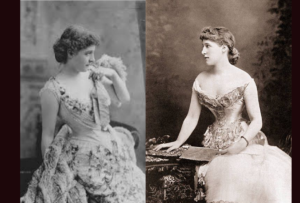
Note in photos of the 1880’s and ’90’s… The women are leaning and not sitting directly. This time period caused another technological innovation – the fainting couch. Wearing the long, tightly cinching corsets that covered the hips, a woman could not sit straight up in a chair.
Even in loose kimono costume, this photo of Lillie Langtry shows she must have still been wearing a corset (women could not take them off as their organs and ribs had moved in the training of them, and they would move back to natural position and endanger their lives if suddenly they left the corsets off – a key reason for death in child birth).
You can see her leaning on a fainting couch of sorts in this and almost every photo of Langtry during performances. She will be standing or leaning or laying flat; never bent.
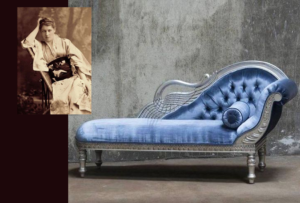
Bodices of the early 1880’s… …were all worn with the new bustles and skirts. There were basques, pointed waists, coat bodices, and round waists with belts.
Sleeves were placed very high on the shoulders making neck to shoulder seams very short, giving a narrow appearance to large women. The problem was the look was very bad on a very thin woman.
(Early 1880’s portraits: left – the narrow shouldered bodice balances out the body of a larger woman, while, right – it makes a very thin one look odd)
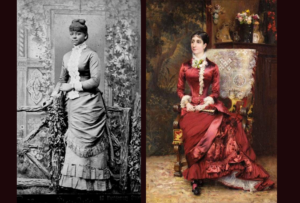
Necklines of the early 1880’s… … were very high. One reason was that the hair was worn high on the back of the head, leaving the neck fully exposed if left uncovered.
A second reason was the warning of physicians that women would become very ill if their necks and decolletages were left uncovered.
(Portraits: early 1880’s bodices with tall necklines to accommodate hair worn high in the back (as opposed to the 1870’s 1st bustle era where hair was worn in ringlets and curls down the back)
NOTE: in the idealized fashion plate (left) the shoulders appear to be normal or even large, whereas in reality (right), the cut of the shoulder line made shoulders look narrow.
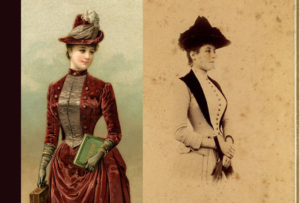
The first bustles were pads… .. much like in the 18th century for “false rumps”. The hard-edged front lines of the 1880’s made women want to soften the overall look, so the late bustles (as opposed to the 1870’s early bustles discussed already here) had to make even more visual impact than simply making the rear end look a bit bigger and softer under back flounces.
(Photos: (left) the 1760’s false rump, used in the 1870’s 1st bustle era and the late 1870’s Natural Form Era, could no way fill out the skirts of the 1880’s (right)
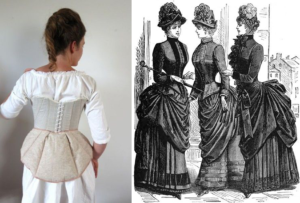
1880’s bustles were somewhat tortuous.. … and scary contraptions. They were made with wires, springs, mohair padding, tapes, and horsehair. Although some had lace on them, it looked odd on these scientific inventions.
While some of the early bustles and pads like the tournure were still suitable for athletic or walking events, only the extreme structures could hold up the voluminous trained skirts, especially those of evening wear, and heavy thick fabrics that were being used at the start of the 1880 decade.
(Photos: the 1870’s Natural Form tournure (left), while still useable for low fashion activities which had less draping, could not even begin to support the 1880’s heavy back ornamental “tapestry” (right)
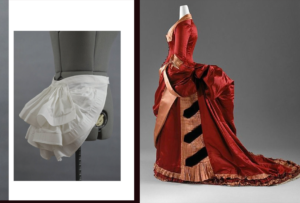
By the mid-1880’s, the bustle began to be.. … built into the foundation of the skirt, as opposed to being a separate undergarment. The size got bigger and bigger through the decade until 1887, when it immediately shrunk and disappeared altogether by 1889.
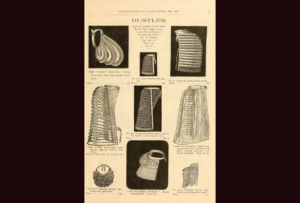
1889 Forward
1890 would introduce completely new silhouettes with a virtual “explosion” of fashion concepts. Just the skirt would change 4 times a year in the type and number of gores. Because of the vast amount of information, examples and diversity in fashion at this time, generalizations are nearly impossible. The continuation of this discussion can be found by character in the Projects Files by Date, the Late Victorian 1888-1898 section, and the six types of fashion 1899-1914 sections on this website.
When Victoria died in 1901, the Victorian era officially became the Edwardian era, although by silhouette, influence, technology, and attitude, there is really no clear date for the transition. For our purposes, as discussed in the links above, we consider the Edwardian fashion era to begin in 1899.
Brief graphic outline of Late Victorian & Early Edwardian Skirts (1897-1905):
